
.
Public
Insurance Capital Standard as a
Prescribed Capital Requirement
Public Consultation Document
23 June 2023
Comments due by 21 September 2023

Public
About the IAIS
The International Association of Insurance Supervisors (IAIS) is a voluntary membership
organisation of insurance supervisors and regulators from more than 200 jurisdictions. The mission
of the IAIS is to promote effective and globally consistent supervision of the insurance industry in
order to develop and maintain fair, safe and stable insurance markets for the benefit and protection
of policyholders and to contribute to global financial stability.
Established in 1994, the IAIS is the international standard-setting body responsible for developing
principles, standards and other supporting material for the supervision of the insurance sector and
assisting in their implementation. The IAIS also provides a forum for Members to share their
experiences and understanding of insurance supervision and insurance markets.
The IAIS coordinates its work with other international financial policymakers and associations of
supervisors or regulators, and assists in shaping financial systems globally. In particular, the IAIS is
a member of the Financial Stability Board (FSB), member of the Standards Advisory Council of the
International Accounting Standards Board (IASB), and partner in the Access to Insurance Initiative
(A2ii). In recognition of its collective expertise, the IAIS also is routinely called upon by the G20
leaders and other international standard-setting bodies for input on insurance issues as well as on
issues related to the regulation and supervision of the global financial sector.
For more information, please visit www.iaisweb.org and follow us on LinkedIn: IAIS – International
Association of Insurance Supervisors.
International Association of Insurance Supervisors
c/o Bank for International Settlements
CH-4002 Basel
Switzerland
Tel: +41 61 280 8090
This document is available on the IAIS website (www.iaisweb.org).
© International Association of Insurance Supervisors (IAIS), 2023.
All rights reserved. Brief excerpts may be reproduced or translated provided the source is stated.

Public
Table of Contents
Introduction.................................................................................................................. 6
1.1 Purpose of the consultation document (CD) .............................................................. 6
1.2 The consultation process ............................................................................................ 6
1.3 Next steps ..................................................................................................................... 6
The ICS – background information ............................................................................ 6
2.1 ICS and ComFrame ...................................................................................................... 7
2.2 Development of the ICS ............................................................................................... 7
2.2.1 Genesis of the ICS Project ............................................................................................................... 7
2.2.2 Principles for ICS Development ....................................................................................................... 7
2.2.3 Field Testing: 2014 to 2019.............................................................................................................. 8
2.2.4 Implementation of ICS Version 2.0 .................................................................................................. 9
2.3 Implementation of the ICS ........................................................................................... 9
General Guiding Principles ...................................................................................... 10
3.1 Substance over Form ................................................................................................. 10
3.2 Proportionality ............................................................................................................ 10
3.3 Look-Through ............................................................................................................. 10
3.4 ICS Rating Categories ................................................................................................ 11
Perimeter of the ICS Calculation .............................................................................. 13
4.1 Scope for Starting ICS Balance Sheet ...................................................................... 13
4.2 Development of Starting MAV Balance Sheet .......................................................... 15
Market-Adjusted Valuation ....................................................................................... 16
5.1 Valuation Principles ................................................................................................... 16
5.2 Current Estimate......................................................................................................... 17
5.2.1 Basis for calculation ....................................................................................................................... 17
5.2.2 Contract recognition, contract boundaries and time horizon ......................................................... 19
5.2.3 Data quality and setting of assumptions ........................................................................................ 20
5.2.4 Management actions ...................................................................................................................... 21
5.2.5 Discounting..................................................................................................................................... 21
5.3 Margin over Current Estimate (MOCE) ...................................................................... 32
5.3.1 Definition and underlying principles ............................................................................................... 32
5.3.2 Calculation of the MOCE ................................................................................................................ 32
5.3.3 Interaction of MOCE with other components ................................................................................. 32
5.4 Obligations replicable by a portfolio of assets ......................................................... 33
Capital Resources ..................................................................................................... 34
6.1 General considerations .............................................................................................. 34
6.2 Classification of financial instruments ..................................................................... 35
6.2.1 Tier 1 Unlimited financial instruments ............................................................................................ 37
6.2.2 Tier 1 limited financial instruments ................................................................................................. 38

Public
6.2.3 Tier 2 financial instruments (other than structurally subordinated) ................................................ 40
6.2.4 Structurally subordinated Tier 2 financial instruments ................................................................... 41
6.2.5 Tier 2 Non-paid-up capital .............................................................................................................. 42
6.3 Capital elements other than financial instruments .................................................. 43
6.3.1 Tier 1 capital elements ................................................................................................................... 43
6.3.2 Tier 2 capital elements ................................................................................................................... 43
6.4 Capital adjustments and deductions ........................................................................ 44
6.4.1 Deductions from Tier 1 capital resources ...................................................................................... 44
6.4.2 Deductions from Tier 2 capital resources ...................................................................................... 45
6.4.3 Treatment of encumbered assets .................................................................................................. 45
6.4.4 Limit on non-controlling interests ................................................................................................... 45
6.5 Capital composition limits ......................................................................................... 46
Capital Requirement – The Standard Method ......................................................... 47
7.1 ICS Risks and Calculation Methods .......................................................................... 47
7.1.1 Risk mitigation techniques ............................................................................................................. 49
7.1.2 Geographic segmentation .............................................................................................................. 51
7.1.3 Management actions ...................................................................................................................... 52
7.2 Insurance risks ........................................................................................................... 53
7.2.1 Grouping of policies for life insurance risks ................................................................................... 53
7.2.2 Calculation of Life risk charges ...................................................................................................... 53
7.2.3 Calculation of Non-Life risk charges .............................................................................................. 60
7.2.4 Calculation of Catastrophe risk charges ........................................................................................ 72
7.3 Market Risks ............................................................................................................... 76
7.3.1 Calculation of the Market risk charge ............................................................................................. 76
7.3.2 Interest Rate risk ............................................................................................................................ 77
7.3.3 Non-Default Spread risk ................................................................................................................. 81
7.3.4 Equity risk ....................................................................................................................................... 82
7.3.5 Real Estate risk .............................................................................................................................. 85
7.3.6 Currency risk .................................................................................................................................. 86
7.3.7 Asset Concentration risk ................................................................................................................ 91
7.4 Credit risk.................................................................................................................... 93
7.4.1 Calculation of the Credit risk charge .............................................................................................. 93
7.4.2 Recognition of collateral, guarantees and credit derivatives ....................................................... 106
7.4.3 Use of external credit ratings ....................................................................................................... 112
7.5 Operational risk ........................................................................................................ 116
7.6 Aggregation / diversification of ICS risk charges .................................................. 117
7.7 Non-insurance risk charges .................................................................................... 118
Tax ............................................................................................................................ 121
8.1 General principles .................................................................................................... 121
8.2 Deferred tax resulting from the ICS Adjustment .................................................... 122
8.2.1 Utilisation assessment of DTAs recognised from the ICS Adjustment ........................................ 122
8.3 Tax effect on the ICS insurance capital requirement ............................................. 123
8.3.1 Component a: tax loss carry backs .............................................................................................. 124
8.3.2 Component b: post-stress future taxable income projections ...................................................... 124
8.3.3 Components c and d: Deferred taxes .......................................................................................... 124
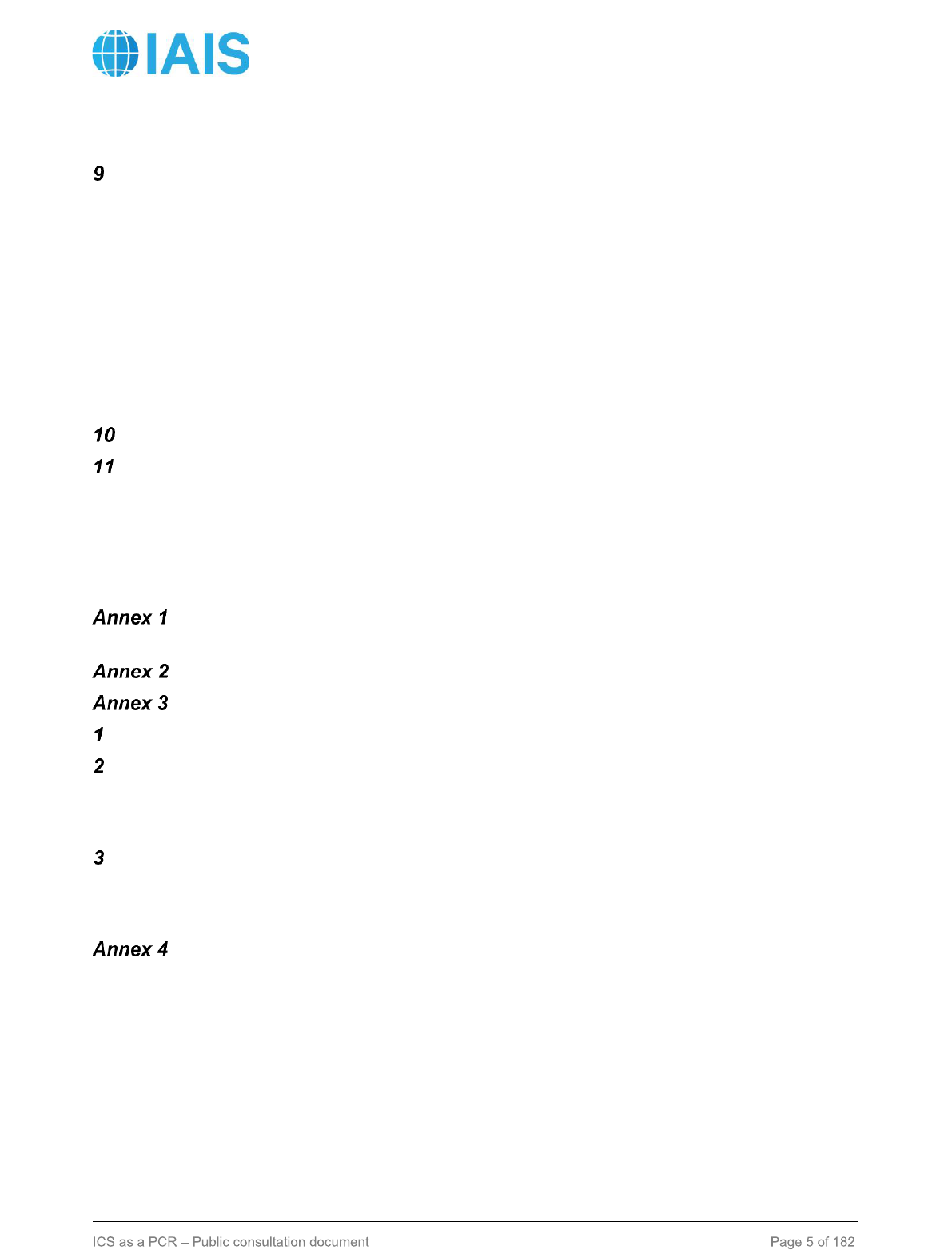
Public
Capital Requirement – Other Methods .................................................................. 124
9.1 General principles .................................................................................................... 124
9.2 Dynamic Hedging ..................................................................................................... 125
9.3 Supervisory Owned and Controlled Credit Assessments (SOCCA) ..................... 125
9.4 Internal models ......................................................................................................... 126
9.4.1 Overall Requirements .................................................................................................................. 126
9.4.2 General Provisions on the use of an internal model to determine regulatory capital requirements
126
9.4.3 Criteria for internal model approval .............................................................................................. 131
9.4.4 Additional considerations ............................................................................................................. 136
9.4.5 General provisions on the use of partial internal models (PIM) ................................................... 138
General feedback .................................................................................................. 141
Economic Impact Assessment ............................................................................ 142
11.1 Impact on product availability ................................................................................. 142
11.2 Impact on IAIGs’ business models and capital position ....................................... 143
11.3 Impact on financial markets..................................................................................... 144
11.4 Implementing the ICS ............................................................................................... 145
Treatment of Non-Voting Interest Entities (Asset and Insurance
Securitisations).............................................................................................................. 146
Definition of ICS Non-Life Segments ......................................................... 148
Definitions and criteria applicable to infrastructure debt and equity ..... 173
Infrastructure investments ..................................................................................... 173
Criteria applicable to infrastructure equity ........................................................... 175
2.1 Subset of infrastructure corporate investments .................................................... 175
2.2 Subset of infrastructure project investments ......................................................... 176
Criteria applicable to infrastructure debt .............................................................. 177
3.1 Subset of infrastructure corporate investments .................................................... 178
3.2 Subset of infrastructure project investments ......................................................... 178
Risk-free yield curve parameters ............................................................... 181

Public
Introduction
1.1 Purpose of the consultation document (CD)
1. The purpose of this CD is to solicit feedback from stakeholders on the global insurance capital
standard (ICS) ahead of its adoption as a group prescribed capital requirement (PCR) for
Internationally Active Insurance Groups (IAIGs) at year-end 2024. This CD presents the ICS as
envisaged for implementation (“candidate ICS as a PCR”), subject to any further changes which may
be decided upon based on the resolution of comments from this public consultation and the outcome
of the ICS data collection, and provides in blue boxes background explanations relating to the main
changes compared to ICS Version 2.0 for the monitoring period.
1
Only the text identified as Level 1
or Level 2 text forms the ICS standard.
2. This CD also aims at collecting input from stakeholders to support the Economic Impact
Assessment (EIA) of the ICS that will be conducted by the IAIS.
1.2 The consultation process
3. Feedback on this CD is invited by 21 September 2023.
4. Stakeholders are invited to provide rationale and/or evidence supporting their responses.
Explanations are most helpful if they:
• Are clear as to the issue being addressed;
• Provide a clear rationale and basis for comments made; and
• Include evidence, examples or references (eg to publicly available documents or data
sources) to support the response.
5. Comments must be sent electronically via the IAIS Consultations webpage. All comments will
be published on the IAIS website unless a specific request is made for comments to remain
confidential.
1.3 Next steps
6. The feedback received on this CD as well as the outcome of the Economic Impact Assessment
will be considered for the finalisation of the ICS. A resolution of comments received through this
public consultation will be released along with the finalisation of the ICS. The adoption of the ICS is
planned for December 2024.
The ICS – background information
7. The ICS has been developed as a consolidated group-wide capital standard for IAIGs.
8. Once adopted, the ICS will apply to IAIGs as part of the Common Framework for the Supervision
of IAIGs (ComFrame).
1
The Level 1 and Level 2 documents for ICS Version 2.0 for the monitoring period are available here:
https://www.iaisweb.org/activities-topics/standard-setting/insurance-capital-standard/

Public
2.1 ICS and ComFrame
9. ComFrame consists of both quantitative and qualitative supervisory requirements tailored to the
complexity and international scope of IAIGs. The ICS is the quantitative component of ComFrame.
Following its adoption as a group-wide consolidated PCR, the ICS will be integrated into ComFrame.
10. The ICS is structured on two levels: Level 1 and Level 2.
11. The Level 1 text sets out the overarching principles and concepts of the ICS. It is adopted by
the General Meeting of IAIS Members after public consultation.
12. The Level 2 text contains more detail on the operationalisation of the relevant Level 1 text. It is
adopted by the Executive Committee of the IAIS after public consultation.
13. While the Level 1 text is intended to remain stable over time, the Level 2 text may be revised on
a more frequent basis. Changes to the Level 1 and Level 2 texts follow the same process as
described in paragraphs 11 and 12 respectively.
14. For the ease of reading, this CD brings together the Level 1 and Level 2 into one consolidated
document. The origin of each paragraph of the standard can be identified through the numbering:
L1-x for paragraphs from the Level 1 text, L2-x for paragraphs from the Level 2 text.
2.2 Development of the ICS
2.2.1 Genesis of the ICS Project
15. On 9 October 2013, the IAIS announced its plan to develop a risk-based global insurance capital
standard, in response to the request by the Financial Stability Board (FSB) that the IAIS produce a
work plan to create “a comprehensive group-wide supervisory and regulatory framework for
Internationally Active Insurance Groups.”
2
In its statement of 18 July 2013 the FSB stated that “a
sound capital and supervisory framework for the insurance sector more broadly is essential for
supporting financial stability.” The FSB further reinforced its support for the development of the ICS
in its statement of 6 November 2014.
3
2.2.2 Principles for ICS Development
16. The IAIS published a first version of the principles set forth in Table 1 in September 2014.
Principles 3 and 6 were subsequently amended following the 2014 ICS CD. These principles have
been followed in the ICS development.
17. The principles that reference Global Systemically Important Insurers (G-SIIs) have been
superseded by the development of the IAIS Holistic Framework for the assessment and mitigation
of systemic risk in the insurance sector.
4
Table 1: The ICS Principles
ICS Principle 1: The ICS is a consolidated group-wide standard with a globally
comparable risk-based measure of capital adequacy for IAIGs and G-SIIs. The standard
incorporates consistent valuation principles for assets and liabilities, a definition of qualifying
2
http://www.financialstabilityboard.org/publications/r_130718.pdf
3
http://www.financialstabilityboard.org/wp-content/uploads/pr_141106a.pdf
4
See press release from the FSB, 9 December 2022, which noted that “The FSB decided to discontinue the annual identification
of G-SIIs. Going forward the FSB will utilise assessments available through the Holistic Framework to inform its considerations of
systemic risk in the insurance sector.”

Public
capital resources and a risk-based capital requirement. The amount of capital required to be
held and the definition of capital resources are based on the characteristics of risks held by the
IAIG irrespective of the location of its headquarters.
ICS Principle 2: The main objectives of the ICS are protection of policyholders and to
contribute to financial stability. The ICS is being developed in the context of the IAIS Mission,
which is to promote effective and globally consistent supervision of the insurance industry in
order to develop and maintain fair, safe and stable insurance markets for the benefit and
protection of policyholders and to contribute to global financial stability.
ICS Principle 3: One of the purposes of the ICS is the foundation for Higher Loss
Absorbency (HLA) for G-SIIs. Initially, the Basic Capital Requirements (BCR) is the foundation
for HLA for G-SIIs.
ICS Principle 4: The ICS reflects all material risks to which an IAIG is exposed. The ICS
reflects all material risks of IAIGs’ portfolios of activities taking into account assets, liabilities,
non-insurance risks and off-balance sheet activities. To the extent that risks are not quantified in
the ICS they are addressed in ComFrame.
ICS Principle 5: The ICS aims at comparability of outcomes across jurisdictions and
therefore provides increased mutual understanding and greater confidence in cross-
border analysis of IAIGs among group-wide and host supervisors. Applying a common
means to measure capital adequacy on a group-wide consolidated basis can contribute to a
level playing field and reduce the possibility of capital arbitrage.
ICS Principle 6: The ICS promotes sound risk management by IAIGs and G-SIIs. This
includes an explicit recognition of appropriate and effective risk mitigation techniques.
ICS Principle 7: The ICS promotes prudentially sound behaviour while minimising
inappropriate pro-cyclical behaviour by supervisors and IAIGs. The ICS does not
encourage IAIGs to take actions in a stress event that exacerbate the impact of that event.
Examples of pro-cyclical behaviour are building up high sales of products that expose the IAIG
to significant risks in a downturn or fire sales of assets during a crisis.
ICS Principle 8: The ICS strikes an appropriate balance between risk sensitivity and
simplicity. Underlying granularity and complexity are sufficient to reflect the wide variety of risks
held by IAIGs. However, additional complexity that results in limited incremental benefit in risk
sensitivity is avoided.
ICS Principle 9: The ICS is transparent, particularly with regard to the disclosure of final
results.
ICS Principle 10: The capital requirement in the ICS is based on appropriate target criteria
which underlie the calibration. The level at which regulatory capital requirements are set
reflects the level of solvency protection deemed appropriate by the IAIS.
2.2.3 Field Testing: 2014 to 2019
18. Following its announcement in October 2013, the IAIS undertook a multi-year quantitative Field
Testing process with Volunteer Insurance Groups (Volunteer Groups), including IAIGs. The IAIS

Public
conducted six quantitative Field Testing exercises in the development of the ICS between 2014 and
2019. Each quantitative ICS Field Testing exercise was informed by IAIS analysis of submitted data,
as well as additional feedback and comments provided by Volunteer Groups as part of their
submissions or through dedicated workshops. In addition to the Field Testing process, the IAIS
engaged with the broader group of stakeholders through dedicated stakeholder meetings and two
public consultations on the ICS.
2.2.4 Implementation of ICS Version 2.0
19. In November 2019, the IAIS adopted ICS Version 2.0. Starting from January 2020, the ICS
entered a five-year monitoring period, during which ICS Version 2.0 is used for confidential reporting
to the group-wide supervisor (GWS), discussion in supervisory colleges, and further analysis by the
IAIS.
20. The IAIS acknowledges the development by the United States of the Aggregation Method (AM)
as a group capital calculation. While the AM is not part of the ICS, the IAIS aims to be in a position
by the end of the monitoring period to assess whether the AM provides comparable (ie substantially
the same (in the sense of the ultimate goal)) outcomes to the ICS. If so, it will be considered an
outcome-equivalent approach for implementation of ICS as a PCR.
2.3 Implementation of the ICS
21. Once adopted as a PCR at the end of the monitoring period, the ICS will be a measure of capital
adequacy for IAIGs. It will constitute the minimum standard to be achieved and that supervisors
represented in the IAIS will implement or propose to implement taking into account specific market
circumstances in their respective jurisdictions.
5
5
While the IAIS as a standard setting body does not have any legal power to directly mandate the implementation of the ICS as
a PCR in jurisdictions, Article 6(6)(b) of the IAIS By-Laws notes that IAIS Members commit to “implementing IAIS supervisory
material taking into account specific market circumstances”.
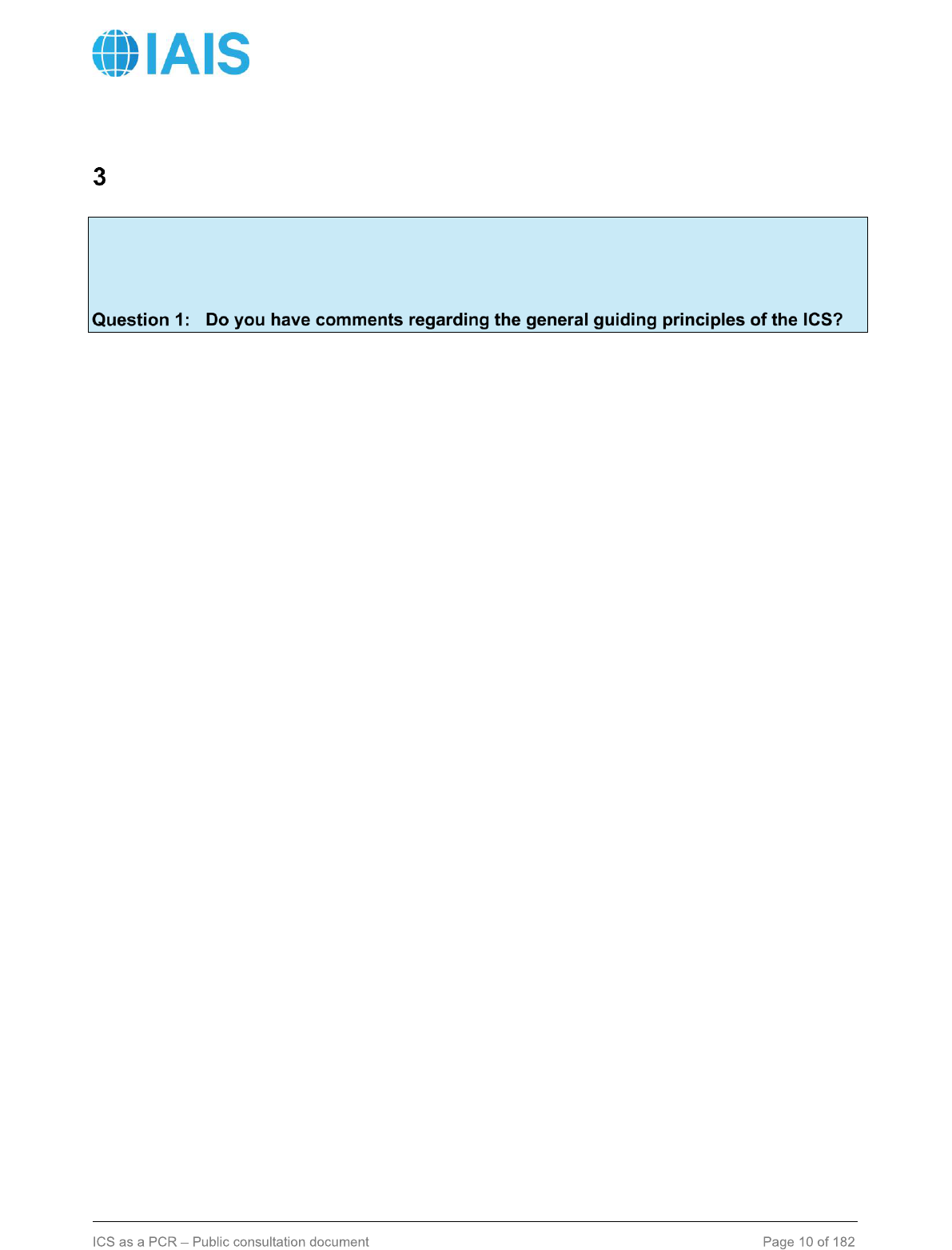
Public
General Guiding Principles
Changes compared to ICS Version 2.0:
This section has not incurred any change compared to ICS Version 2.0 for the monitoring period.
3.1 Substance over Form
L1-1. The ICS balance sheet differs from publicly reported GAAP financial statements, as it
reflects a different objective (prudential supervision as opposed to investor information). For
example, certain assets in a GAAP balance sheet do not qualify as assets for the ICS.
L1-2. The economic substance of transactions and events are recorded in the ICS balance sheet
rather than just their legal form, in order to present a true and fair view of the risk profile of the entity.
This may require the use of judgment when preparing the ICS balance sheet.
L1-3. The allocation of insurance liabilities to the ICS line of business segments follows the
principle of substance over form. This means that insurance liabilities are allocated to the segment
that best reflects the nature of the underlying risks rather than the legal form of the contract. The
definitions for the insurance line of business segmentation are specified in the Level 2 text.
3.2 Proportionality
L1-4. Calculations and valuation are subject to the proportionality principle. When the IAIG can
demonstrate that taking into account a specific factor/rule in their calculation or valuation would lead
to a significant increase in complexity, without material improvement to the quality of the figure
produced or to the assessment of risk linked to this figure, then this factor or rule can be ignored or
simplified.
L1-5. The materiality of the impact of using a simplification is assessed with regard to:
• The volume of the item valued;
• The overall volume of the group’s business and capital resources; and
• The assessment of risk.
3.3 Look-Through
L1-6. In order to assess properly the risk inherent in collective investment funds and other indirect
exposures, their economic substance needs to be taken into account. This is achieved, to the extent
possible, by applying a look-through approach. Additional requirements on the use of look-through
are provided in the Level 2 text.
L2-1. The look-through approach applies to insurance arrangements and indirect investments
(including unleveraged mutual funds, other collective investment vehicles, etc.) in order to identify
all underlying exposures embedded in such arrangements and investments, including all indirect

Public
holdings that may artificially inflate the qualifying capital resources of an Internationally Active
Insurance Group (IAIG).
L2-2. When a full look-through is not possible, a partial look-through may be applied, along the
lines provided by the Basel III framework
6
.
L2-3. When no look-through is possible, the full investment is considered as unlisted equity for
the purpose of calculating the insurance capital standard (ICS) risk charges.
3.4 ICS Rating Categories
L1-7. The IAIS has developed a mapping between ICS Rating Categories (ICS RC) and credit
rating agency ratings. ICS Rating Categories range from 1 to 7. Additional specifications on ICS
Rating Categories, including the mapping to agency ratings, are included in the Level 2 text.
L2-4. Whenever the use of an ICS Rating Category (ICS RC) is needed, the IAIG uses the agency
ratings listed in the table below. Ratings from AM Best may be used only for calculating the risk
charge on reinsurance exposures. Modifiers such as + or – do not affect the ICS RC. Where two
ratings are listed in a cell, the first rating represents a long-term rating, and the second rating
represents the short-term rating mapped to the same ICS RC. The short-term rating is used only for
instruments with a remaining maturity of one year or less.
Table 2: Mapping to ICS RC (for instruments not in default)
ICS RC
S&P
Moody’s
Fitch
JCR
R&I
DBRS
AM Best
1
AAA
Aaa
AAA
AAA
AAA
AAA
2
AA / A-1
Aa / P-1
AA / F1
AA / J-
1
AA / a-1
AA / R-1
A+
3
A / A-2
A / P-2
A / F2
A / J-2
A / a-2
A / R-2
A
4
BBB /
A-3
Baa / P-3
BBB /
F3
BBB /
J-3
BBB / a-
3
BBB / R-
3
B+
5
BB
Ba
BB
BB
BB
BB
B
6
B / B
B / NP
B / B
B / NJ
B / b
B / R-4
C+
7
CCC / C
and
lower
Caa and
lower
CCC / C
and
lower
CCC
and
lower
CCC / c
and
lower
CCC /
R-5 and
lower
C and
lower
L2-5. Additionally, the IAIG may use ratings issued by a rating agency that the banking regulator
in its jurisdiction (or for a subsidiary, in the subsidiary’s jurisdiction) has recognised as an External
Credit Assessment Institution (ECAI) under the Basel II framework. The ICS RC corresponding to a
6
http://www.bis.org/publ/bcbs266.htm.

Public
rating produced by such an agency is the Basel II rating category to which the supervisor has
mapped the rating (the combined rating class AAA/AA corresponds to ICS RC 2).
L2-6. ICS RCs 1 to 4 in the table above are considered investment grade.
L2-7. The use of ICS RCs is further developed in section 7.4.3.

Public
Perimeter of the ICS Calculation
Changes compared to ICS Version 2.0:
This section has not incurred any change compared to ICS Version 2.0 for the monitoring period.
4.1 Scope for Starting ICS Balance Sheet
L1-8. The starting point of the ICS is the audited consolidated GAAP balance sheet of the
insurance holding company of an insurance group or financial holding company of a financial
conglomerate.
L1-9. Where an IAIG does not prepare audited consolidated GAAP financials, statutory financial
statements are aggregated to reflect the group level starting balance sheet.
L1-10. The audited GAAP balance sheet is split into two components: (1) entities that are insurers,
and entities whose purpose is insurance related; and (2) non-insurance entities. The Level 2 text
provides further description of which entities are considered insurance related and non-insurance.
L1-11. The non-insurance entities are reported separately from insurance entities, on a GAAP
basis, with the exceptions described in the Level 2 text.
L2-8. The perimeter of the ICS calculation is defined as including all consolidated legal entities
within the IAIG.
L2-9. The starting point to derive the balance sheet of the insurance group, prior to application of
any Market-Adjusted Valuation (MAV) adjustments, is the consolidated Generally Accepted
Accounting Principles (GAAP) balance sheet of the Head of the IAIG, as defined in the Common
Framework for the Supervision of IAIGs (ComFrame). For entities that do not have consolidated
GAAP financials, see paragraph L2-15.
L2-10. For purposes of the ICS calculation, balance sheets are segregated into insurance related
and non-insurance components. The insurance portion of the balance sheet is comprised of entities
that meet the following definitions:
a. Insurer: Insurance legal entity or insurance group.
b. Insurance legal entity: A legal entity, including its branches, that is licensed to conduct
insurance, regulated and subject to supervision.
c. Insurance related entities: Legal entities that mainly exist to support the operations of the
insurer.
L2-11. Legal entities that comprise the consolidated GAAP balance sheet are further categorised
according to the following definitions in order to apply certain accounting treatments that differ from
GAAP as well as to derive a capital requirement for non-insurance components:
a. Insurer and Insurance related entities;
b. Regulated non-insurance financial entity;
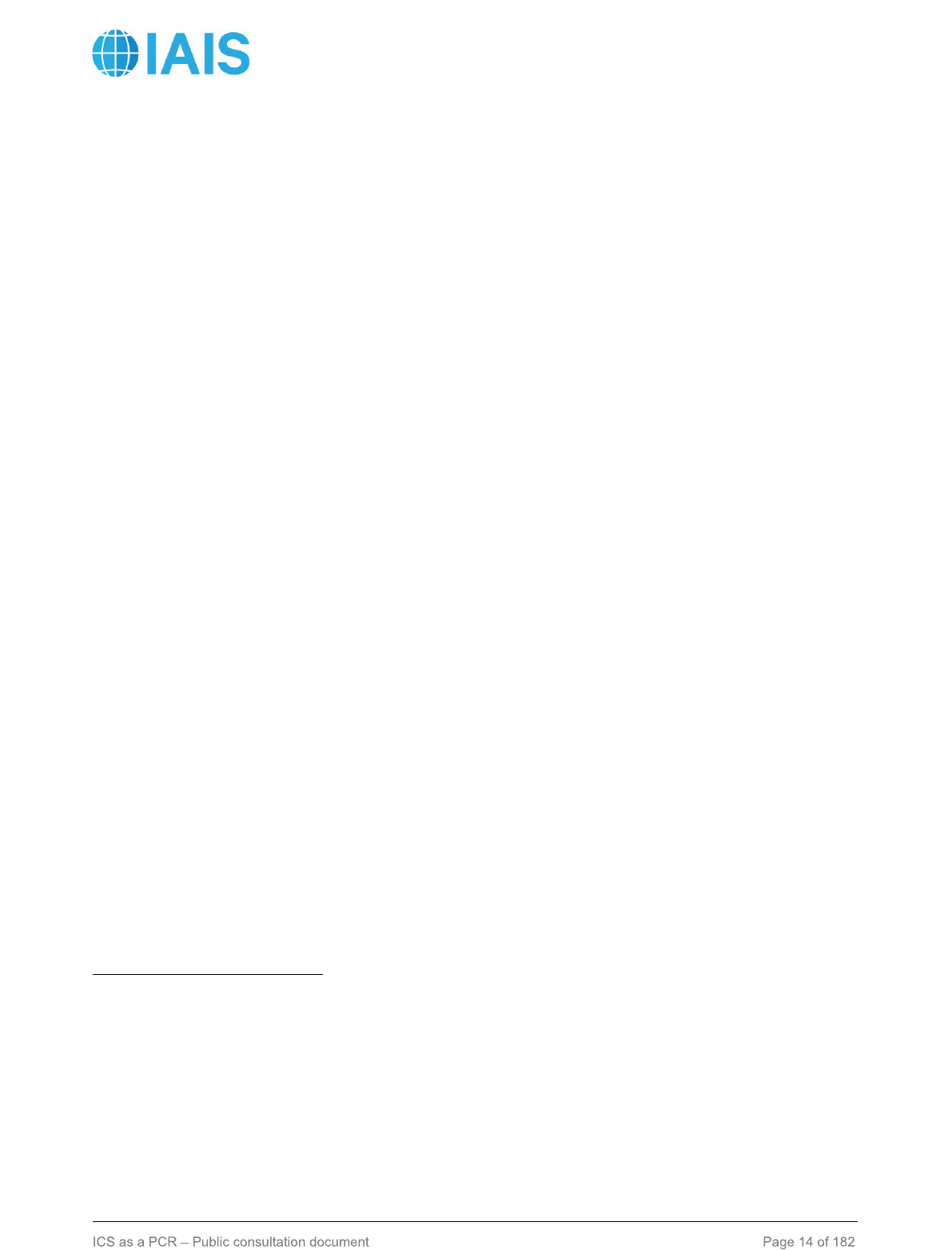
Public
c. Non-regulated non-insurance financial entity; and
d. Non-financial entity.
L2-12. The ICS follows GAAP accounting rules for consolidation accounting treatment except for
the following:
a. For insurer and insurance related entities that are determined under GAAP to be controlled
as joint ventures
7
, a proportional consolidation method is used unless it is determined through
consultation with the group-wide supervisor (GWS) that such treatment is not considered
feasible; in which case the entity remains unadjusted and reported as per GAAP as an equity
method investment.
b. For insurer and insurance related entities that are determined under GAAP to be controlled
as joint operations
8
and reported by recognising its own assets, liabilities and transactions,
including its share of those incurred jointly, the entity may remain unadjusted (ie proportional
consolidation on shared assets).
c. For non-insurance financial and non-financial entities that are determined under GAAP to be
joint operations and reported by recognising its own assets, liabilities and transactions,
including its share of those incurred jointly, the entity is reported as an equity method
investment.
d. For non-insurance financial and non-financial entities that are determined under GAAP to be
joint ventures, the entity is reported as an equity method investment.
L2-13. Adjustments related to non-voting interest entities
9
:
a. A non-voting interest entity that has been determined under GAAP to be unconsolidated is
consolidated if either the IAIG or its GWS assesses that it poses a material risk
10
to the group,
either individually or in the aggregate.
b. A securitisation originated within the group may not be consolidated provided that it meets
all of the conditions outlined in Annex 1.
c. Notwithstanding the materiality assessment or application of additional criteria, a non-voting
interest entity is consolidated when the GWS determines that the nature, scale and
complexity of the risks cannot be considered insignificant.
L2-14. Other non-GAAP adjustments: Structured settlement agreements with third parties are
recorded on a net basis (ie removed from reserves and reinsurance recoverables) when the
7
A joint venture is a joint arrangement whereby the parties that have joint control of the arrangement have rights to the net assets of the
arrangement.
8
A joint operation is a joint arrangement whereby the parties that have joint control of the arrangement have rights to the assets, and
obligations for the liabilities, relating to the arrangement.
9
A non-voting interest entity is an entity where voting or similar rights are not the dominant factor in assessing control. Entities are often
thinly capitalised or contain no capital and are designed for a specific purpose (eg, special purpose entities, structured entities, GP/LP
structures, trusts and investment partnerships).
10
Material risk in this case relates to the risks posed to the group. In considering what might significantly contribute to group risks, a firm
may assess whether the related entity’s gross assets or gross revenue are more than 1% of the group’s gross assets or revenue. In
addition, an assessment of all immaterial entities exceeding 5% of the group’s asset’s or revenue, in the aggregate, may indicate that
other entities should be consolidated in order to avoid missing material risks.

Public
underlying claim is settled and the risk to the non-life company is contingent upon the life insurer
(and the guarantee fund, if applicable) having the ability to pay.
L2-15. Aggregated group balance sheet: an IAIG that does not prepare consolidated or group level
financial statements generates a balance sheet on an aggregated basis to reflect group level starting
balances.
L1-12. Non-insurance entities (financial and non-financial) are incorporated into the reference ICS,
based on the entity type and whether or not the entity is subject to a sectoral capital requirement.
The capital requirement for financial non-insurance entities is based on the entity’s sectoral capital
rules, when available. For financial non-insurance entities without sectoral capital rules and for non-
financial entities, the capital requirement included in the reference ICS is described in the Level 2
text. For all non-insurance entities, capital resources follow the capital resources framework set out
for the reference ICS.
4.2 Development of Starting MAV Balance Sheet
L1-13. The starting MAV balance sheet is comprised of the insurance and insurance-related
entities.
L1-14. The starting MAV balance sheet is subject to adjustments as described in the Level 2 text
and section 5.

Public
Market-Adjusted Valuation
Changes compared to ICS Version 2.0:
The MAV framework utilises the Three Bucket Approach to determine the level of spread adjustment
to the risk free curve for purposes of discounting liability cash-flows. Liabilities are classified into the
Top, Middle or General Buckets (unless they can be replicated by a portfolio of assets) depending
on the nature of the liabilities, their predictability, the assets backing those liabilities and the cash-
flow matching between assets and liabilities.
A spread term structure adjustment for the General and Middle Bucket has been introduced. This is
intended to be more consistent with market reality as spreads typically differ by maturity. In general,
the spread term structure leads to lower spread adjustments for shorter maturities and higher spread
adjustments for longer maturities compared to ICS 2.0.
There were specific instances in which an increase in credit spreads resulted in a greater reduction
in insurance liabilities than in asset values, producing an increase in capital resources. This increase
in capital resources may not be warranted if it is driven by asset-liability mismatches. A modulation
factor has been introduced for the General and Middle Buckets to mitigate non-economic increases
of solvency ratios in stress situations.
It was observed that the Middle Bucket criteria may be too restrictive and prevent products with a
high predictability of cash flows to qualify for the Middle Bucket. The Middle Bucket criteria have
been refined to include a broader range of products with predictable cash-flows (L2-69d and L2-
69e). In addition, the spread adjustment for the Middle Bucket can be computed portfolio-specific,
rather than currency-specific.
It was observed that the design of the spread adjustment for the Middle Bucket may disincentivise
holding of non-fixed income assets. Holding such assets results in a reduction of the overall Middle
Bucket spread adjustment, even if the assets are being held to match cash flows at late maturities
(beyond Last Observable Term). The computation of the spread adjustment has been revised to
address this.
5.1 Valuation Principles
L1-15. The MAV approach is based on the amounts as reported on audited, consolidated, general-
purpose GAAP or Statutory Accounting Principles (SAP) accounts, and includes adjustments to the
following items:
a) Insurance liabilities and reinsurance balances;
b) Financial investments (assets) and instruments (liabilities); and
c) Deferred taxes.
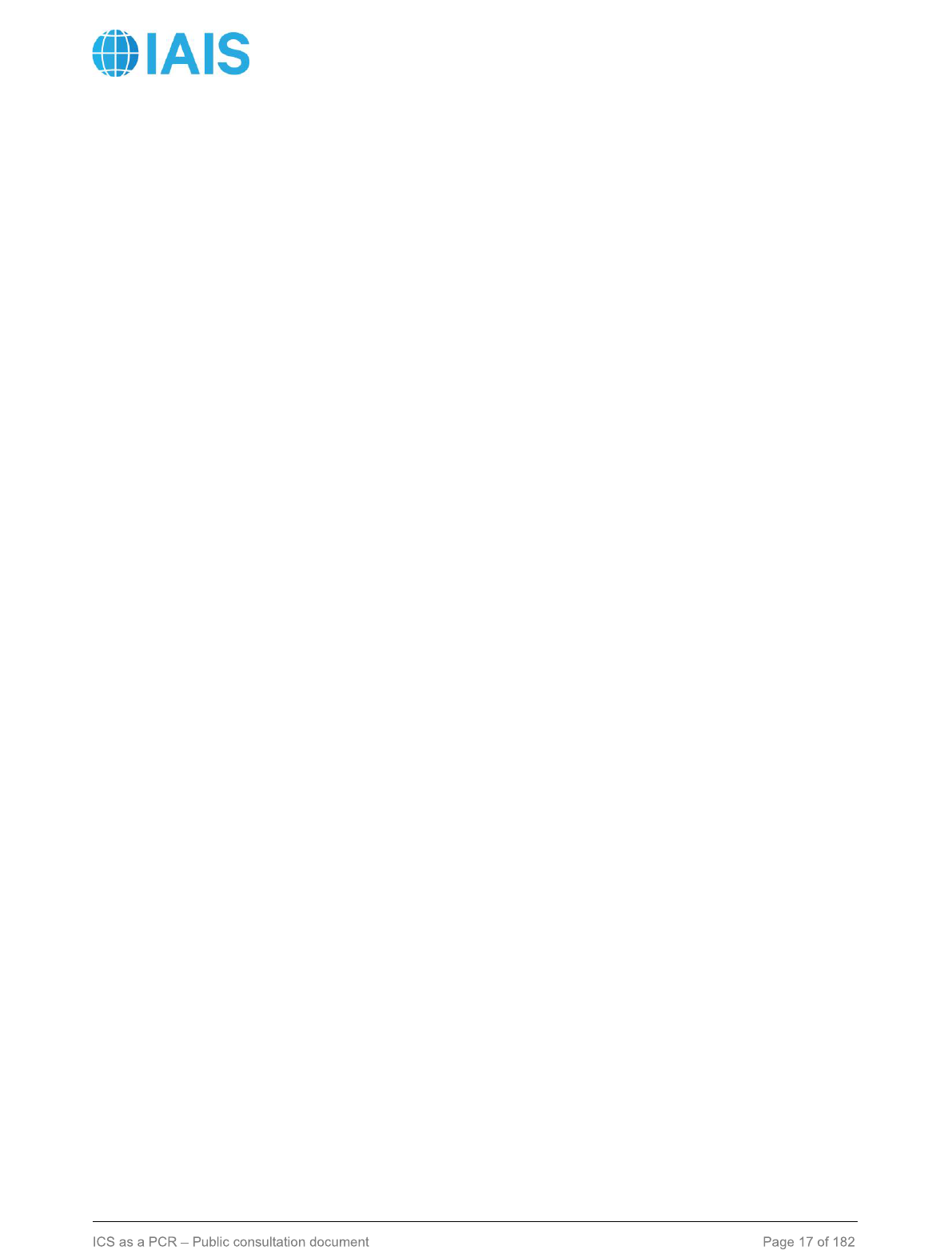
Public
L1-16. Unless they are replicable by a portfolio of assets (cf section 5.4), MAV insurance liabilities
are the sum of a current estimate and a margin over current estimate (MOCE). The details
underpinning the calculation of the current estimate and the MOCE are developed in the following
sub-sections as well as in the Level 2 text.
L1-17. The adjustments to items b) and c) are described in the Level 2 text.
L2-16. When deriving the adjustments to be made to insurance liabilities, reinsurance balances,
financial investments and instruments, and tax, the IAIG applies the following principles:
a. Property for own use is adjusted to fair value using the fair value guidance under the IAIG’s
GAAP or when the IAIG does not produce a GAAP consolidated balance sheet, the GAAP
fair value principles in the IAIG’s jurisdiction.
b. Mortgages and loans are adjusted to fair value using the fair value guidance under the
IAIG’s GAAP or when the IAIG does not produce a GAAP consolidated balance sheet, the
GAAP fair value principles in the IAIG’s jurisdiction.
c. Reinsurance recoverables are restated on a basis consistent with the determination of
insurance liabilities. Recoverables on paid and unpaid balances are reported net of
allowances for estimated uncollectable amounts.
d. Deferred tax assets (DTA) and liabilities (DTL) are treated according to section 8.
e. Deferred acquisition costs and other deferred expenses that are on the balance sheet at
the reporting date are adjusted to zero. Future acquisition costs related to future premiums
(within contract boundaries – see section 5.2.2) are reflected in the value of insurance
liabilities.
f. Premium receivables falling due after the reporting date and related to contracts that are
included in the current estimate calculation are reflected in the valuation of insurance
liabilities as negative cash flows. Premium receivables for which the due date is prior to the
reporting date are not part of the current estimate calculation and remain as assets on the
balance sheet.
g. Loans to policyholders are reported separately and are not netted against insurance
liabilities.
h. Other financial assets that are reported on the GAAP balance sheet at amortised cost (eg
Hold-To-Maturity investments) are restated to a fair value.
i. Financial liabilities: upon initial recognition, the valuation of these items is based on the
IAIG’s reported GAAP, and there is no subsequent adjustment to take account of changes to
the IAIG’s own credit standing.
5.2 Current Estimate
5.2.1 Basis for calculation
L1-18. The current estimate corresponds to the probability-weighted average of the present values
of the future cash-flows associated with insurance liabilities, discounted using the yield curve
relevant for the currency and bucket of each liability. The three buckets to which liabilities can be
allocated are described in section 5.2.5.3.

Public
L1-19. The current estimate does not include any implicit or explicit margins.
L1-20. Reinsurance recoverables are calculated in a way that is consistent with the current
estimates of insurance liabilities, based on the same assumptions and inputs.
L1-21. When valuing insurance liabilities, no adjustment is made to take into account the IAIG’s
own credit standing.
L1-22. More details on how to project cash-flows for the current estimate calculation are provided
in the Level 2 text.
5.2.1.1 General considerations
L2-17. The current estimate calculation is based on the probability weighted average of the future
cash flows, taking into account the uncertainty relating to:
a. The timing, frequency and severity of claim events;
b. Claim amounts and claim inflation, including where relevant any uncertainty on the value of
indices used to determine claim amounts;
c. The time needed to settle claims;
d. The amount of expenses; and
e. Policyholder behaviour.
L2-18. Cash flow projections reflect expected future demographic, legal, medical, technological,
social or economic developments, and are based on appropriate inflation assumptions, recognising
the different types of inflation to which the entity can be exposed. Premium adjustment clauses are
also considered, where relevant.
L2-19. The current estimate is calculated gross of reinsurance and special purpose vehicles (SPV).
Recoverables from reinsurance or SPVs are calculated separately and recognised as an asset.
L2-20. The projected cash flows include at a minimum the following items within the contract
boundaries:
a. Benefit and claim payments;
b. Direct and indirect expenses incurred;
c. Premiums received;
d. Subrogation payments and recoveries other than from reinsurance and special purpose
vehicles; and
e. Other payments made in order to settle the claims.
L2-21. All expenses related to existing contracts and contracts that are recognised at the reporting
date, but not yet in force, are included in the current estimate calculation. The expenses estimation
assumes that the IAIG will write business in the future. Future expenses relating exclusively to future
business are not considered for the current estimate calculation.
L2-22. Where a yield curve is needed as input to assess future returns on assets, the IAIG makes
use of the relevant IAIS yield curves with specified adjustments.

Public
5.2.1.2 Options and guarantees
L2-23. The expected cash flows relating to options and guarantees embedded in the insurance
contract are taken into account for the calculation of the current estimate. All payments connected
to the risks insured, and profit participation payments in particular, are taken into consideration for
the calculation of the value of options and guarantees.
L2-24. All options and guarantees are valued using arbitrage-free techniques
11
based on the
adjusted yield curve as a proxy for the risk-free curve.
5.2.1.3 Policyholder behaviour
L2-25. Where relevant, expected cash flows reflect the contractual right of policyholders to change
the amount, timing or nature of their benefits.
L2-26. The likelihood that policyholders will exercise contractual options, including lapses and
surrenders, is taken into account with a prospective view, considering in particular:
a. Past and expected behaviour of policyholders, considering also their reaction to management
actions;
b. How beneficial the exercise of options would be to policyholders under specific
circumstances; and
c. Economic conditions.
L2-27. To the extent that it is deemed representative of future expected behaviour, assumptions
on policyholder behaviour are based on appropriate statistical and empirical evidence.
L2-28. The assumptions concerning policyholder behaviour are consistent with the assumed
investment returns and the yield curves used for discounting insurance liabilities.
5.2.1.4 Future discretionary benefits
L2-29. Future discretionary benefits (FDB) are comprised of all non-guaranteed amounts, including
those bonuses linked to a legal or contractual obligation to distribute a portion of the IAIG’s
financial/underwriting profits to policyholders.
L2-30. The current estimate recognises FDB expected to be paid consistently with expected future
developments, the economic scenarios on which the liability valuation is based and policyholders’
reasonable expectations.
L2-31. The projection of FDB is also consistent with the yield curve applicable to the contract, as
well as with the modelling of policyholder behaviour as described in section 5.2.1.3.
5.2.2 Contract recognition, contract boundaries and time horizon
L1-23. A contract is recognised when the IAIG becomes a party to that contact, until all obligations
related to that contract are extinguished. All contracts that are recognised at the valuation date, and
only those, are taken into account for the current estimate calculation.
11
This implies in particular that where relevant, path dependency is taken into account in the valuation of options and guarantees.

Public
L1-24. The future premiums and associated claims and expenses linked to those recognised
contracts are taken into account up to each contract boundary.
L1-25. The projection horizon used in the calculation of the current estimate covers the full lifetime
of all the cash in- and out-flows required to settle the obligations (within contract boundaries) related
to recognised insurance and reinsurance contracts at the valuation date.
L1-26. The details for contract recognition and contract boundaries are specified in the Level 2 text.
L2-32. A contract is recognised and valued as soon as the IAIG becomes party to that contract,
without any possibility to amend or cancel it, even when the insurance coverage has not yet started.
L2-33. A contract is derecognised when all possible claims linked to this contract have been
completely settled, and all future cash-flows are nil.
L2-34. Only those contracts recognised at the reporting date are taken into account in the current
estimate calculation; in particular, no future business is included in the calculation.
L2-35. All obligations, including future premiums, relating to a recognised contract are taken into
account in the current estimate cash flow projection. However, future premiums (and associated
claims and expenses) beyond either of the following dates are not considered, unless the IAIG can
demonstrate that it is able and willing to compel the policyholder to pay the premiums:
a. The future date where the IAIG has a unilateral right to terminate the contract or reject the
premiums payable under the contract; or
b. The future date where the IAIG has a unilateral right to amend the premiums or the benefits
payable under the contract in such a way that the premiums fully reflect the risks.
L2-36. For group policies, similar rules apply. If premiums can be amended unilaterally for the
entire portfolio in a way that fully reflects the risks of the portfolio, the second condition above is
considered to be met.
5.2.3 Data quality and setting of assumptions
L1-27. The calculation of the current estimate is based on up-to-date and credible information and
realistic assumptions. The determination of the current estimate is objective, comprehensive, and
uses observable input data.
L1-28. The requirements relating to data quality and modelling assumptions are specified in the
Level 2 text.
L2-37. When selecting data for the calculation of the current estimate, the IAIG considers:
a. The quality of data based on the criteria of accuracy, completeness and appropriateness;
b. The use and setting of assumptions made in the collection and processing of data; and
c. The frequency of regular updates and the circumstances that trigger additional updates.
L2-38. When only limited or unreliable data are available from the IAIG’s own experience, the IAIG
supplements its own data with data from other sources. When the characteristics of the portfolio
differ from those of the population represented in the external data used, the external data are
adjusted in order to ensure consistency with the risk characteristics of the IAIG’s portfolio.

Public
L2-39. The assumptions used to calculate the current estimate reflect current expectations based
on all information available. This requires an assessment of expected future conditions, in particular
as soon as:
a. There is evidence that historical trends will not continue, that new trends will emerge or that
economic, demographic and other changes may affect the cash flows that arise from the
existing insurance contracts.
b. There have been changes in underwriting procedures and claims management procedures
that may affect the relevance of historical data to the portfolio of insurance contracts.
c. Historical data do not capture types of events that may have an impact on the current
estimate.
5.2.4 Management actions
L1-29. The current estimate calculation may recognise management actions when such actions
are objective, realistic and verifiable. Management actions recognised in the calculation are not
contrary to the IAIG’s obligations to policyholders or to legal provisions applicable to the IAIG.
L1-30. Further details regarding the recognition of management actions in the current estimate
calculation are provided in the Level 2 text.
L2-40. The management actions recognised for the calculation of the current estimate are confined
to decisions by the IAIG that have an impact on future bonuses or other discretionary benefits for
participating/profit sharing and adjustable products.
L2-41. Assumed future management actions are consistent with the IAIG’s current business
practice and business strategy unless the GWS is satisfied that there is sufficient evidence that the
IAIG will change its practices or strategy.
L2-42. When calculating the current estimate, future management actions are taken into account
only if they can reasonably be expected to be carried out under the specific circumstances to which
they apply.
L2-43. The assumptions about future management actions take into account the time needed to
implement them, as well as any resulting incremental expenses.
5.2.5 Discounting
5.2.5.1 Determination of yield curves for current estimate discounting
L1-31. In order to calculate a current estimate, insurance liabilities are discounted using an
adjusted yield curve. The adjusted yield curve is based on:
a) Risk adjusted liquid interest rate swaps or government bonds (risk-free yield curve); and
b) An adjustment.
L1-32. The adjusted yield curve is determined based on the methodology specified in the Level 2
text (sections 5.2.5.2 and 5.2.5.3).
5.2.5.2 Determination of the risk-free yield curve
L1-33. The risk-free yield curve is determined based on a three-segment approach:
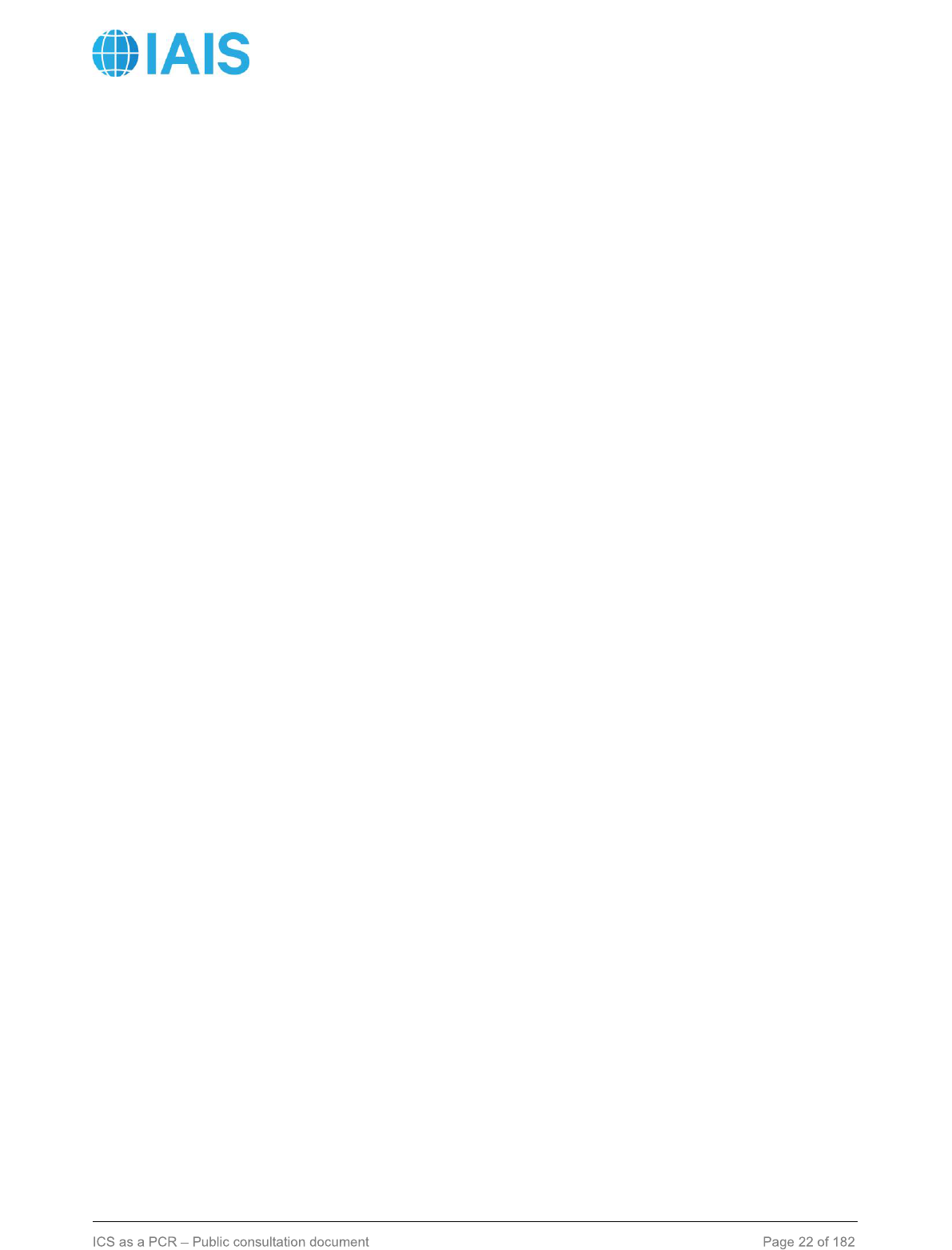
Public
a) Segment 1: based on market information from government bonds or swaps, including a credit
risk correction, where necessary;
b) Segment 2: extrapolation between the first and third segments; and
c) Segment 3: based on a stable currency specific long-term forward rate (LTFR), to which a
spread is added in order to represent the expected spread that may be earned from
reinvestments in the long-term.
L1-34. For each currency, the transition from the first to the second segment occurs at the last
maturity for which market information can be observed in deep, liquid and transparent financial
markets (the last observed term or LOT).
L1-35. For each currency, the LTFR is the sum of an expected real interest rate and an inflation
target.
L1-36. For the purpose of determining the expected real interest rate, jurisdictions are allocated
according to areas that share common macroeconomic characteristics. The same expected real
interest rate is used for all currencies within a given area. For each area, the expected real interest
rate is based on a simple average of observed real interest rates over a certain period of time.
L1-37. The two components of the LTFR are reviewed annually, in order to reflect potential
changes in macroeconomic expectations. However, the magnitude of annual changes to the LTFR
is capped in order to mitigate its potential volatility.
L1-38. Further specifications on the methodology to determine the risk-free interest rate are
provided in the Level 2 text.
5.2.5.2.1 Choice of instrument for and length of Segment 1
L2-44. The base yield curves are derived from financial instruments that are traded in deep, liquid
and transparent (DLT) financial markets. A DLT assessment is carried out at regular intervals in
order to identify the financial instruments and maturities for which a DLT market exists.
L2-45. The DLT assessment determines, in particular, whether swaps or government bonds are
the relevant financial instruments for the risk-free interest rates and what the LOT is. The DLT
assessment is performed for each currency.
5.2.5.2.1.1 DLT assessment of the swap market
L2-46. The assessment of depth and liquidity of the swap market is carried out on the basis of
swap trade data, in particular the number and notional amount of trades and is made separately for
each currency and maturity. Only single-currency fixed-to-floating swaps are considered. Thresholds
may need to be adapted in light of the specific circumstances of individual markets (eg less liquid
currencies).
5.2.5.2.1.2 DLT assessment of the government bond market
L2-47. Given the specificity of government bond markets, a different approach to swap markets
may be followed to assess the DLT nature of government bond rates.
L2-48. The assessment starts from the analysis of trade volume and trade frequency of
government bonds, for all currencies.
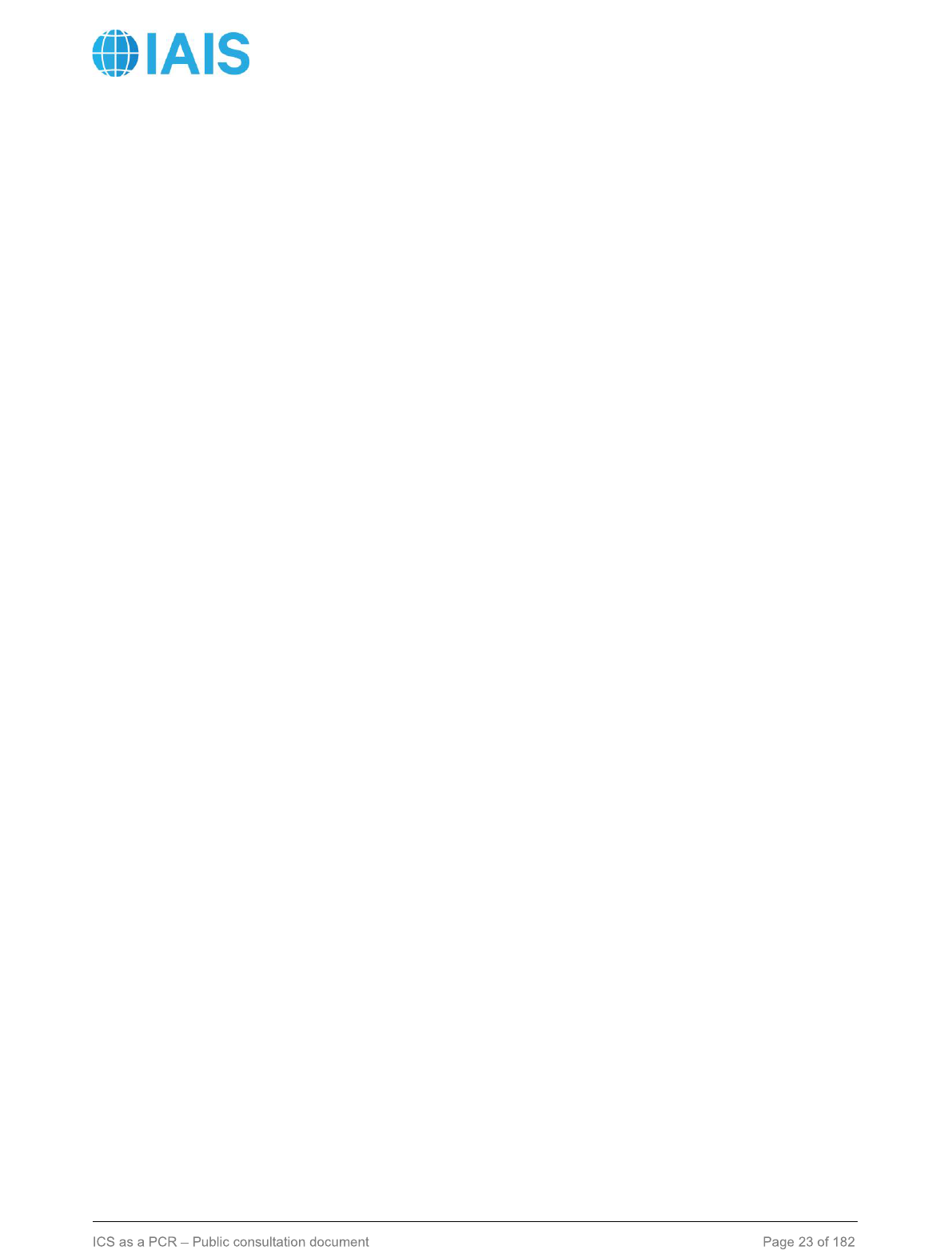
Public
L2-49. Where trade volume and frequency data are not available or their analysis is not conclusive,
other criteria are assessed, including where possible, bid-ask spreads, the rate volatility, zero-trading
days, the number of pricing sources and the number of quotes.
5.2.5.2.1.3 Conclusions from the assessment
L2-50. The DLT assessment of the relevant instruments informs the choice of the instrument on
which the base yield curve is built upon, as well as the DLT maturities that are used in the derivation
of the base yield curve.
L2-51. To maximise the use of market information, the instrument with the longer DLT segment or
the instrument with a higher overall degree of liquidity should be chosen.
L2-52. Given the specificities of the financial markets of each currency, the group wide supervisor
should seek advice from the relevant jurisdiction which instrument to take as a basis, with due
consideration of the key objectives of the MAV approach. An appropriate justification for this choice
is presented, covering also the outcome of the DLT analysis.
5.2.5.2.1.4 Last Observed Term (Length of Segment 1)
L2-53. Following the DLT assessment and the choice of the instrument underlying segment one of
the yield curve, the LOT is set taking into consideration
• the longest maturity which is deemed to fulfil the DLT criteria, for the chosen instrument; and
• the specificities of the financial market.
5.2.5.2.2 Credit Risk Adjustment
L2-54. Inputs from chosen instruments are subject to the Credit Risk Adjustment (CRA).
L2-55. The CRA is 0 basis points when instruments for Segment 1 are considered risk free. The
CRA is 10 basis points otherwise.
5.2.5.2.3 Length of Segment 2
L2-56. For all currencies, the start of the third segment as referred to in paragraph L1-33 of the
Level 1 text is the later of the following:
• 30 years after the LOT; and
• 60 years.
5.2.5.2.4 Extrapolation, Interpolation and Convergence tolerance
L2-57. Both the interpolation between Segment 1 maturities and the extrapolation beyond the LOT
are based on the Smith-Wilson methodology.
L2-58. The control input parameters for the interpolation and extrapolation are the LOT, the LTFR,
the convergence point and the convergence tolerance.
L2-59. If the reference instruments are swap rates, the market interest rates to be used as inputs
are the swap par rates after deduction of the credit risk adjustments. If the reference instruments are
zero coupon government bonds, the market interest rates to be used as inputs are the zero-coupon
rates.
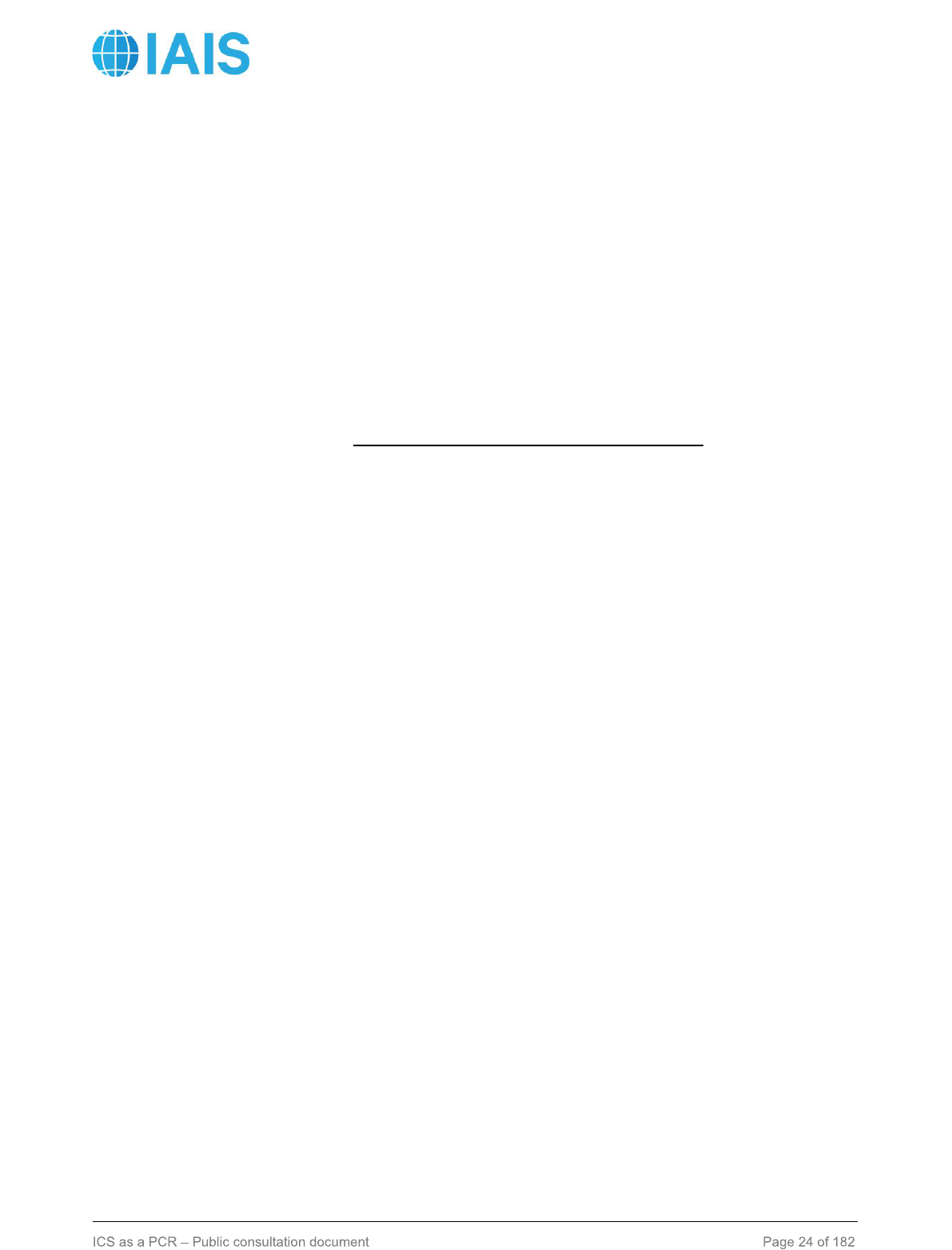
Public
L2-60. The parameter alpha that controls the convergence speed is set at the lowest value that
produces a yield curve reaching the convergence tolerance of the LTFR by the convergence point.
A lower bound for alpha is set at 0.05.
L2-61. The convergence tolerance is 0.1 basis point, and is achieved at the tenor which marks the
end of Segment 2.
5.2.5.2.5 LTFR Components
L2-62. The LTFR is the sum of the following two components:
a. The expected real interest rate, computed as the simple arithmetic mean of annual real
interest rates. Annual real rates are calculated as:
The expected real interest rate is rounded to the nearest five basis points.
b. The expected inflation target, computed as follows:
• For currencies for which the central bank has announced an inflation target, the expected
inflation is based on that inflation target. In this case the expected inflation rate is:
o 1%, where the inflation target is lower than or equal to 1%;
o 2%, where the inflation target is higher than 1% and lower than 3%;
o 3%, where the inflation target is higher or equal to 3% and lower than 4%; and
o 4%, otherwise.
• For currencies for which the central bank has not announced an inflation target, the expected
inflation rate is set to 2%. However, where past inflation experience and projection of inflation
both clearly indicate that the inflation in a currency area is materially higher or lower than 2%,
the expected inflation rate is chosen in accordance with those indicators.
L2-63. In order to determine the expected real interest rate, countries are grouped in the following
three geographical areas:
a. Geographical area 1, comprised of the following currency areas: AUD, CAD, CHF, CZK,
DKK, EUR, GBP, JPY, NOK, NZD, SEK, SGD, USD;
b. Geographical area 2, comprised of the following currency areas: HKD, ILS, KRW, TWD;
c. Geographical area 3, comprised of all other currency areas.
L2-64. The initial values of the expected real interest rate component are:
• 1.8% for geographical area 1;
• 2.4% for geographical area 2; and
• 3.0% for geographical area 3.
The values will be regularly reviewed.
L2-65. The maximum annual change to the LTFR is limited to 15 bps. The LTFR is changed
according to the following formula:

Public
where:
•
denotes the LTFR of year , after limitation of the annual change;
•
denotes the LTFR of year , after limitation of the annual change; and
•
denotes the LTFR of year , before limitation of the annual change.
Explanatory text
For most commonly used currencies, the initial value of the following parameters (observed
instrument, LOT and LTFR) needed for the determination of the risk-free yield curve will be published
by the IAIS by the date of adoption of the ICS.
These initial values can be found in Annex 4. The IAIS will publish updated values when necessary.
5.2.5.3 Determination of the adjustment to the risk-free yield curve
L1-39. The ICS yield curves include an adjustment to the risk-free curves. This adjustment is
determined using the Three-Bucket Approach.
L1-40. The Three-Bucket Approach classifies liabilities into General Bucket, Middle Bucket and
Top Bucket, depending on the nature of the liabilities and the assets backing these liabilities. A
different yield curve adjustment is determined for each bucket.
L1-41. The criteria used for the classification of liabilities and the adjustment relevant for each
bucket are specified in the Level 2 text.
L2-66. The following spread over the LTFR is added to all LTFR calculated according to
paragraphs L2-62 to L2-65 above:
• 20 basis points for geographical area 1;
• 25 basis points for geographical area 2; and
• 35 basis points for geographical area 3.
using the geographical areas laid down in L2-63.
5.2.5.3.1 Classification criteria
L2-67. Insurance liabilities are eligible for the Top Bucket if they meet all of the following criteria:
a. They belong to the category of life insurance and disability annuities in payment with no cash
benefits on withdrawal, taking into account e) below.

Public
b. The portfolio of assets to cover the insurance liabilities is identified and, together with the
corresponding liabilities, it is managed separately, without being used to make payments
relating to other business of the IAIG.
12
c. The expected cash flows of the identified portfolio of assets replicate the expected cash flows
of the portfolio of insurance liabilities in the same currency, up to the LOT of the risk-free
yield curve for the relevant currency. Any mismatch, addressed through the carry forward of
cash generated from excess of asset cash flows at previous maturities, does not give rise to
material risks. Carry forward of cash is limited to 10% of the total undiscounted liability cash
flows up to the LOT. Where insurance liabilities are backed with assets denominated in a
different currency, those asset cash flows are taken into account in the cash flow testing,
provided that the currency mismatch is fully hedged and the cost of hedging is deducted from
the asset cash flows.
d. The contracts underlying the insurance liabilities do not include future premiums.
e. The portfolio of insurance liabilities includes either no surrender option for the policyholder or
only a surrender option where the surrender value does not exceed the value of the assets
identified for this portfolio at the reporting date and at all future points in time.
L2-68. No unbundling is allowed when assessing eligibility for the Top Bucket.
L2-69. Insurance liabilities are eligible for the Middle Bucket if they meet all of the following criteria:
a. The portfolio of assets to cover the insurance liabilities is identified and, together with the
corresponding liabilities, is managed separately, without being used to cover losses arising
from other business of the IAIG.
12
b. The portfolio of insurance liabilities include either no surrender option for the policyholder or
only a surrender option where the surrender value does not exceed the value of the assets
identified for this portfolio at the reporting date.
c. The ICS Lapse risk charge does not represent more than 5% of the current estimate of the
liabilities discounted using the risk-free yield curve.
d. The total market value of assets identified for this portfolio is, at the reporting date, greater
than the current estimate of the liabilities calculated using the General Bucket yield curve.
For the calculation of the total market value of assets, all assets identified for this portfolio
are taken into account, irrespective of their classification in Table 3.
e. The contracts underlying the liabilities do not include future premiums or include only future
premiums that are contractually fixed or are at the discretion of the IAIG. Policyholder options
to pay additional future premiums do not disqualify these liabilities from the Middle Bucket,
but all corresponding cash flows that are not at the discretion of the IAIG have to be
unbundled and are subject to the General Bucket.
12
For both the Top and Middle Buckets, the separate management of assets does not refer to a legal ring fencing but to a portfolio
segmentation of clearly identified assets that would support an identified group of insurance liabilities over their lifetime. Should a
portfolio be restructured within the entity, this being exceptional, the assets contained therein can only be transferred to another
portfolio when done in conjunction with their corresponding liabilities. This does not preclude changes in investments within a
portfolio in the normal course of business.
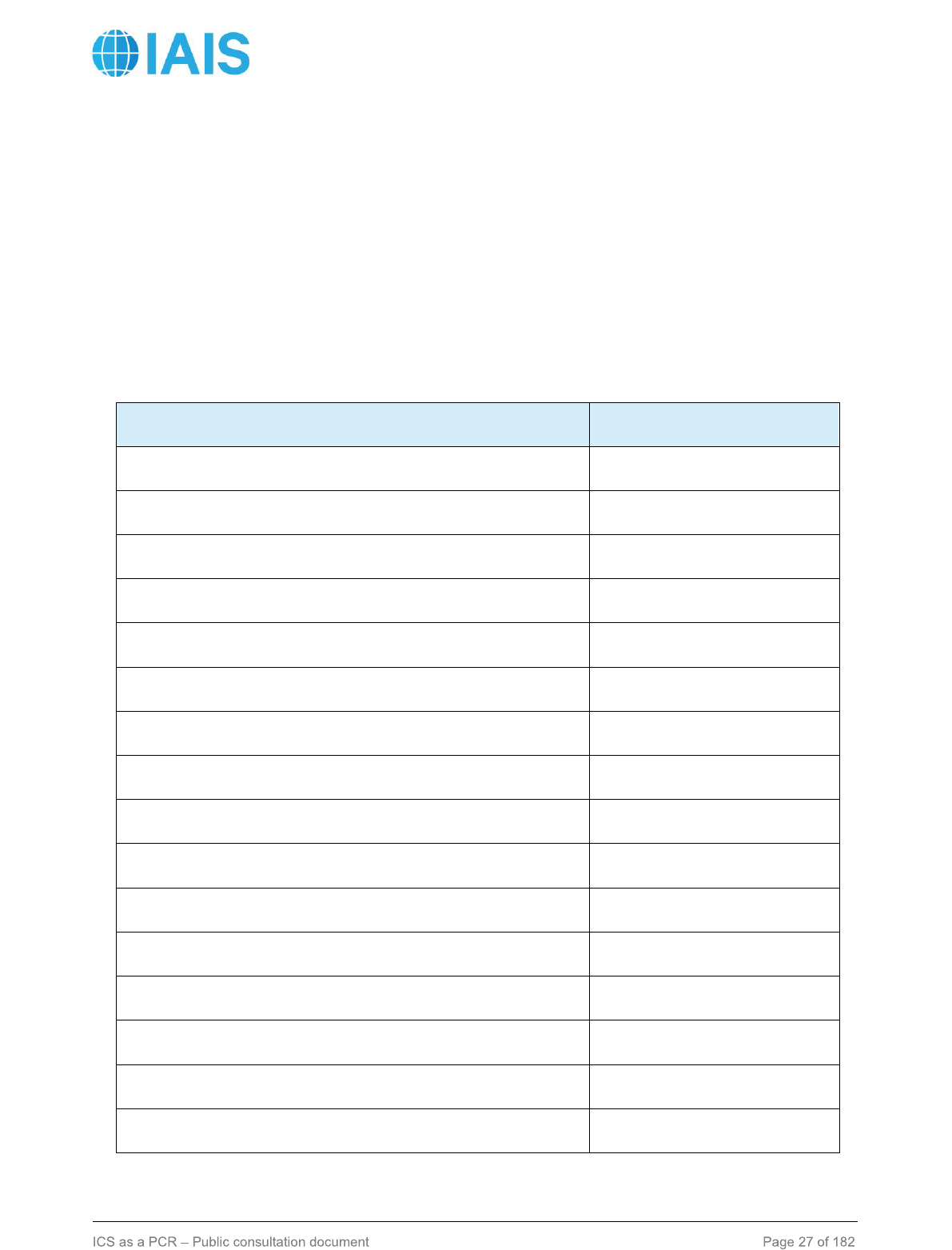
Public
L2-70. No unbundling is allowed when assessing eligibility for the Middle Bucket with the exception
in the context of L2-69e.
L2-71. All liabilities that are not in the Top or Middle Bucket belong to the General Bucket.
5.2.5.3.2 Adjustments to the yield curve
5.2.5.3.2.1 Eligible investments
L2-72. For the purpose of calculating the Top Bucket and Middle Bucket adjustments, the eligibility
of types of investments is specified in the following table:
Table 3: Eligibility of types of investment
Type of investment
Eligible
Cash and other liquid assets not for investment purposes
(Excluded from portfolio)
Investment income receivable/accrued
N
Fixed Interest Government Bonds
Y
Fixed interest Corporate Bonds
Y
Fixed Interest Municipal Bonds
Y
Variable Interest Government Bonds
Y
Variable interest Corporate Bonds
Y
Variable Interest Municipal Bonds
Y
Convertible notes
N
Residential Mortgage Loans
Y
Non-residential Mortgage Loans
Y
Other (non-mortgage) Loans
Y
Loans to policyholders
Y
Residential Mortgage Backed Securities
Y
Commercial Mortgage Backed Securities
Y
Other structured securities
Y
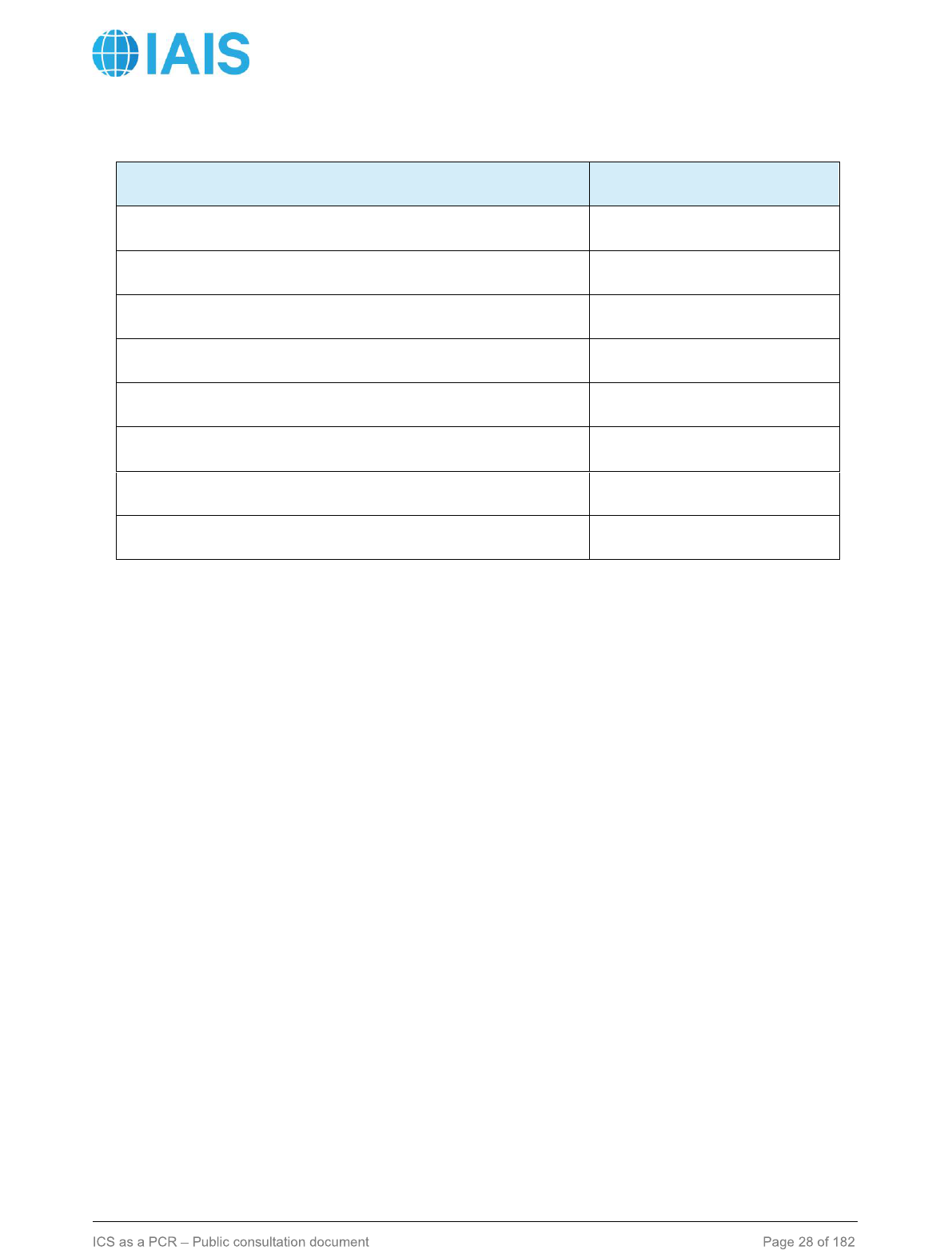
Public
Type of investment
Eligible
Insurance Linked Securities
N
Equities
N
Hedge Funds
N
Private equity
N
Real estate (for investment purposes)
N
Infrastructure debt
Y
Infrastructure equity
N
Other investment assets
N
L2-73. Assets backing unit-linked or separate account insurance liabilities are not taken into
account when those insurance liabilities are valued using the asset replication approach presented
in section 5.4.
L2-74. Government bonds include only debt instruments issued or guaranteed by central
governments (excluding exposures to municipal and other public sector entities).
L2-75. Assets featuring call options (used at the discretion of the issuer) are ineligible to back
liabilities, unless it can be demonstrated that the exercise of the option does not imply a loss to the
IAIG and that the matching of the liability cash flows can be maintained.
5.2.5.3.2.2 Top Bucket
L2-76. The adjustment for the Top Bucket is based on the average spread above the risk-free yield
curve of the eligible assets, as listed in Table 3, identified by the IAIG to back the portfolio of liabilities
meeting the Top Bucket criteria.
L2-77. The IAIG may identify different portfolios, which will lead to the calculation of
portfolio-specific adjustments.
L2-78. A cap at the level of the ICS RC 4 spread applies for assets with a lower credit quality. The
ICS RC 4 cap is based on the spreads earned by the IAIG for ICS RC 4 rated assets denominated
in the same currency. Where no such assets exist, the spread used for the Middle Bucket adjustment
calculation is used.
L2-79. The spread is adjusted for credit risk and any other risk, using the same risk correction
parameters as specified in paragraph L2-85.
L2-80. For the Top Bucket, 100% of the spread adjustment is added to the risk-free rate to discount
insurance liabilities.

Public
L2-81. The IAIG uses the relevant adjusted yield curves according to the currency of the insurance
liability cash outflows.
L2-82. Where insurance liabilities are backed with assets denominated in a different currency, the
spread adjustment for the currency of the liability includes spreads which may be earned by the IAIG
in those assets, provided that the currency mismatch is hedged. The cost of hedging is deducted
from the Top Bucket adjustment.
L2-83. The spread adjustment determined according to this methodology is applied as a parallel
shift up to the run-off of the liabilities, which may be beyond the relevant LOT.
5.2.5.3.2.3 Middle Bucket
L2-84. The Middle Bucket spread adjustment is a group-wide adjustment based on the eligible
assets backing the Middle Bucket liabilities. The Middle Bucket spread adjustment is portfolio specific
within a single currency.
L2-85. The term structure of spreads by credit quality and currency serve as a basis for the
calculation of the Middle Bucket adjustment.
L2-86. Parametric spread term structures are determined by credit quality and currency. They are
obtained using the Nelson-Siegel approach on observed market spreads up to the LOT. Credit
spreads are segmented by credit quality and duration buckets and sourced from recognised market
data providers or if needed, derived from supervisory data.
L2-87. These corporate spreads are supplemented with a contribution from sovereign holdings
when the risk-free rate for the currency is determined from observing swap market instrument. A
proportional risk correction factor is applied on these spread components. The risk correction on
government bonds is defined as 30% of the difference between the government bonds indices at the
reporting date and their average over the last 10 years.
L2-88. For corporate bonds, the risk correction factor captures the expected loss and the credit risk
premium. The expected loss is determined assuming an annualised probability of default for a
theoretical 10-year bond and a loss given default of 70%. Credit risk premium is based on one
standard deviation of the loss distribution.
L2-89. Where insurance liabilities are backed with assets denominated in a different currency, the
weighted average calculation of the spread adjustment for the currency includes spreads earned by
the IAIG in those assets, provided that the currency mismatch is hedged. The cost of hedging is
deducted from the adjustment to the spread recognised in the calculation of the Middle Bucket
adjustment. In case a rolling hedge strategy is in place, the cost of hedging is deducted from the
spread adjustment and an additional haircut of 20% is applied to the spread.
L2-90. The spread adjustment is calculated according to the Weighted Average of Multiple
Portfolios (WAMP) methodology, as specified in the following paragraphs.
L2-91. The
at maturity for a given portfolio is calculated as follows:

Public
where:
•
is the weight of government bonds;
•
is the weight of debt instruments belonging to ICS rating category i;
•
is the spread after risk correction corresponding to government bonds.
When a government bond rate is used for the risk-free yield curve, the applied spread is nil;
and
•
is the spread after risk correction corresponding to debt instruments
that belong to ICS rating category i.
L2-92.
and
are determined only considering eligible assets according to Table 3.
L2-93. Debt instruments in ICS RC 4 and lower, as well as unrated debt instruments, are allocated
to the ICS RC 4.
L2-94. In the case of currency unions, the sovereign exposure (and the corresponding weight in
the WAMP calculation) is split by jurisdiction within the currency union.
L2-95. The Total Observed Matching () ratio is computed as follows:
where:
is the maturity after which the insurance liabilities are not expected to generate
any cash flow, and M is the last maturity for which, under the cash flow test described in paragraph
L2-67.c, neither the cash carry forward limit of 10% is breached nor the remaining cash becomes
negative. When the remaining cash becomes negative on the first year of projection, M is taken
equal to 0. When the cash carry forward limit of 10% is not breached at any point in time, and the
remaining cash remains non-negative over the lifetime of liability, M is taken equal to
. For the purpose of determining M, asset cash flows in a different currency than
liability cash flows can be taken into consideration provided that either:
• the asset cash flows are fully hedged; or
• a rolling hedge is in place and the replacement frequency of the hedge is not less than one
month. In this case, a 20% haircut is applied on the asset cash flows.
The cost of hedging is deducted from the expected cash flows. Only cash flows from eligible assets
(Table 3) and cash can be used for the cash flow test.
L2-96. The final spread adjustment for the Middle Bucket (
) applied to the yield
curve is computed such that it is greater than or equal to the spread adjustment for the General
Bucket (
)) at each maturity .
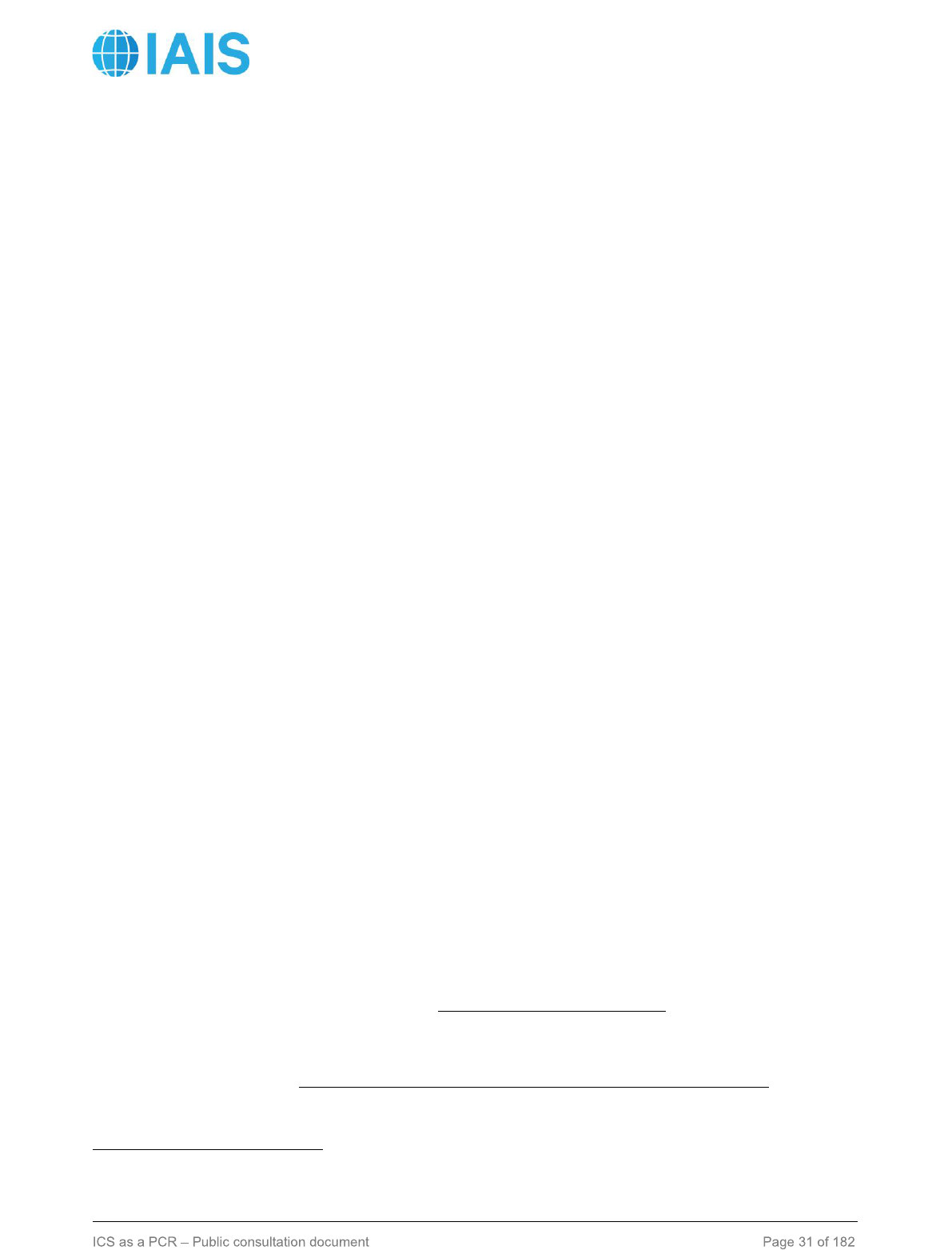
Public
L2-97. The spread adjustment
determined according to this methodology is
applied additively to the risk-free rate at each maturity up to year . After that maturity, the spread
adjustment is phased out in such a way that the resulting spot curve remains above the spot curve
for the corresponding General Bucket.
5.2.5.3.2.4 General Bucket
L2-98. The gross spread adjustment for the General Bucket (
) is based on a
representative portfolio that reflects the assets typically held by IAIGs in a particular currency.
L2-99. The gross spread adjustment
includes a correction for credit risk and
any other risk.
L2-100. For corporate bonds, the aforementioned correction is derived from the annualised
cumulative default experience for a hypothetical 10-year bond, computed on the basis of transition
matrices.
L2-101. For government bonds, the risk correction is determined depending on the data
underpinning the risk-free rate. Where risk-free rates are determined based on swap rates, risks
other than liquidity risk are assumed to represent 30% of the 10-year average spread. For currencies
where risk-free rates are based on government bond rates, no risk correction is applied.
L2-102. The spot rate for the General Bucket yield curve is computed as follows:
up to the LOT, where
is the risk-free spot rate at maturity and the IAIG specific modulation
factor. For Segments 2 and 3 of the adjusted yield curve, the same extrapolation methodology is
used as for determining the risk-free yield curve is applied to the adjusted yield curve.
L2-103. The IAIG uses the relevant adjusted yield curves according to the currency of the insurance
liability cash outflows.
5.2.5.3.2.5 Modulation Factor
L2-104. The modulation factor
is computed on a portfolio basis. It is computed using all assets,
which are sensitive to changes in credit spreads
13
, in the same currency spread bucket as the main
currency of the liabilities.
L2-105. The currency spread buckets are based on the spread mappings which are used for
determining the credit spreads for those currencies.
L2-106. The modulation factor
is computed using the following formula:
,
and
13
This includes government bonds when the respective yield curve is based on swaps.
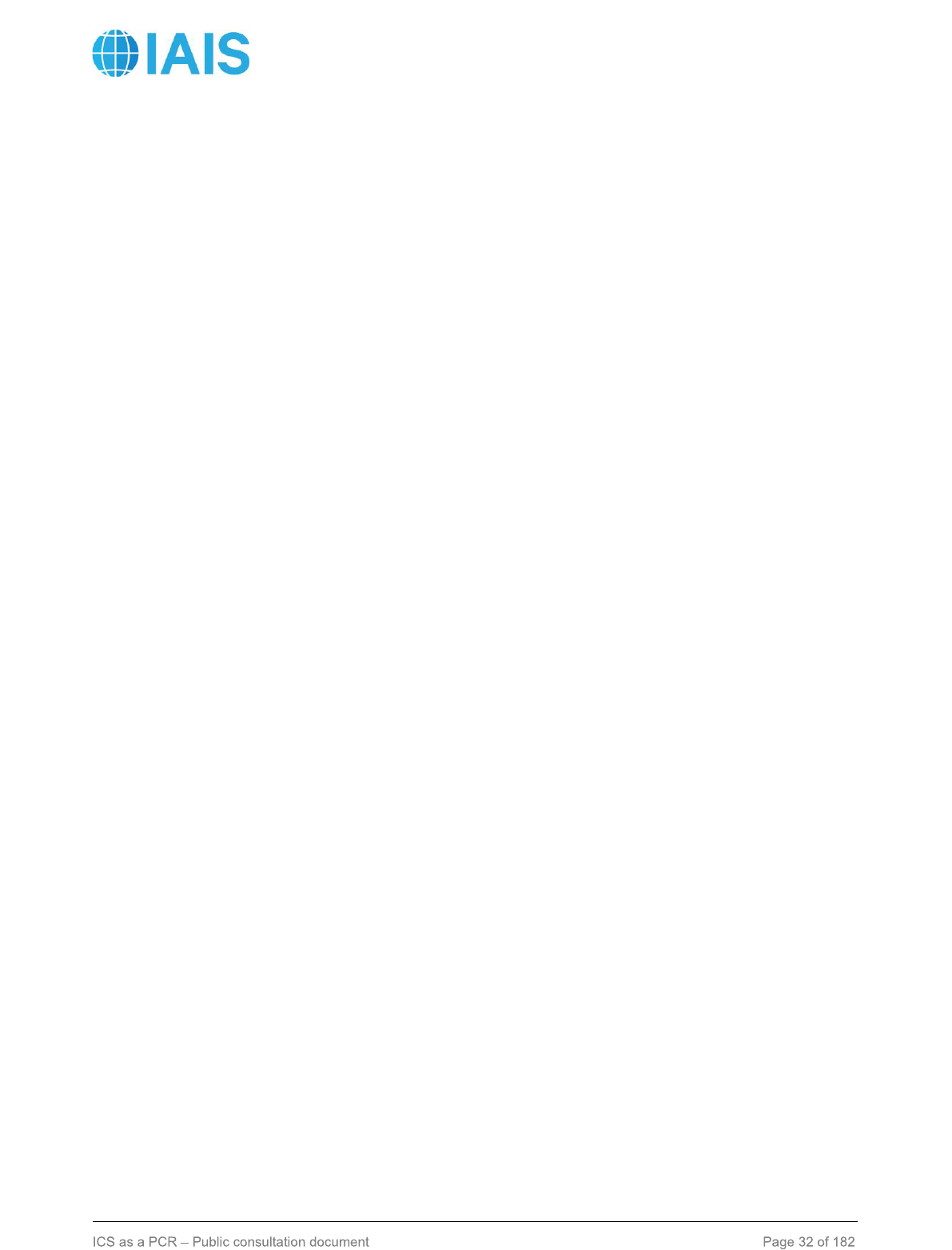
Public
where:
•
is the modulation factor to be applied for General Bucket portfolios;
•
is the modulation factor to be applied for Middle Bucket portfolios;
• stands for the price value of a basis point up, and is calculated in the following way
where is the current price and
the price obtained by applying a parallel shift of
one basis point upwards to the relevant yield curve. Changes in cash flows due to the parallel
shift of one basis point are considered when they are expected to have a non-negligible
impact on the ICS coverage ratio. The spot rates of the relevant yield curve
for
liabilities are obtained as follows:
up to the LOT and using the same extrapolation methodology for Segments 2 and 3 as used
for determining the risk-free yield curve. Re-calculations are performed taking into
consideration potential changes in cash-flows when interest rates change. The relevant yield
curve for assets is the yield curve used to determine the current balance sheet value.
•
is the weight of spread contributing assets.
is the weight of the
spread contributing assets for the Middle Bucket. These are computed using the parameters
as for paragraph L2-91.
5.3 Margin over Current Estimate (MOCE)
5.3.1 Definition and underlying principles
L1-42. The MOCE is a margin added to the current estimate of insurance obligations in order to
achieve a market adjusted value of insurance liabilities. The MOCE covers the inherent uncertainty
in the cash flows related to insurance obligations. As such, MOCE considers all uncertainties
attached to these obligations.
5.3.2 Calculation of the MOCE
L1-43. The MOCE is calculated as a given percentile of the normal distribution characterised by:
• A mean equal to the current estimate of life (and non-life) obligations; and
• A 99.5% percentile equal to the life (and non-life) risk charge.
L1-44. The percentiles for life and non-life insurance normal distributions are specified in the Level
2 text.
L2-107. The 85th percentile is used to compute the life component of the MOCE and the 65th
percentile is used for the non-life component.
5.3.3 Interaction of MOCE with other components
L1-45. All stress-based calculations include only current estimates for determining the pre- and
post-stress Net Asset Value (NAV), ie the MOCE remains constant during the stress. Factors applied
to insurance liabilities are only applied to current estimates. MOCE is neither deducted from the ICS
capital requirement, nor added to qualifying capital resources.

Public
5.4 Obligations replicable by a portfolio of assets
L1-46. Where future cash flows associated with insurance obligations can be replicated reliably,
using financial instruments for which a market value is observable, the value of insurance liabilities
associated with those future cash flows is determined on the basis of the market value of those
financial instruments.
L1-47. Additional conditions under which such an approach is applicable are specified in the Level
2 text.
L2-108. Insurance liabilities are considered to be replicated reliably when their cash flows are in
every circumstance precisely matched by cash flows of corresponding assets.
L2-109. The cash flows associated with insurance liabilities are not considered to be reliably
replicated when:
a. Policyholders can exercise contractual options, including lapses and surrenders.
b. Obligations depend on mortality, disability, sickness and morbidity rates.
c. Expenses associated with insurance obligations cannot be reliably replicated.
L2-110. Financial instruments used to replicate insurance liabilities must be traded in deep, liquid
and transparent markets.
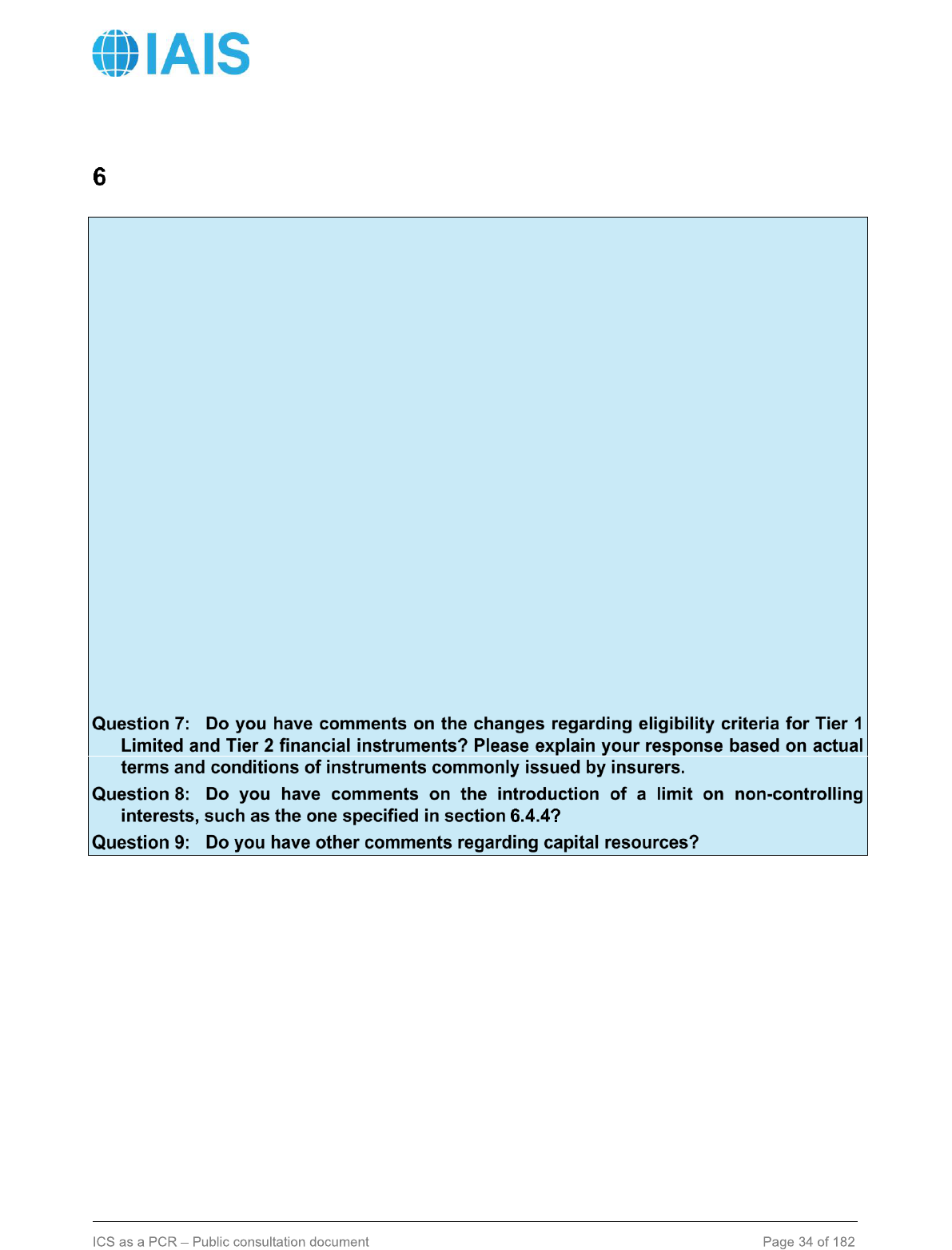
Public
Capital Resources
Changes compared to ICS Version 2.0:
Over the first years of the Monitoring Period, it appeared that the requirement of prior replacement
of instruments called within the first five years of issuance may conflict with current market and / or
regulatory practices, resulting in the exclusion from ICS capital resources of instruments otherwise
considered prudentially sound. In order to remedy those possibly unintended exclusions from ICS
capital resources, criteria L2-112.e. and L2-114.e. have been amended and now provide more
exemptions to the obligation of replacement. The changes to criterion L2-114.e. apply to both
structurally subordinated instruments and other than structurally subordinated instruments.
The requirement for calls to be economic in nature (in criterion L2-112.e. for Tier 1 Limited financial
instruments) has been made subject to a transitional arrangement, in the form of a legacy exemption
of instruments issued prior to the adoption of the ICS that fulfil all other Tier 1 Limited criteria.
Similarly, the requirement of prior replacement of instruments called within the first 5 years for Tier
2 Paid-Up instruments (criterion L2-114.e.) has been made subject to a legacy exemption for
instruments issued prior to the adoption of the ICS that feature a make-whole clause and fulfil all
other Tier 2 Paid-Up criteria.
In the context of its work on the availability of capital within a group, the IAIS also developed a limit
on non-controlling interests, identified as the main source of lack of availability for capital resources.
That limit, applicable at a legal entity level, has been designed based on the principle that non-
controlling interests generated by a legal entity contribute to the solvency of the IAIG only up to the
contribution of that legal entity to the capital requirement of the whole IAIG. The details of that limit
are specified in section 6.4.4.
6.1 General considerations
L1-48. Qualifying capital resources are determined on a consolidated basis for all financial
activities and comprise qualifying financial instruments and capital elements other than financial
instruments.
L1-49. Qualifying capital resources are subject to adjustments, exclusions and deductions, as
defined in section 6.4. Any item deducted from capital resources is excluded from the calculation of
the ICS capital requirement.
L1-50. The ICS identifies two tiers of capital:
• Tier 1 capital resources comprise financial instruments and capital elements, other than
financial instruments, that absorb losses on a going-concern basis and in winding-up; and

Public
• Tier 2 capital resources comprise financial instruments and capital elements, other than
financial instruments, that absorb losses only in winding-up.
L1-51. In determining qualifying capital resources, the ICS differentiates between mutual and non-
mutual IAIGs.
6.2 Classification of financial instruments
L1-52. Financial instruments are classified into those two tiers based on consideration of a number
of criteria, focused on five key principles:
• loss absorbing capacity (on a going-concern basis and/or in winding-up);
• subordination;
• availability to absorb losses;
• permanence; and
• absence of both encumbrances and mandatory servicing costs.
L1-53. Within each tier, financial instruments are allocated into two categories with differing
qualifying criteria:
• Tier 1:
o Tier 1 financial instruments for which there is no limit (Tier 1 Unlimited); and
o Tier 1 financial instruments for which there is a limit (Tier 1 Limited).
• Tier 2:
o Tier 2 Paid-Up financial instruments (Tier 2 Paid-Up); and
o Tier 2 Non-Paid-Up financial instruments (Tier 2 Non-Paid-Up).
L1-54. Table 4 presents the features of Tier 1 Unlimited, Tier 1 Limited and Tier 2 Paid-Up capital
with respect to the classification of financial instruments against the five key principles:
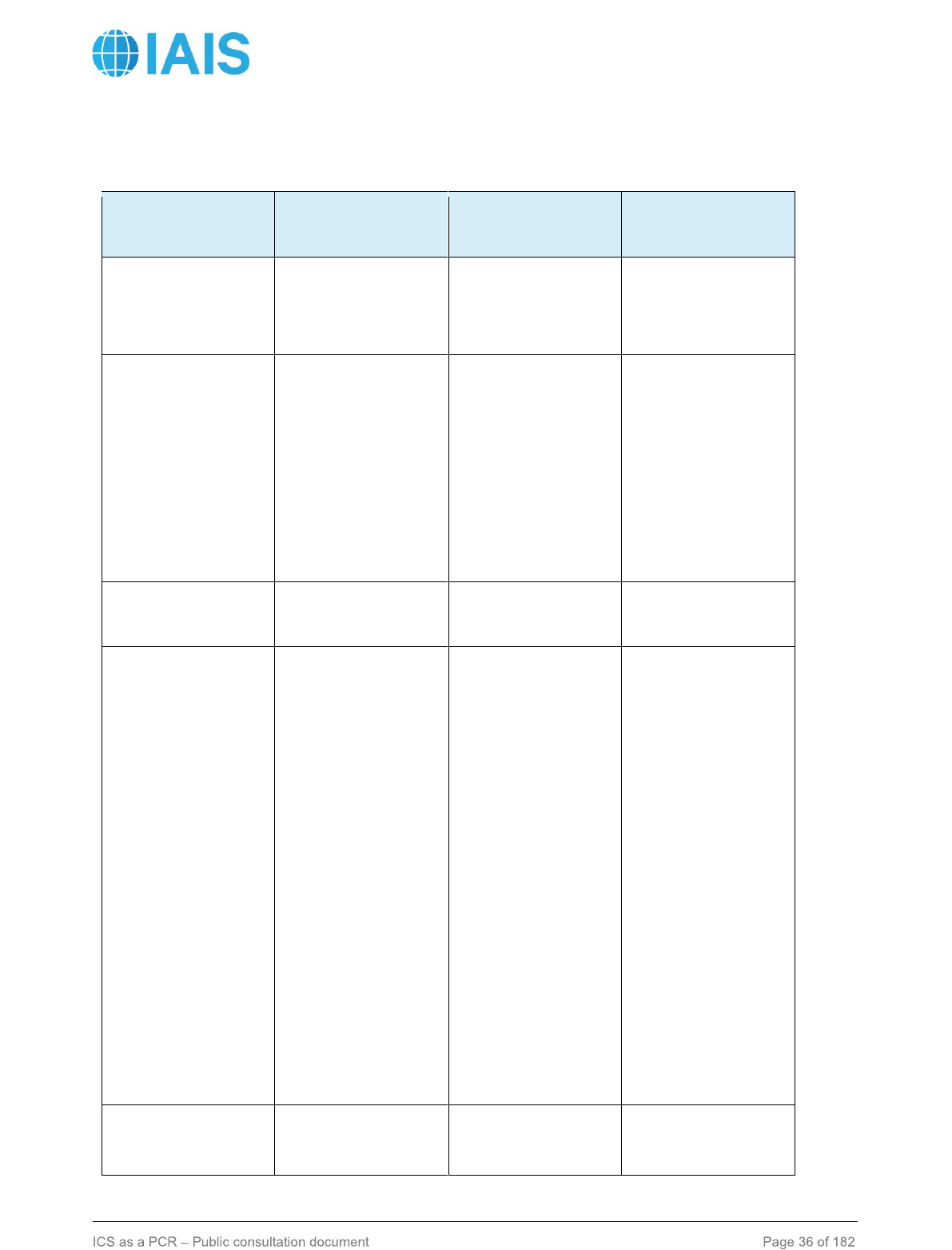
Public
Table 4: Key Principles for tiering in capital resources
Key Principles
Tier 1 Unlimited
Tier 1 Limited
Tier 2
Paid-Up
Loss absorbing
capacity
Absorbs losses on
both a going-concern
basis and in winding-
up.
Absorbs losses on
both a going-concern
basis and in winding-
up.
Absorbs losses in
winding-up.
Level of
subordination
Most subordinated (ie
is the first to absorb
losses); subordinated
to policyholders, other
non-subordinated
creditors, holders of
Tier 2 capital
instruments, and
holders of Tier 1
Limited capital
instruments.
Subordinated to
policyholders, other
non-subordinated
creditors and holders
of Tier 2 capital
instruments.
Subordinated to
policyholders and
other non-
subordinated
creditors.
Availability to
absorb losses
Fully paid-up
Fully paid-up
Fully paid-up
Permanence
Perpetual
Perpetual
For mutuals, this
requirement is
considered to be met
if redemption at
maturity (for a dated
instrument) can be
deferred, subject to
supervisory approval
or a lock-in feature,
subject to a
sufficiently long initial
maturity.
No incentives to
redeem permitted.
Issuer may redeem
after a minimum
specified period after
issuance or
repurchase at any
time, subject to prior
supervisory approval.
Sufficiently long initial
maturity– may have
incentives to redeem
but first occurrence
deemed to be
“effective maturity
date”.
Absence of both
encumbrances
IAIG has full
discretion to cancel
distributions (ie
IAIG has full
discretion to cancel
distributions (ie
The instrument is
neither undermined
nor rendered
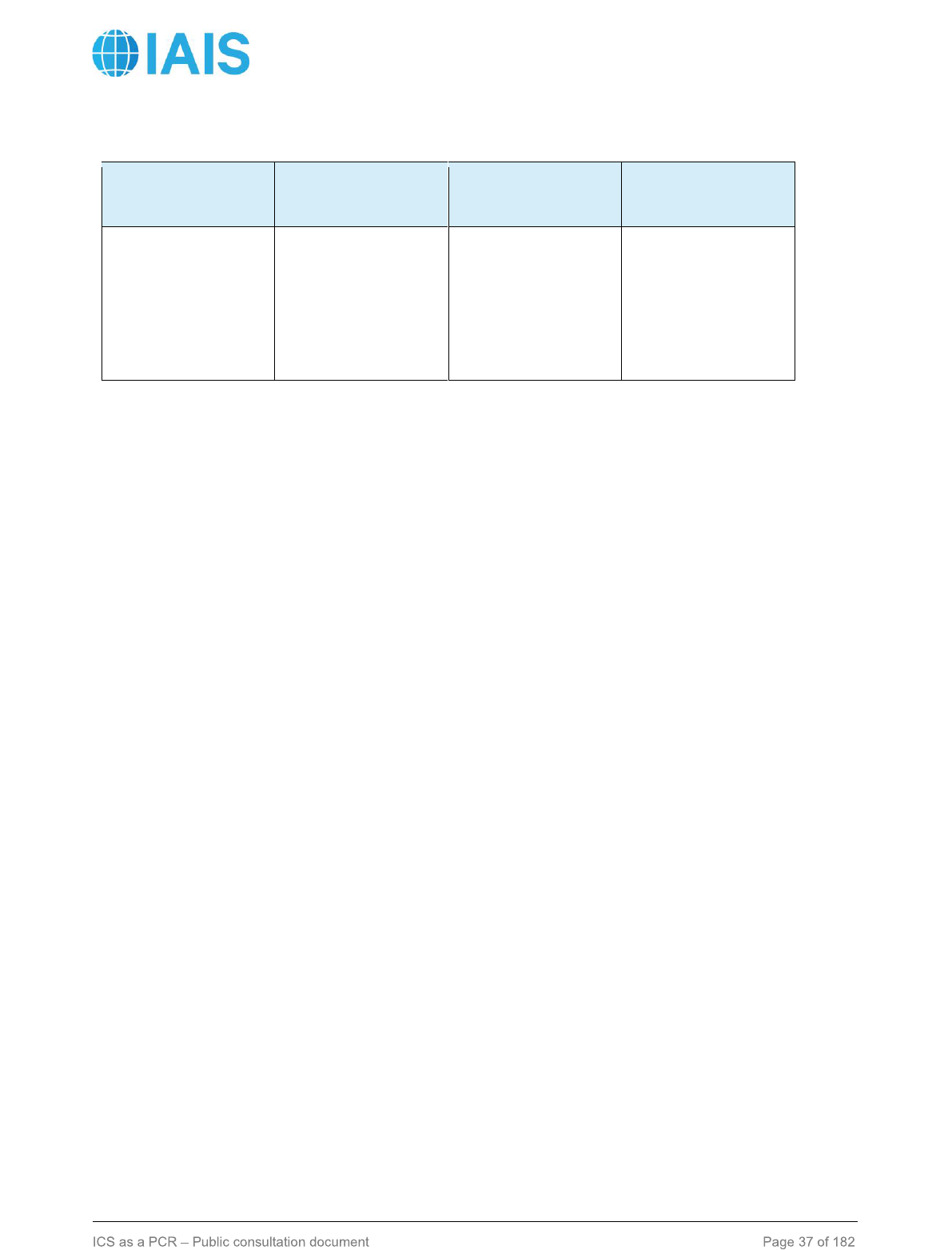
Public
Key Principles
Tier 1 Unlimited
Tier 1 Limited
Tier 2
Paid-Up
and mandatory
servicing costs
distributions are non-
cumulative);
the instrument is
neither undermined
nor rendered
ineffective by
encumbrances.
distributions are non-
cumulative);
the instrument is
neither undermined
nor rendered
ineffective by
encumbrances.
ineffective by
encumbrances.
L1-56. With regard to Tier 2 Paid-Up capital, the form of subordination can be either contractual or
structural. Structurally subordinated instruments are subject to certain conditions that capture the
specificities of structural subordination.
L1-57. The recognition of Tier 2 Non-Paid Up capital is restricted to mutual IAIGs. It is also required
that once these items become paid-up, the resulting capital element will possess the features
required of Tier 1 or Tier 2 Paid-Up capital resources.
L1-58. The list of criteria and conditions associated with each tier of capital is specified in the Level
2 text.
6.2.1 Tier 1 Unlimited financial instruments
L2-111. Financial instruments that meet all of the following criteria qualify as Tier 1 Unlimited capital
resources:
a. The instrument is fully paid-up.
b. The instrument is in the form of issued capital such that it is the first instrument to absorb
losses as they occur.
c. The instrument represents the most subordinated claim in a winding-up of the IAIG where
the holder has a claim on the residual assets proportional to its share of the issued share
capital after all other claims have been repaid, and which is not subject to a fixed or capped
amount.
d. The instrument is perpetual (ie it does not have a maturity date).
e. The principal amount of the instrument is not repaid outside winding-up, other than by means
of discretionary repurchase permitted under national law.
f. There is not an expectation created by the IAIG at issuance, through the terms of the
instrument or otherwise, that the IAIG will repurchase or cancel the instrument.
g. There are no circumstances under which a distribution is obligatory (non-payment of a
distribution is, therefore, not an event of default).
h. Distributions are paid out of distributable items, including retained earnings.
i. The instrument is neither undermined nor rendered ineffective by encumbrances. In
particular, the priority of claims is not compromised by guarantees or security arrangements
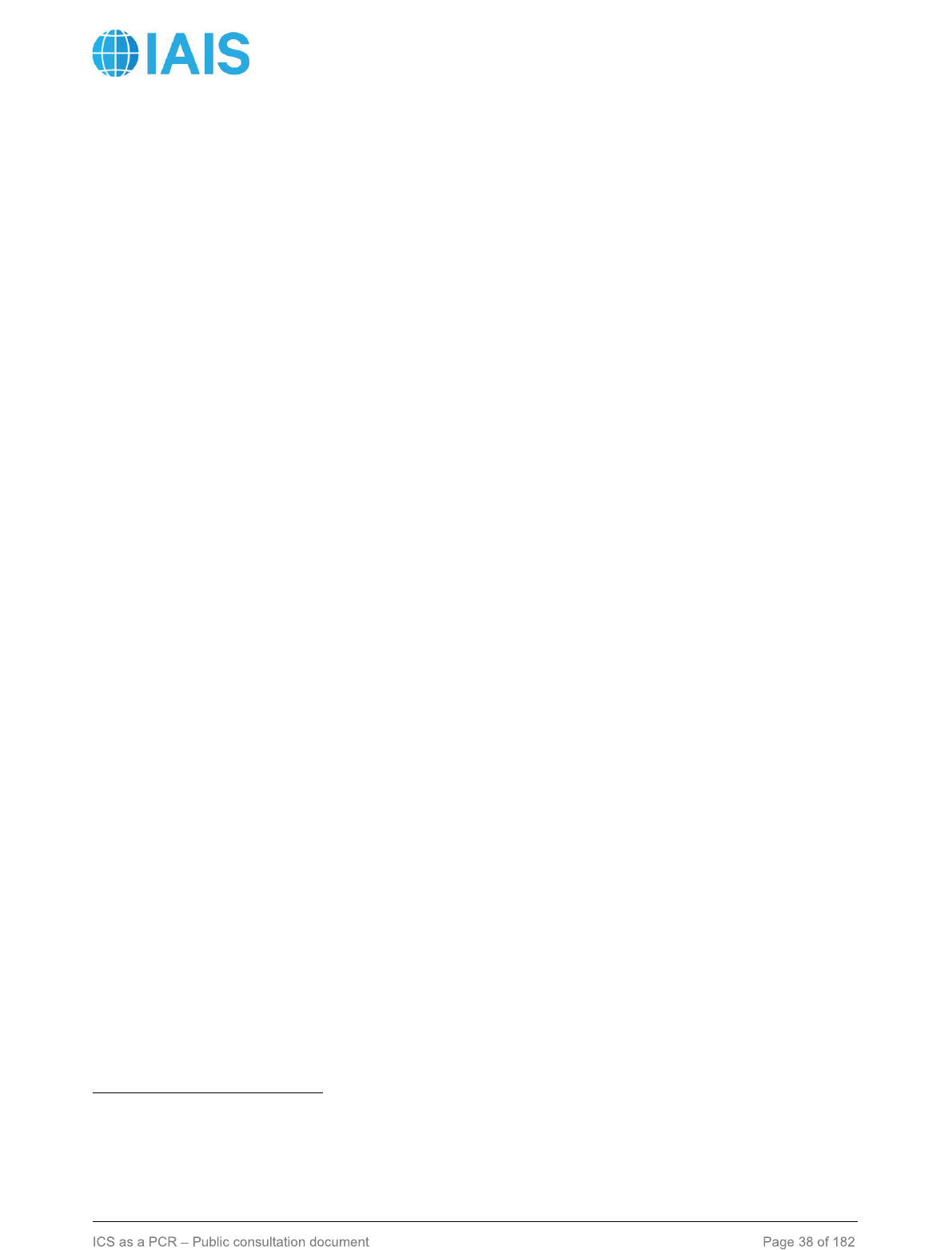
Public
given by either the IAIG or a related entity over which the IAIG exercises control or significant
influence, for the benefit of investors.
j. Neither the IAIG nor a related entity over which the IAIG exercises control or significant
influence has purchased the instrument, nor has the IAIG directly or indirectly funded the
purchase of the instrument.
k. The paid-in amount is recognised as equity capital (ie is not recognised as a liability) where
a determination that liabilities exceed assets constitutes a test of insolvency.
6.2.2 Tier 1 limited financial instruments
L2-112. Financial instruments that do not qualify as Tier 1 Unlimited capital resources, but meet all
of the following criteria, qualify as Tier 1 Limited capital resources:
a. The instrument is fully paid-up.
b. The instrument is subordinated to policyholders and other non-subordinated creditors and
holders of Tier 2 financial instruments but may rank senior to holders of Tier 1 unlimited
financial instruments.
c. The instrument is perpetual (ie it does not have a maturity date). For mutual IAIGs
14
, the
requirement for an instrument to be perpetual is considered to be met if redemption at
maturity (for a dated instrument) can be deferred subject to supervisory approval or a lock-
in
15
feature, and where an instrument has an initial maturity of at least ten years.
d. The instrument does not contain any incentive to redeem, such as a step-up.
e. The instrument is only callable at the option of the issuer after a minimum of five years from
the date of issue and prior supervisory approval is required for any redemption. By way of
derogation, call options, the exercise of which may take place in the first five years, may be
permitted only in the following two situations:
• Tax and regulatory event call options, the exercise of which is subject to prior supervisory
approval, and provided the IAIG was not in a position to anticipate such exercise at the time
of issuance. Before granting approval, the supervisor ensures that after redemption of the
instrument, the IAIG will cover its ICS capital requirement with a margin sufficient to ensure
that the ICS will not be breached over the foreseeable future, taking into account any relevant
trend and specificities of the IAIG.
• Other call options, provided that their exercise complies with all of the following:
o Prior to or concurrent with the exercise of the call, the IAIG replaces the called
instrument with capital of the same or better quality, and the replacement of the called
instrument is made on terms that are sustainable for the income capacity of the IAIG;
o The IAIG demonstrates to the satisfaction of the supervisor that the call is economic;
and
14
Characteristics of a mutual group typically include the inability to issue substantial amounts of common equity and an ultimate
parent within the group that cannot issue common equity.
15
A lock-in feature is a requirement for the IAIG to suspend repayment or redemption if it is in breach of its applicable regulatory
capital requirement or would breach it if the instrument is repaid or redeemed.

Public
o The call is approved by the supervisor.
When assessing whether the call is economic, the supervisor ensures that the cost of issuing
the replacement instrument is lower than the cost of keeping the existing instrument
outstanding. This analysis may consider various scenarios including, but not necessarily
limited to, comparative spread levels and issuance volume.
f. The instrument may be repurchased by the issuer at any time with prior supervisory approval.
g. There is not an expectation created by the IAIG, through the terms of the instrument or
otherwise, that the IAIG will repurchase the instrument or exercise any right to call the
instrument, or that the repurchase or redemption will receive supervisory approval.
h. The IAIG has full discretion at all times to forego or cancel distributions (ie dividends and
coupon payments are non-cumulative). The IAIG’s obligation to pay missed distributions is
forever extinguished and non-payment is not an event of default.
i. Distributions are paid out of distributable items, including retained earnings.
j. The instrument does not have distributions that are linked to the credit standing or financial
condition of the IAIG or a related entity, such that those distributions may accelerate winding-
up.
k. The instrument is neither undermined nor rendered ineffective by encumbrances. In
particular, the priority of claims is not compromised by guarantees or security arrangements
given by either the IAIG or a related entity over which the IAIG exercises control or significant
influence, for the benefit of investors.
l. Neither the IAIG nor a related entity over which the IAIG exercises control or significant
influence has purchased the instrument, nor has the IAIG directly or indirectly funded the
purchase of the instrument.
m. The paid-in amount is recognised as equity capital (ie is not recognised as a liability) where
a determination that liabilities exceed assets constitutes a test of insolvency.
n. The instrument does not possess features that hinder recapitalisation, such as provisions
that require the issuer to compensate investors if a new instrument is issued at a lower price
during a specified time frame.
o. If the instrument is not issued out of an operating entity or the holding company of the IAIG
(eg it is issued out of an SPV), proceeds are made immediately available, without limitation,
to an operating entity or the holding company of the IAIG, through the issuance of an
instrument that meets or exceeds all of the other criteria for inclusion in Tier 1 limited capital
resources (ie the SPV may only hold assets that are intercompany instruments issued by the
IAIG or a related entity with terms and conditions that meet or exceed the criteria for Tier 1
limited capital resources).
L2-113. Instruments issued before the date of adoption of the ICS may be considered compliant
with T1 Limited criterion e., even when the relevant supervisor has not committed to check the
economic nature of a call before granting approval of that call within the first 5 years. This legacy
exemption is applicable until the instrument is redeemed.
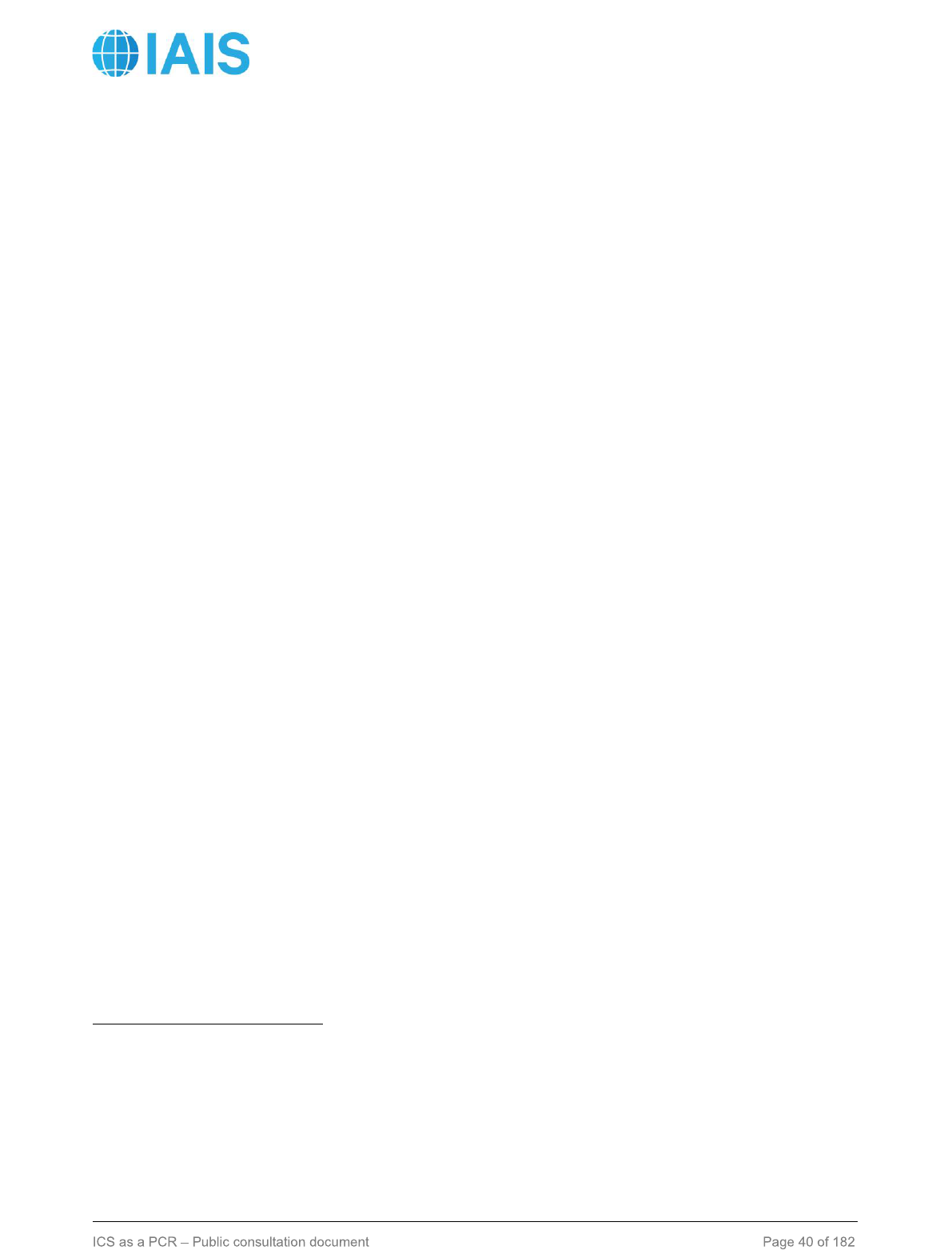
Public
6.2.3 Tier 2 financial instruments (other than structurally subordinated)
L2-114. Financial instruments that do not qualify as Tier 1 (Unlimited or Limited) capital resources,
but meet all of the following criteria qualify as Tier 2 capital resources:
a. The instrument is fully paid-up.
b. The instrument is subordinated to policyholders and other non-subordinated creditors of the
IAIG.
c. The instrument has an initial maturity of at least five years with its effective maturity date
defined to be the earlier of:
i. The first call date, together with a step-up or other incentive to redeem the instrument;
and
ii. The contractual maturity date fixed in the instrument’s terms and conditions.
d. The instrument’s availability to absorb losses as it nears its effective maturity is captured by
either:
i. Decreasing the qualifying amount of the instrument from 100% to 0% on a straight-
line basis in the final five years prior to maturity; or
ii. The existence of a lock-in clause.
e. If the instrument is callable within the first five years from the date of issue:
• Any such call is at the option of the issuer only;
• Any such call is subject to supervisory approval; and
• The called instrument must be replaced in full before or at redemption by a new
issuance of the same or higher quality instrument.
The obligation of replacement mentioned in the third bullet point above may be waived when
the call is tied to a materially adverse tax or regulatory event that could not reasonably be
anticipated at the time of issuance; or
Before granting approval, the supervisor ensures that after redemption of the instrument, the
IAIG will cover its ICS capital requirement with a margin sufficient to ensure that the ICS will
not be breached over the foreseeable future, taking into account any relevant trend and
specificities of the IAIG.
Other than in cases of replacement outlined above, the instrument is only callable at the
option of the issuer after a minimum of five years from the date of issue and prior supervisory
approval is required for any redemption prior to contractual maturity.
16
16
In the absence of a requirement for prior supervisory approval, this criterion is considered to be met if the following
conditions are met:
• The terms of the financial instrument include a lock-in feature that prevents redemption when a firm does not comply
with its regulatory capital requirement (or where redemption would lead to non-compliance);
• Either:
- the supervisor receives prior notification upon redemption, or
- call dates are fixed and known and the supervisor monitors potential redemption; and
• The supervisor has the power to prevent redemption of the instrument.

Public
f. The instrument may be repurchased by the issuer at any time with prior supervisory approval.
g. There is not an expectation created by the IAIG, through the terms of the instrument or
otherwise, that the IAIG will repurchase the instrument or exercise its right to call the
instrument, or that the repurchase or redemption will receive supervisory approval.
h. The instrument does not have distributions that are linked to the credit standing or financial
condition of the IAIG or a related entity, such that those distributions may accelerate winding-
up.
i. The instrument does not give holders rights to accelerate the repayment of scheduled
principal or coupon payments, except in winding-up.
j. The instrument is neither undermined nor rendered ineffective by encumbrances. In
particular, the priority of claims is not compromised by guarantees or security arrangements
given by either the IAIG or a related entity over which the IAIG exercises control or significant
influence, for the benefit of investors.
k. Neither the IAIG nor a related entity over which the IAIG exercises control or significant
influence has purchased the instrument, nor has the IAIG directly or indirectly funded the
purchase of the instrument.
l. If the instrument is not issued out of an operating entity or the holding company of the IAIG
(eg it is issued out of an SPV), proceeds are made immediately available, without limitation,
to an operating entity or the holding company of the IAIG, through the issuance of an
instrument that meets or exceeds all of the other criteria for inclusion in paid-up Tier 2 capital
resources (ie the SPV may only hold assets that are intercompany instruments issued by the
IAIG or a related entity with terms and conditions that meet or exceed the criteria for Tier 2
Paid-Up capital resources).
L2-115. Instruments issued before the date of adoption of the ICS, which can be called only at a
make-whole price, may be considered compliant with Tier 2 Paid-Up criterion e., even in the absence
of a commitment or requirement to replace the instrument before or concurrent to a call within the
first five years of issuance. This legacy exemption is applicable until the instrument is redeemed.
6.2.4 Structurally subordinated Tier 2 financial instruments
L2-116. Structural subordination of debt refers to a situation where a holding company issues a
financial instrument directly to third party investors and then down-streams the proceeds into
insurance subsidiaries.
L2-117. Structurally subordinated financial instruments that meet the criteria for Tier 2 financial
instruments, subject to the clarifications of criteria b), e), and f), and new criteria n), o), and p) below,
qualify as Tier 2 capital resources:
b. Subordination to other non-subordinated creditors of the IAIG is not relevant to structurally
subordinated instruments that are issued by an IAIG’s holding company to senior creditors.
e. The requirement for supervisory approval of such a call within the first five years from the
date of issue can be fulfilled through the exercise of supervisory controls and supervisory
review, including the ability (direct/indirect) for supervisors to limit, defer and/or disallow the
issuance or redemption of financial instruments.
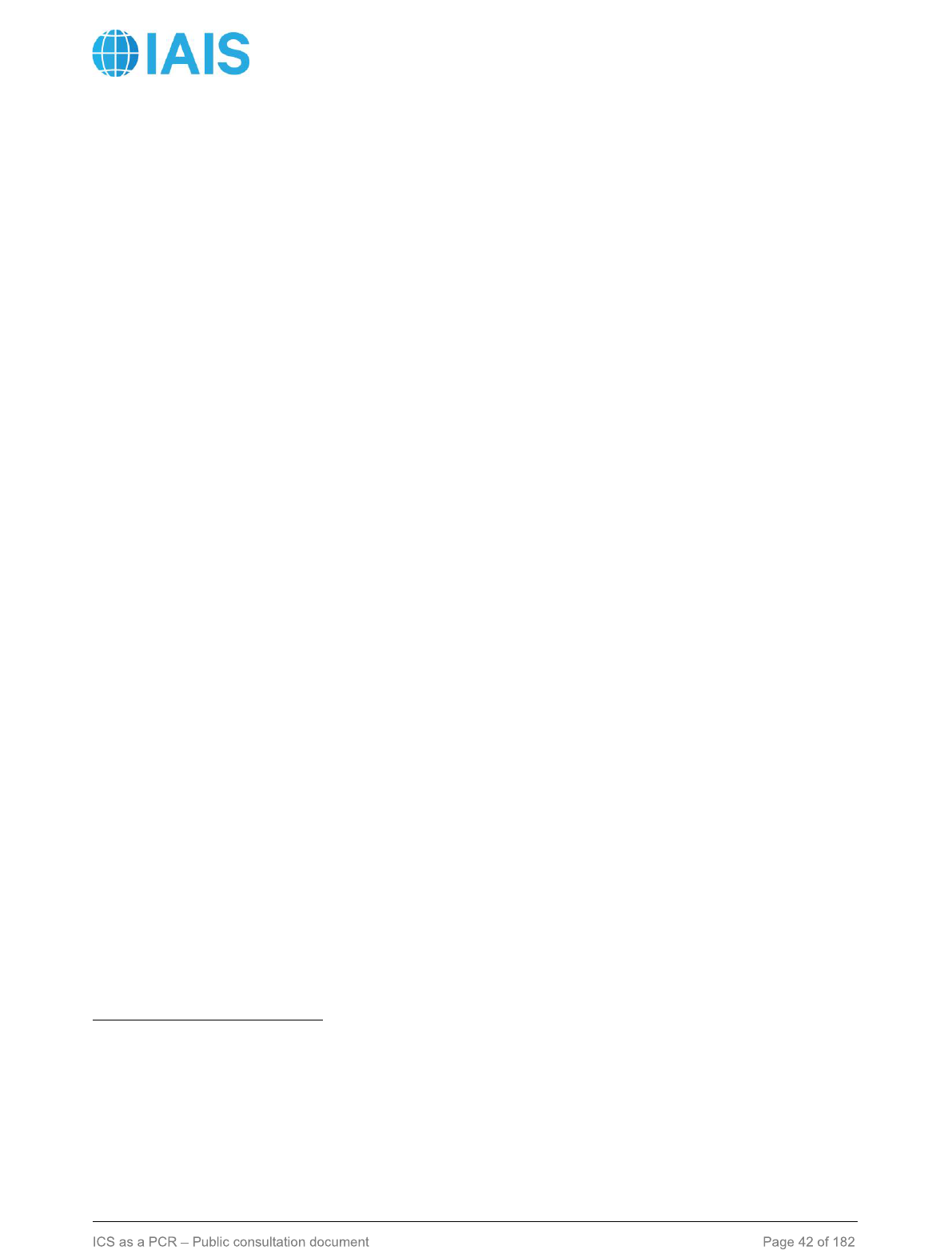
Public
The requirement for supervisory approval of redemptions after a minimum of five years can
be fulfilled through supervisory approval
17
of dividends prior to their payment from an
insurance subsidiary to the holding company.
f. The requirement for supervisory approval of repurchases can be fulfilled through supervisory
approval
17
of dividends prior to their payment from an insurance subsidiary to the holding
company.
n. The debt instrument has been issued by a clean holding company, which is defined as a
holding company that does not have policyholder liabilities on its stand-alone balance sheet.
o. The IAIG and its GWS have determined that the proceeds of the instruments, which have
been down-streamed into insurance subsidiaries, are being tracked and reported
appropriately.
p. Amounts from the instrument issuance have been down-streamed into an insurance
subsidiary of the holding company and the insurance subsidiary is located in a jurisdiction
whose regulatory regime proactively enforces structural subordination through appropriate
regulatory/supervisory controls over distributions from insurance subsidiaries
18
.
6.2.4.1 National discretion on acceleration clauses
L2-118. Criterion i. in paragraph L2-114 is subject to a national discretion. When a GWS elects to
apply that national discretion, criterion i. is waived for all IAIGs headquartered in the jurisdiction of
that GWS.
L2-119. IAIGs to which the national discretion applies provide a reconciliation of the impact between
the reference ICS with and without applying the national discretion.
6.2.5 Tier 2 Non-paid-up capital
L2-120. Non-paid-up capital consists of commitments, received by entities of the IAIG from third
parties non-related to the IAIG, to provide capital upon request.
L2-121. Financial items, contracts and arrangements established by mutual IAIGs qualify as Tier 2
Non-paid-up capital resources when they meet all of the following criteria:
a. The item has been approved by the supervisor as satisfying criteria b) to g) below as to its
characteristics and amount.
b. The item can be called up on demand by the mutual IAIG and is not subject to any
contingencies or conditions that prevent or act as a disincentive to the call being made or
satisfied.
17
For structurally subordinated financial instruments, supervisory approval of ordinary dividends can be met if the supervisor has
in place supervisory controls over distributions, including the ability for the supervisor to limit, defer and/or disallow the payment
of any distributions should it find that the insurer is presently, or may potentially become, financially distressed.
18
Supervisory controls over distributions from insurance subsidiaries refer to the supervisory review and/or prior supervisory
approval of all distributions, including the ability for the supervisor to limit, defer and/or disallow the payment of any distributions
should it find that the insurer is presently, or may potentially become, financially distressed. As part of its review and/or prior
approval of distributions, the relevant supervisor considers surplus adequacy, financial flexibility, the quality of earnings, and other
factors deemed to be pertinent as they relate to the financial strength of the insurer and policyholder protection.

Public
c. When called up, the item becomes either a financial instrument that meets in full the criteria
for inclusion in Tier 1 or Tier 2 paid-up capital resources or a capital element listed in section
6.3.
d. The item is legally enforceable in each relevant jurisdiction.
e. The counterparty to the contract to provide capital is able and willing to pay the agreed
amounts when called upon by the mutual IAIG.
f. The item is neither undermined nor rendered ineffective by encumbrances.
g. The mutual IAIG is required to notify the supervisor of any changes of fact or circumstance
that could affect the supervisor’s approval of the item.
6.3 Capital elements other than financial instruments
6.3.1 Tier 1 capital elements
L1-59. Subject to any exclusion, adjustment or deduction as specified in section 6.4.1, Tier 1 capital
elements, other than financial instruments, include the following items:
a) Retained earnings;
b) Share premium, resulting from the issuance of instruments included in Tier 1, and other forms
of contributed surplus earned from sources other than profits;
c) Accumulated Other Comprehensive Income (AOCI);
d) The fair market value of equity-settled employee stock options, provided that a corresponding
expense is recorded in the profit and loss account of the IAIG, under applicable accounting
standards; and
e) Other allocated to equity, which includes:
i. Minority/Non-controlling interests (NCI); and
ii. Adjustments applied to the IAIG’s consolidated balance sheet (as per audited
financial statements) to produce the ICS balance sheet.
6.3.2 Tier 2 capital elements
L1-60. Subject to any exclusion, adjustment or deduction as specified in section 6.4.2, Tier 2 capital
elements, other than financial instruments, include the following:
a) Share premium resulting from the issuance of instruments included in Tier 2 Paid-Up capital
resources;
b) The value of encumbered assets in excess of the on-balance sheet liabilities secured by the
encumbered assets and incremental ICS capital requirement, in respect of those assets and
liabilities excluded from Tier 1 (see section 6.4.3 for details on the treatment of encumbered
assets); and
c) The Tier 2 basket, comprised of proportions of the following three items which relate to
deductions from Tier 1 (see section 6.4.1):
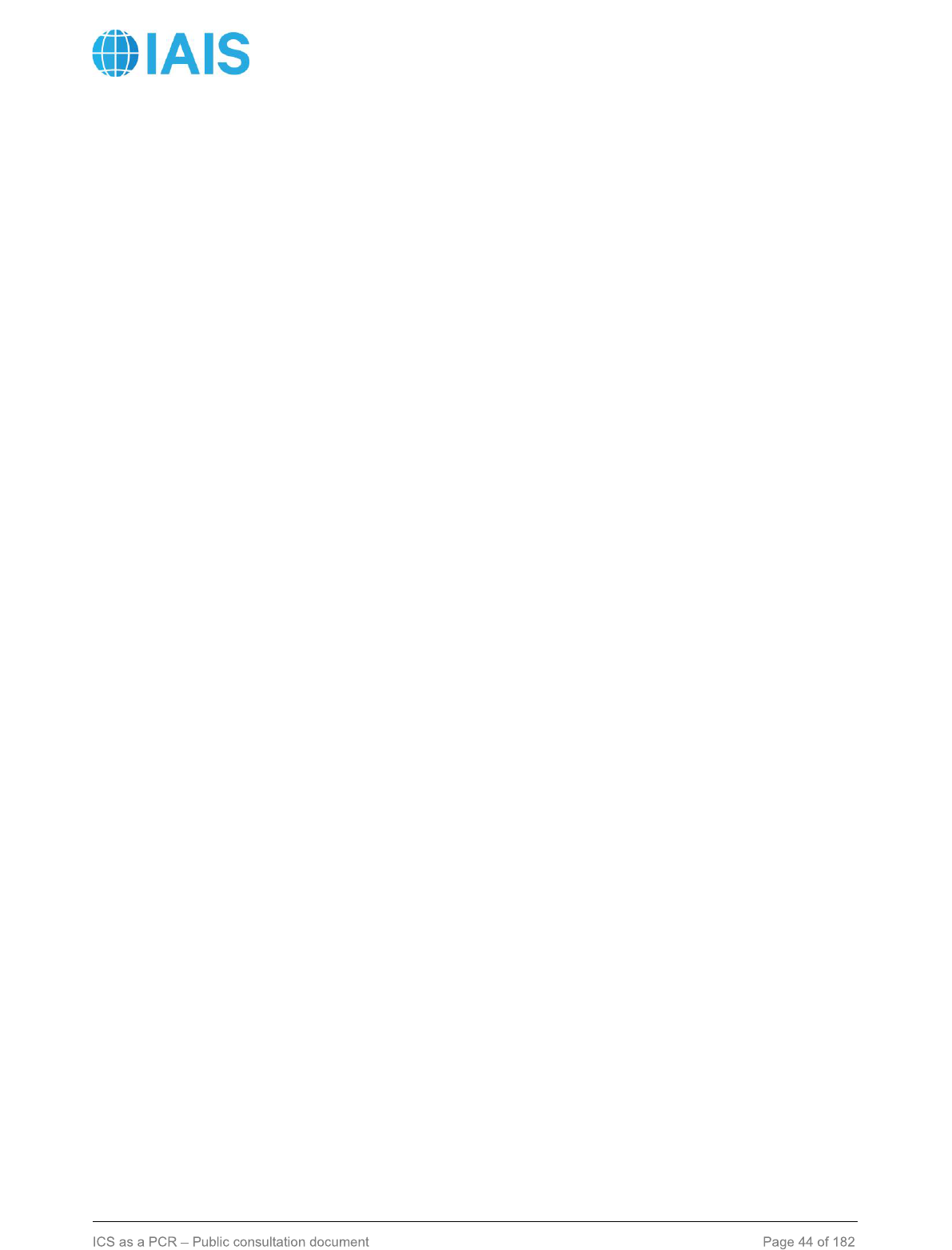
Public
i. the value of each net defined benefit pension fund that is an asset on the IAIG’s
balance sheet, net of any eligible Deferred Tax Liability (DTL);
ii. Deferred Tax Asset (DTA) deducted from Tier 1 capital resources; and
iii. the value of computer software intangibles (net of amortisation) deducted from Tier 1
capital resources, net of any eligible DTL.
L1-61. The Tier 2 basket is subject to a limit, expressed as a percentage of the ICS capital
requirement.
L1-62. The proportions of the three items included in the Tier 2 basket, as well as the overall limit
applicable to the basket, are specified in the Level 2 text.
L2-122. The Tier 2 basket comprises the following three items, subject to a limit of 15% of the ICS
capital requirement:
a. 50% of the value of each net defined benefit pension fund that is an asset on the IAIG’s
balance sheet, net of any eligible DTL;
b. 100% of the DTA deducted from Tier 1 capital resources; and
c. 10% of the value of computer software intangibles (net of amortisation) deducted from Tier 1
capital resources, net of any eligible DTL.
6.4 Capital adjustments and deductions
6.4.1 Deductions from Tier 1 capital resources
L1-63. To the extent that they have not already been excluded through valuation in the ICS balance
sheet, the following items are deducted from Tier 1 capital resources:
a) Goodwill;
b) Intangible assets, including computer software intangibles;
c) Each asset recognised on the IAIG’s balance sheet that relates to a defined benefit pension
fund;
d) DTAs on the ICS balance sheet;
e) Reciprocal cross holdings, arranged either directly or indirectly between financial institutions
and that artificially inflate the Tier 1 capital position of the IAIG;
f) Direct and indirect investments in own Tier 1 capital instruments, not otherwise eliminated;
g) Reinsurance assets arising from arrangements deemed to constitute non-qualifying
reinsurance;
h) Encumbered assets in excess of the on-balance sheet liabilities secured by the encumbered
assets and incremental ICS capital requirement in respect of those assets and liabilities (see
section 6.4.3 for details on the treatment of encumbered assets); and
i) The value of equity and debt owned by the IAIG in entities that are excluded from the scope
of the group.
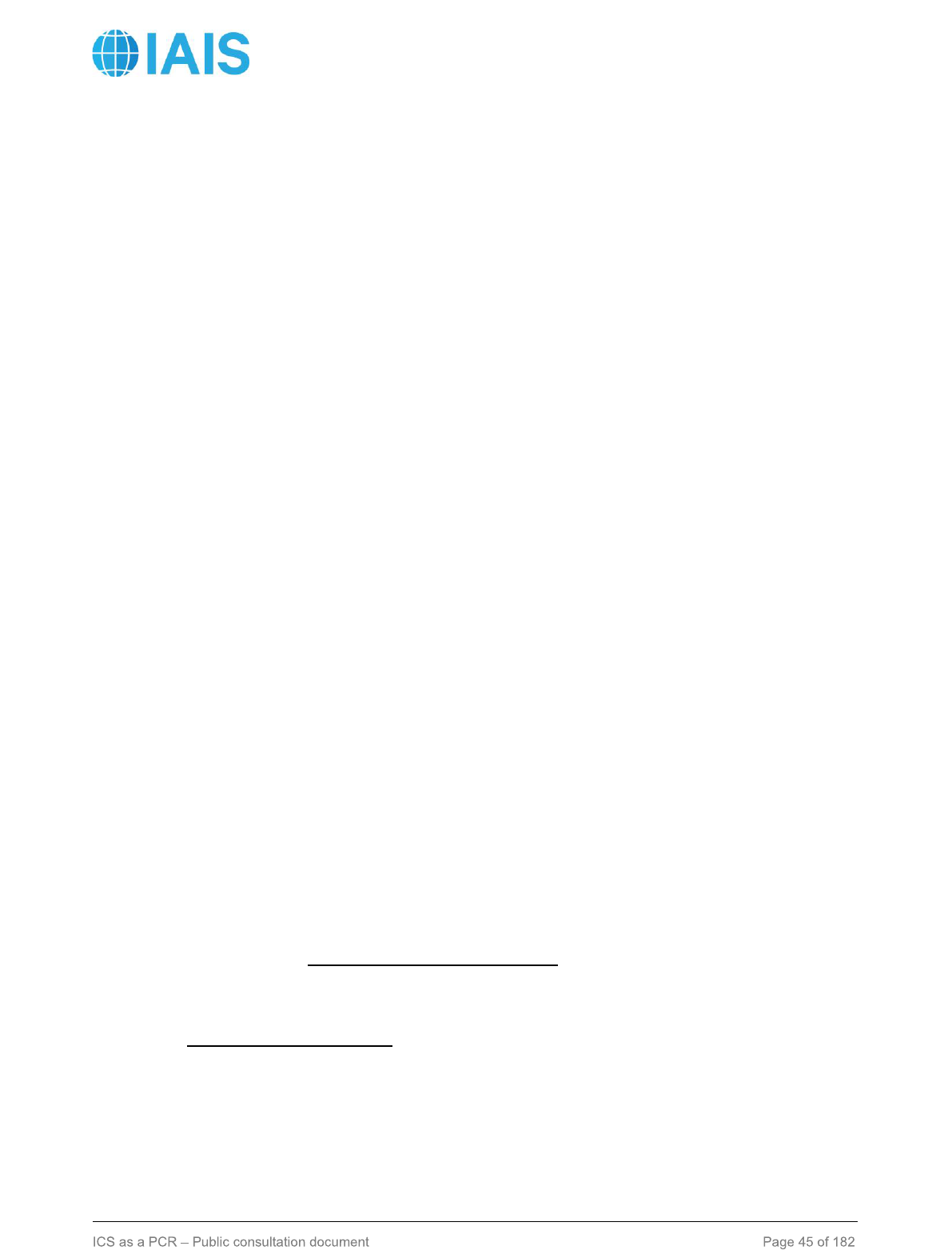
Public
L1-64. Items a) to c) are net of any associated DTL that would be extinguished if the item becomes
impaired or derecognised under the valuation approach.
6.4.2 Deductions from Tier 2 capital resources
L1-65. To the extent that they have not already been excluded through valuation in the ICS balance
sheet, the following items are deducted from Tier 2 capital resources:
a) Reciprocal cross holdings, arranged either directly or indirectly between financial
institutions and that artificially inflate the Tier 2 capital position of the IAIG; and
b) Direct and indirect investments in own Tier 2 capital instruments, not otherwise eliminated.
6.4.3 Treatment of encumbered assets
L1-66. When an IAIG holds encumbered assets in excess of the liabilities and associated risks for
which those assets have been encumbered, an adjustment to Tier 1 capital resources is made.
L1-67. The details of this adjustment are specified in the Level 2 text.
L2-123. The deduction from Tier 1 capital resources is calculated as the total value of encumbered
assets in excess of the sum of the value of the IAIG’s on-balance sheet liabilities secured by the
encumbered assets, plus the value of the IAIG’s incremental ICS capital requirement for encumbered
assets and secured liabilities.
L2-124. No Tier 1 deduction is required for encumbered assets relating to off-balance sheet
securities financing transactions (ie securities lending and borrowing, repos and reverse repos) that
do not result in a liability on the balance sheet.
L1-68. The amount of encumbered assets deducted from Tier 1 capital resources is included in
Tier 2 capital resources, subject to the limits applicable to Tier 2 (see section 6.5 on capital
composition limits).
6.4.4 Limit on non-controlling interests
L1-69. Non-controlling interests (NCI) are subject to a limit calculated at a legal entity level.
L1-70. The calculation of the NCI limit is specified in the Level 2 text.
L2-125. For each legal entity generating NCI at group level, a NCI limit is calculated as:
Limit = NCI proportion x estimated contribution to group ICS
where:
•
•
•
L2-126. The amount of NCI generated by that entity and exceeding the limit calculated above is
deducted from the amount of Tier 1 capital resources.
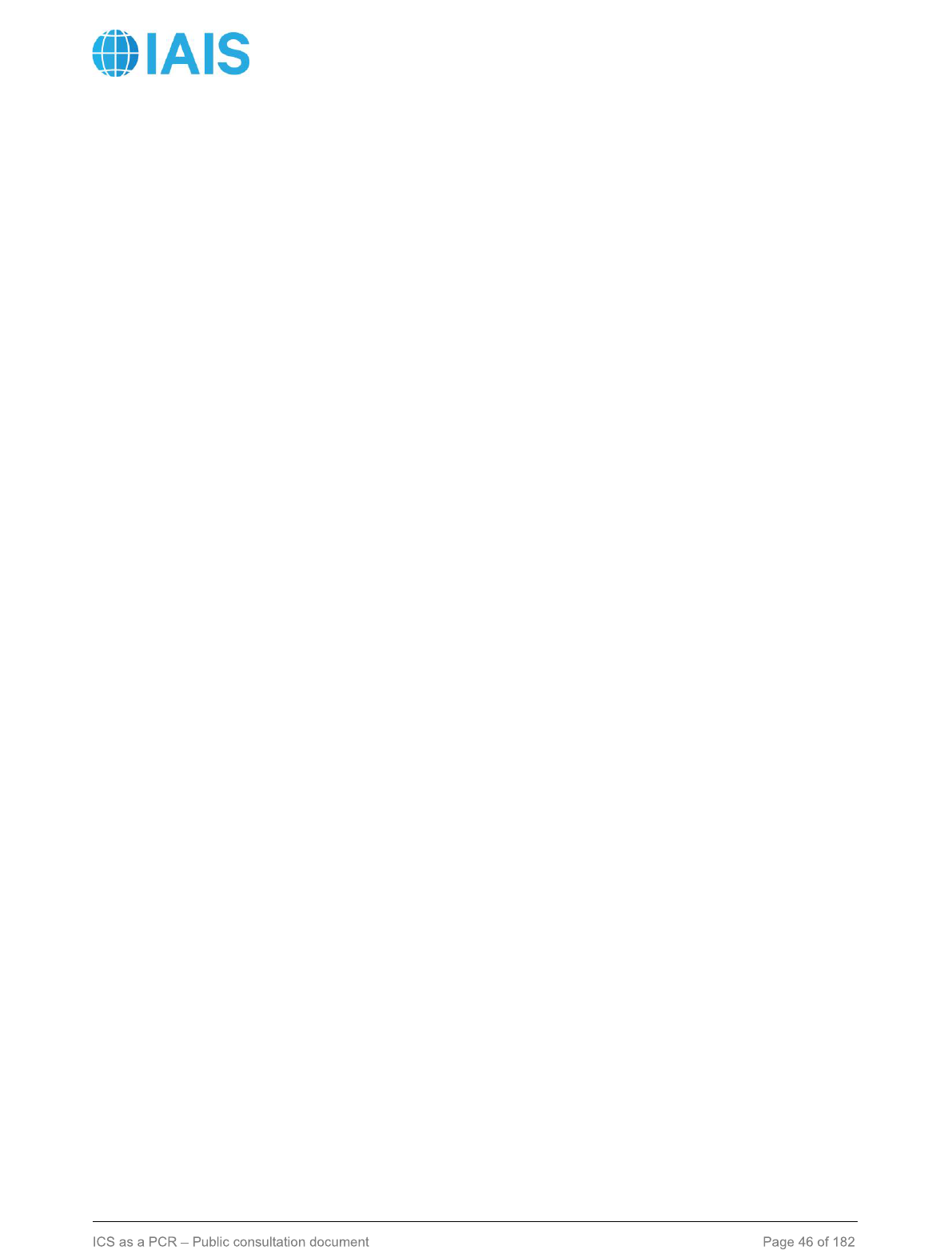
Public
6.5 Capital composition limits
L1-71. The Tier 1 Limited and Tier 2 capital resources after adjustments, exclusions and
deductions are subject to limits expressed as a percentage of the ICS capital requirement. Those
limits, which may differ depending on the IAIG being mutual or non-mutual, are specified in the Level
2 text.
L2-127. For a non-mutual IAIG, the following limits are applicable:
a. Tier 1 Limited capital resources are limited to 10% of the ICS capital requirement; this limit is
increased to 15%, provided that the instruments in excess of the 10% limit possess a
Principle Loss Absorbency Mechanism (PLAM);
b. Tier 2 capital resources are limited to 50% of the ICS capital requirement; and
c. There is no allowance for Tier 2 Non-Paid Up capital.
L2-128. For the purpose of paragraph L2-127, a PLAM is defined as a mechanism providing for
either a write-down of the liability (principal and dividend/coupon) or a conversion of the instrument
(into a Tier 1 unlimited financial instrument as defined in section 6.2.1) in contractually predefined
going-concern conditions.
L2-129. For a mutual IAIG, the following limits are applicable:
a. Tier 1 Limited capital resources are limited to 30% of the ICS capital requirement;
b. Tier 1 Limited + Tier 2 capital resources are limited to 60% of the ICS capital requirement;
and
c. Tier 2 Non-Paid Up capital are limited to 10% of the ICS capital requirement.
L1-72. The GWS, in consultation with the supervisory college, may apply temporary supervisory
forbearance on the limit on Tier 1 Limited capital resources for mutual IAIGs, provided that the IAIG
submits a plan to restore its capital position.
L1-73. Tier 1 Limited capital resources that are in excess of the associated limit are eligible for
inclusion within Tier 2 capital resources, and become subject to the limit applicable to Tier 2 capital
resources.
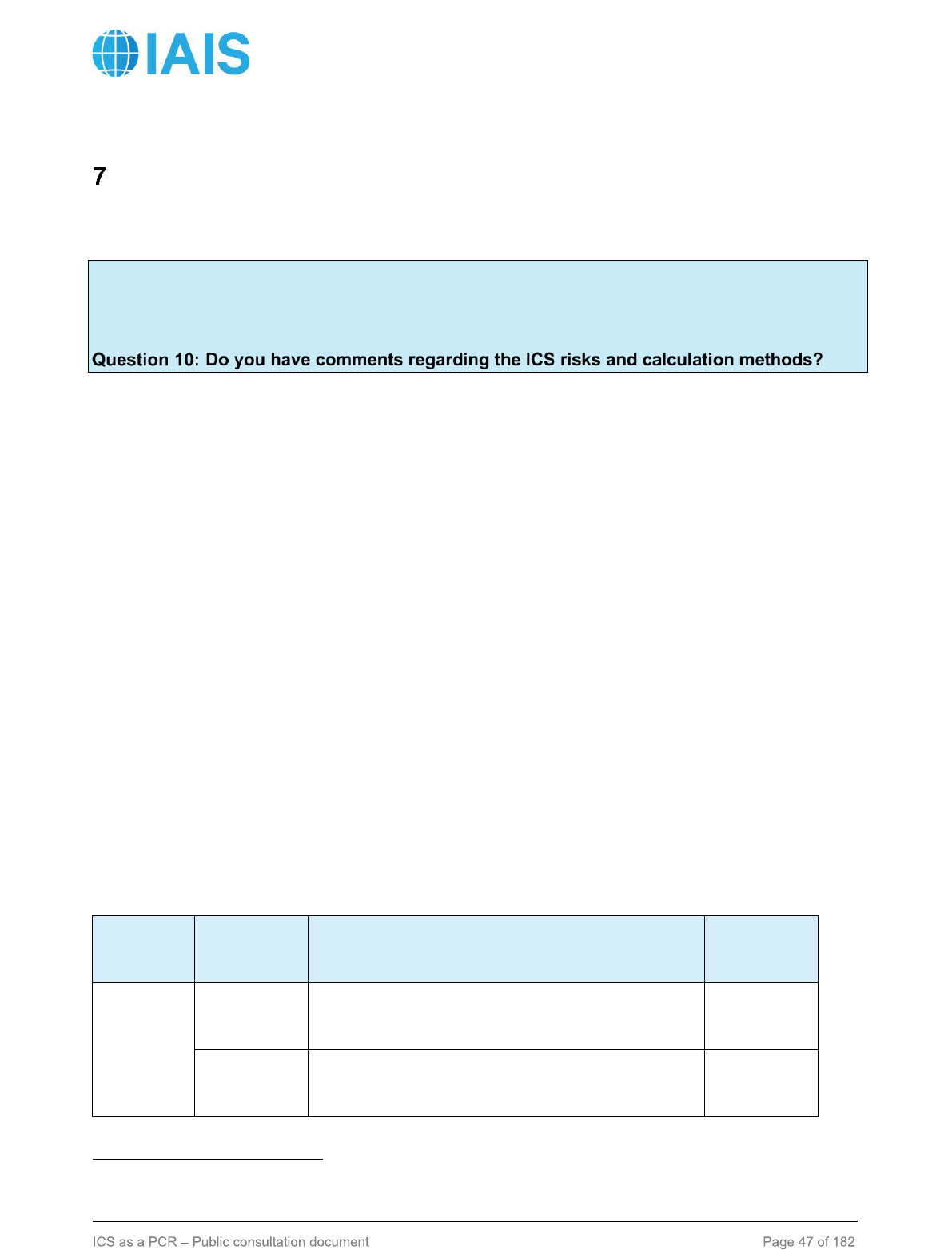
Public
Capital Requirement – The Standard Method
7.1 ICS Risks and Calculation Methods
Changes compared to ICS Version 2.0:
This section has not incurred any change compared to ICS Version 2.0 for the monitoring period.
L1-74. The categories of risk included in the standard method are: Insurance risk, Market risk,
Credit risk and Operational risk. Table 5 lists the risk categories, along with the individual risks in
each risk category.
L1-75. The ICS capital requirement is based on the potential adverse changes in qualifying capital
resources resulting from unexpected changes, events or other manifestations of the specified risks.
L1-76. Risks are measured using two approaches: a stress approach and a factor-based approach.
There is one exception, which is natural catastrophe risk, where a vendor model may be used.
L1-77. The stress approach follows a dynamic approach looking at the balance sheet at two points
in time: the IAIG’s current balance sheet pre-stress and the IAIG’s balance sheet post-stress. The
risk charge for each individual risk is determined as the decrease between the amount of capital
resources on the pre-stress balance sheet (CR0) and the amount of capital resources on the post-
stress balance sheet (CR1). Stresses can be applied individually with individual stressed balance
sheets being calculated (CR0 – CR1) to determine the risk charge with respect to each individual
stress. As a simplification, the change in net asset value is used as a proxy for the changes in
qualifying capital resources.
L1-78. The factor-based approach is determined by applying factors to specific exposure
measures.
L1-79. The scope of the risks covered by the ICS capital requirement, as well as the applicable
measurement method, are outlined in Table 5.
Table 5: Risks, definitions and measurement method
Categories
of risk
Risk
Scope/definition: Risk of adverse change in the value
of capital resources due to
Measurement
Method
Insurance
risk
Mortality risk
(life)
Unexpected changes
19
in the level, trend or volatility of
mortality rates.
Stress
Longevity risk
(life)
Unexpected changes
19
in the level, trend or volatility of
mortality rates.
Stress
19
Expected impacts are assumed to be incorporated in valuation methodologies
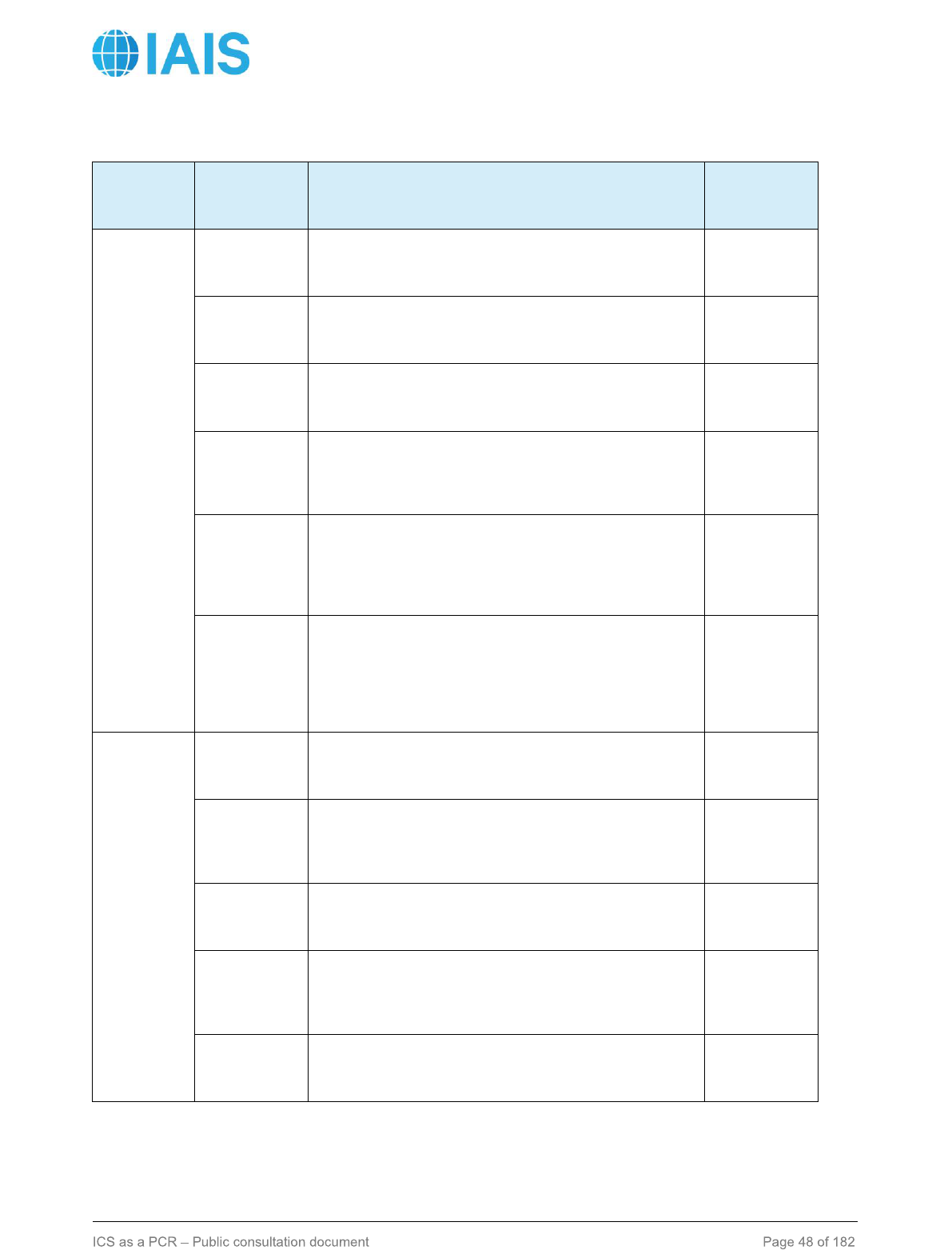
Public
Categories
of risk
Risk
Scope/definition: Risk of adverse change in the value
of capital resources due to
Measurement
Method
Morbidity/Disa
bility risk (life)
Unexpected changes
19
in the level, trend or volatility of
disability, sickness and morbidity rates.
Stress
Lapse risk
(life)
Unexpected changes
19
in the level or volatility of rates of
policy lapses, terminations, renewals and surrenders.
Stress
Expense risk
(life)
Unexpected changes
19
in liability cash flows due to the
incidence of expenses incurred.
Stress
Premium risk
(non-life)
Unexpected changes
19
in the timing, frequency and severity
of future insured events (to the extent not already captured
in Morbidity/Disability risk).
Factor
Claims reserve
risk (non-life)
Unexpected changes
19
in the expected future payments for
claims or events that have already occurred (whether
reported to the IAIG or not) and not yet fully settled (to the
extent not already captured in Morbidity/Disability risk).
Factor
Catastrophe
risk
Unexpected changes
19
in the occurrence of low frequency
and high severity events.
Stress, except
for natural
catastrophe,
which may use
a model.
Market risk
Interest Rate
risk
Unexpected changes
19
in the level or volatility of interest
rates.
Stress
Non-default
spread risk
Unexpected changes
19
in the level or volatility of spreads
over the risk-free interest rate term structure, excluding the
default component.
Stress
Equity risk
Unexpected changes
19
in the level or volatility of market
prices of equities.
Stress
Real Estate
risk
Unexpected changes
19
in the level or volatility of market
prices of real estate or from the amount and timing of cash
flows from investments in real estate.
Stress
Currency risk
Unexpected changes
19
in the level or volatility of currency
exchange rates.
Stress
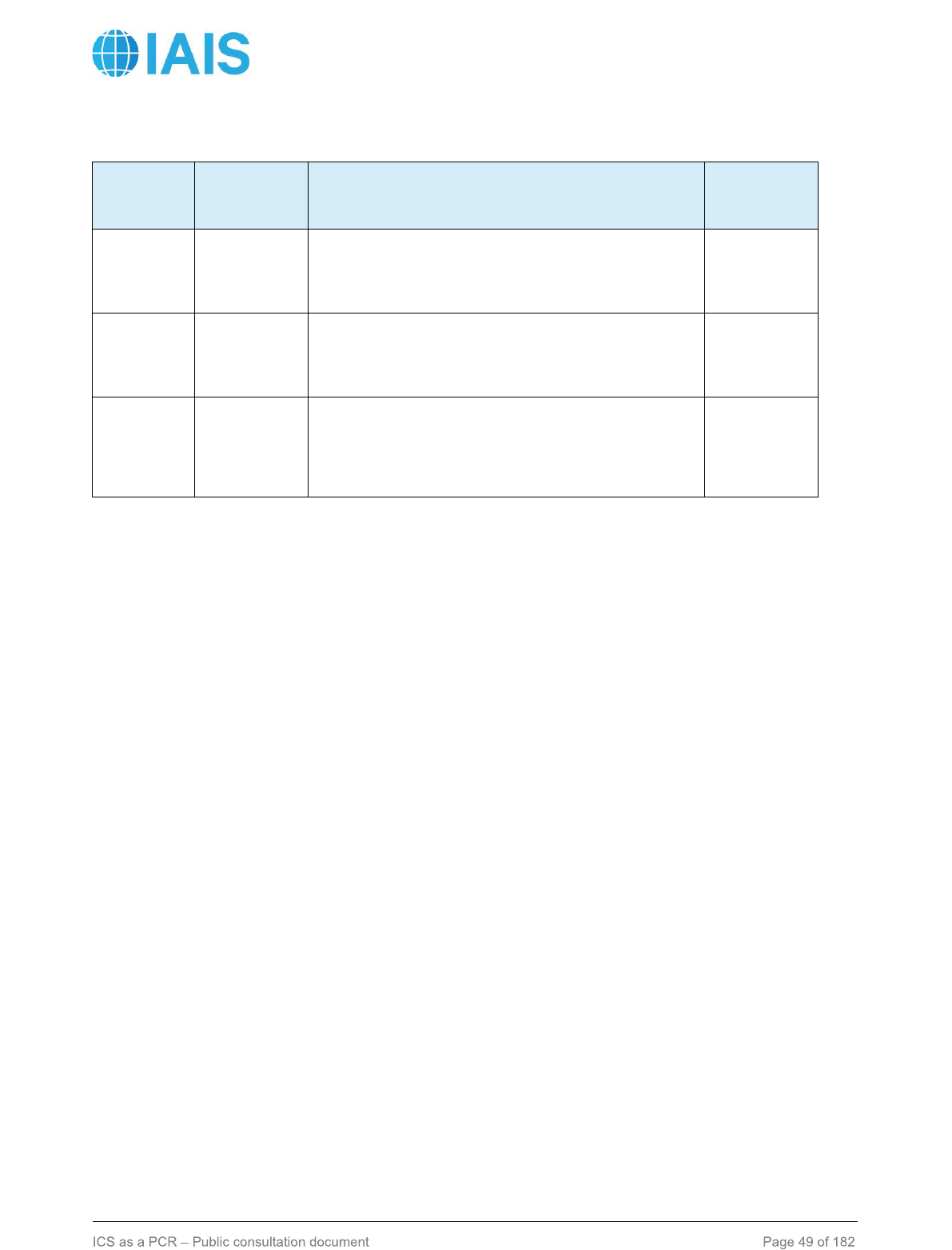
Public
Categories
of risk
Risk
Scope/definition: Risk of adverse change in the value
of capital resources due to
Measurement
Method
Asset
Concentration
risk
The lack of diversification in the asset portfolio.
Factor
Credit risk
Credit risk
Unexpected changes
19
in actual defaults, as well as in the
deterioration of an obligor’s creditworthiness short of default,
including migration risk and spread risk due to defaults.
Factor
Operational
risk
Operational
risk
Operational events including inadequate or failed internal
processes, people and systems, or from external events.
Operational risk includes legal risk, but excludes strategic
and reputational risk.
Factor
L1-80. The individual risk charges are combined in a way that recognises risk diversification, using
correlation matrices.
L1-81. The ICS target criteria is a 99.5% Value at Risk (VaR), over a one-year time horizon, of
adverse changes in the IAIG’s qualifying capital resources.
7.1.1 Risk mitigation techniques
L1-82. In order to promote good risk management and achieve an appropriate level of risk
sensitivity, the ICS recognises the effect of risk mitigation techniques, provided certain criteria are
met. These criteria are set out in the Level 2 text and are designed to ensure that the risk mitigation
techniques are accurately and appropriately reflected within the risk charges.
L1-83. In addition, certain conditions are set regarding the renewal of risk mitigation arrangements.
The conditions vary depending on whether the risk mitigation arrangement applies to a Market risk
exposure or non-life Premium risk. These conditions are specified in the Level 2 text.
L2-130. Risk mitigation techniques may be recognised in the ICS risk charges provided they meet
all of the following requirements:
a. The risk mitigation technique is effective and legally enforceable in all relevant jurisdictions
and results in an effective transfer of risk to a third party.
b. The contractual arrangement ensures that the risk transfer is clearly defined.
c. The calculation of the ICS risk charges allows for the effects of risk mitigation techniques
through a reduction of the risk charge commensurate with the extent of risk mitigation. That
reduction makes reasonable allowance for any basis risk effects due to changes in risk
mitigation assumptions and relationships during a stress scenario and there is appropriate
treatment for any corresponding risk embedded in the use of risk mitigation techniques (eg
Credit risk). These two effects are treated separately.
d. The calculation is made on the basis of assets and liabilities existing at the reporting date of
the ICS calculation.
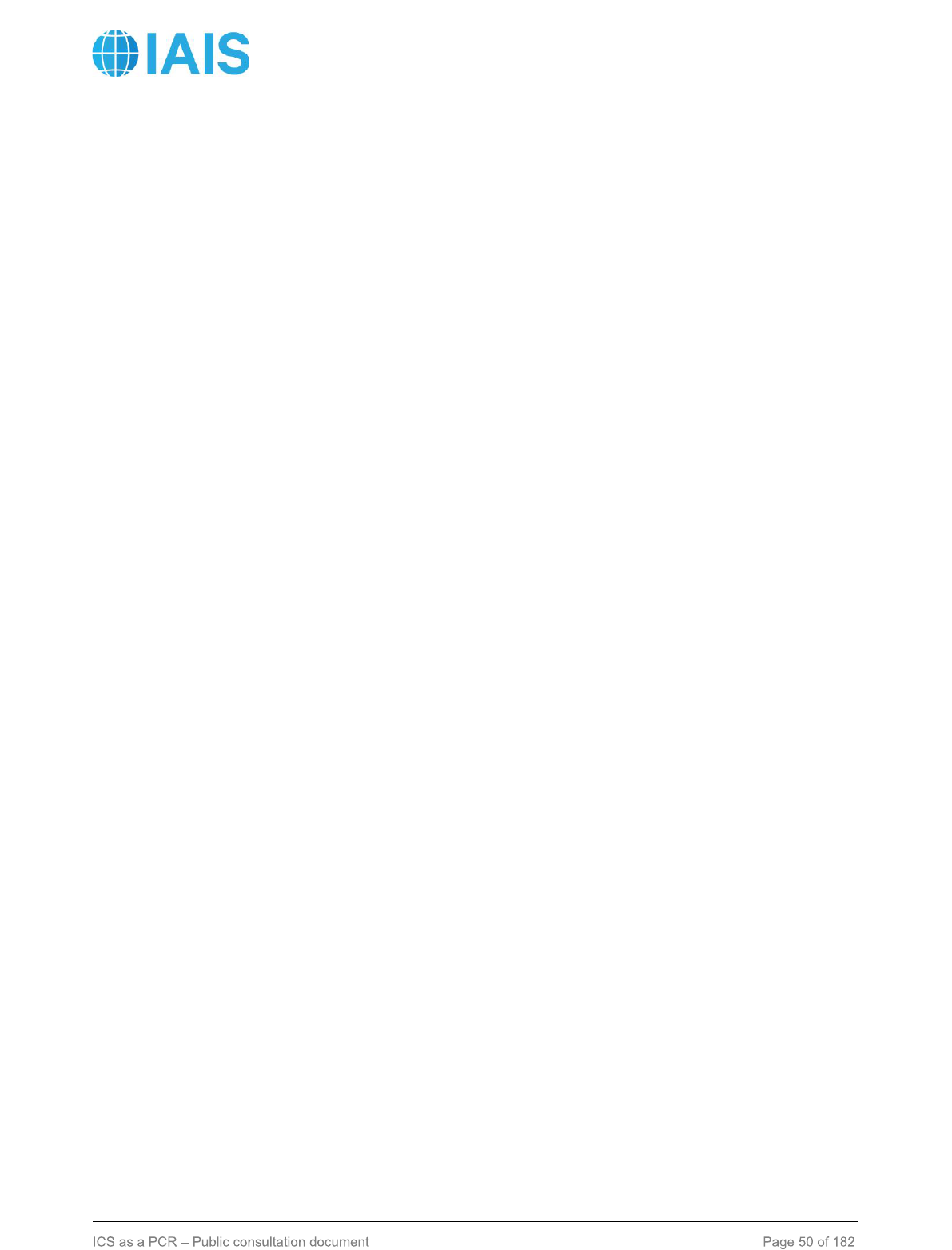
Public
e. There is no double counting of mitigation effects.
f. The documentation for the arrangement sets out a direct claim on the IAIG’s counterparty in
the event of its default, insolvency, bankruptcy or other credit event.
g. Providers of risk mitigation are of an adequate credit quality (demonstrable through either
adequate rating, capitalisation or collateralisation levels) to ensure with appropriate certainty
that the IAIG will receive the protection in the cases specified by the contracting parties.
Credit quality is assessed consistently with the definition of credit categories provided in
section 7.4.
L2-131. In addition to these requirements, market risk mitigation techniques are based on an explicit
reference to specific exposures or a pool of exposures.
L2-132. Where risk mitigation techniques are in force for a period shorter than 12 months and meet
the qualitative criteria above, a proportional factor is applied to the risk mitigation effect taken into
account in the ICS risk charges. That factor is defined as either:
a. The proportion of the full term of the risk exposure covered by the risk mitigation technique
up to a maximum of 100%, where the risk exposure’s term is less than 12 months; or
b. The proportion of 12 months covered by the risk mitigation technique up to a maximum of
100%, where the risk exposure term is 12 months or more.
L2-133. However, where the IAIG plans to replace a risk mitigation arrangement relating to a Market
risk exposure at the time of its expiry with a similar arrangement, this renewal may be taken into
account if the IAIG expects to renew and all of the foreseeable costs of renewal within the time
horizon are taken into account. The requirement of an expectation to renew is considered to be met
if all of the following conditions are met:
a. The renewal is consistent with previous business practice and documented strategy.
b. The replacement of the risk mitigation instrument does not take place more often than every
three months, except for Currency risk or Equity risk where the replacement of the risk
mitigation instrument does not take place more often than every month.
c. The risk that the risk mitigation arrangement cannot be replaced due to an absence of liquidity
in the market is not material under different market conditions and there is no material basis
or operational risks compared to the risk mitigation effect. If the instruments mitigating
Currency or Equity risk are replaced more frequently than every three months, then the IAIG
justifies to its group wide supervisor that:
i. the market for these instruments is sufficiently liquid at the relevant tenor; and
ii. these instruments do not pose a materially greater risk than those replaced less
frequently than every three months.
d. The replacement of the risk mitigation arrangement is not conditional on any future event that
is outside of the control of the IAIG. Where the replacement of the risk mitigation arrangement
is conditional on any future event that is within the control of the IAIG, then the conditions are
clearly set out in the documented strategy referred to in point a).
e. The renewal is realistic regarding the availability of the arrangement and its cost is deducted
from the value attributed to the instrument. This deduction takes into account the risk that the
cost may increase during the following 12 months.

Public
f. Any additional risk stemming from the risk mitigation arrangement (eg Credit risk) is taken
into account in the ICS risk charges.
g. The IAIG is able to demonstrate to its GWS that the required instruments will be available for
renewal from a deep and liquid market under all reasonably foreseeable eventualities over
the following 12 months. Where this is not the case, the benefit recognised for the renewal
of the risk mitigation arrangement is limited to 80% of the full risk mitigating value of the
arrangement at the reporting date.
L2-134. The renewal of risk mitigation arrangements with respect to Non-Life Premium risk may be
taken into account if the IAIG expects to renew and the costs of renewal within the time horizon are
taken into account. The requirement of an expectation to renew is considered to be met if all of the
following conditions are met:
a. The renewal is consistent with previous business practice and documented strategy;
b. The renewal is realistic with regards to availability of the arrangement and its cost
20
; and
c. Any additional risk stemming from the risk mitigation arrangement (eg Credit risk) is taken
into account in the relevant risk charges.
L2-135. When modelling natural catastrophe risk, the renewal of the arrangements may be taken
into account if all of the following conditions are met:
a. The renewal is consistent with previous business practice and documented strategy;
b. The renewal is realistic regarding the availability of the arrangement and its cost; and
c. Any additional risk stemming from the risk mitigation arrangement (eg Credit risk) is also
taken into account in the natural catastrophe risk modelling.
L2-136. Risk mitigation arrangements are not recognised in the calculation of the Operational risk
charge.
7.1.2 Geographic segmentation
L1-84. For some of the risks, a geographical segmentation is used to calculate the risk charge. The
geographical segmentation is set out in the Level 2 text.
L2-137. For those risk charges calculated using a geographical segmentation, the following regions
are used:
a. European Economic Area (EEA) and Switzerland;
b. US and Canada;
c. China;
d. Japan;
e. Other developed markets; and
f. Other emerging markets.
20
Costs may include, but are not limited to, ceded premiums to the reinsurer and commissions.
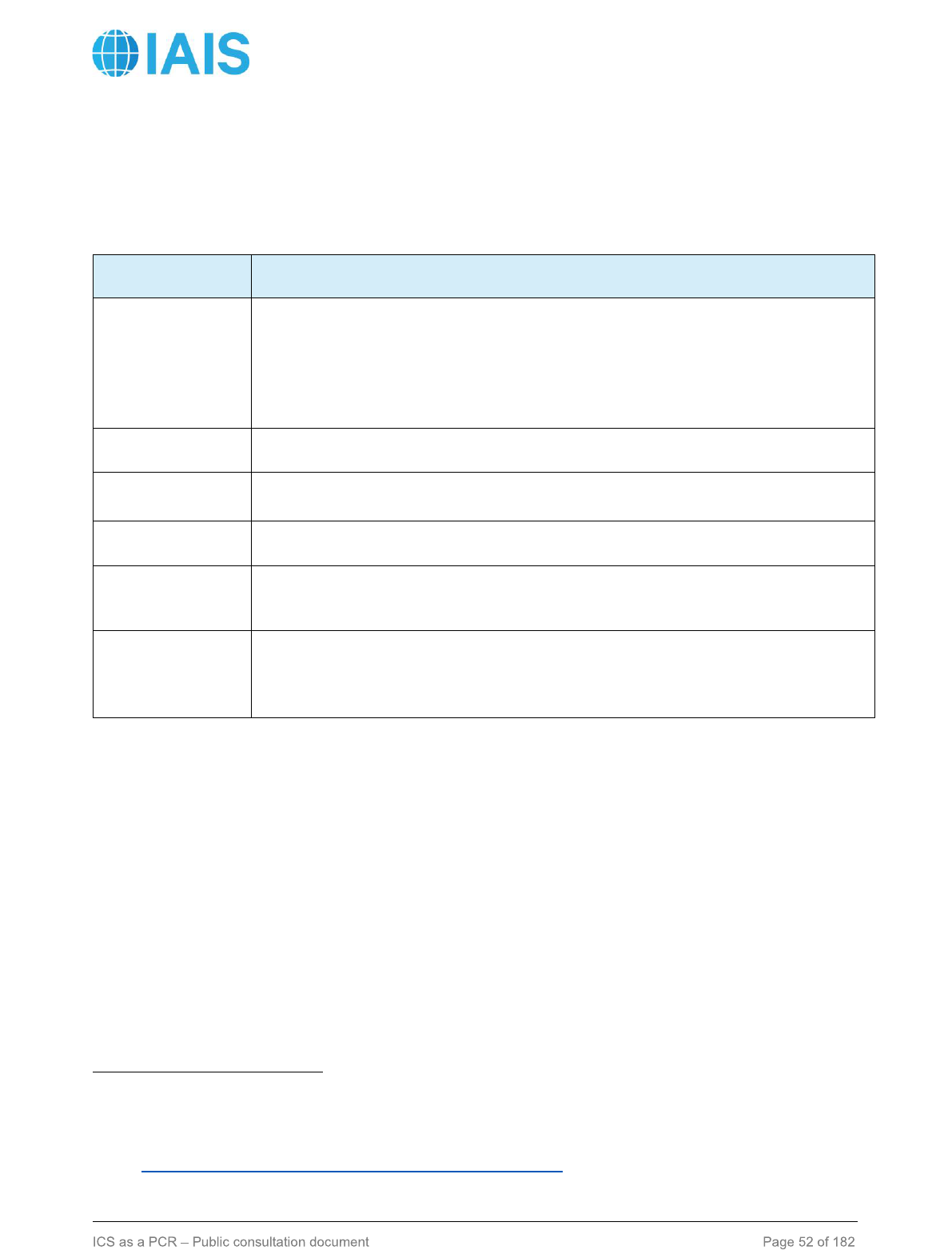
Public
L2-138. The jurisdictions included in each region are listed in Table 6:
Table 6: Geographical segmentation
Region
Jurisdictions included
EEA and
Switzerland
Austria, Belgium, Bulgaria, Croatia, Republic of Cyprus, Czech Republic,
Denmark, Estonia, Finland, France, Germany, Greece, Hungary, Ireland, Italy,
Latvia, Lithuania, Luxembourg, Malta, Netherlands, Poland, Portugal,
Romania, Slovakia, Slovenia, Spain, Sweden, United Kingdom, Iceland,
Liechtenstein, Norway and Switzerland
US and Canada
US
21
and Canada
China
Mainland China and Macao SAR
Japan
Japan
Other developed
markets
22
Australia, New Zealand, Israel, San Marino, Korea, Singapore, Chinese Taipei
and Hong Kong SAR
Other emerging
markets
A list of emerging markets is provided in Table E of the Statistical Appendix of
the IMF World Economic Outlook April 2016
23
. For completeness, if a country
is not listed in the regions above, it is classified as “Other emerging markets”.
7.1.3 Management actions
L1-85. A credit for exercising management actions is taken into account at the level of each risk in
the capital requirement, subject to a cap, as described in the Level 2 text.
L2-139. The impact of management actions for each individual risk is calculated consistently with
the provisions set out in section 5.2.4. The impact of management actions is based on realistic
assumptions and reflects the IAIG’s obligations to policyholders as well as legal provisions applicable
to the IAIG.
L2-140. A cap on the overall credit for management actions is set at the total amount of insurance
liabilities for future bonuses or other discretionary benefits. This cap is applied after aggregating the
total of management actions post-diversification across the risks.
21
Including American Samoa, Guam, Northern Mariana Island, Puerto Rico and US Virgin Islands.
22
‘Other developed’ taken from IMF list of advanced economies minus countries mentioned in other regions
as of April 2016.
23
See http://www.imf.org/external/pubs/ft/weo/2016/01/pdf/text.pdf (accessed on 12 May 2016).

Public
7.2 Insurance risks
7.2.1 Grouping of policies for life insurance risks
Changes compared to ICS Version 2.0:
This section has not incurred any change compared to ICS Version 2.0 for the monitoring period.
L1-86. For life risks, stress scenarios are applied at the level of homogeneous risk groups, as
detailed in the Level 2 text.
L2-141. The projections of the stressed cash flows are conducted at the same level of granularity
as the pre-stress cash flows. Where the pre-stress cash flows have been projected by applying some
grouping of policies, the same grouping of policies is applied to the stressed cash flows.
L2-142. From a practicality standpoint, grouping by portfolios of products (or policies) exposed to
homogeneous insurance risks within the class may be applied. For this purpose, a homogeneous
risk group encompasses a collection of policies with similar risk characteristics.
L2-143. Homogeneous risk groups are reasonably stable over time. Where necessary, for the
determination of homogeneous risk groups, the IAIG takes into account items such as:
a) Underwriting policy;
b) Claims settlement pattern;
c) Risk profile of policyholders;
d) Product features, in particular guarantees; and
e) Future management actions.
7.2.2 Calculation of Life risk charges
Changes compared to ICS Version 2.0:
As part of the 2022 ICS data collections, the IAIS collected historical data on Life risks to monitor the
adequacy of the ICS calibration and revise it where necessary.
The data collected generally did not show any inappropriateness of the ICS Version 2.0 calibration,
except for Mortality risk written in China, and disability/morbidity lump sum long term policies written
in Japan. Therefore, the calibration of the Mortality risk stress factor has been revised from 12.5%
to 15% for China, and the calibration of the long-term category 2 disability/morbidity risk stress factor
has been revised from 8% to 15% for Japan.
L1-87. Life risk charges are applicable to life business and similar to life health business (refer to
paragraph L1-96).

Public
L1-88. The life risk charge is calculated by aggregating, using the life risks correlation matrix
specified in the Level 2 text, the following five sub-risk charges.
• Mortality risk;
• Longevity risk;
• Morbidity/Disability risk;
• Lapse risk; and
• Expense risk.
L1-89. Life risk charges are calculated based on the geographical segmentation specified in the
Level 2 text.
L1-90. For each of the five sub-risks, the risk charge is calculated both with and without the impact
of management actions.
L2-144. The correlation matrix used for aggregating the life risk charges is the following:
Table 7: Life risks correlation matrix
Mortality
Longevity
Morbidity/
Disability
Lapse
Expense
Mortality
100%
-25%
25%
0%
25%
Longevity
-25%
100%
0%
25%
25%
Morbidity/
Disability
25%
0%
100%
0%
50%
Lapse
0%
25%
0%
100%
50%
Expense
25%
25%
50%
50%
100%
7.2.2.1 Mortality risk
L1-91. The Mortality risk charge is calculated as the change in net asset value after applying the
prescribed stress to the level of mortality rates. The prescribed stresses, based on the geographic
segmentation, are specified in the Level 2 text.
L1-92. The Mortality risk charge only applies to those policies that are negatively affected by an
increase in mortality rates.
L2-145. The prescribed stress for the calculation of the Mortality risk charge consists of an increase
of x% in mortality rates at all ages for all policies where an increase in mortality rates leads to a
decrease in the NAV.
L2-146. The stress factors for Mortality risk are given in Table 8:
Table 8: Mortality risk stress factors
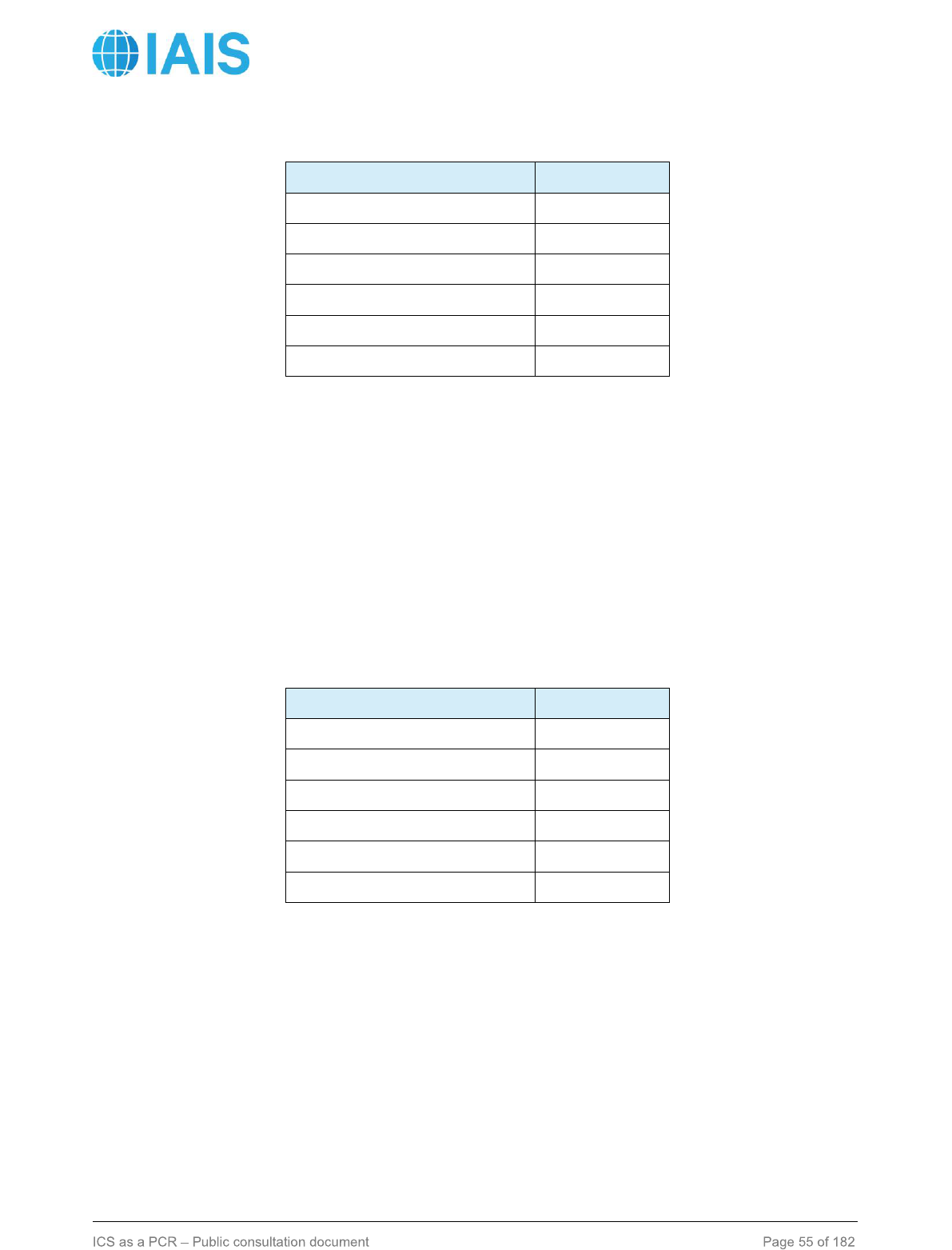
Public
Region
x%
EEA and Switzerland
12.5 %
US and Canada
12.5 %
China
15.0 %
Japan
10.0 %
Other developed markets
12.5 %
Other emerging markets
12.5 %
7.2.2.2 Longevity risk
L1-93. The Longevity risk charge is calculated as the change in net asset value after applying the
prescribed stress to the level of mortality rates. The prescribed stresses, based on the geographic
segmentation, are specified in the Level 2 text.
L1-94. The Longevity risk charge only applies to those policies that are negatively affected by a
decrease in mortality rates.
L2-147. The prescribed stress for the calculation of the longevity risk charge consists of a decrease
of x% in mortality rates at all ages for all policies where a decrease in mortality rates leads to a
decrease in the NAV.
L2-148. The stress factors for Longevity risk are given in Table 9:
Table 9: Longevity risk stress factors
Region
x%
EEA and Switzerland
17.5 %
US and Canada
17.5 %
China
17.5 %
Japan
17.5 %
Other developed markets
17.5 %
Other emerging markets
17.5 %
7.2.2.3 Morbidity and Disability risk
L1-95. The Morbidity/Disability risk charge is calculated as the change in net asset value after
applying the prescribed stresses to the four specified mutually exclusive benefit segments. The
prescribed stresses, based on the geographic segmentation, benefit segments and contract length,
are specified in the Level 2 text.
L1-96. Similar Morbidity/Disability benefits may be classified as life or non-life; however, the
Morbidity/Disability risk charge only applies to those policies with benefits classified as similar to life.
Examples of policies with benefits similar to life are provided in the Level 2 text. For those classified
as similar to non-life, the non-life risk charges (Premium and Claims Reserve risk) apply.
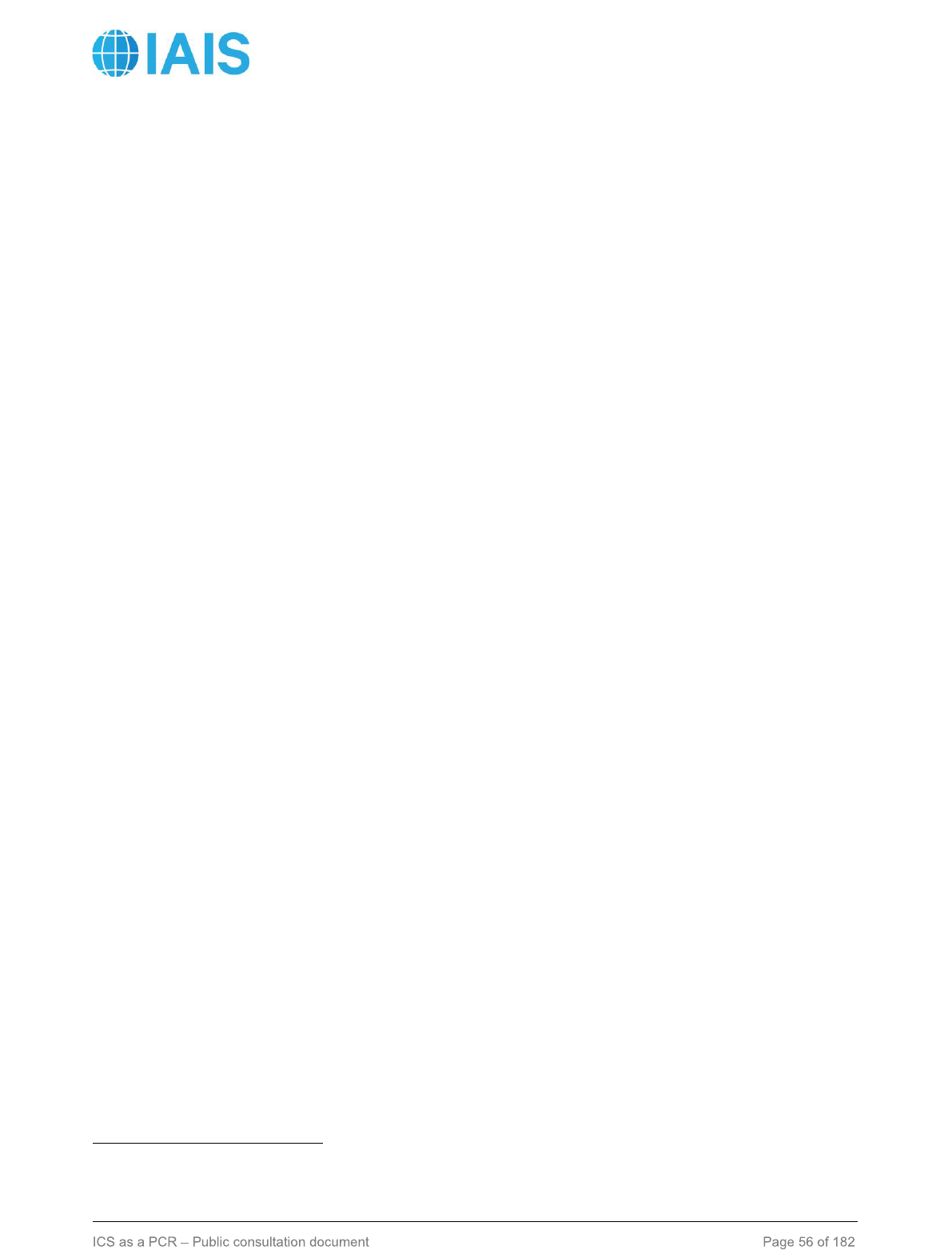
Public
7.2.2.3.1 Segmentation
L2-149. The Morbidity and disability risk is applied to benefits evaluated on a similar to life technical
basis. Irrespective of the legal or contractual classification of insurance obligations, the assignment
to life or non-life activities is based on the type of techniques used to calculate insurance
obligations
24
.
7.2.2.3.2 Sub-risks to be covered
L2-150. For the purpose of the calculation of the Morbidity and disability risk charge, similar to life
insurance obligations are split in the following four mutually exclusive benefit segments:
a) Category 1: Medical expenses
• Products providing any kind of compensation (either fixed or based on real costs) for
medical expenses, in-patient or not. The compensation depends directly on the
treatment or expenses incurred by the policyholder, and is not directly dependent on
the time spent in a given health status.
b) Category 2: Lump sum in case of a health event
• Products providing a single payment at the occurrence of a specified health event or
the occurrence of an accident resulting in a certain level of disability.
c) Category 3: Short-term recurring payments
• Products providing a recurring amount of compensation for a period depending on
the time spent in a given temporary health status, such as inability to work or
hospitalisation.
d) Category 4: Long-term recurring payments
• Products providing a fixed annuity in case of long-term/permanently deteriorated
health status.
L2-151. The distinction between Category 3 and Category 4 is made according to the temporary
versus permanent characteristics of the recurring benefit. A benefit that is contractually limited to a
given period, common to all policyholders, is classified as short-term recurring. A benefit that is to
be paid life-long, or for a period depending on individual policyholder circumstances, without any
upfront short-term limitations, is considered as long-term recurring.
L2-152. Each benefit category is divided into two segments by original contract term:
a) Short-term: Includes contracts with an original term of up to five years.
b) Long-term: Includes contracts with an original term longer than five years.
L2-153. When a policy includes coverage belonging to several of the above benefit categories, each
of the different components of such a policy is subject to the relevant stress. When a policy provides
a combination of benefits between medical expenses and short-term recurring payments (Categories
1 and 3), it may either be split into both categories, or considered under Category 3 altogether.
24
A technical basis is considered similar to life when it involves the explicit use of biometric variables such as mortality, morbidity
and recovery rates by age.
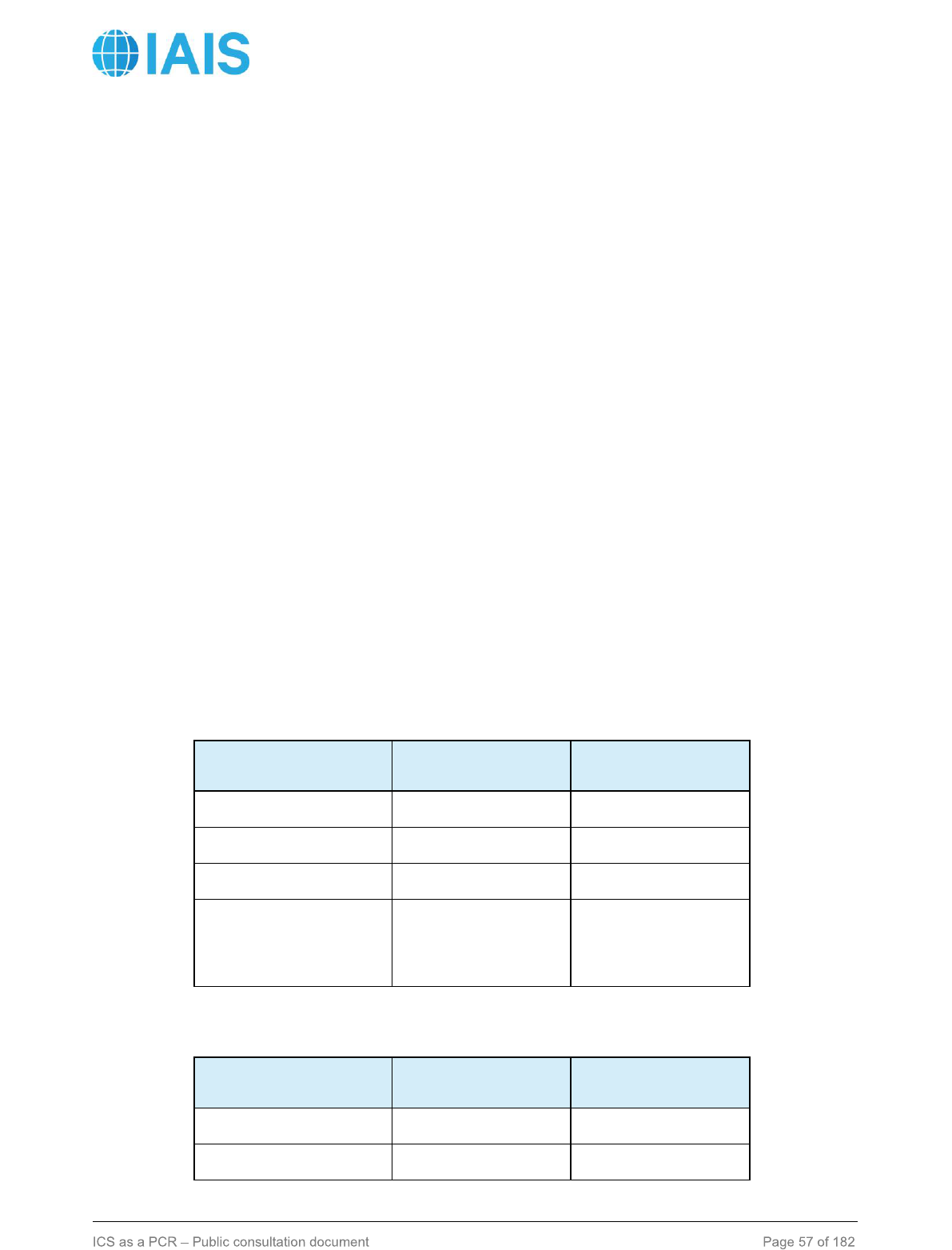
Public
7.2.2.3.3 Calculation
L2-154. The prescribed stresses for the calculation of the Morbidity/Disability risk charge depend on
the benefit category:
a) For benefit categories i = 1, 2 and 3, the stress is defined as an instantaneous relative
increase in inception rates, as specified in Table 10 and Table 11.
The inception rate stress is applied differently depending on the underlying type of
benefits:
• For benefits where claim costs are explicitly modelled using inception rates and/or
recovery rates, the stress is only applied to inception rates. If only recovery rates are
modelled, the stress is applied as a decrease in recovery rates.
• For other benefits in categories 1-3, with no explicit inception rates and/or recovery
rates, the stress factors are directly applied to medical claim payment amounts.
b) For the benefit category 4, the risk charge is calculated for both contract term segments
as the maximum of the Inception Rate risk charge and the Recovery Rate risk charge,
where:
• The Inception Rate risk charge is calculated as the change in NAV following the
increase in inception rates as specified in Table 10 and Table 11; and
• The Recovery Rate risk charge is calculated as the change in NAV following the
decrease in recovery rates of 20% (same stress for both short-term and long-term
contracts).
Table 10: Morbidity/Disability risk stress factors – Location of risk Japan
Category (i)
Short-term
Long-term
1
20%
8%
2
25%
15%
3
20%
10%
4
inception rate stress
= 25%, recovery
rate stress=20%
inception rate stress
= 20%, recovery
rate stress = 20%
Table 11: Morbidity/Disability risk stress factors – All other locations of risk
Category (i)
Short-term
Long-term
1
20%
8%
2
25%
20%
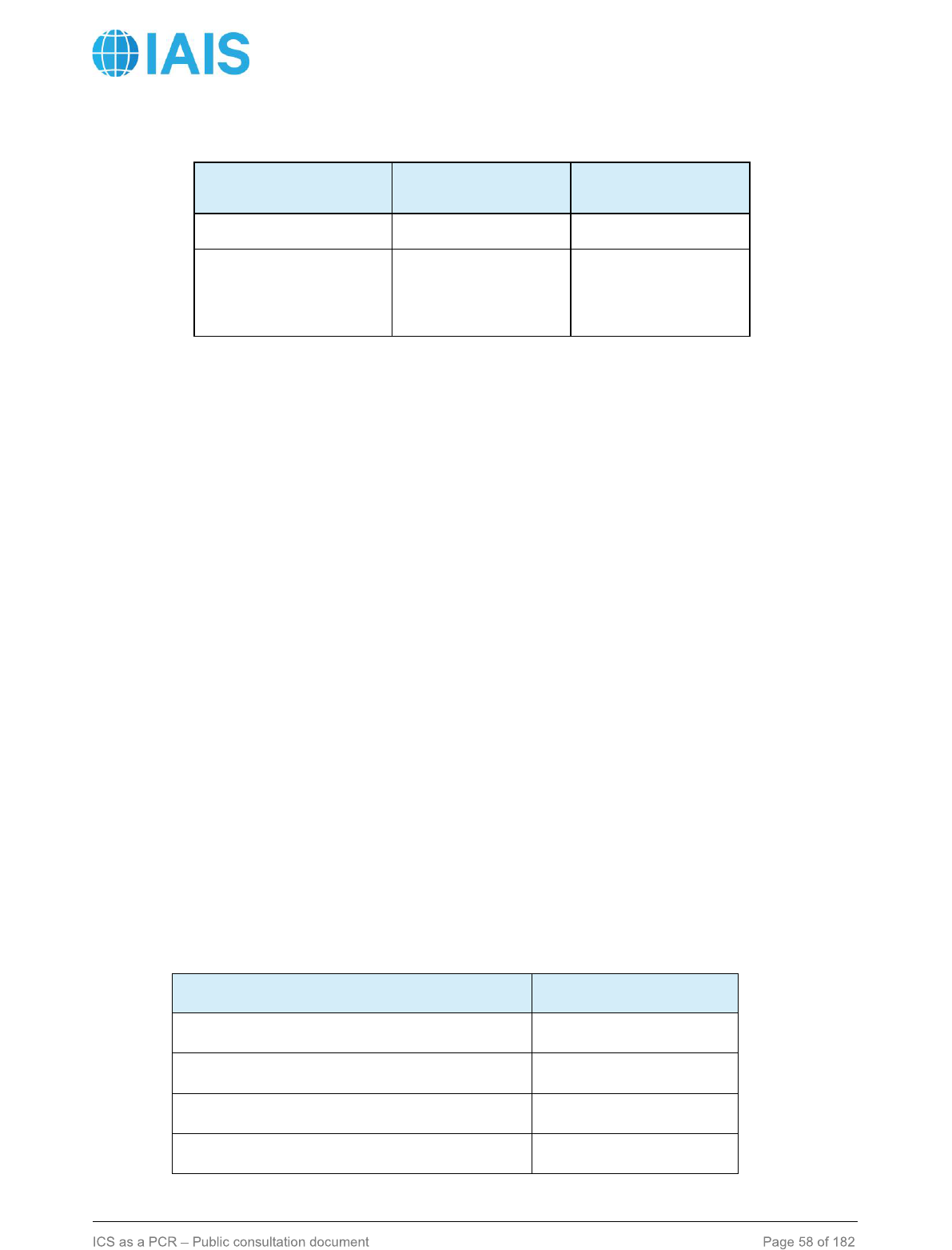
Public
Category (i)
Short-term
Long-term
3
20%
12%
4
inception rate stress
= 25%, recovery
rate stress=20%
inception rate stress
= 20%, recovery
rate stress = 20%
7.2.2.4 Lapse risk
L1-97. The Lapse risk charge is calculated as the maximum of the Lapse risk charge for the level
and trend component and the Lapse risk charge for the mass lapse component.
L1-98. The Lapse risk charges for the level and trend component and the mass lapse component
are calculated as the change in net asset value after applying the prescribed stresses to the two
components. The prescribed stresses, based on the geographic segmentation, are specified in the
Level 2 text.
L1-99. The Lapse risk charge takes into account all legal or contractual options that can change
the value of future cash flows.
L2-155. The calculation of the maximum of the level and trend component and mass lapse
component is performed at the level of each region listed in section 7.1.2.
L2-156. The Lapse risk charge for the IAIG is then obtained as the sum of Lapse risk charges over
all regions.
7.2.2.4.1 Level and Trend component
L2-157. For each region listed in section 7.1.2, the prescribed stress for the calculation of the Level
and Trend component is the most adverse of an upward stress and a downward stress.
L2-158. The upward stress consists of an increase of x% in the assumed option take-up rates,
subject to a maximum of 100%, in all future years for all homogeneous risk groups adversely affected
by such risk.
L2-159. The downward stress consists of a decrease of x% in the assumed option take-up rates in
all future years for all homogeneous risk groups adversely affected by such risk.
The stress factors are specified in Table 12:
Table 12: Level & Trend Lapse risk stress factors
Region
x%
EEA and Switzerland
40%
US and Canada
40%
China
40%
Japan
20%
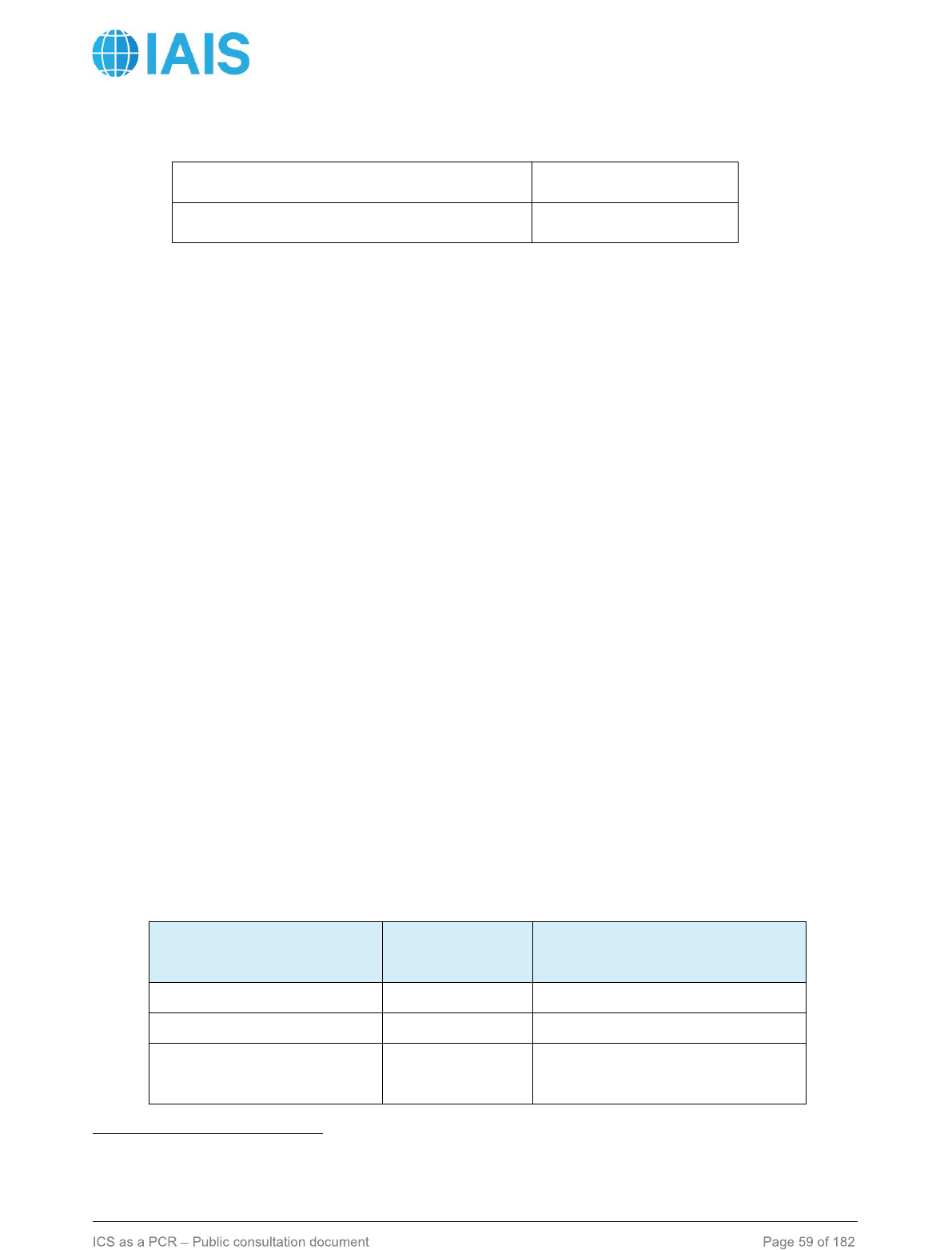
Public
Other developed markets
40%
Other emerging markets
40%
L2-160. All options that can affect the amount of insurance coverage, including options that allow
for partial or full termination, or increase in the insurance cover, are affected by the lapse stress
factors.
L2-161. For each region listed in section 7.1.2, the Level and Trend component is first determined
for each homogeneous risk group before aggregating across all homogeneous risk groups.
L2-162. When the calculation of the current estimate involves the use of a dynamic lapse function
25
,
the Level and Trend component stress is applied to the base rate of the dynamic lapse function.
7.2.2.4.2 Mass Lapse Component
L2-163. For each region listed in section 7.1.2, the prescribed stress for the calculation of the Mass
Lapse component consists of:
• an immediate surrender of 30% of retail policies; and
• an immediate surrender of 50% of non-retail policies.
L2-164. The Mass Lapse component for each homogeneous risk group is subject to a floor of zero.
L2-165. For each region listed in section 7.1.2, the Mass Lapse component is first determined for
each homogeneous risk group before aggregating across all homogeneous risk groups.
7.2.2.5 Expense risk
L1-100. The Expense risk charge is calculated as the change in net asset value after simultaneously
applying the prescribed stresses to the unit expense and expense inflation assumptions. The
prescribed stresses, based on the geographic segmentation, are specified in the Level 2 text.
The prescribed stresses for the calculation of the expense risk charge consists of a relative increase
of x% in unit expense assumptions and an absolute increase of y% per annum in expense inflation,
with x and y specified in Table 13.
Table 13: Expense risk stress factors
Region
x%
(unit expense)
y%
(expense inflation)
EEA and Switzerland
6%
1%
US and Canada
6%
1%
China
8%
Year 1 – 10: 3%;
Year 11 – 20: 2%;
25
A dynamic lapse function varies the lapse rate used in the calculation of insurance liabilities depending on the difference between
the return the insurer is providing on its policies and the returns provided by competitors.
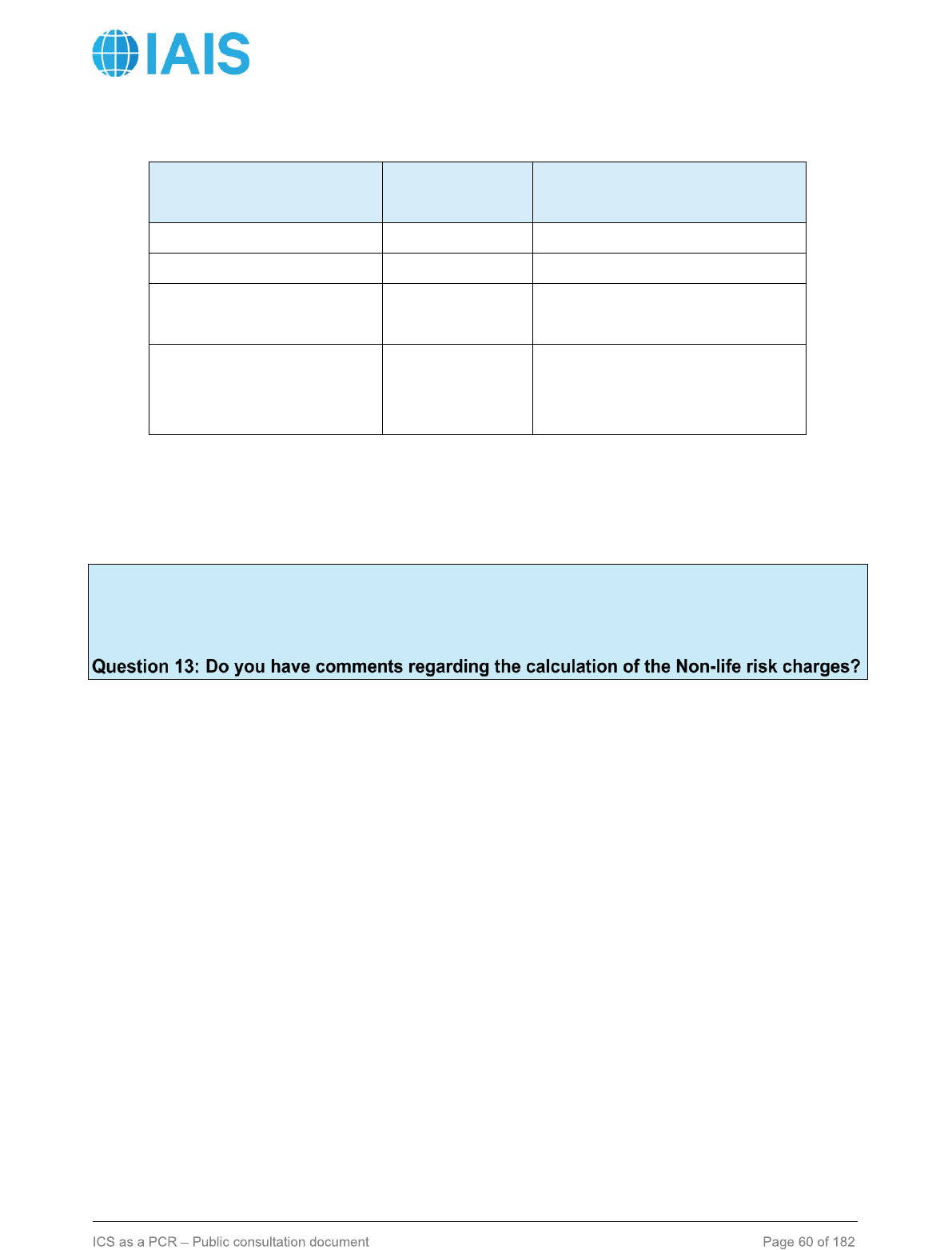
Public
Region
x%
(unit expense)
y%
(expense inflation)
Year 21 onwards: 1%
Japan
6%
1%
Other developed markets
8%
Year 1 – 10: 2%;
Year 11 onwards: 1%
Other emerging markets
8%
Year 1 – 10: 3%;
Year 11 – 20: 2%;
Year 21 onwards: 1%
L2-166. The stresses to the unit expense and expense inflation assumptions are applied
simultaneously.
7.2.3 Calculation of Non-Life risk charges
Changes compared to ICS Version 2.0:
This section has not incurred any change compared to ICS Version 2.0 for the monitoring period.
L1-101. Non-life risk charges are applicable to non-life business and similar to non-life health
business.
L1-102. The non-life risk charge comprises both Premium risk and Claims Reserve risk, which are
captured by a factor-based approach with factors applied to ICS segments within defined regions,
as specified in the Level 2 text. The Claims Reserve risk factors include the effects of Latent Liability
risk.
L1-103. The non-life insurance risk charge is calculated using an aggregation approach that
recognises diversification across lines of business and regions. The correlation factors are specified
in the Level 2 text. The aggregation approach recognises the following sources of diversification:
• Between Premium risk and Claims Reserve risk;
• Within ICS categories, which is a high-level grouping of the type of business;
• Within a region; and
• Across regions.
L1-104. Premium and Claims Reserve risk charges are calculated based on the geographical
segmentation specified in the Level 2 text. The geographical segmentation is further segmented into
lines of business based on statutory reporting in certain regions.

Public
7.2.3.1 Segments/Lines of Business
L2-167. Each exposure for Premium risk and Claims Reserve risk is mapped to a line of business
based on the location of risk. Each line of business has a corresponding ICS segment, as specified
in Table 15. Any jurisdiction not explicitly listed in Table 15 is allocated to either Other developed
markets or Other emerging markets according to Table 6.
7.2.3.2 Definition of ICS Segments and Risk Charges
L2-168. Each ICS segment is assigned:
a. An ICS category: a high level grouping of the type of business (property-like, liability-like,
motor-like, other, mortgage and credit); and
b. A risk factor for the purpose of calculating the risk charge.
L2-169. Premium risk factors do not include the impact of catastrophe events since catastrophe risk
is a separate risk within the ICS.
L2-170. Some of the Claims Reserve risk factors take into account latent liability risk. The purpose
of the latent liability risk charge is to capture risk from liability exposures that is not adequately
captured by historical claims experience.
L2-171. Table 15 provides the list of ICS segments, the associated ICS category, as well as the risk
charges for Premium and Claims Reserve risks. The definitions of ICS segments are provided in 0.
7.2.3.3 Aggregation
L2-172. The calculation of non-life risk charges for each ICS segment takes into account
diversification effects.
L2-173. The first step of aggregation combines each ICS segment’s Premium risk and Claims
Reserve risk charges, applying a 25% correlation factor between the Premium and Claims Reserve
risk charges for all segments (with the exception of mortgage and credit as outlined below).
L2-174. Mortgage business and credit business are added across all regions and then aggregated
with Real Estate risk and Credit risk, respectively.
L2-175. The second step of aggregation is within ICS categories, where a correlation matrix is
applied across segments of a given category. The correlation factors are specified in Table 14 below:
Table 14: Within Category Correlation Factors
ICS Categories
Correlation factor
between segments
within the category
Liability-like
50%
Motor-like
75%
Property-like
50%
Other
25%

Public
L2-176. The third step of aggregation is within each region listed in section 7.1.2, using a 50%
correlation factor between each of the four ICS categories.
L2-177. The fourth step of aggregation is across regions, using a 25% correlation factor between
each region’s total risk charge.
L2-178. As an example, Figure 1 shows how non-life risk exposures are categorised into regions,
geographical segments, ICS categories and ICS segments.
Figure 1: Categorisation of non-life risk exposure, showing how Singapore Motor-like ICS
Category is aggregated
7.2.3.4 Input Data Required
L2-179. The Premium risk charge for each ICS segment is calculated as the relevant risk factor
multiplied by the greater of the net premium earned and net premium to be earned.
L2-180. The Claims Reserve risk charge for each ICS segment is calculated as the relevant risk
factor multiplied by the net current estimate.

Public
Table 15: ICS Non-Life Segmentation
ICS Segment
ICS
Category
Premium
risk factor
Claims
Reserve risk
factor
EEA and
Switzerland
Medical expense insurance
Other
15%
10%
Income protection
Other
25%
35%
Workers' Compensation
Liability-like
25%
27%
Motor vehicle liability - Motor third
party liability
Motor-like
20%
15%
Motor, other classes
Motor-like
20%
15%
Marine, aviation and transport
Property-like
35%
25%
Fire and other damage
Property-like
17.5%
17.5%
General liability - third party liability
Liability-like
35%
27%
Credit and suretyship
Credit
35%
50%
Legal expenses
Other
15%
40%
Assistance
Other
15%
50%
Miscellaneous financial loss
Other
30%
35%
Non-proportional health reinsurance
Other
50%
45%
Non-proportional Casualty
reinsurance
Liability-like
55%
45%
Non-proportional marine, aviation
and transport reinsurance
Property-like
55%
40%
Non-Proportional property
reinsurance
Property-like
45%
40%
Canada
Property - personal
Property-like
35%
25%
Home Warranty
Property-like
30%
25%
Product Warranty
Property-like
30%
25%
Property - commercial
Property-like
30%
30%
Aircraft
Property-like
45%
35%
Automobile - liability/personal
accident
Motor-like
35%
20%
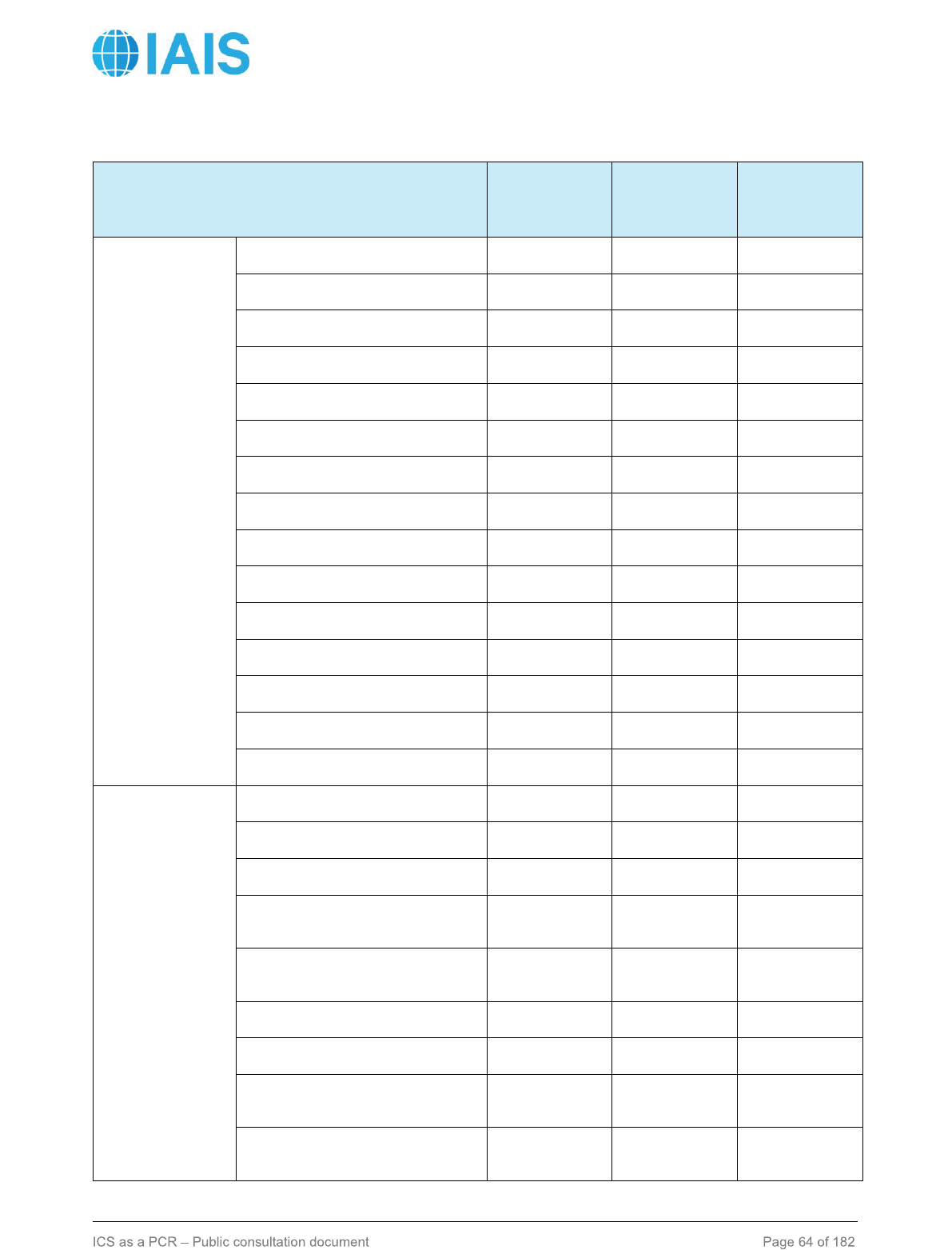
Public
ICS Segment
ICS
Category
Premium
risk factor
Claims
Reserve risk
factor
Automobile - other
Motor-like
35%
20%
Boiler and Machinery
Property-like
30%
25%
Equipment Warranty
Property-like
30%
25%
Credit Insurance
Credit
45%
30%
Credit Protection
Credit
45%
30%
Fidelity
Other
45%
30%
Hail
Property-like
35%
30%
Legal Expenses
Other
45%
40%
Liability
Liability-like
50%
38%
Mortgage
Mortgage
45%
30%
Surety
Credit
45%
30%
Title
Liability-like
35%
30%
Marine
Property-like
45%
35%
Accident and Sickness
Other
45%
30%
Other Approved Products
Other
45%
35%
US
Auto physical damage
Motor-like
12.5%
10%
Homeowners/ Farm owners
Property-like
30%
15%
Special property
Property-like
25%
17.5%
Private passenger auto liability/
medical
Motor-like
15%
15%
Commercial auto/ truck liability/
medical
Motor-like
15%
15%
Workers' compensation
Liability-like
15%
16%
Commercial multi-peril
Liability-like
30%
26%
Medical professional liability --
Occurrence
Liability-like
40%
45%
Medical professional liability –
Claims-Made
Liability-like
30%
35%
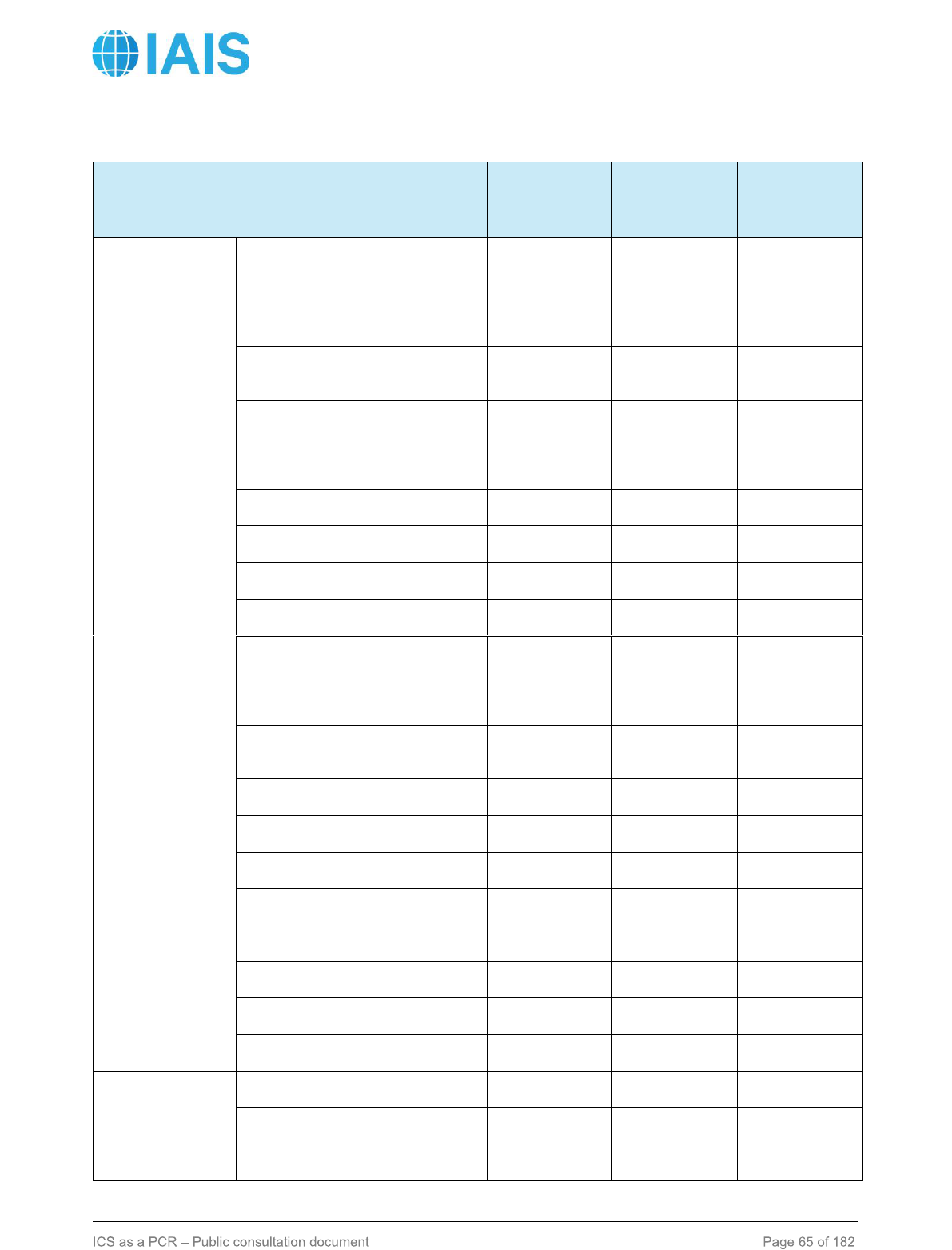
Public
ICS Segment
ICS
Category
Premium
risk factor
Claims
Reserve risk
factor
Other Liability – Occurrence
Liability-like
17.5%
28%
Other Liability – Claims-Made
Liability-like
15%
20%
Products liability
Liability-like
45%
47%
Reinsurance – non-proportional
assumed property
Property-like
35%
25%
Reinsurance – non-proportional
assumed liability
Liability-like
45%
39%
Special liability
Liability-like
30%
25%
Mortgage insurance
Mortgage
45%
30%
Fidelity/surety
Credit
35%
40%
Financial Guaranty
Credit
45%
25%
Other
Other
25%
35%
Reinsurance – non-proportional
assumed financial lines
Other
45%
20%
China
Motor
Motor-like
10%
20%
Property, including commercial,
personal and engineering
Property-like
30%
45%
Marine and Special
Property-like
25%
45%
Liability
Liability-like
10%
36%
Agriculture
Property-like
25%
35%
Credit
Credit
45%
35%
Short-term Accident
Other
10%
10%
Short-term Health
Other
10%
10%
Short-term Life
Other
10%
20%
Others
Other
35%
20%
Japan
Fire
Property-like
20%
35%
Hull
Property-like
40%
35%
Cargo
Property-like
35%
40%
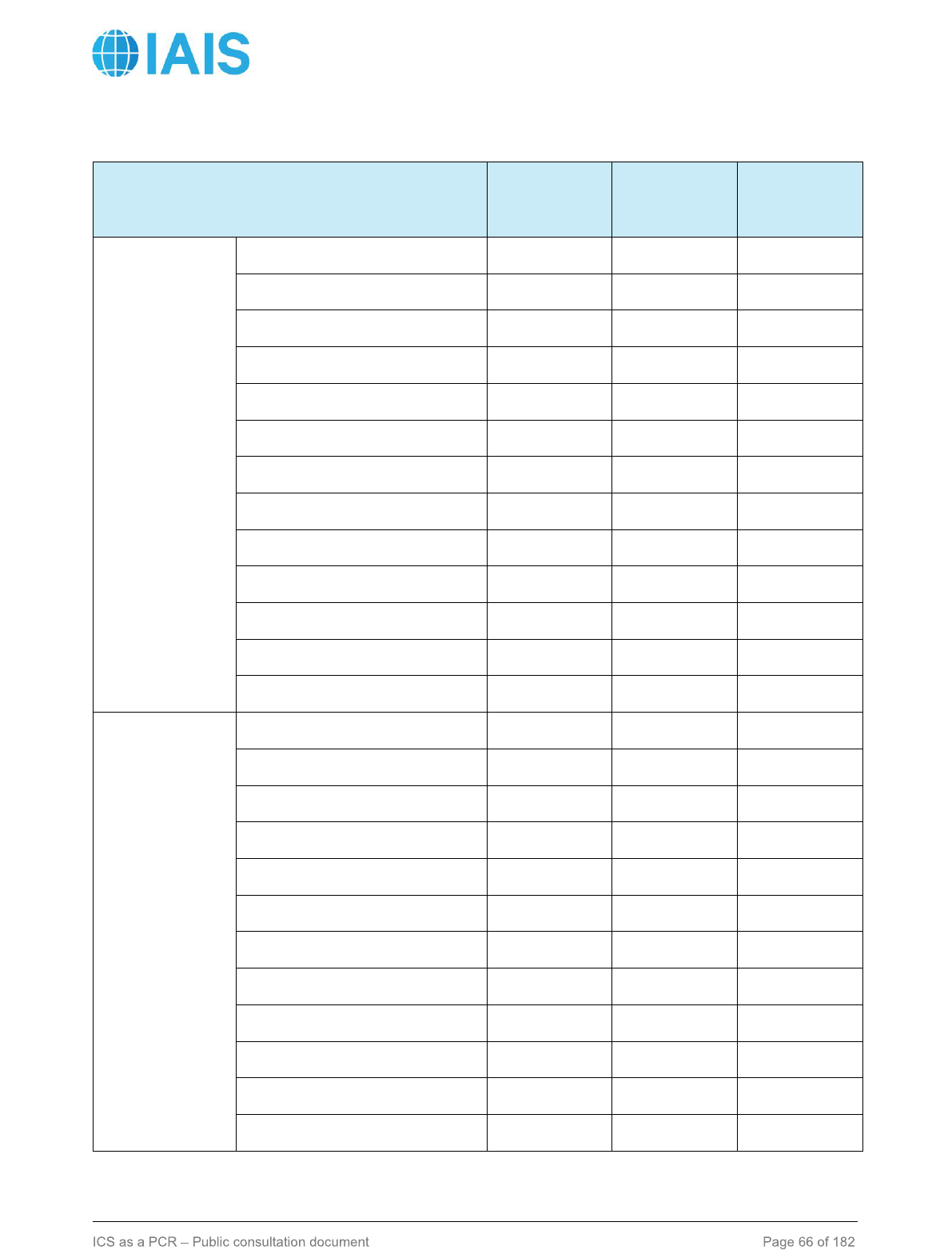
Public
ICS Segment
ICS
Category
Premium
risk factor
Claims
Reserve risk
factor
Transit
Property-like
40%
35%
Personal Accident
Other
10%
15%
Automobile
Motor-like
7.5%
10%
Aviation
Property-like
50%
45%
Guarantee Ins.
Credit
35%
40%
Machinery
Property-like
35%
40%
General Liability
Liability-like
17.5%
27%
Contractor's All Risks
Property-like
35%
40%
Movables All Risks
Property-like
17.5%
25%
Workers' Compensation
Liability-like
35%
22%
Misc. Pecuniary Loss
Other
35%
45%
Nursing Care Ins.
Other
35%
45%
Others
Other
35%
40%
Australia and New
Zealand
Householders
Property-like
30%
20%
Commercial Motor
Motor-like
25%
20%
Domestic Motor
Motor-like
25%
20%
Other type A
Other
25%
20%
Travel
Other
35%
25%
Fire and ISR
Property-like
30%
25%
Marine and Aviation
Property-like
35%
25%
Consumer Credit
Credit
35%
15%
Other Accident
Other
35%
25%
Other type B
Other
35%
35%
Mortgage
Mortgage
45%
30%
CTP
Motor-like
45%
35%
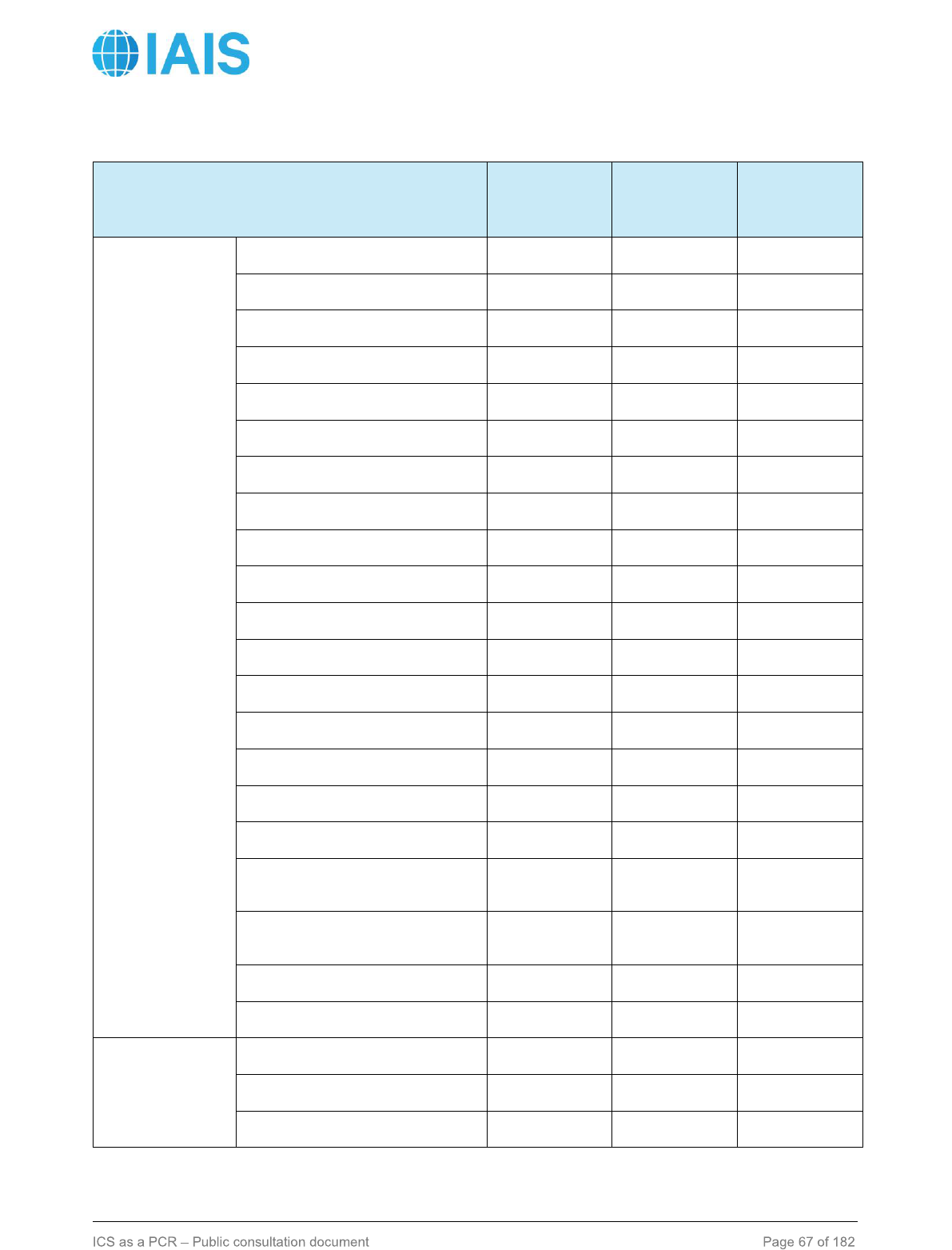
Public
ICS Segment
ICS
Category
Premium
risk factor
Claims
Reserve risk
factor
Public and Product Liability
Liability-like
45%
31%
Professional Indemnity
Liability-like
45%
35%
Employers’ Liability
Liability-like
45%
36%
Short tail medical expenses
Other
15%
25%
Other type C
Other
45%
35%
Householders - non-prop reins
Property-like
45%
30%
Commercial Motor - non-prop reins
Motor-like
45%
30%
Domestic Motor - non-prop reins
Motor-like
45%
30%
Other non-prop reins type A
Other
45%
30%
Travel - non-prop reins
Other
45%
35%
Fire and ISR - non-prop reins
Property-like
55%
40%
Marine and Aviation - non-prop reins
Property-like
55%
40%
Consumer Credit - non-prop reins
Credit
55%
40%
Other Accident - non-prop reins
Other
55%
40%
Other non-prop reins type B
Other
55%
35%
Mortgage - non-prop reins
Mortgage
50%
35%
CTP - non-prop reins
Motor-like
55%
40%
Public and Product Liability - non-
prop reins
Liability-like
55%
43%
Professional Indemnity - non-prop
reins
Liability-like
55%
40%
Employer’s Liability - non-prop reins
Liability-like
55%
43%
Other non-prop reins type C
Other
55%
40%
Hong Kong SAR
Accident and health
Other
30%
25%
Motor vehicle, damage and liability
Motor-like
25%
15%
Aircraft, damage and liability
Property-like
45%
40%
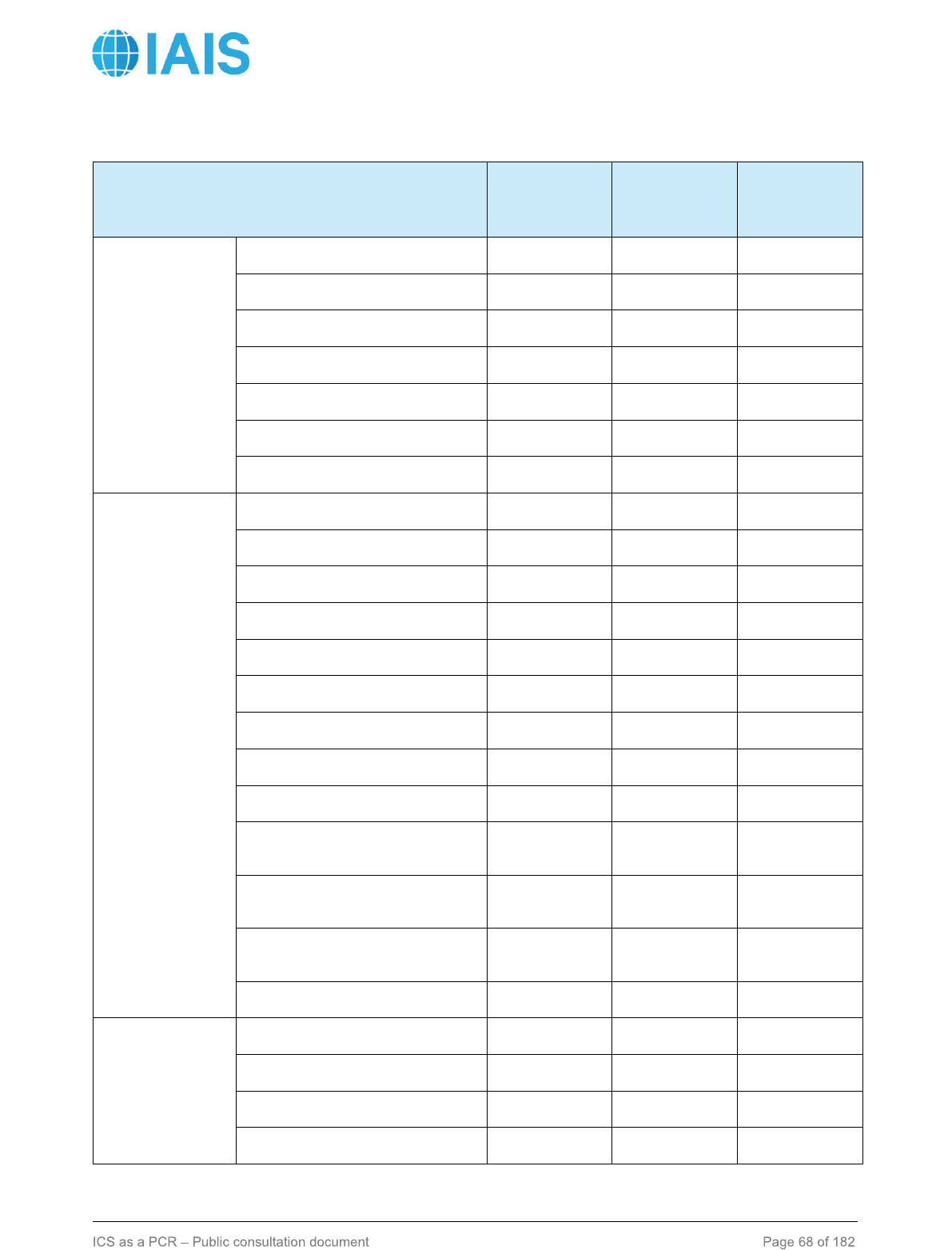
Public
ICS Segment
ICS
Category
Premium
risk factor
Claims
Reserve risk
factor
Ships, damage and liability
Property-like
45%
40%
Goods in transit
Property-like
45%
50%
Fire and Property damage
Property-like
35%
20%
General liability
Liability-like
45%
26%
Pecuniary loss
Other
45%
35%
Non-proportional treaty reinsurance
Property-like
45%
25%
Proportional treaty reinsurance
Property-like
35%
35%
Korea
Fire, technology, overseas
Property-like
25%
30%
Package
Property-like
35%
50%
Maritime
Property-like
45%
45%
Personal injury
Other
35%
50%
Workers accident, liability
Liability-like
12.5%
31%
Foreigners
Other
15%
10%
Advance payment refund guarantee
Credit
50%
50%
Other Non-life
Other
45%
50%
Private vehicle (personal injury)
Motor-like
15%
30%
Private vehicle (property, vehicles
damage)
Motor-like
25%
35%
Vehicle for commercial or business
purpose(personal injury)
Motor-like
25%
20%
Vehicle for commercial or business
purpose(property, vehicles)
Motor-like
25%
20%
Other motor
Motor-like
15%
20%
Singapore
Personal Accident
Other
30%
25%
Singapore/Health
Other
25%
20%
Singapore/Fire
Property-like
30%
25%
Marine and Aviation - Cargo
Property-like
35%
30%

Public
ICS Segment
ICS
Category
Premium
risk factor
Claims
Reserve risk
factor
Motor
Motor-like
30%
25%
Work Injury Compensation
Liability-like
35%
31%
Bonds
Credit
35%
30%
Engineering Construction
Property-like
35%
30%
Credit
Credit
35%
30%
Mortgage
Mortgage
35%
30%
Others- non liability class
Other
35%
30%
Marine and Aviation - Hull
Property-like
45%
35%
Professional indemnity
Liability-like
35%
35%
Public liability
Liability-like
35%
31%
Others - liability class
Liability-like
35%
31%
Chinese Taipei
Fire - residence
Property-like
25%
40%
Fire - commercial
Property-like
55%
45%
Marine - inland cargo
Property-like
30%
25%
Marine - overseas cargo
Property-like
30%
25%
Marine - hull
Property-like
55%
45%
Marine - fish boat
Property-like
45%
45%
Marine - aircraft
Property-like
55%
45%
Motor - personal vehicle
Motor-like
25%
25%
Motor - commercial vehicle
Motor-like
25%
25%
Motor - personal liability
Motor-like
25%
25%
Motor - commercial liability
Motor-like
25%
25%
Liability - public, employer, product,
etc.
Liability-like
35%
36%
Liability - professional
Liability-like
35%
35%
Engineering
Property-like
55%
45%

Public
ICS Segment
ICS
Category
Premium
risk factor
Claims
Reserve risk
factor
Nuclear power station
Property-like
55%
45%
Guarantee - surety, fidelity
Credit
55%
45%
Credit
Credit
55%
45%
Other property damage
Property-like
35%
40%
Accident
Other
15%
10%
Property Damage - commercial
earthquake
Property-like
45%
35%
Comprehensive - personal property
and liability
Property-like
45%
45%
Comprehensive - commercial
property and liability
Property-like
45%
45%
Property damage - typhoon and
flood
Property-like
55%
45%
Property damage - compulsory
earthquake
Property-like
55%
45%
Health
Other
15%
10%
Other Developed
Motor
Motor-like
30%
20%
Property damage
Property-like
30%
25%
Accident, protection and health
(APH)
Other
35%
30%
Short tail medical expenses
Other
35%
25%
Other short tail
Other
35%
30%
Marine, Air, Transport (MAT)
Property-like
35%
35%
Workers' compensation
Liability-like
35%
36%
Public liability
Liability-like
35%
31%
Product liability
Liability-like
35%
43%
Professional indemnity
Liability-like
35%
35%
Other liability and other long tail
Liability-like
35%
36%

Public
ICS Segment
ICS
Category
Premium
risk factor
Claims
Reserve risk
factor
Non-proportional motor, property
damage, APH and MAT
Property-like
50%
40%
Catastrophe reinsurance
Property-like
50%
40%
Non-proportional liability
Liability-like
50%
44%
Non-proportional professional
indemnity
Liability-like
50%
40%
Mortgage insurance
Mortgage
45%
35%
Commercial credit insurance
Credit
45%
35%
Other medium-term
Other
50%
40%
Other Emerging
Motor
Motor-like
35%
25%
Property damage
Property-like
35%
30%
Accident, protection and health
(APH)
Other
35%
30%
Short tail medical expenses
Other
35%
25%
Other short tail
Other
35%
30%
Marine, Air, Transport (MAT)
Property-like
35%
35%
Workers' compensation
Liability-like
45%
36%
Public liability
Liability-like
45%
36%
Product liability
Liability-like
45%
47%
Professional indemnity
Liability-like
45%
35%
Other liability and other long tail
Liability-like
45%
36%
Non-proportional motor, property
damage, APH and MAT
Property-like
50%
45%
Catastrophe reinsurance
Property-like
50%
45%
Non proportional liability
Liability-like
50%
48%
Non-proportional professional
indemnity
Liability-like
50%
45%
Mortgage insurance
Mortgage
50%
40%
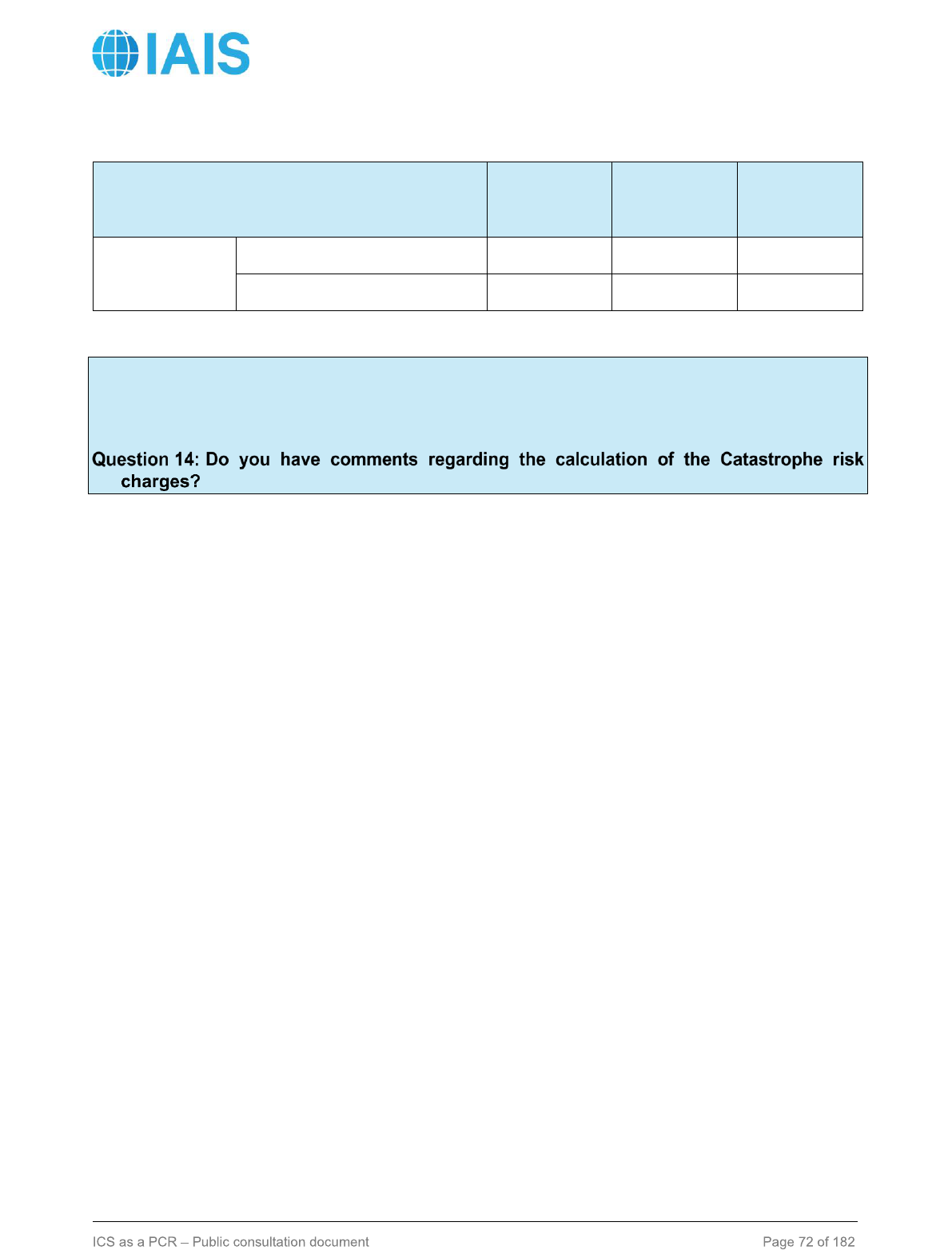
Public
ICS Segment
ICS
Category
Premium
risk factor
Claims
Reserve risk
factor
Commercial credit insurance
Credit
50%
40%
Other medium-term
Other
55%
40%
7.2.4 Calculation of Catastrophe risk charges
Changes compared to ICS Version 2.0:
This section has not incurred any change compared to ICS Version 2.0 for the monitoring period.
L1-105. Catastrophe risk is a risk that affects both life and non-life business. The Catastrophe risk
charge covers risks associated with low frequency, high severity events occurring at any point in
time in the next 12 months and takes into account all expected in-force business when the event
occurs.
L1-106. Risk mitigation arrangements (eg outwards reinsurance protection purchased) may reduce
the overall Catastrophe risk charge.
L1-107. Catastrophe risk is segmented at the risk/peril level. Perils cover both naturally occurring
perils (natural catastrophes) and man-made perils/scenarios (other catastrophes) and their
consequences.
L1-108. The impact of catastrophe claim events include not only the main peril (eg windstorm,
earthquake) but also the secondary perils associated with the primary peril. Secondary perils can
affect all lines of business within the scope of the calculation. Examples of main and secondary perils
are provided in the Level 2 text.
L1-109. The perils, scenarios and allowable risk mitigation, along with prudential safeguards for the
use of models to calculate the natural catastrophe risk charge, are specified in the Level 2 text.
7.2.4.1 Scope of Calculation
L2-181. When calculating the Catastrophe risk charge, all lines of business exposed to Catastrophe
risk are considered. To avoid double counting with the other ICS risk charges, the following principles
are applied:
a. Life and similar to life health business are included only for the pandemic and the terrorism
scenarios; and
b. The impact on financial markets and the whole economy (Market and Credit risks) is not
included in the calculation of Catastrophe risk.
7.2.4.2 Covered Perils
L2-182. The perils covered by Catastrophe risk are:
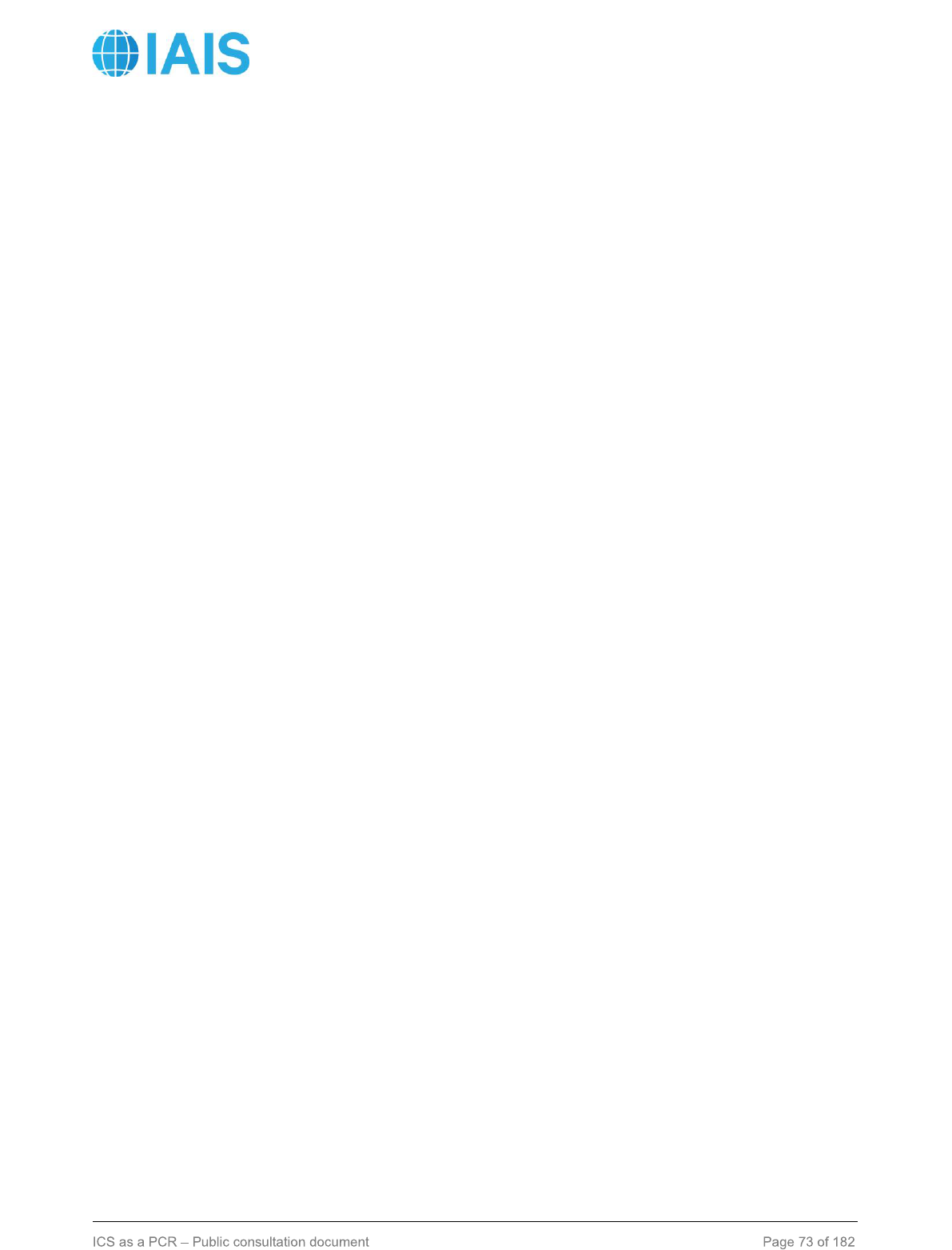
Public
a. Natural catastrophe:
iii. Tropical cyclone, hurricane, typhoon;
i. Extra-tropical windstorm/winter storm;
ii. Earthquake; and
iii. Other material natural perils, such as:
• Flood;
• Tornado, hail, convective storms;
• Other risks.
b. Other catastrophes (Man-Made Perils/Scenarios):
i. Terrorist attack;
ii. Pandemic; and
iii. Credit and Surety.
L2-183. The impact of catastrophe claim events include both the main peril and any secondary perils
associated with the main peril.
7.2.4.3 Natural Catastrophe
L2-184. Stochastic catastrophe models may be used to calculate loss amounts resulting from
natural catastrophe events.
L2-185. Loss amounts are calculated considering:
a. The impact of natural catastrophe on all lines of business affected;
b. An allowance for non-modelled exposures including expected new business over the target
time horizon of one year that could be affected by the listed perils; and
c. An allowance for non-modelled perils and regions reported as part of the other natural
catastrophe losses. This may include perils and regions that are not modelled individually or
specifically but for which potential losses are assessed using other approaches.
L2-186. The natural catastrophe risk charge is the difference between the 99.5
th
percentile and the
mean of the total annual aggregate losses, net of protections. The annual aggregate losses are
calculated as the aggregation of losses across all regions and perils.
7.2.4.4 Other Catastrophe Scenarios
L2-187. The loss amounts for the following perils are determined according to the scenarios
described below.
L2-188. The impact of the scenarios is calculated for all lines of business affected by the respective
scenario, unless otherwise specified in the scope of the calculation.
7.2.4.4.1 Terrorist Attack
L2-189. The risk charge is the sum of the losses from the following two components:

Public
a. Total loss of property (including building, content, motor vehicles) from insurance contracts
and the impact on other insurance contracts resulting directly from the loss of property; and
b. The losses from life insurance contracts, health coverage and workers’ compensation.
L2-190. For both the life and non-life components, the scenario is a five-tonne bomb blast for the
largest geographical risk concentration partly or fully located within a radius of 500 metres. To
determine this concentration, all buildings (including properties for own use) are considered. The
largest concentration is determined separately for the life and non-life components.
L2-191. For property damage, including insured properties and related covers, the following
assumptions are made:
• 100% damage ratio within a circular zone of a 200 metre radius;
• 25% damage ratio for the next circular zone up to a 400 metre radius; and
• 10% damage ratio between 400 and 500 metres.
L2-192. For fatalities, the following assumptions are made:
• 15% fatality rate within a circular zone of a 200 metre radius; and
• 1.5% fatality rate between 200 and 500 metres.
L2-193. For disabilities, the following assumptions are made:
• 20% disability rate within a circular zone of a 200 metre radius; and
• 10% fatality rate between 200 and 500 metres.
7.2.4.4.2 Pandemic
L2-194. The scenario is an increase in the number of deaths following a global pandemic. The risk
charge is the total loss amount to all individual and group insurance products covering Mortality risk
in any part of the world resulting from the increase of 1.0 in the number of deaths per thousand
insureds.
7.2.4.4.3 Credit and Surety
L2-195. The risk charge is the sum of the losses from the following three components:
a. Mortgage insurance;
b. Trade credit; and
c. Surety.
7.2.4.4.3.1 Mortgage insurance
L2-196. The scenario is calculated as an aggregate loss amount resulting from an increase in
frequency and severity due to the specified decline in home prices. A 25% decline in home prices is
assumed to persist for the entire one-year time period. The total loss amount includes the impact of
both an increase in frequency of delinquency and defaults and an increased loss severity that result
from the decline in home prices.

Public
7.2.4.4.3.2 Trade Credit
L2-197. The credit stress scenario for trade credit is defined as the total loss amount due to the
inability of customers of the policyholder to pay for goods delivered and/or services provided. The
trade credit coverage indemnifies the policyholder for bad debt losses incurred due to a customer’s
inability to pay. A policyholder’s customer’s inability to pay is indicated by an increase in both the
probability of default and the loss given default of that customer. The total loss amount is adjusted
for any existing loss mitigation, including reimbursements from policyholder, retention etc.
Table 16: Credit stress factors for trade credit
Rating category
Factor
Investment Grade
80%
Non-Investment Grade
200%
7.2.4.4.3.3 Surety
L2-198. The credit stress scenario for surety is defined as the total net potential loss amount based
on the penal sum of the surety bond. A surety bond indemnifies the policyholder from the principal’s
inability to perform its contractual obligation. The penal sum represents the maximum amount that
the IAIG is required to pay to the beneficiary. The IAIG calculates the largest net potential losses for
its ten largest exposures to surety counterparties (principals) using the methodology described
below. The total net potential loss amount assumes that the two largest net losses have occurred,
and is therefore equal to the sum of the two largest net losses.
7.2.4.5 Aggregation of Catastrophe Risks
L2-199. For the purpose of calculating the Catastrophe risk charge, the other catastrophe scenarios
are assumed to be mutually independent and independent of the natural catastrophe perils.
Consequently, the total ICS catastrophe capital charge will be calculated as follows:
7.2.4.6 Calculation of the Recoverable Amount to be used for the Calculation of Contingent
Credit Risk
L2-200. The recoverable amount is calculated as the difference between the risk charge for
Catastrophe risk calculated as if the risk mitigation arrangements did not exist, and the risk charge
for Catastrophe risk calculated taking into account qualifying risk mitigation arrangements.
L2-201. The recoverable amount is allocated by credit rating categories, using the following steps:
a. For the aggregate of the Natural Catastrophe risk and for each Other catastrophe scenario,
calculate the recoveries by rating class and the gross and net losses;
b. Aggregate all gross and net losses using the aggregation approach described above. The
difference between aggregated gross and net losses is the total recoverable; and
c. The recoverable by rating class is equal to the total recoverable multiplied by the ratio of the
sum over all scenarios of the recoveries in that rating class to the sum over all scenarios of
the recoveries for all rating classes.
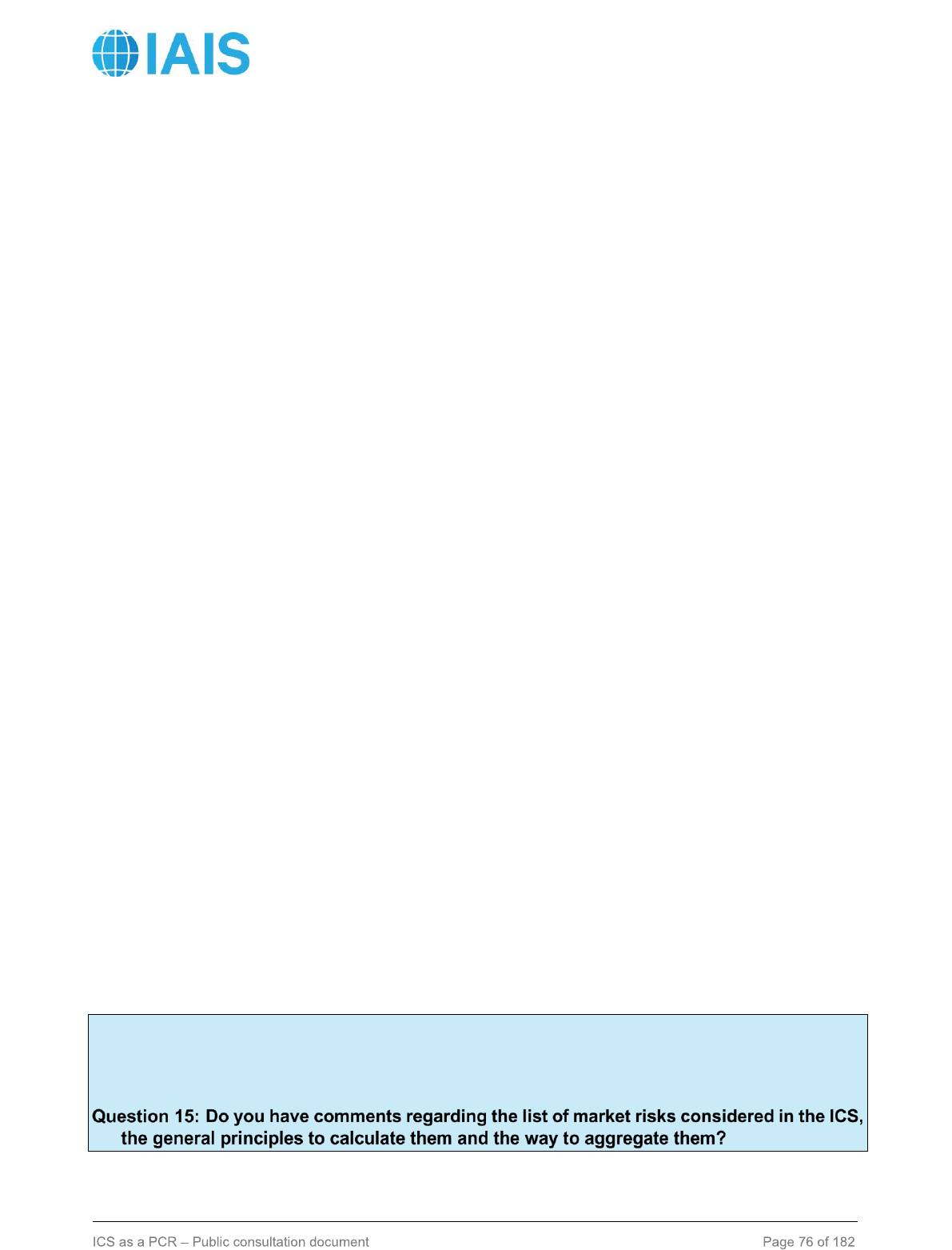
Public
7.2.4.7 Safeguards for Natural Catastrophe Models
L2-202. In order to assess the appropriateness of stochastic natural catastrophe models, the IAIG
provides information on the following safeguards.
• Safeguard 1 – Description of the scope of application: the IAIG describe the perimeter of the
natural catastrophe model’s calculation.
• Safeguard 2 – Validation: the IAIG demonstrates that a rigorous process is in place by which
they can establish whether their natural catastrophe model framework is sound or whether
improvements are needed.
• Safeguard 3 – Sign-off by senior management: The senior management of the IAIG has
ownership of the natural catastrophe model, and the model complies with the validation
process prescribed by the natural catastrophe model governance process.
• Safeguard 4 – Statistical quality test: The statistical quality test addresses issues related to
the following technical aspects of the natural catastrophe model:
o methodology and assumptions;
o coverage of material risks;
o data (including external data) and expert judgment;
o aggregation of risks and diversification effects;
o consistency with the method used for the calculation of technical provisions;
o allowance for risk mitigation techniques and future management actions; and
o financial guarantees and contractual options.
• Safeguard 5 – Use test and governance: The use test reflects the IAIG’s view of its risks and
is used in decision making.
• Safeguard 6 – Documentation standards: The documentation of the natural catastrophe
model, including its use and other related aspects:
o facilitates the supervisory review of the model;
o facilitates Senior Management’s understanding; and
o recognises the weaknesses of the model.
• Safeguard 7 – List of catastrophe risk sources that are not modelled: the IAIG recognises the
limitations in the scope of their natural catastrophe model. The IAIG makes a list of natural
catastrophe risks specified in the ICS but not modelled, and explain why those risks are not
modelled.
7.3 Market Risks
7.3.1 Calculation of the Market risk charge
Changes compared to ICS Version 2.0:
This section has not incurred any change compared to ICS Version 2.0 for the monitoring period.

Public
L1-110. The market risk charge is calculated by aggregating, using the market risks correlation
matrix specified in the Level 2 text, the following six sub-risk charges:
• Interest Rate risk;
• Non-Default Spread risk;
• Equity risk;
• Real Estate risk;
• Currency risk; and
• Asset Concentration risk.
L1-111. When calculating the market risk charges, the following impacts are considered:
• The direct impacts of the prescribed stress scenarios on the value of assets and liabilities;
and
• The indirect impacts linked to potential changes in policyholder behaviour following the
prescribed stress scenarios.
L1-112. For each of the six sub-risks, the risk charge is calculated both with and without the impact
of management actions.
L2-203. The correlation matrix used for aggregating the market risk charges is the following:
Table 17: Market risks correlation matrix
Interest
rate
NDSR
Up
NDSR
Down
Equity
Real
Estate
Currency
Asset
concentration
Interest rate
100%
25%
25%
25%
25%
25%
0%
NDSR Up
25%
100%
100%
75%
50%
25%
0%
NDSR Down
25%
100%
100%
0%
0%
25%
0%
Equity
25%
75%
0%
100%
50%
25%
0%
Real estate
25%
50%
0%
50%
100%
25%
0%
Currency
25%
25%
25%
25%
25%
100%
0%
Asset
concentration
0%
0%
0%
0%
0%
0%
100%
7.3.2 Interest Rate risk
Changes comapred to ICS Version 2.0:
This section has not incurred any change compared to ICS Version 2.0 for the monitoring period.

Public
L1-113. The calculation of the Interest Rate risk charge is based on a combination of five stresses
applied to the entire risk-free yield curve for each relevant currency as identified in paragraph L1-
115:
• A mean-reversion scenario;
• A level up scenario;
• A level down scenario;
• A twist up-to-down scenario; and
• A twist down-to-up scenario.
L1-114. The characteristics of those stresses are specified in the Level 2 text. The stress scenarios
are applied only to assets and liabilities that are sensitive to a change in the level of risk-free rates;
the identification of assets and liabilities subject to the stresses is specified in the Level 2 text. The
impact of those stresses on lapse rates, due to the influence of market conditions on policyholder
behaviour, is taken into account as specified in the Level 2 text.
L1-115. The impact of the scenarios listed above is calculated for all currencies in which the IAIG
holds interest rate sensitive assets or liabilities. Currencies for which the exposure is non-material
may be grouped together. The stress impacts calculated for each currency or group thereof are then
combined to derive the overall Interest Rate risk charge.
L1-116. The methodology to aggregate the results across the five stresses and relevant currencies,
is specified in the Level 2 text.
L2-204. All assets and liabilities sensitive to changes in interest rates are taken into account in the
calculation of the Interest Rate risk charge, with the exception of financial instruments issued by the
IAIG that qualify as capital resources.
L2-205. For current estimates of insurance liabilities calculated with a dynamic lapse function that
uses the interest rate as an input variable, the base lapse assumptions stay unchanged under the
interest rate stresses, but lapse rates react to the interest rate scenarios used to calculate the Interest
Rate risk charge.
L2-206. The Interest Rate risk charge is calculated as:
where:
• is an index over all currencies in which the IAIG is exposed to Interest Rate risk;
•
is the result of the mean reversion scenario for currency , obtained as described in
paragraph L2-209; and
•
is a random variable encompassing the results of the level up, level down, twist up-to-
down and twist down-to-up scenarios for currency , as specified in paragraph L2-207.
L2-207. For currency ,
is defined as:
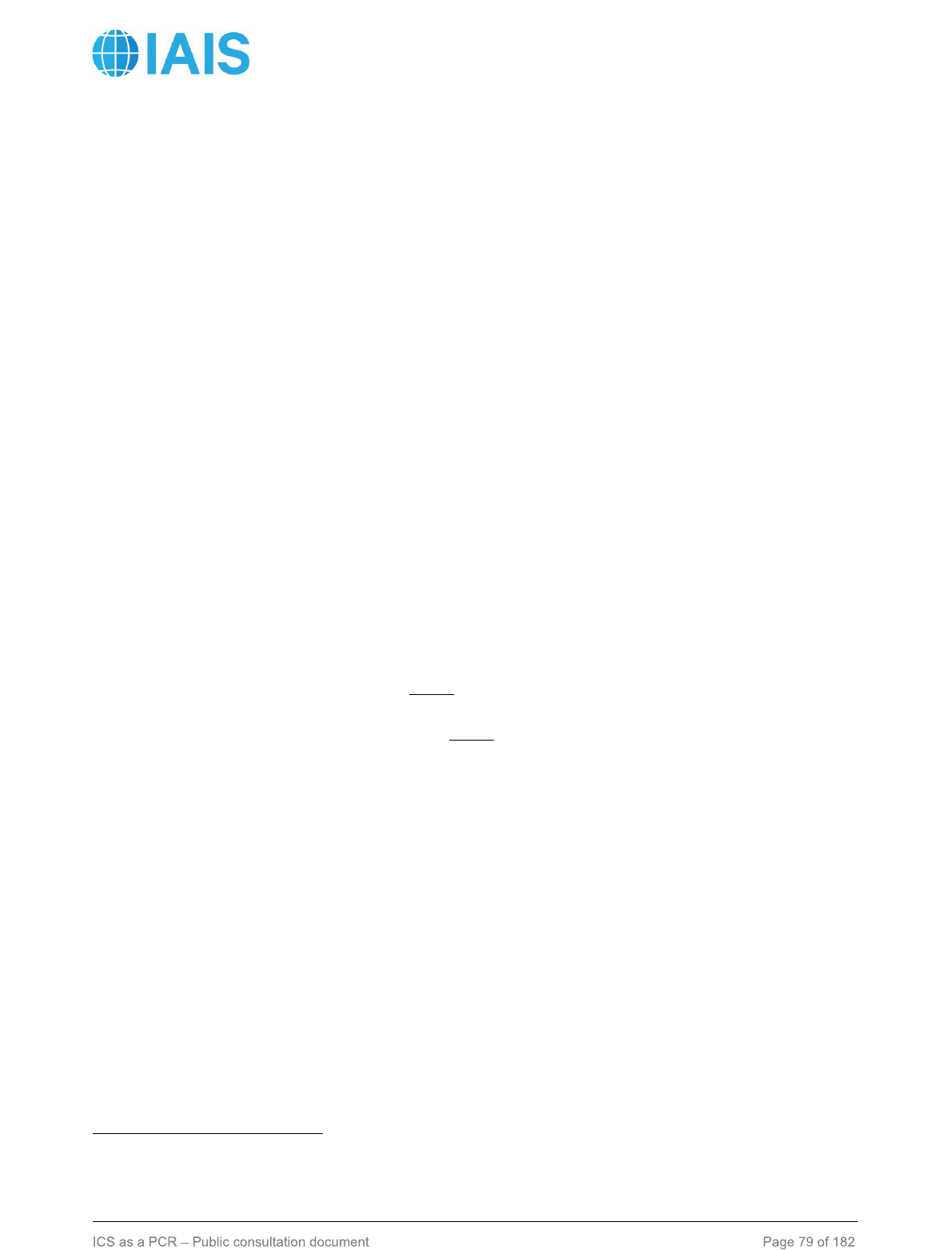
Public
where:
•
is the 99.5% quantile of the standardised normal distribution;
•
and
are the results of the level up and level down scenarios respectively, obtained
as described in paragraph L2-209;
•
and
are the results of the twist up-to-down and twist down-to-up scenarios
respectively, obtained as described in paragraph L2-209; and
•
and
are independent random variables following a standardised normal distribution.
L2-208. In addition, the random variables
and
are such that:
• For any ,
; and
• For any and ,
.
L2-209. For currency ,
,
,
,
and
correspond to the change in the IAIG’s Net Asset
Value when recalculating the value of all relevant assets and liabilities using the mean reversion,
level up, level down, twist up-to-down and twist down-to-up stressed yield curves respectively,
obtained using the methodology described in paragraphs L2-210 to L2-218.
L2-210. For each currency, the stressed yield curve for the mean reversion scenario is obtained by
adding the following yield curve to the initial yield curve, up to the LOT:
where:
• is the curve equal to 1 for all maturities;
• is the curve equal to
for any maturity ;
• is the curve equal to
for any maturity ;
• is the exponential decay rate of the Nelson Siegel model
26
for the risk-free yield curve;
•
is the vector defined as
;
• is the identity matrix;
•
and
are parameters of the process followed by the vector
below, described by the equation:
26
As described in the article Diebold, F.X. and Li, C (2006) Forecasting the Term Structure of Government Bond Yields in Journal
of Econometrics, 130, 337-364
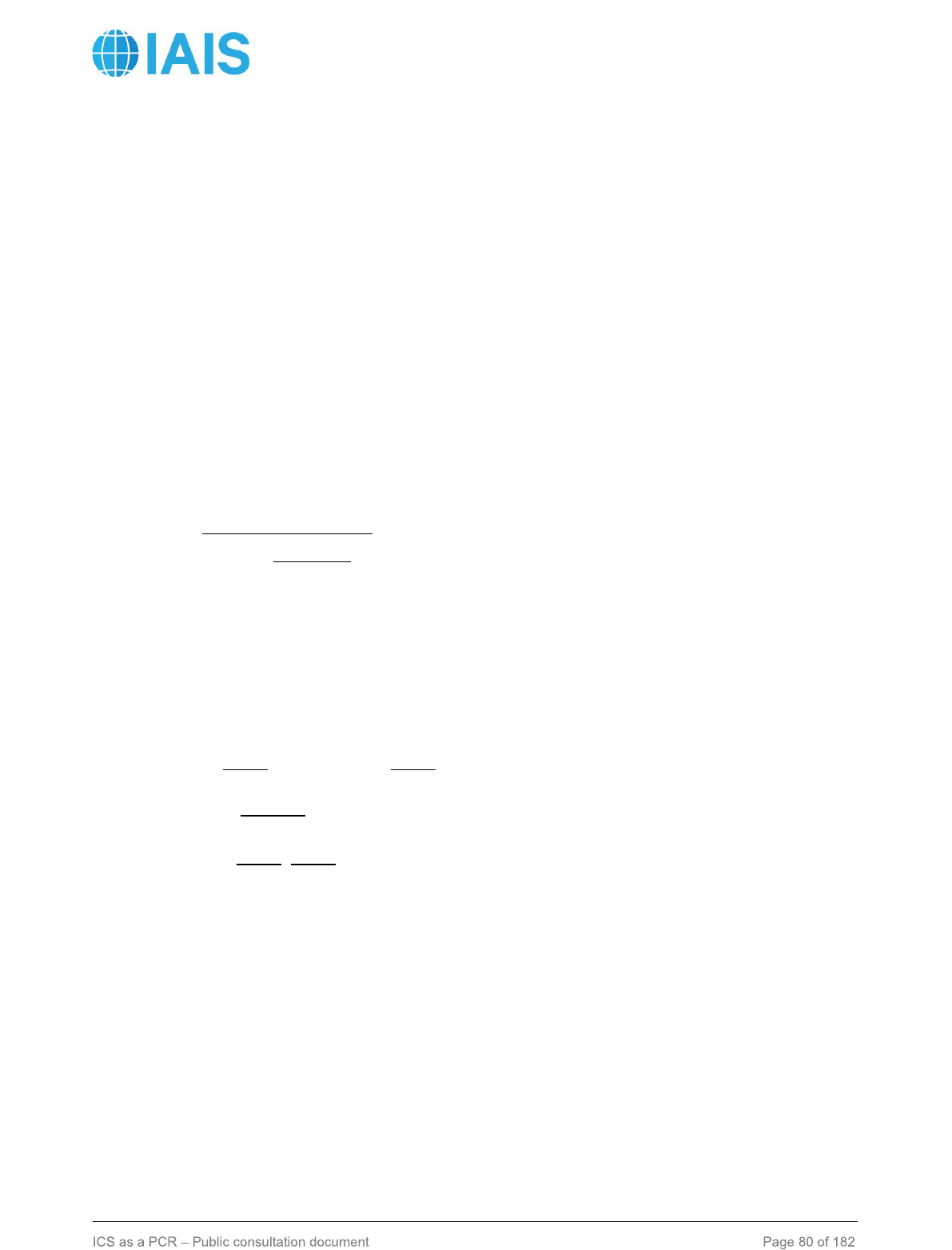
Public
•
, where
,
and
correspond to the Nelson Siegel parameters
26
for the risk-
free yield curve at time ; and
•
is a 3-dimensional Wiener process and is a lower triangular matrix of real non-negative
factors.
L2-211. For the mean reversion scenario, the value of the LTFR remains unchanged.
L2-212. For each currency, the stressed yield curve for the level up scenario is obtained by adding
the following yield curve to the initial yield curve, up to the LOT:
where:
•
;
•
, with and
denoting the parameters of the equation
described in paragraph L2-210, and the Hadamard product operator;
•
and
are the eigenvectors associated with the highest and second highest eigenvalues,
respectively, of the matrix
;
•
;
•
and
;
•
;
•
, ; and
•
L2-213. For the level up scenario, the LTFR is increased by 10%.
L2-214. For each currency, the stressed yield curve for the level down scenario is obtained by
adding the following yield curve to the initial yield curve, up to the LOT:
L2-215. For the level down scenario, the LTFR is decreased by 10%.
L2-216. For each currency, the stressed yield curve for the twist up-to-down scenario is obtained by
adding the following yield curve to the initial yield curve, up to the LOT:
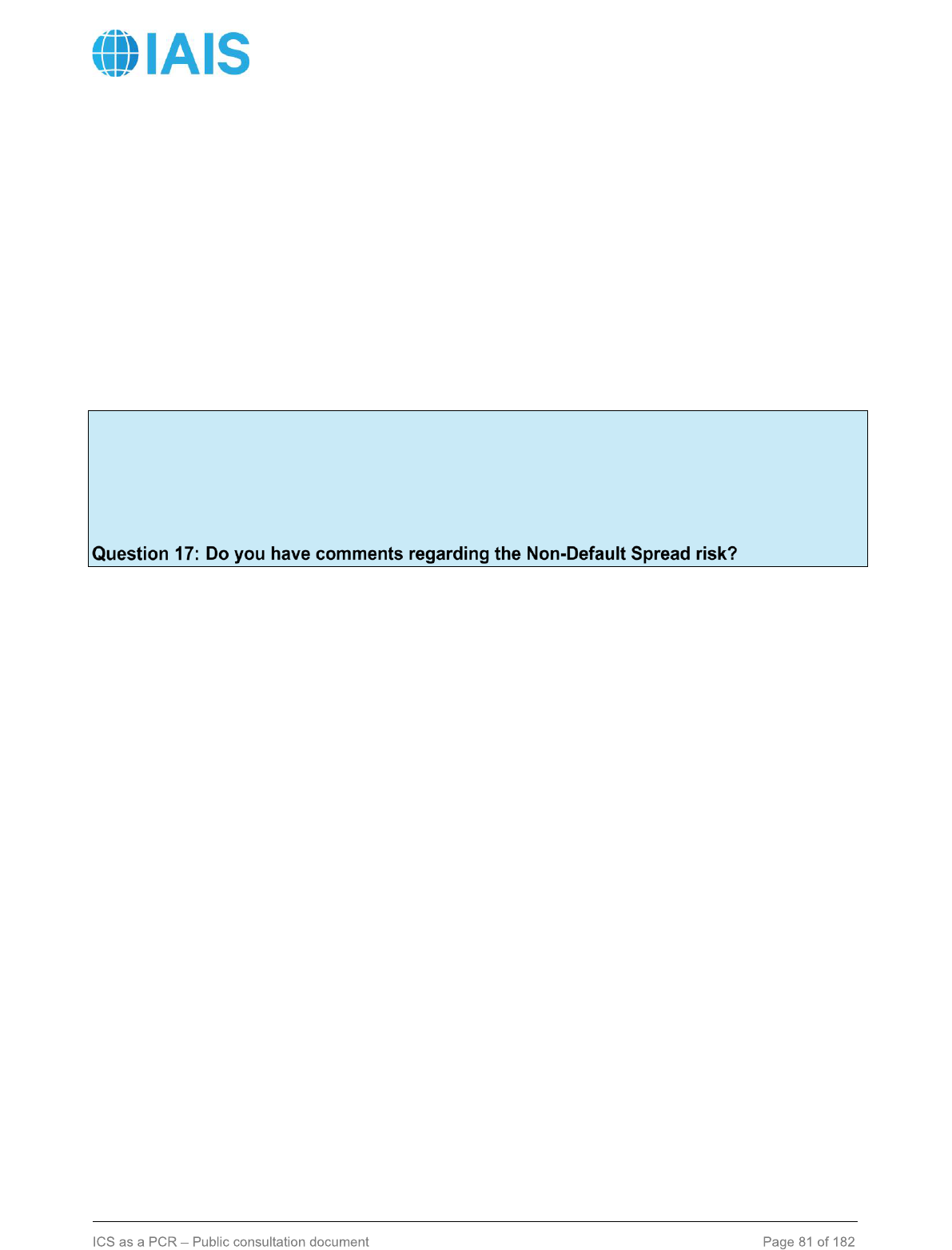
Public
where:
L2-217. For each currency, the stressed yield curve for the twist down-to-up scenario is obtained by
adding the following yield curve to the initial yield curve, up to the LOT:
L2-218. For the twist scenarios, the LTFR remains unchanged.
7.3.3 Non-Default Spread risk
Changes compared to ICS Version 2.0:
The Non-Default Spread risk was adjusted to a relative bi-directional stress to reflect the dynamics
of the term-structure approach introduced for Market Adjusted Valuation. The new relative stress
has been set to 75%.
L1-117. Non-Default Spread risk (NDSR) is calculated as a relative bi-directional stress applied to
both assets and liabilities. The Non-Default Spread risk charge is calculated as the maximum of an
upward and downward stress, subject to a floor of zero.
L1-118. The characteristics of the stresses to apply, as well as the rules governing the identification
of those assets and liabilities to which the stress applies, are specified in the Level 2 text.
L2-219. All liabilities sensitive to changes in spreads are taken into account in the calculation of the
NDSR charge, with the exception of financial instruments issued by the IAIG that qualify as capital
resources.
L2-220. All assets that contribute to the calculation of the spread adjustments for valuation purposes
(Table 3 in section 5.2.5.3.2.1), are taken into account in the calculation of the NDSR charge, with
the exception of sovereign assets.
L2-221. For insurance liabilities, the stresses are applied to spreads after risk correction. The
prescribed stresses are applied shifts to the spreads by risk category and by each time period (t)
used to compute the adjustments specified in section 5.2.5 for valuation purposes. This means the
resulting adjustment applied to the insurance liabilities takes into account the application ratio, the
portfolio allocation and the modulation factor. The portfolio allocation is based on the portfolio
backing the liabilities or the representative portfolio for the middle bucket or the general bucket
respectively.
L2-222. The upward and downward stresses used for the calculation of the NDSR charge are a
relative stress of -75% for the down and +75% of spreads at each maturity up to the LOT.
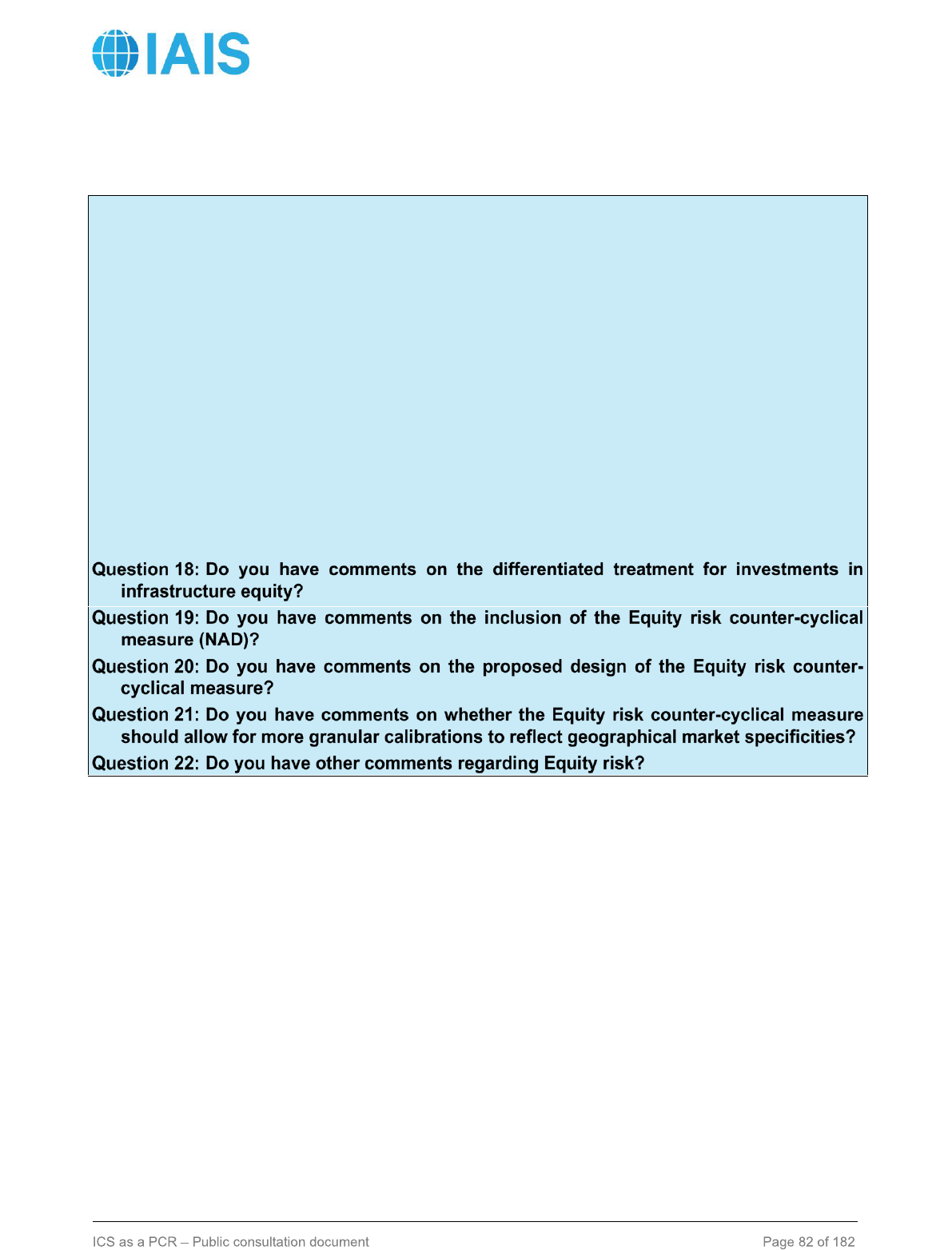
Public
7.3.4 Equity risk
Changes compared to ICS Version 2.0:
Infrastructure equity
Based on a review of existing prudential frameworks, as well as quantitative evidence, a
differentiated treatment has been introduced for investments in infrastructure equity that meet certain
conditions. New sub-segments for investments in infrastructure equity within the developed and
emerging markets segments have been set, with a specific calibration. Definitions and criteria have
also been developed to identify assets eligible to the infrastructure sub-segments.
Countercyclical measure
A countercyclical measure (Neutral Adjusted Dampener, or NAD) has been included in the Equity
risk charge, reducing it when equity markets perform below expectations and increasing when they
perform above expectations. The objective of such a measure is to counteract the effects of equity
market changes on IAIGs, thereby reducing the risk of procyclical investment behaviour of IAIGs
(fire sales). A countercyclical measure is viewed as a macro-economic tool, as it is meant to reduce
systemic risk.
L1-119. The Equity risk charge is calculated as the change in net asset value following the
occurrence of stress scenarios that impact the level and volatility of the fair value of equities, after
management actions. The level scenarios are specified by segments of assets. A volatility scenario
is measured separately. The stress scenario is defined in the Level 2 text.
L1-120. The Equity risk charge applies to direct and indirect exposures to all assets and liabilities
with values sensitive to changes in the level or volatility of the fair value of equities as specified in
the Level 2 text.
L1-121. The Equity risk charge uses the following segmentation of assets as defined in the Level 2
text:
• Equity in developed markets, split between:
o Listed equity (other than infrastructure); and
o Infrastructure equity;
• Equity in emerging markets, split between:
o Listed equity (other than infrastructure); and
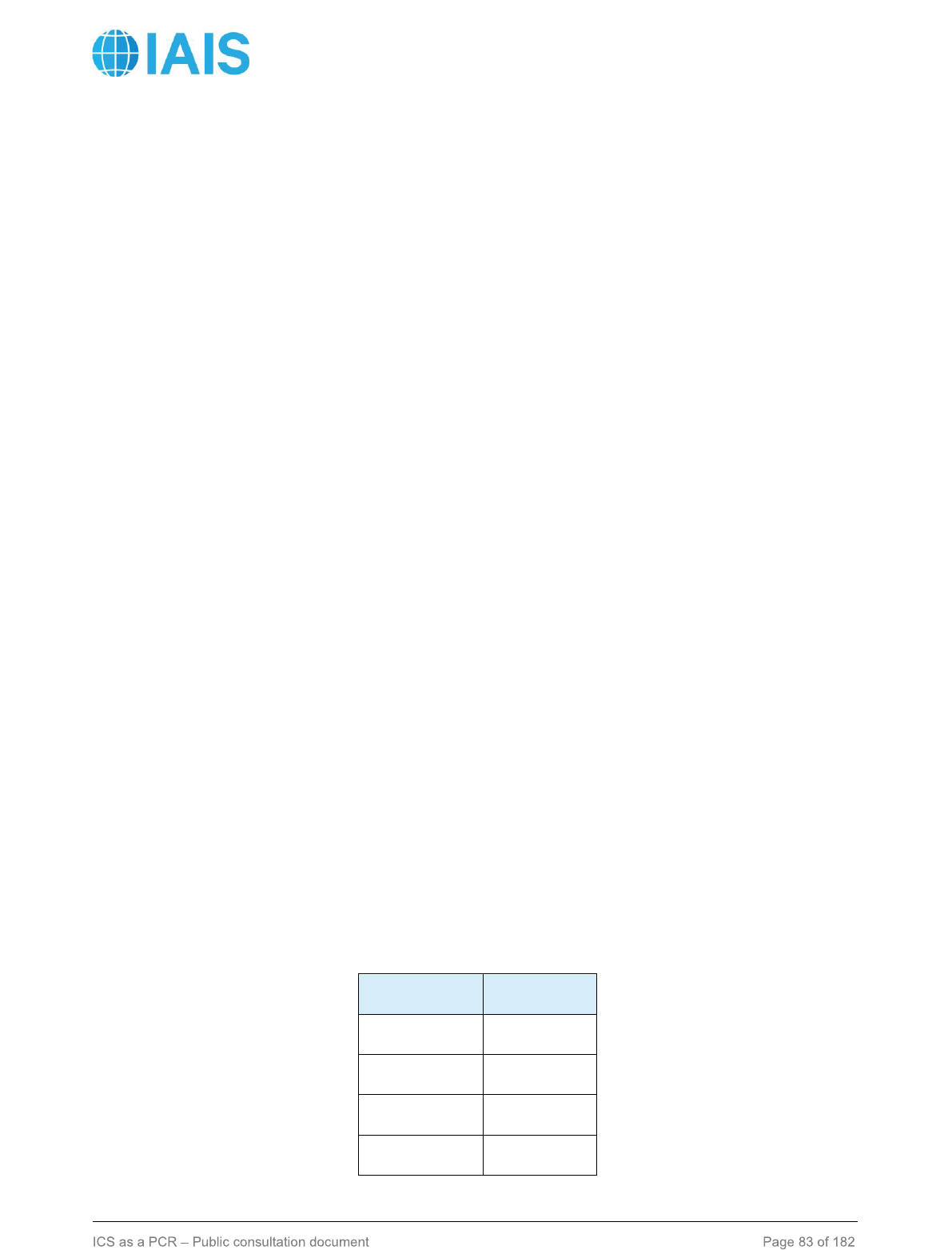
Public
o Infrastructure equity;
• Hybrid debt/preference shares; and
• Other equity.
L2-223. The following definitions apply to the equity segments listed in the ICS Level 1 text.
L2-224. Listed equity in developed markets includes equities listed on the securities exchanges of
equity markets included in the FTSE Developed Index: Australia, Austria, Belgium, Canada,
Denmark, Finland, France, Germany, Hong Kong SAR, Ireland, Israel, Italy, Japan, Luxembourg,
Netherlands, New Zealand, Norway, Poland, Portugal, Singapore, South Korea, Spain, Sweden,
Switzerland, UK, and US.
L2-225. Any equity market not included in the FTSE Developed Index is considered an emerging
market.
L2-226. Infrastructure equity is comprised of equity assets that meet the definitions and criteria
specified in sections 1 and 2 of Annex 3.
L2-227. Investments in subordinated debt are included in the Equity risk charge within the segment
hybrid debt/preference shares.
L2-228. The segment other equity is comprised of all investments not included in the previous equity
segments.
L2-229. The four level scenarios (one for each asset segment) and volatility scenario are defined
as:
a. An instantaneous decrease by 35%, before applying the Neutral Adjusted Dampener (NAD),
of the market prices of listed shares in developed markets, other than infrastructure equity,
and by 27% of the market prices of infrastructure equity in developed markets. The impact of
the decrease in value of listed equity and infrastructure equity is aggregated using a linear
correlation factor of 1.
b. An instantaneous decrease by 48%, before applying NAD, of the market prices of listed
shares in emerging markets, other than infrastructure equity, and by 37% of the market prices
of infrastructure equity in emerging markets. The impact of the decrease in value of listed
equity and infrastructure equity is aggregated using a linear correlation factor of 0.75.
c. An instantaneous decrease of the market prices of hybrid debt/preference shares by x%, with
x based on the ICS rating category (RC) of the asset, as specified in Table 18.
Table 18: Stress factors for hybrid debt/preference shares
ICS RC
x%
1-2
4%
3
6%
4
11%
5
21%
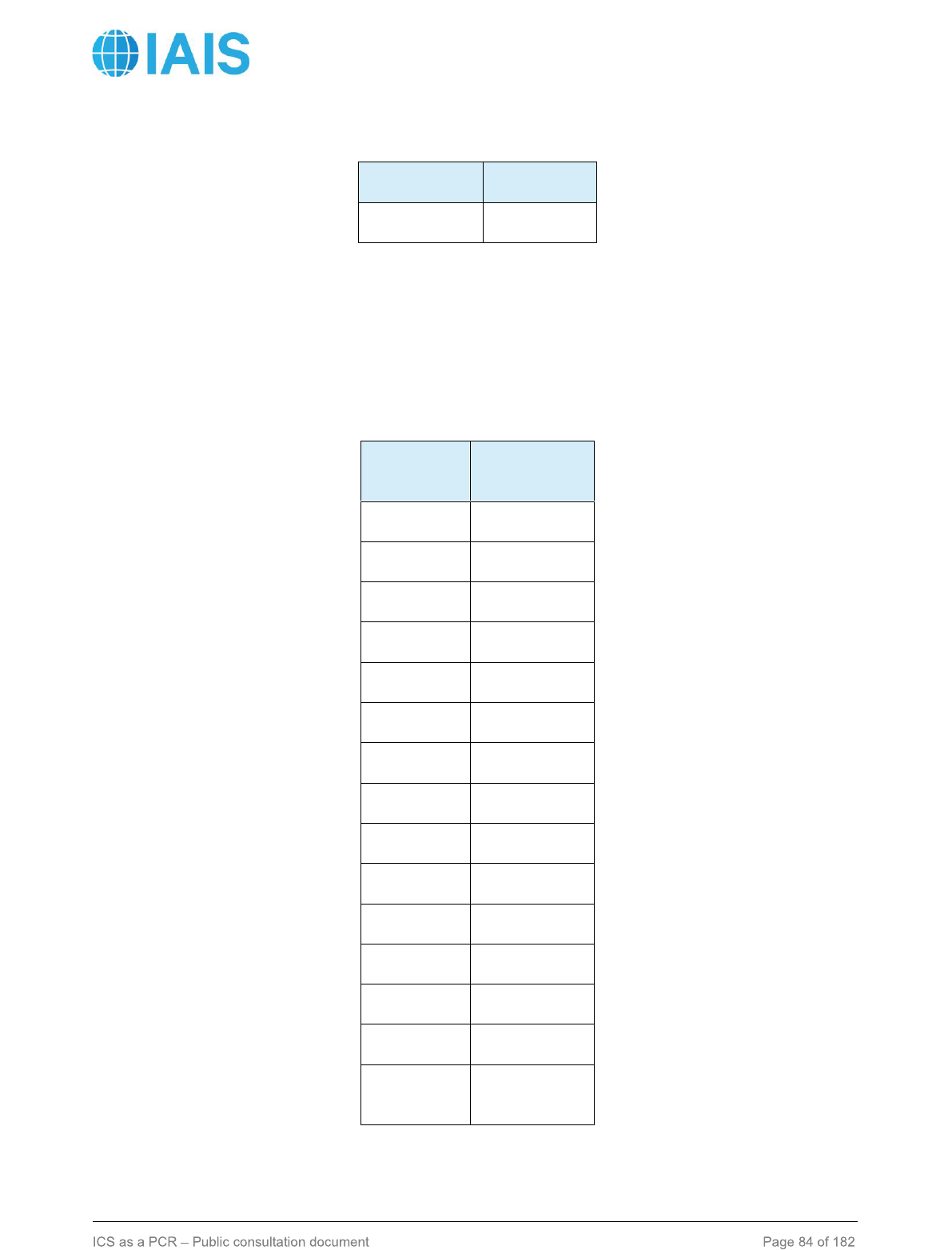
Public
ICS RC
x%
6-7
35%
d. An instantaneous decrease by 49%, before applying NAD, of the market prices of all assets
classified as other equity, as defined in paragraph L2-228.
e. An instantaneous absolute increase by x% of the implied volatilities of all the asset classes
listed above, with x having the values provided in Table 19. For maturities not specified, the
increase is interpolated linearly.
Table 19: Absolute stress factors for implied volatilities
Maturity
(months)
x%
0-1
42%
3
28%
6
23%
12
20%
24
17%
36
16%
48
15%
60
14%
84
14%
120
12%
144
11%
180
10%
240
7%
300
4%
360 and
above
0%
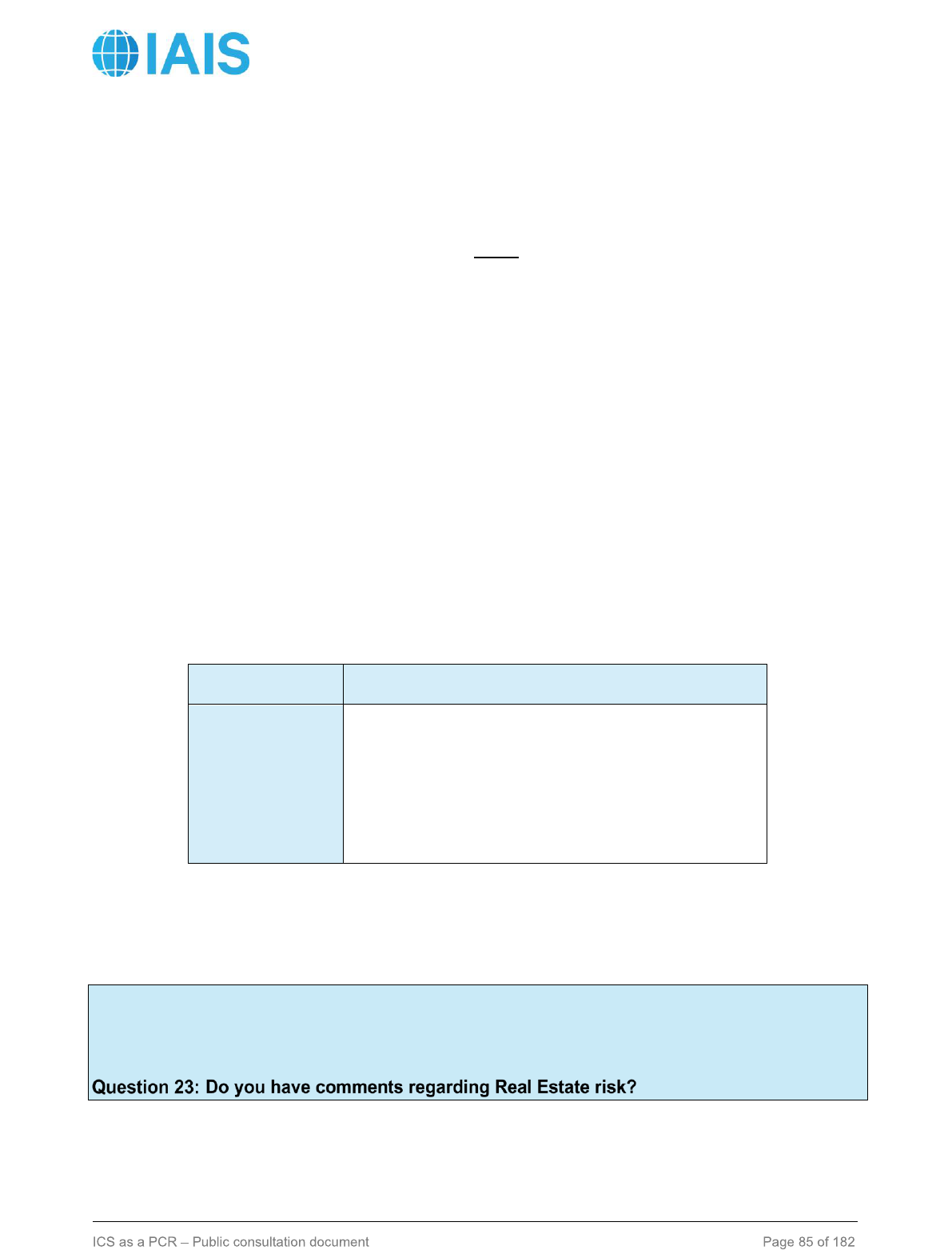
Public
L2-230. NAD is an additive component that behaves in a counter-cyclical manner. The NAD ranges
from -10% to +10% and is applied on the developed markets, emerging markets, and other equity
asset segments. NAD is computed using the following formula:
, where:
• CIi = Current Index value for category i
• AIi = 3 years moving average index for category i
• a = 50% - This parameter has the impact of dampening the NAD to prevent the impact from
being a simple binomial adjustment (either +c% or -c%)
• b = 7% - This parameter prevents the NAD from always being positive and increasing in a
rising market, even when there is a moderate to normal increase.
• c = 10% - This parameter provides a corridor to limit the impact of the NAD for both good and
bad market conditions.
L2-231. The results of the stresses listed above are aggregated in two steps:
a. Step 1: The total level risk is calculated by aggregating the impact of the stress for each level
scenario, floored at zero, using the following correlation matrix:
Table 20: Equity correlation matrix
Equity segment
Developed
Emerging
Hybrid/preferred
Other
Developed
100%
75%
100%
75%
Emerging
75%
100%
75%
75%
Hybrid/preferred
100%
75%
100%
75%
Other
75%
75%
75%
100%
b. Step 2: The total Equity risk charge is calculated by summing the total level risk (from Step
1) and the impact of the stress under the volatility scenario.
7.3.5 Real Estate risk
Changes compared to ICS Version 2.0:
This section has not incurred any change compared to ICS Version 2.0 for the monitoring period.
L1-122. The Real Estate risk charge is calculated as the change in the net asset value, following
the occurrence of a prescribed stress scenario, based on a change in the level of real estate prices,
after management actions, as specified in the Level 2 text.
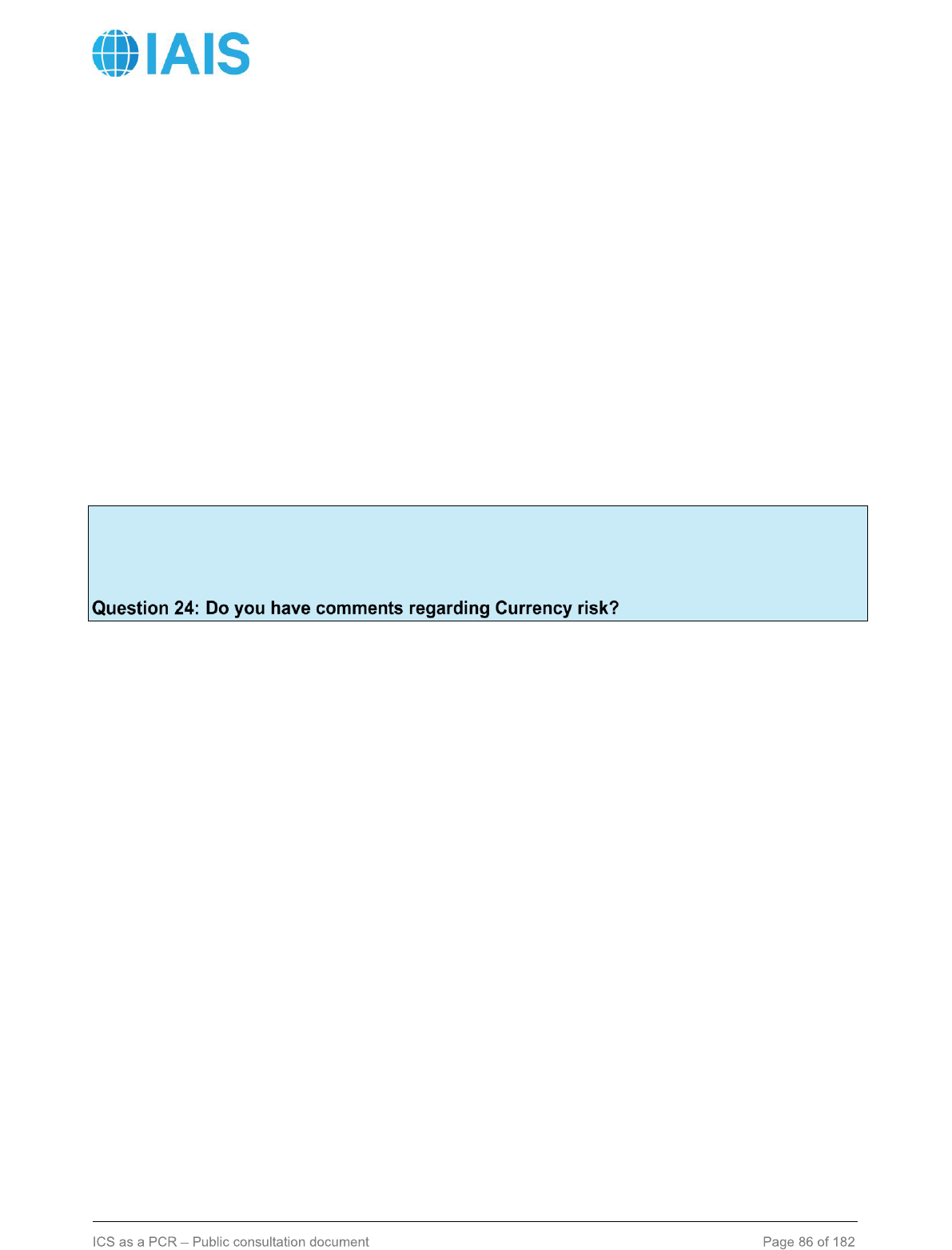
Public
L1-123. The Real Estate risk stress scenario is applied to both direct and indirect exposures to real
estate prices, without distinguishing between commercial, residential and real estate for own use
(see section 3.3 on Look-Through), as specified in the Level 2 text.
L2-232. The stress scenario referred to in the ICS Level 1 text is a decrease of 25% in real estate
prices. Assets and liabilities subject to the stress are:
a. Commercial investment real estate;
b. Residential investment real estate;
c. Real estate for own use;
d. Other assets whose value is impacted by a change in real estate prices; and
e. Liabilities, both insurance and other, whose value is impacted by a change in real estate
prices.
7.3.6 Currency risk
Changes compared to ICS Version 2.0:
This section has not incurred any change compared to ICS Version 2.0 for the monitoring period.
L1-124. The Currency risk charge is equal to the higher of the aggregated losses incurred under two
stress scenarios on the exchange rates between the IAIG’s reporting currency and those currencies
in which the IAIG holds assets or liabilities. The prescribed stresses are applied to the net open
position determined for each relevant currency.
L1-125. The net open position in a currency takes into account all direct and indirect exposures to
that currency. Where relevant, an amount corresponding to jurisdictional capital requirements in that
currency, subject to a cap, may be deducted from the net open position.
L1-126. The two stress scenarios are:
a) Scenario 1: All of the currencies in which the IAIG has a net long position decrease in value
against the reporting currency, while all of the currencies in which the IAIG has a net short
position remain unchanged; or
b) Scenario 2: All of the currencies in which the IAIG has a net short position increase in value
against the reporting currency, while all of the currencies in which the IAIG has a net long
position remain unchanged.
L1-127. Within each scenario, the losses by currency are aggregated using a correlation formula,
as described in the Level 2 text.
L1-128. The prescribed stresses for each currency pair, the aggregation formula, as well as the
rules applicable to the determination of net open positions, are specified in the Level 2 text.
L2-233. In order to determine the Currency risk charge, the IAIG determines its net open position
for all currencies other than the reporting currency. The net open position for each currency is
calculated as the sum of the following:

Public
a. The net spot position, defined as all assets less liabilities, including accrued interest and
accrued expenses;
b. The net forward position, defined as all net amounts under forward foreign exchange
transactions, including currency futures and the interest and principal on currency swaps;
c. The delta equivalent amounts of currency options;
d. Guarantees and similar instruments that are certain to be exercised and are likely to be
irrevocable;
e. At the discretion of the IAIG, net future income and expenses not yet accrued but already
fully hedged;
f. Any other item representing a profit or loss in the foreign currency;
g. Minus the amount of capital required locally to support the activities in the foreign currency,
subject to a cap of 10% of net insurance liabilities in that currency.
L2-234. The deduction referred to in point g) of paragraph L2-233 is applied to long positions only
and does not change any long position to a short position. This deduction applies only if the IAIG
has operations in the jurisdiction of the foreign currency.
L2-235. The net open currency position excludes assets that are fully deducted from capital
resources, and liabilities that qualify for inclusion in consolidated capital resources.
L2-236. The net insurance liability reported for each currency consists of the current estimate net of
any reinsurance assets, plus all deferred tax assets and liabilities associated with the current
estimate and reinsurance assets.
L2-237. Forward currency positions are valued at spot market exchange rates as at the reporting
date.
L2-238. The Currency risk charge is equal to the higher of the aggregated losses incurred under the
following two scenarios:
a. Scenario 1: all currencies in which the IAIG has a net long position decrease in value, while
all of the currencies in which the IAIG has a net short position remain unchanged. The amount
of the decrease of each foreign currency relative to the reporting currency is found in the
currency stress matrix in Table 21 below.
b. Scenario 2: all currencies in which the IAIG has a net short position increase in value, while
all of the currencies in which the IAIG has a net long position remain unchanged. The amount
of the increase of each foreign currency relative to the reporting currency is found in the
currency stress matrix in Table 21 below.
L2-239. For each scenario, the losses by currency are aggregated using a correlation formula for
which the assumed correlation of losses between each pair of foreign currencies is 50%.

Public
Table 21: Currency risk stress factors
Against
Ref
Curr
AUD
BRL
CAD
CHF
CLP
CNY
COP
CZK
DKK
EUR
GBP
HKD
AUD
0%
50%
25%
40%
35%
40%
40%
35%
35%
35%
35%
40%
BRL
50%
0%
50%
65%
50%
55%
55%
60%
60%
60%
55%
55%
CAD
25%
50%
0%
35%
30%
25%
35%
35%
30%
30%
30%
25%
CHF
40%
60%
35%
0%
45%
30%
45%
25%
20%
20%
30%
35%
CLP
35%
50%
30%
45%
0%
30%
40%
40%
40%
40%
35%
30%
CNY
35%
55%
25%
35%
30%
0%
35%
35%
30%
30%
25%
5%
COP
40%
55%
35%
50%
40%
35%
0%
45%
45%
45%
40%
35%
CZK
35%
55%
35%
30%
40%
35%
45%
0%
15%
15%
30%
35%
DKK
35%
55%
30%
20%
35%
30%
40%
15%
0%
5%
25%
30%
EUR
35%
55%
30%
20%
35%
30%
40%
15%
5%
0%
25%
30%
GBP
35%
55%
30%
30%
35%
25%
40%
30%
25%
25%
0%
25%
HKD
35%
55%
25%
35%
30%
5%
35%
35%
30%
30%
25%
0%
HUF
40%
60%
40%
35%
45%
45%
50%
25%
25%
25%
35%
45%
IDR
45%
60%
40%
50%
45%
35%
45%
50%
45%
45%
45%
35%
ILS
35%
55%
30%
35%
35%
25%
35%
35%
30%
30%
30%
25%
INR
35%
50%
25%
35%
30%
20%
35%
35%
30%
30%
30%
15%
JPY
50%
65%
40%
35%
45%
30%
50%
45%
35%
35%
40%
30%
KRW
30%
50%
25%
40%
30%
25%
35%
35%
35%
35%
30%
25%
MXN
35%
50%
30%
45%
35%
30%
35%
40%
40%
40%
40%
30%
MYR
35%
50%
25%
35%
30%
15%
30%
35%
30%
30%
25%
15%
NOK
35%
55%
30%
30%
40%
35%
40%
25%
20%
20%
30%
35%
NZD
20%
55%
30%
40%
40%
40%
45%
40%
35%
35%
35%
40%
PEN
35%
50%
25%
35%
30%
15%
30%
35%
30%
30%
30%
15%
PHP
35%
50%
25%
35%
30%
15%
35%
35%
30%
30%
30%
15%
PLN
35%
55%
35%
40%
40%
40%
45%
25%
25%
25%
35%
40%
RON
35%
50%
35%
30%
40%
30%
45%
25%
20%
20%
30%
30%
RUB
45%
60%
40%
50%
40%
35%
45%
45%
40%
40%
45%
35%
SAR
40%
55%
25%
35%
30%
5%
35%
35%
30%
30%
25%
5%
SEK
35%
55%
30%
30%
40%
35%
45%
25%
20%
20%
30%
35%
SGD
30%
50%
20%
30%
30%
15%
30%
30%
25%
25%
25%
15%
THB
35%
55%
30%
35%
30%
20%
35%
35%
30%
30%
30%
20%
TRY
70%
75%
70%
75%
70%
70%
75%
70%
70%
70%
70%
70%
TWD
35%
50%
25%
30%
30%
10%
35%
35%
25%
25%
25%
10%
USD
40%
55%
25%
35%
30%
5%
35%
35%
30%
30%
25%
5%
ZAR
45%
60%
45%
55%
50%
55%
55%
50%
50%
50%
50%
55%
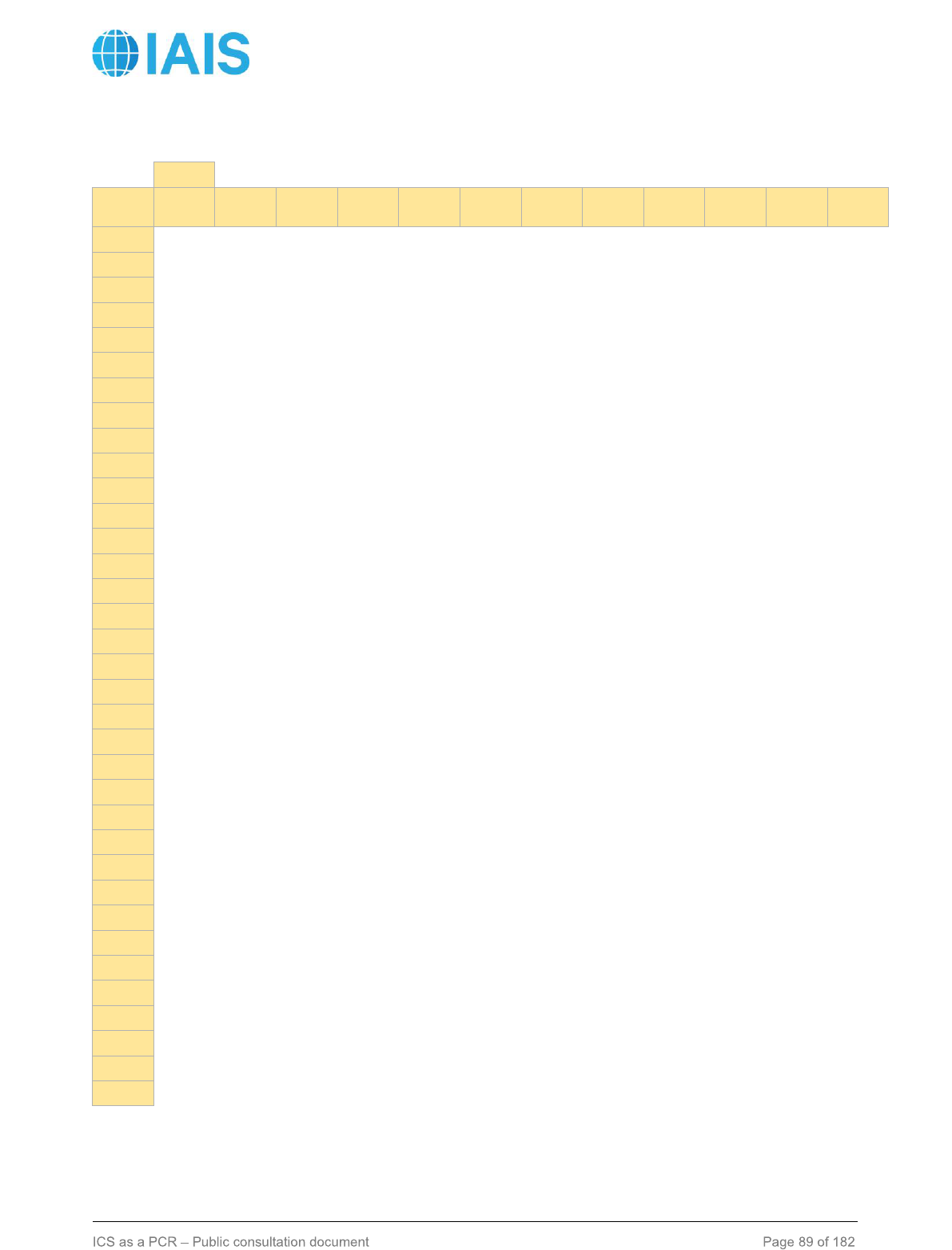
Public
Against
Ref
Curr
HUF
IDR
ILS
INR
JPY
KRW
MXN
MYR
NOK
NZD
PEN
PHP
AUD
40%
45%
35%
35%
50%
30%
35%
35%
35%
20%
40%
35%
BRL
60%
60%
55%
55%
70%
50%
50%
50%
55%
55%
55%
55%
CAD
40%
40%
30%
25%
40%
25%
30%
25%
30%
30%
25%
25%
CHF
35%
50%
35%
35%
35%
40%
45%
35%
25%
40%
35%
35%
CLP
45%
45%
35%
30%
45%
30%
35%
30%
40%
40%
30%
30%
CNY
45%
35%
25%
15%
30%
25%
30%
15%
35%
40%
15%
15%
COP
50%
45%
35%
35%
50%
35%
35%
30%
40%
45%
35%
35%
CZK
25%
50%
35%
35%
45%
35%
40%
35%
25%
40%
35%
35%
DKK
25%
45%
30%
30%
35%
30%
40%
30%
20%
35%
30%
30%
EUR
25%
45%
30%
30%
35%
35%
40%
30%
20%
35%
30%
30%
GBP
35%
45%
30%
30%
40%
30%
35%
25%
30%
35%
30%
30%
HKD
45%
35%
25%
15%
30%
25%
30%
15%
35%
40%
15%
15%
HUF
0%
55%
40%
40%
55%
40%
45%
40%
30%
40%
45%
45%
IDR
55%
0%
40%
35%
50%
40%
45%
35%
45%
50%
35%
35%
ILS
40%
40%
0%
25%
40%
30%
30%
25%
35%
40%
25%
25%
INR
40%
35%
25%
0%
35%
25%
30%
20%
35%
35%
20%
20%
JPY
50%
50%
40%
35%
0%
40%
50%
35%
40%
50%
35%
35%
KRW
40%
40%
30%
25%
40%
0%
30%
25%
35%
35%
25%
25%
MXN
45%
45%
35%
30%
50%
30%
0%
25%
40%
40%
30%
30%
MYR
40%
35%
25%
20%
35%
25%
25%
0%
30%
35%
20%
20%
NOK
30%
45%
35%
35%
40%
35%
40%
30%
0%
35%
35%
35%
NZD
40%
50%
40%
35%
50%
35%
40%
35%
35%
0%
40%
40%
PEN
45%
35%
25%
20%
35%
25%
30%
20%
35%
40%
0%
20%
PHP
40%
35%
25%
20%
35%
25%
30%
20%
35%
35%
20%
0%
PLN
25%
50%
40%
40%
55%
35%
40%
40%
30%
40%
40%
40%
RON
30%
45%
30%
30%
40%
35%
40%
30%
30%
40%
35%
35%
RUB
50%
50%
40%
35%
50%
40%
40%
35%
40%
50%
35%
40%
SAR
45%
35%
25%
15%
30%
25%
30%
15%
35%
40%
15%
15%
SEK
25%
45%
35%
35%
45%
35%
40%
30%
20%
35%
35%
35%
SGD
35%
35%
20%
15%
30%
20%
30%
15%
25%
30%
15%
15%
THB
40%
35%
25%
20%
35%
25%
35%
20%
35%
35%
20%
20%
TRY
70%
75%
70%
70%
75%
70%
70%
70%
70%
70%
70%
70%
TWD
40%
35%
25%
15%
30%
20%
30%
15%
30%
35%
15%
15%
USD
45%
35%
25%
15%
30%
25%
30%
15%
35%
40%
15%
15%
ZAR
50%
60%
50%
50%
65%
45%
50%
45%
45%
50%
50%
50%

Public
Against
Ref Curr
PLN
RON
RUB
SAR
SEK
SGD
THB
TRY
TWD
USD
ZAR
AUD
35%
40%
45%
40%
35%
30%
35%
55%
35%
40%
45%
BRL
55%
50%
60%
55%
55%
50%
55%
70%
55%
55%
65%
CAD
35%
30%
40%
25%
30%
20%
30%
55%
25%
25%
45%
CHF
35%
30%
45%
35%
30%
25%
35%
65%
30%
35%
55%
CLP
40%
40%
40%
30%
40%
30%
35%
60%
30%
30%
50%
CNY
40%
30%
35%
5%
35%
15%
20%
60%
10%
5%
50%
COP
45%
45%
45%
35%
45%
35%
35%
60%
35%
35%
55%
CZK
25%
25%
45%
35%
25%
30%
35%
60%
35%
35%
50%
DKK
25%
20%
40%
30%
20%
25%
30%
60%
25%
30%
50%
EUR
25%
20%
40%
30%
20%
25%
30%
60%
25%
30%
50%
GBP
35%
30%
40%
25%
30%
25%
30%
60%
25%
25%
50%
HKD
40%
30%
35%
5%
35%
15%
20%
60%
10%
5%
55%
HUF
25%
30%
50%
45%
25%
35%
40%
60%
40%
45%
50%
IDR
50%
45%
50%
35%
45%
35%
35%
70%
35%
35%
60%
ILS
35%
30%
40%
25%
35%
20%
25%
55%
25%
25%
50%
INR
40%
30%
35%
15%
35%
15%
20%
55%
15%
15%
50%
JPY
50%
40%
50%
30%
40%
30%
35%
70%
30%
30%
65%
KRW
35%
35%
40%
25%
35%
20%
25%
55%
20%
25%
45%
MXN
40%
40%
40%
30%
40%
30%
35%
60%
30%
30%
50%
MYR
35%
30%
35%
15%
30%
15%
20%
55%
15%
15%
45%
NOK
30%
30%
40%
35%
20%
25%
35%
60%
30%
35%
45%
NZD
40%
40%
50%
40%
35%
30%
35%
60%
35%
40%
50%
PEN
40%
30%
35%
15%
35%
15%
20%
60%
15%
15%
50%
PHP
40%
30%
40%
15%
35%
15%
20%
55%
15%
15%
50%
PLN
0%
30%
45%
40%
30%
35%
40%
55%
40%
40%
50%
RON
30%
0%
40%
30%
25%
25%
35%
60%
30%
30%
50%
RUB
45%
40%
0%
35%
45%
35%
40%
65%
35%
40%
55%
SAR
40%
30%
35%
0%
35%
15%
20%
60%
10%
5%
55%
SEK
30%
25%
45%
35%
0%
30%
35%
60%
30%
35%
50%
SGD
35%
25%
35%
15%
30%
0%
15%
55%
10%
15%
45%
THB
40%
30%
40%
20%
35%
15%
0%
55%
20%
20%
50%
TRY
70%
70%
75%
70%
70%
65%
70%
0%
70%
70%
75%
TWD
35%
30%
35%
10%
30%
10%
20%
55%
0%
10%
50%
USD
40%
30%
35%
5%
35%
15%
20%
60%
10%
0%
55%
ZAR
50%
50%
55%
55%
50%
45%
50%
60%
50%
55%
0%

Public
7.3.7 Asset Concentration risk
Changes compared to ICS Version 2.0:
This section has not incurred any change compared to ICS Version 2.0 for the monitoring period.
L1-129. The Asset Concentration risk charge is an incremental risk charge above the Market and
Credit risk charges, which acknowledges that assets held by the IAIG are not perfectly diversified.
Assets in separate accounts or where the investment risks fully flow-through
27
to policyholders are
excluded from the calculation of the Asset Concentration risk charge.
L1-130. For real estate, a specified factor is applied to assets in excess of specified threshold. The
methodology to calculate the Asset Concentration risk charge is specified in the Level 2 text.
L2-240. The methodology to calculate the Asset Concentration risk charge is specified below.
7.3.7.1 Assets other than real estate
L2-241. For assets other than real estate, the Asset Concentration risk charge is calculated as:
where:
• ;
• ;
•
is the net exposure to group of connected counterparties ;
• is an exposure threshold determined by the IAIG in such a way that the number of groups
of connected counterparties for which
is equal to or greater than 10 but does not
exceed 100;
•
is the Equity risk charge associated with counterparty , before diversification and
management actions;
•
is the Credit risk charge associated with counterparty , before diversification and
management actions;
•
is the total Equity risk charge of the IAIG, before diversification and management actions;
and
•
is the total Credit risk charge of the IAIG, before diversification and management actions.
27
Not considering any guarantee to policyholders that may exist on the value of the overall investment fund(s) such as on variable
annuity products
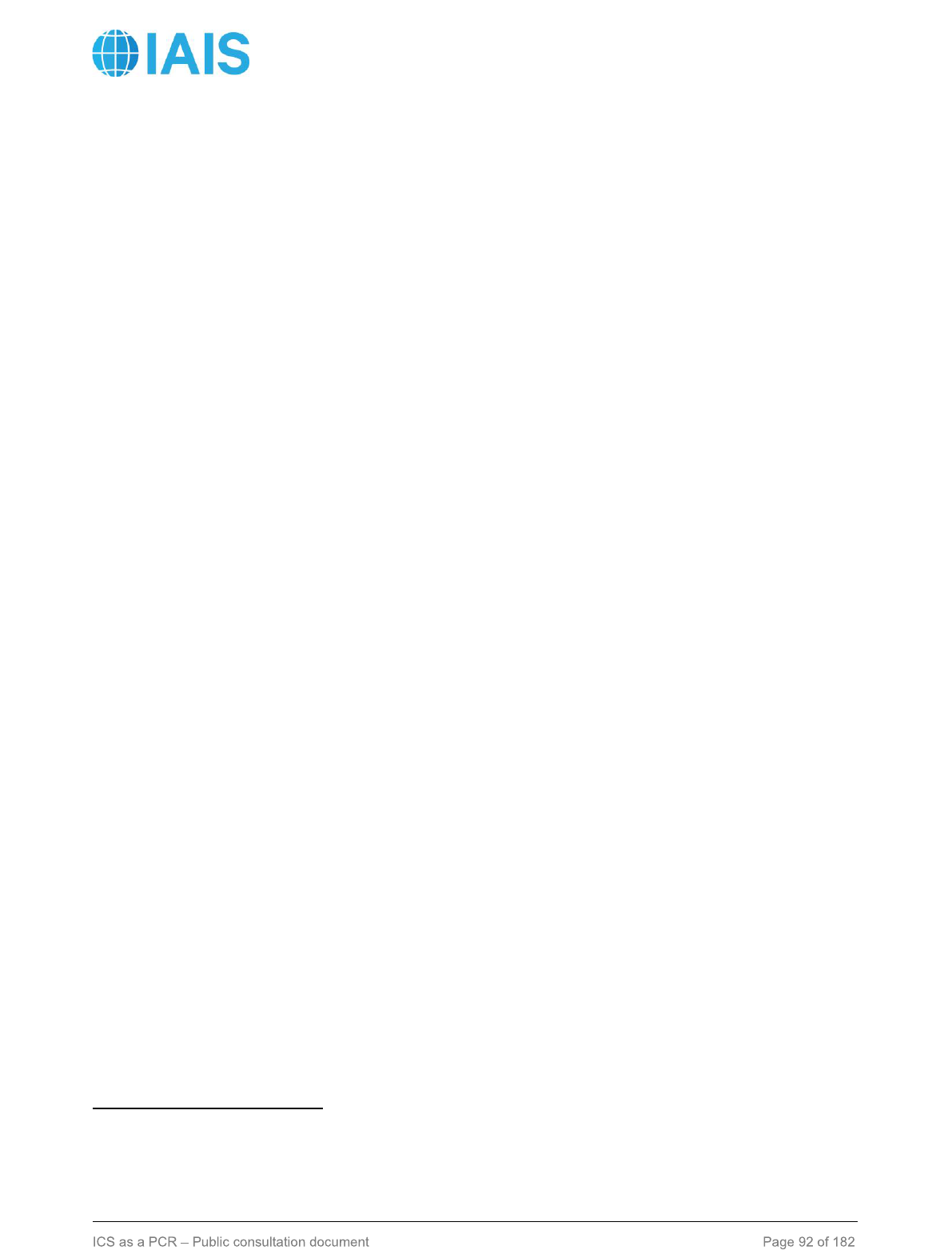
Public
L2-242. Groups of connected counterparties are determined according to the definition provided by
the Basel Committee on Banking Supervision (BCBS)
28
. Specifically, two or more natural or legal
persons are considered a group of connected counterparties if at least one of the following criteria
is satisfied:
a. Control relationship: one of the counterparties, directly or indirectly, has control over the
other(s); or
b. Economic interdependence: if one of the counterparties were to experience financial
problems, the other(s), as a result, would also be likely to encounter financial problems.
L2-243. Exposures to national governments are excluded from the Asset Concentration risk charge
calculation. Public sector exposures, not issued or guaranteed by a national government, such as
provincial, state or municipal debt, are included within the Asset Concentration risk charge
calculation with their corresponding Credit and Equity risk charges.
L2-244. The determination of the gross counterparty exposures includes both on- and off-balance
sheet positions, and considers the following:
a. Exposures to reinsurance counterparties are included on a pre-stress basis
29
;
b. The determination of OTC derivatives exposures is based on a credit-equivalent basis, as
applicable, and exposures to central counterparties are excluded;
c. Exposures are based on a look-through approach for investment funds and structured
products;
d. Non-affiliated (external) guarantees, commitments, bank deposits, receivables and any other
items subject to the possibility of financial loss due to counterparty default are included; and
e. Gross exposures are calculated based upon the MAV basis described in section 5, except
where otherwise specified.
L2-245. The determination of net counterparty exposures considers the following:
a. Exposures from assets held in separate accounts or life insurance contracts where the
investment risks fully flow-through to policyholders are excluded. Nevertheless, assets
backing any guarantees to policyholders are included;
b. Asset exposures may be netted against liability exposures to the extent that they are subject
to a legally enforceable right of offset;
c. For exposures covered by collateral or unconditional and irrevocable guarantees, the
substitution approach specified in sections 7.4.2.1.1 and 7.4.2.2.3 may be used for the
portion of the exposure covered by the collateral or the guarantees. The exposure to the
primary counterparty is then replaced by the exposure to the collateral or guarantor. This
approach should also be used for bank deposits if an explicit guarantee (such as a national
government guarantee) exists. Where national government exposures are substituted for
28
As specified in the BCBS publication Supervisory framework for measuring and controlling large exposures (April 2014), which
also outlines criteria for assessing whether ‘control’ or ‘economic interdependence’ exists.
29
The contingent risk associated with catastrophe scenarios is not included in the exposure.

Public
corporate exposures, the corresponding amounts are excluded from the determination of the
Asset Concentration risk charge, in line with the provisions of paragraph L2-243; and
f. For collateralised non-life reinsurance exposures, the haircut approach specified in section
7.4.2.1.2 is used in lieu of the substitution approach. The exposure to the reinsurer is the
adjusted net exposure calculated in section 7.4 on Credit risk. The collateral received is
excluded from the counterparty exposure. However, the asset concentration risk for the
collateral calculated on a standalone basis is one component of the haircut applied to the
collateral.
7.3.7.2 Real estate
L2-246. In order to calculate the Asset Concentration risk charge for real estate, property exposures
are determined on the basis of single property, or group of properties within a 250 metres radius,
including exposures from both direct and indirect holdings (such as funds of properties).
L2-247. The Asset Concentration risk charge for any property exposure as defined above is
calculated as 25% of the net property exposure exceeding 3% of the IAIG’s total net investment
assets relating to insurance activities. The net property exposures are calculated in line with
paragraphs L2-244 and L2-245.
7.4 Credit risk
Changes compared to ICS Version 2.0:
Based on a review of existing prudential frameworks, as well as quantitative evidence, a
differentiated treatment has been introduced for investments in infrastructure debt that meet certain
conditions. A new exposure class has been set for investments in infrastructure debt, subject to risk
factors that are similar to corporates and reinsurance for rated exposures, but 25% lower than
corporates and reinsurance for unrated exposures. Definitions and criteria have also been developed
to identify exposures that should be considered infrastructure.
The remainder of the credit risk charge methodology is unchanged from ICS Version 2.0. During the
monitoring period, the IAIS collected data relating to Commercial Mortgage Loans (CML), with the
view of undertaking a potential recalibration specific to that exposure class. However, the data
collected proved insufficient both in scope and quality, and therefore the Credit risk treatment of
CMLs has been kept unchanged.
7.4.1 Calculation of the Credit risk charge
L1-131. The Credit risk charge is the determined by applying prescribed stress factors to specified
net exposure amounts. Management actions are taken into consideration in the calculation of the
Credit risk charge.
L1-132. The prescribed stress factors vary by exposure class, rating category and maturity. The
classification of exposures between those categories, as well as the associated stress factors, are
specified in the Level 2 text.
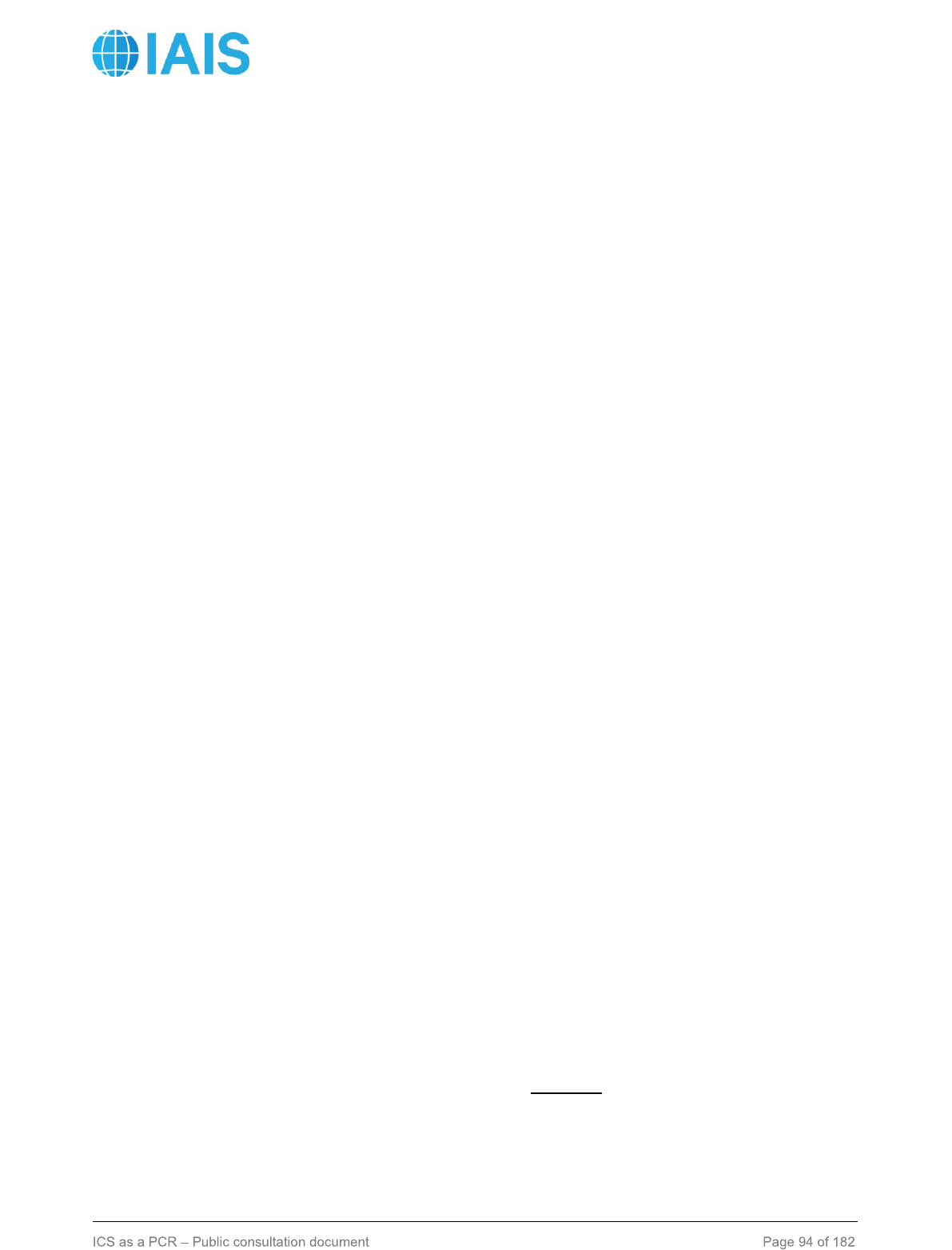
Public
7.4.1.1 Exposure classes
L2-248. The Credit risk charge applies to all senior debt obligations of specified exposure classes
of borrowers. Preferred shares and hybrid obligations, including subordinated debt, are excluded
from the calculation of the Credit risk charge, and are instead subject to the Equity risk charge for
hybrid debt/preference shares described in section 7.3.4.
L2-249. Credit exposures to national governments, multilateral development banks and
supranational organisations are not subject to the Credit risk charge. Regional governments and
municipal authorities and other government entities whose debt is not issued or guaranteed by the
national government, are classified as public sector entities. Exposures to commercial undertakings
owned but not guaranteed by governments or municipal authorities are classified in the corporates
category.
L2-250. The corporates category includes exposures to banks and securities dealers, but excludes
exposures to reinsurers. Rated commercial mortgages are included in the corporate exposure class.
L2-251. The infrastructure category includes debt exposures to infrastructure projects and
corporates that meet definitions and criteria specified in sections 1 and 3 of Annex 1.
L2-252. The securitisation category includes all holdings of mortgage-backed securities and other
asset-backed securities. It also includes any other assets where the cash flow from an underlying
pool of exposures is used to service payments by a SPV to bondholders. If any of the assets in the
pool of exposures underlying a securitisation exposure is itself a securitisation, then the exposure
belongs to the re-securitisation category.
L2-253. The category short-term obligations of regulated banks includes demand deposits and other
obligations that have an original maturity of less than three months, and that are drawn on a bank
subject to the solvency requirements of the Basel Framework. All other bank exposures are included
in the corporates category.
L2-254. Assets that are held for unit-linked business or in separate accounts and for which all credit
risk on the assets fully flows through to policyholders are excluded from the Credit risk charge.
However, the IAIG calculates a Credit risk charge for the increase in related liabilities (eg due to
decreased future fee income) that would result from a credit risk loss on those assets, calculated as
specified in this section.
L2-255. A non-paid-up financial instrument that qualifies for inclusion in capital resources is subject
to the same credit risk charge as a direct credit exposure to the contingent capital provider.
L2-256. The Credit risk charge for off-balance sheet exposures is based on credit equivalent
amounts calculated as specified in section 7.4.1.4.
7.4.1.2 Distribution of exposures by maturity
L2-257. For calculating the Credit risk charge, an effective maturity is calculated as follows for each
credit exposure:
where
denotes the cash flows (principal, interest payments and fees) contractually payable by
the borrower in period .

Public
L2-258. Where it is not possible to calculate the effective maturity of the contracted payments as
noted above, a conservative measure is used, such as the maximum remaining time (in years) that
the borrower is permitted to take to fully discharge its contractual obligation (principal, interest, and
fees) under the terms of the loan agreement.
L2-259. For OTC derivatives subject to a master netting agreement, the maturity is calculated as
the weighted average of the maturities of the transactions subject to netting, with the weights
proportional to the transactions’ notional amounts.
L2-260. All exposures to a group are aggregated and split by rating category before calculating the
effective maturity.
L2-261. When an exposure is redistributed into another rating category due to the presence of an
eligible guarantee or collateral, the effective maturity is calculated based on the term of the
underlying exposure, not the term of the guarantee or collateral.
7.4.1.3 Reinsurance exposures
L2-262. The use of AM Best credit ratings is restricted to the calculation of the Credit risk charge on
reinsurance exposures. The mapping of AM Best insurer financial strength ratings to the ICS ratings
categories is provided in section 3.4.
L2-263. Reinsurance exposures include all positive on-balance sheet reinsurance assets and
receivables. Negative exposures are not included.
L2-264. Reinsurance exposures are considered net of cessions to mandatory insurance pools that
are backed by either a governmental entity or jointly by the insurance market. Cessions to these
mandatory pools are subject to a separate calculation.
L2-265. Reinsurance exposures include all credit recognised in the ICS risk charges due to the
presence of reinsurance.
L2-266. In the case of catastrophe scenarios and life insurance stresses, the impact of the scenarios
and stresses (before management actions) are calculated on a gross and net of reinsurance basis.
The difference between the gross and net of reinsurance basis is then allocated to Credit risk
categories based on the profile of the reinsurers that have provided cover. This calculation is made
at the Catastrophe risk charge and Life insurance risk charge level (ie after diversification of the
components of those risk charges).
L2-267. Modified coinsurance and funds withheld arrangements are subject to a risk charge even if
there is no on-balance sheet reinsurance asset or the reinsurance asset is fully offset by payables.
L2-268. For funds withheld and similar arrangements, the IAIG may treat payables and other
liabilities due to a reinsurer in the same manner as collateral provided that the arrangement meets
the all of the following conditions:
a. The IAIG has executed a written, bilateral netting contract or agreement with the reinsurer
from which the asset is due that creates a single legal obligation. As a result of such an
agreement, the IAIG would have only one obligation for payment or one claim to receive
funds based on the net sum of the liabilities and amounts due in the event the reinsurer failed
to perform due to any of the following: default, bankruptcy, liquidation or similar
circumstances.
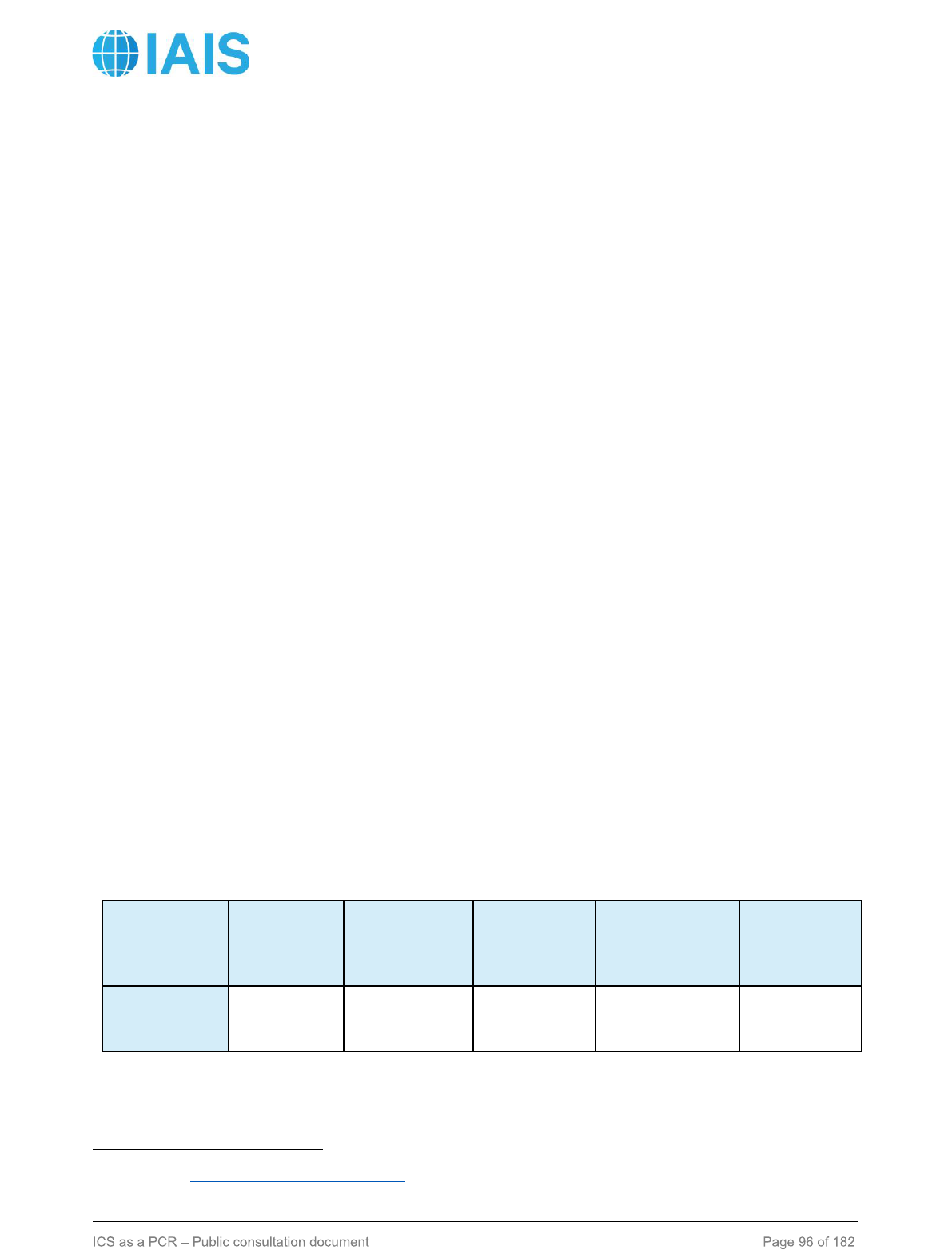
Public
b. The IAIG has a written and reasoned legal opinion that, in the event of any legal challenge,
the relevant courts or administrative authorities would find the amount owed under the netting
agreement to be the net amount under the laws of all relevant jurisdictions. In reaching this
conclusion, the legal opinion must address the validity and enforceability of the entire netting
agreement under its terms.
i. The laws of all relevant jurisdictions are:
• The law of the jurisdiction where the reinsurer is incorporated and, if the
foreign branch of a reinsurer is involved, the laws of the jurisdiction in which
the branch is located;
• The law governing the individual insurance transaction; and
• The law governing any contracts or agreements required to effect the netting
arrangement.
ii. A legal opinion is recognised as such by the legal community in the IAIG’s home
jurisdiction or by a memorandum of law that addresses all relevant issues in a reasoned
manner.
c. The IAIG has procedures in place to update legal opinions as necessary to ensure continuing
enforceability of the netting arrangement in light of possible changes in relevant laws.
7.4.1.4 Off-balance sheet exposures
7.4.1.4.1 Credit equivalent amount for OTC derivatives
L2-269. The credit equivalent amount for OTC derivatives is calculated using the current exposure
method from Annex 4, section VII of the Basel Framework
30
. Under this method, the IAIG calculates
the current replacement cost by summing:
a. The total replacement cost (obtained by marking to market) of all its contracts with positive
value; and
b. An amount for potential future credit exposure calculated on the basis of the total notional
principal amount of its book, split by residual maturity as specified in Table 22.
Table 22: Calculation of potential future credit exposure
Residual
Maturity
Interest
Rate
Exchange
Rate and
Gold
Equity
Precious
Metals Except
Gold
Other
Commoditie
s
One year or
less
0.0%
1.0%
6.0%
7.0%
10.0%
30
Accessible at http://www.bis.org/publ/bcbs128.pdf

Public
Residual
Maturity
Interest
Rate
Exchange
Rate and
Gold
Equity
Precious
Metals Except
Gold
Other
Commoditie
s
Over one
year to five
years
0.5%
5.0%
8.0%
7.0%
12.0%
Over five
years
1.5%
7.5%
10.0%
8.0%
15.0%
L2-270. Credit derivatives are not subject to the current exposure method. Credit protection that is
received is treated according to the provisions for guarantees and credit derivatives (cf section
7.4.2.2), while credit protection that is sold is treated as an off-balance sheet direct credit substitute
subject to a 100% credit conversion factor (cf section 7.4.1.4.2).
L2-271. For contracts with multiple exchanges of principal, the factors are multiplied by the number
of remaining payments in the contract.
L2-272. For contracts that are structured to settle outstanding exposure following specified payment
dates and where the terms are reset so that the market value of the contract is zero on these
specified dates, the residual maturity is considered to be the time until the next reset date. In the
case of interest rate contracts with remaining maturities of more than one year and that meet the
above criteria, the add-on factor is subject to a floor of 0.5%.
L2-273. Contracts not covered by any category in Table 22 are treated as other commodities.
L2-274. No potential credit exposure is calculated for single currency floating/floating interest rate
swaps; the credit exposure on these contracts is evaluated solely on the basis of their mark-to-
market value.
L2-275. The add-ons are based on effective rather than stated notional amounts. Where the stated
notional amount is leveraged or enhanced by the structure of the transaction, the IAIG uses the
actual or effective notional amount when determining potential future exposure.
L2-276. Potential credit exposure is calculated for all OTC contracts (with the exception of single
currency floating/floating interest rate swaps), regardless of whether the replacement cost is positive
or negative.
L2-277. The IAIG may net contracts that are subject to novation
31
or any other legally valid form of
netting provided the following conditions are satisfied.
a. The IAIG has executed a written, bilateral netting contract or agreement with each
counterparty that creates a single legal obligation, covering all included bilateral transactions
subject to netting. The result of such an arrangement is that the IAIG only has one obligation
31
Novation refers to a written bilateral contract between two counterparties under which any obligation to each other to deliver a
given currency on a given date is automatically amalgamated with all other obligations for the same currency and value date,
legally substituting one single amount for the previous gross obligations.
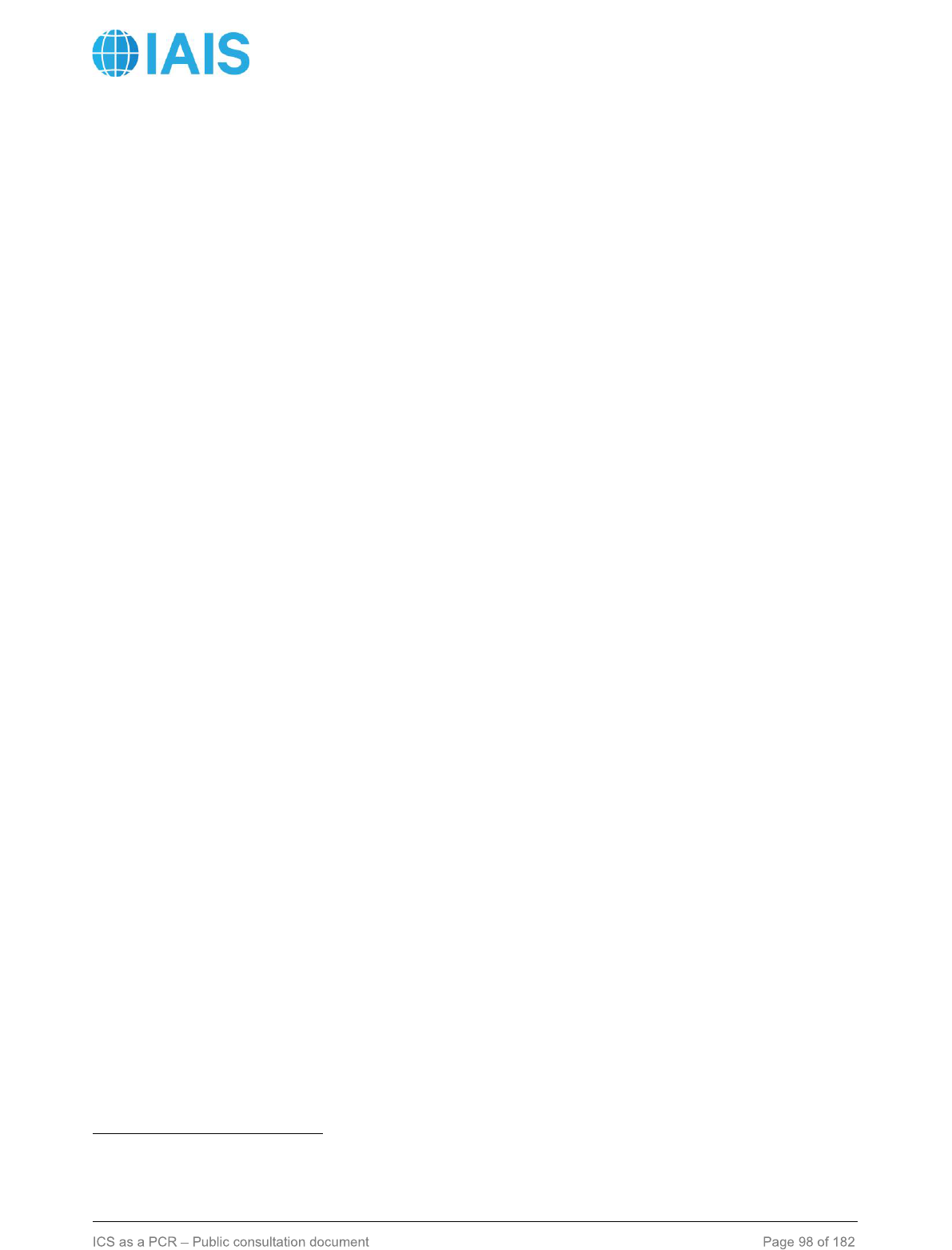
Public
for payment or one claim to receive funds based on the net sum of the positive and negative
mark-to-market values of all the transactions with that counterparty in the event that
counterparty fails to perform due to any of the following: default, bankruptcy, liquidation or
similar circumstances.
b. The IAIG has a written and reasoned legal opinion that, in the event of any legal challenge,
the relevant courts or administrative authorities will find the exposure under the netting
agreement to be the net amount under the laws of all relevant jurisdictions. In reaching this
conclusion, the legal opinion addresses the validity and enforceability of the entire netting
agreement under its terms.
i. The laws of all relevant jurisdictions are:
• The law of the jurisdiction where the counterparties are incorporated and, if
the foreign branch of a counterparty is involved, the laws of the jurisdiction in
which the branch is located;
• The law governing the individual insurance transactions; and
• The law governing any contracts or agreements required to effect the netting
arrangement.
ii. A legal opinion is recognised as such by the legal community in the IAIG’s home
jurisdiction or by a memorandum of law that addresses all relevant issues in a reasoned
manner.
c. The IAIG has internal procedures to verify that, prior to recognising a transaction as being
subject to netting for capital purposes, the transaction is covered by a legal opinion that meets
the above criteria.
d. The IAIG has procedures in place to update legal opinions as necessary to ensure continuing
enforceability of the netting arrangements in light of possible changes in relevant laws.
e. The IAIG maintains all required documentation in its files.
L2-278. Any contract containing a walkaway clause
32
is not eligible to qualify for netting for the
purpose of calculating the Credit risk charge.
L2-279. Credit exposure on bilaterally netted forwards, swaps, purchased options and similar
derivatives transactions is calculated as the sum of the net mark-to-market replacement cost, if
positive, plus an add-on based on the notional principal of the individual underlying contracts.
However, for purposes of calculating potential future credit exposures of contracts subject to legally
enforceable netting agreements in which notional principal is equivalent to cash flows, notional
principal is defined as the net receipts falling due on each value date in each currency.
L2-280. The calculation of the gross add-ons is based on the legal cash flow obligations in all
currencies. This is calculated by netting all receivable and payable amounts in the same currency
for each value date. The netted cash flow obligations is converted to the reporting currency using
the current forward rates for each value date. Once converted the amounts receivable for the value
32
A walkaway clause is a provision within the contract that permits a non-defaulting counterparty to make only limited payments,
or no payments, to the defaulter.
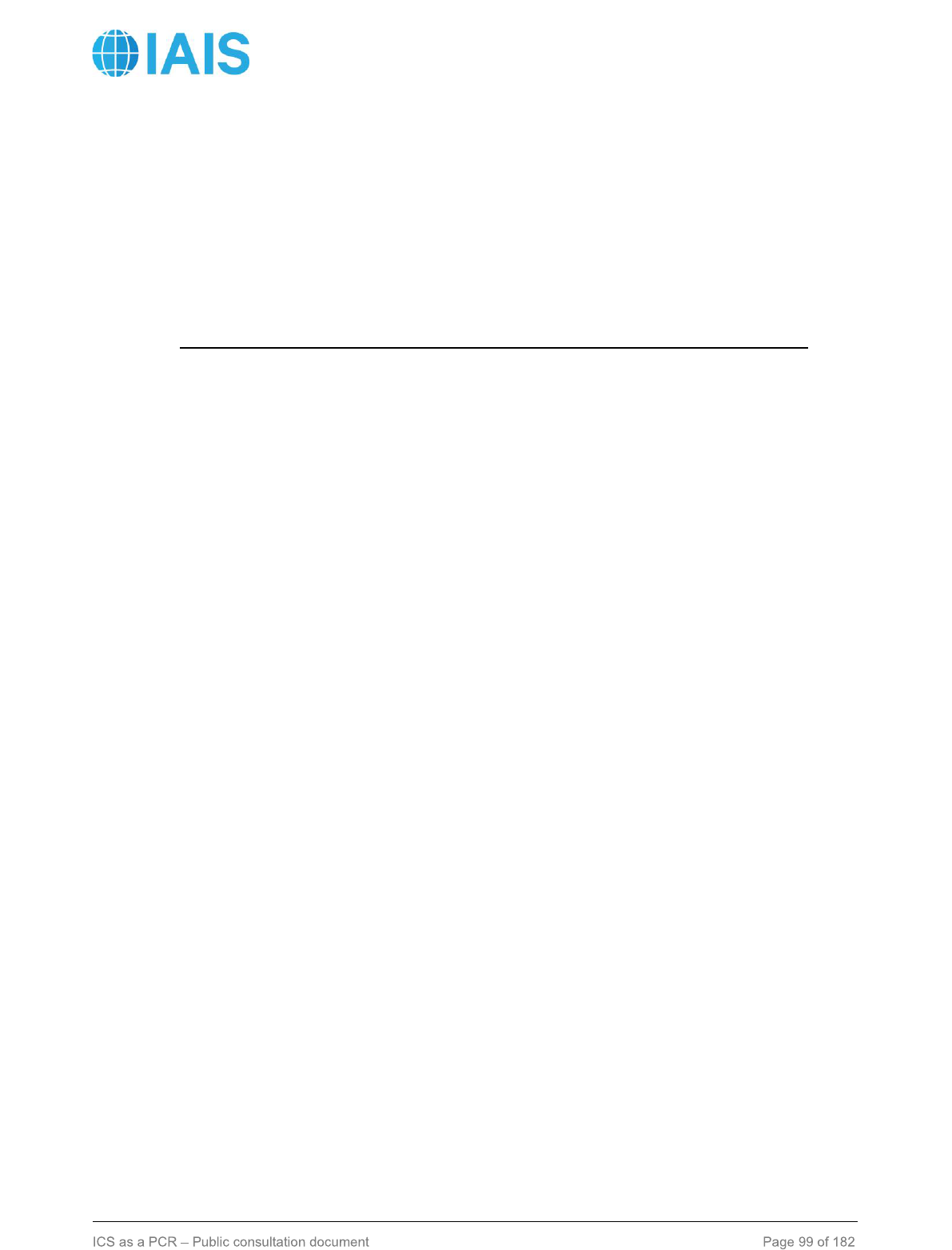
Public
date are added together and the gross add-on is calculated by multiplying the receivable amount by
the appropriate add-on factor.
L2-281. The future credit exposure for netted transactions is the sum of:
a. 40% of the add-on as calculated in paragraph L2-280; and
b. 60% of the add-on multiplied by the ratio of net current replacement cost to positive current
replacement cost (NGR) where:
7.4.1.4.2 Credit equivalent amount for other off-balance sheet exposures
L2-282. Off-balance sheet exposures that are not arising from OTC derivatives are converted into
credit exposure equivalents through the use of credit conversion factors (CCFs) applied to the item’s
notional amount:
a. Commitments with an original maturity up to one year and commitments with an original
maturity over one year receive a CCF of 20% and 50%, respectively. However, any
commitments that are unconditionally cancellable at any time by the IAIG without prior notice,
or that effectively provide for automatic cancellation due to deterioration in a borrower’s
creditworthiness, receive a 0% CCF;
b. Direct credit substitutes receive a CCF of 100%. If an IAIG has guaranteed, sold a credit
derivative for, or otherwise assumed the credit risk of a debt security, the risk charge is the
same as if the IAIG were directly holding the underlying security;
c. Sale and repurchase agreements and asset sales with recourse, where the credit risk
remains with the IAIG, receive a CCF of 100%;
d. Forward asset purchases, forward deposits and partly-paid shares and securities, which
represent commitments with certain drawdown, receive a CCF of 100%;
e. Transaction-related contingent items receive a CCF of 50%;
f. Note issuance facilities (NIFs) and revolving underwriting facilities (RUFs) receive a CCF of
50%;
g. Short-term self-liquidating trade letters of credit that an IAIG either issues or confirms arising
from the movement of goods receive a 20% CCF;
h. Where there is an undertaking to provide a commitment on an off-balance sheet item, the
IAIG applies the lower of the two applicable CCFs;
i. Off-balance sheet securitisation exposures receive a CCF of 100%.
7.4.1.5 Securities financing transactions
L2-283. The rating category for a securities financing transaction is the lower of that of the
counterparty to the transaction, or that of the securities lent. Collateral received under securities
financing transactions is recognised according to the same criteria as collateral received under
regular lending transactions (cf section 7.4.2.1).
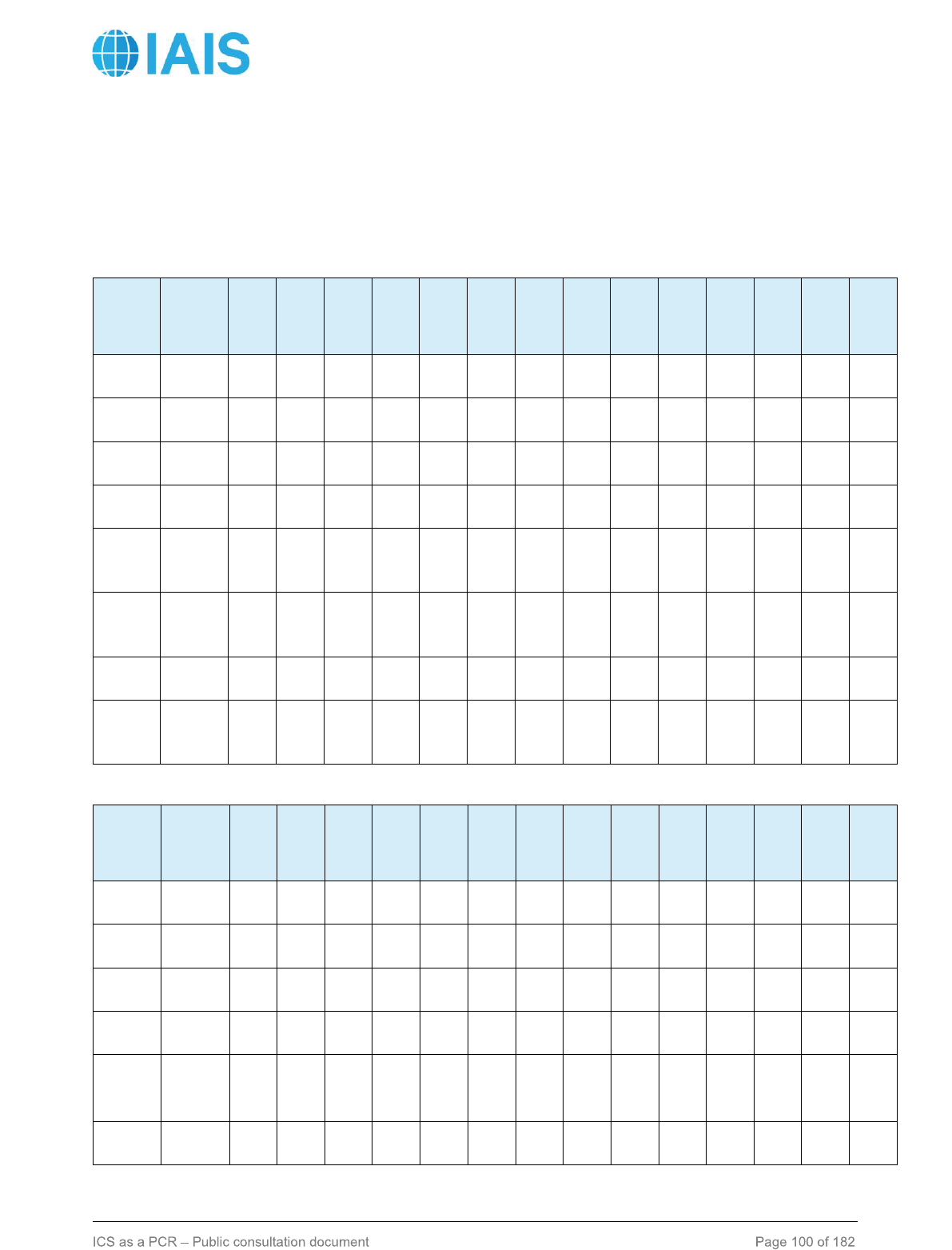
Public
7.4.1.6 Credit risk stress factors
L2-284. The following tables contain the ICS Credit risk stress factors for the exposure classes by
ICS RC and maturity:
Table 23: Credit risk stress factors for public sector entities
ICS RC
Maturity:
0-1
1-2
2-3
3-4
4-5
5-6
6-7
7-8
8-9
9-10
10-11
11-12
12-13
13-14
14+
1 or 2
0.1%
0.4%
0.5%
0.6%
0.7%
0.8%
0.9%
1.0%
1.0%
1.1%
1.1%
1.2%
1.2%
1.2%
1.3%
3
0.4%
1.0%
1.3%
1.5%
1.8%
2.0%
2.2%
2.4%
2.5%
2.7%
2.8%
2.9%
3.0%
3.0%
3.1%
4
1.0%
2.2%
2.6%
3.0%
3.3%
3.6%
3.9%
4.1%
4.2%
4.4%
4.5%
4.6%
4.7%
4.8%
4.9%
5
2.5%
5.1%
6.0%
6.6%
7.0%
7.3%
7.5%
7.6%
7.6%
7.7%
7.8%
7.8%
7.9%
7.9%
7.9%
6
6.3%
10.8
%
11.8
%
12.3
%
12.5
%
12.7
%
12.7
%
12.7
%
12.7
%
12.7
%
12.7
%
12.7
%
12.7
%
12.7
%
12.7
%
7
22.0%
24.7
%
25.2
%
25.3
%
25.3
%
25.3
%
25.3
%
25.3
%
25.3
%
25.3
%
25.3
%
25.3
%
25.3
%
25.3
%
25.3
%
Unrated
2.5%
5.1%
6.0%
6.6%
7.0%
7.3%
7.5%
7.6%
7.6%
7.7%
7.8%
7.8%
7.9%
7.9%
7.9%
In Default
35.0%
35.0
%
35.0
%
35.0
%
35.0
%
35.0
%
35.0
%
35.0
%
35.0
%
35.0
%
35.0
%
35.0
%
35.0
%
35.0
%
35.0
%
Table 24: Credit risk stress factors for corporates and reinsurance
ICS RC
Maturity:
0-1
1-2
2-3
3-4
4-5
5-6
6-7
7-8
8-9
9-10
10-11
11-12
12-13
13-14
14+
1 or 2
0.2%
0.7%
0.9%
1.2%
1.4%
1.6%
1.7%
1.9%
2.0%
2.1%
2.2%
2.3%
2.4%
2.4%
2.5%
3
0.6%
1.3%
1.6%
1.8%
2.1%
2.3%
2.6%
2.8%
3.0%
3.2%
3.3%
3.4%
3.5%
3.6%
3.7%
4
1.4%
3.0%
3.6%
4.1%
4.5%
4.9%
5.1%
5.3%
5.4%
5.6%
5.7%
5.8%
5.9%
6.0%
6.0%
5
3.6%
7.1%
8.3%
9.0%
9.4%
9.7%
9.8%
9.8%
9.8%
9.8%
9.8%
9.8%
9.8%
9.8%
9.8%
6
8.9%
14.4
%
15.3
%
15.6
%
15.6
%
15.6
%
15.6
%
15.6
%
15.6
%
15.6
%
15.6
%
15.6
%
15.6
%
15.6
%
15.6
%
7
35%
35%
35%
35%
35%
35%
35%
35%
35%
35%
35%
35%
35%
35%
35%

Public
ICS RC
Maturity:
0-1
1-2
2-3
3-4
4-5
5-6
6-7
7-8
8-9
9-10
10-11
11-12
12-13
13-14
14+
Unrated
6.3%
10.7
%
11.8
%
12.3
%
12.5
%
12.6
%
12.7
%
12.7
%
12.7
%
12.7
%
12.7
%
12.7
%
12.7
%
12.7
%
12.7
%
In Default
35%
35%
35%
35%
35%
35%
35%
35%
35%
35%
35%
35%
35%
35%
35%
Table 25: Credit risk stress factors for securitisations
ICS RC
Maturity:
0-1
1-2
2-3
3-4
4-5
5-6
6-7
7-8
8-9
9-10
10-11
11-12
12-13
13-14
14+
1 or 2
0.2%
0.7%
0.9%
1.2%
1.4%
1.6%
1.7%
1.9%
2.0%
2.1%
2.2%
2.3%
2.4%
2.4%
2.5%
3
0.6%
1.3%
1.6%
1.8%
2.1%
2.3%
2.6%
2.8%
3.0%
3.2%
3.3%
3.4%
3.5%
3.6%
3.7%
4
1.4%
3.0%
3.6%
4.1%
4.5%
4.9%
5.1%
5.3%
5.4%
5.6%
5.7%
5.8%
5.9%
6.0%
6.0%
5
10.8%
21.3
%
24.9
%
27.0
%
28.2
%
29.1
%
29.4
%
29.4
%
29.4
%
29.4
%
29.4
%
29.4
%
29.4
%
29.4
%
29.4
%
6
100%
100
%
100
%
100
%
100
%
100
%
100
%
100
%
100
%
100
%
100
%
100
%
100
%
100
%
100
%
7
100%
100
%
100
%
100
%
100
%
100
%
100
%
100
%
100
%
100
%
100
%
100
%
100
%
100
%
100
%
Unrated
100%
100
%
100
%
100
%
100
%
100
%
100
%
100
%
100
%
100
%
100
%
100
%
100
%
100
%
100
%
In Default
100%
100
%
100
%
100
%
100
%
100
%
100
%
100
%
100
%
100
%
100
%
100
%
100
%
100
%
100
%
Table 26: Credit risk stress factors for re-securitisations
ICS RC
Maturity:
0-1
1-2
2-3
3-4
4-5
5-6
6-7
7-8
8-9
9-10
10-11
11-12
12-13
13-14
14+
1 or 2
0.4%
1.4%
1.8%
2.4%
2.8%
3.2%
3.4%
3.8%
4.0%
4.2%
4.4%
4.6%
4.8%
4.8%
5.0%
3
1.2%
2.6%
3.2%
3.6%
4.2%
4.6%
5.2%
5.6%
6.0%
6.4%
6.6%
6.8%
7.0%
7.2%
7.4%

Public
ICS RC
Maturity:
0-1
1-2
2-3
3-4
4-5
5-6
6-7
7-8
8-9
9-10
10-11
11-12
12-13
13-14
14+
4
2.8%
6.0%
7.2%
8.2%
9.0%
9.8%
10.2
%
10.6
%
10.8
%
11.2
%
11.4
%
11.6
%
11.8
%
12.0
%
12.0
%
5
21.6%
42.6
%
49.8
%
54.0
%
56.4
%
58.2
%
58.8
%
58.8
%
58.8
%
58.8
%
58.8
%
58.8
%
58.8
%
58.8
%
58.8
%
6
100%
100%
100%
100%
100%
100%
100%
100%
100%
100%
100%
100%
100%
100%
100%
7
100%
100%
100%
100%
100%
100%
100%
100%
100%
100%
100%
100%
100%
100%
100%
Unrated
100%
100%
100%
100%
100%
100%
100%
100%
100%
100%
100%
100%
100%
100%
100%
In Default
100%
100%
100%
100%
100%
100%
100%
100%
100%
100%
100%
100%
100%
100%
100%
Table 27: Credit risk stress factors for infrastructure
ICS RC
Maturity:
0-1
1-2
2-3
3-4
4-5
5-6
6-7
7-8
8-9
9-10
10-11
11-12
12-13
13-14
14+
1 or 2
0.2%
0.7%
0.9%
1.2%
1.4%
1.6%
1.7%
1.9%
2.0%
2.1%
2.2%
2.3%
2.4%
2.4%
2.5%
3
0.6%
1.3%
1.6%
1.8%
2.1%
2.3%
2.6%
2.8%
3.0%
3.2%
3.3%
3.4%
3.5%
3.6%
3.7%
4
1.4%
3.0%
3.6%
4.1%
4.5%
4.9%
5.1%
5.3%
5.4%
5.6%
5.7%
5.8%
5.9%
6.0%
6.0%
5
3.6%
7.1%
8.3%
9.0%
9.4%
9.7%
9.8%
9.8%
9.8%
9.8%
9.8%
9.8%
9.8%
9.8%
9.8%
6
8.9%
14.4
%
15.3
%
15.6
%
15.6
%
15.6
%
15.6
%
15.6
%
15.6
%
15.6
%
15.6
%
15.6
%
15.6
%
15.6
%
15.6
%
7
35%
35%
35%
35%
35%
35%
35%
35%
35%
35%
35%
35%
35%
35%
35%
Unrated
4.7%
8.0%
8.9%
9.2%
9.4%
9.5%
9.5%
9.5%
9.5%
9.5%
9.5%
9.5%
9.5%
9.5%
9.5%
In Default
35%
35%
35%
35%
35%
35%
35%
35%
35%
35%
35%
35%
35%
35%
35%
L2-285. The Credit risk stress factor for policy loans is 0%. The stress factor for short-term
obligations of regulated banks, as defined in paragraph L2-253, is 0.4%. The stress factor for
receivables from agents and brokers is 6.3%. All other assets receive a stress factor of 8%. The IAIG
may exclude outstanding premiums from the exposure if insurance liabilities are recorded for the

Public
contracts relating to the outstanding premiums and the outstanding premiums are unrecorded in line
with the release of the insurance liabilities when the contracts expire upon the policyholder’s default.
7.4.1.7 Mortgage Loans
7.4.1.7.1 Commercial and agricultural mortgages where repayment depends on property income
L2-286. Depending on data availability, the risk charge is calculated using one of the three following
methods, in decreasing order of preference:
a. Method 1: risk charge based on the ICS Commercial Mortgage (CM) category as determined
by loan-to-value (LTV) and debt service coverage ratio (DSCR);
b. Method 2: risk charge based on the ICS CM category as determined by LTV only; or
c. Method 3: no Credit Quality Differentiator used.
L2-287. For agricultural and commercial Method 1, the mapping of the ICS CM categories 1 to 5 to
LTV and DSCR is provided in Table 28. Categories CM6 and CM7 are for delinquent loans and loans
in foreclosure, respectively.
Table 28: Mapping of ICS CM categories, Method 1
LTV
CM
<60%
60% to
69.9%
70% to
79.9%
80% to
89.9%
90% to
99.9%
>=
100%
DSCR
< 0.6
CM3
CM3
CM3
CM4
CM4
CM5
0.6 to
0.79
CM3
CM3
CM3
CM4
CM4
CM5
0.8 to
0.99
CM3
CM3
CM3
CM4
CM4
CM5
1 to 1.19
CM2
CM2
CM3
CM3
CM4
CM4
1.2 to
1.39
CM2
CM2
CM3
CM3
CM3
CM3
1.4 to
1.59
CM1
CM2
CM2
CM2
CM3
CM3
1.6 to
1.79
CM1
CM1
CM1
CM2
CM3
CM3
1.8 to
1.99
CM1
CM1
CM1
CM2
CM2
CM2
>= 2
CM1
CM1
CM1
CM2
CM2
CM2

Public
L2-288. For agricultural and commercial Method 1, the following stress factors are used:
Table 29: Stress factors for agricultural and commercial mortgages, Method 1
ICS CM
Categories
Stress factors
CM1
4.8%
CM2
6.0%
CM3
7.8%
CM4
15.8%
CM5
23.5%
CM6
35%
CM7
35%
L2-289. For agricultural and commercial Method 2, where only LTV data is available, the mapping
of the ICS CM categories 1 to 4 to LTV and the associated stress factors are provided in Table 27.
As for Method 1, categories CM6 and CM7 are for delinquent loans and loans in foreclosure,
respectively.
Table 30: Stress factors for agricultural and commercial mortgages, Method 2
ICS CM
Categories
Stress factors
LTV
Minimum
LTV
Maximum
CM1
4.8%
0%
59%
CM2
6.0%
60%
79%
CM3
7.8%
80%
99%
CM4
15.8%
100%
NA
CM5
Not applicable
CM6
35%
CM7
35%

Public
L2-290. For agricultural and commercial Method 3, where LTV and DSCR data are not available, a
flat 8% stress factor is used.
7.4.1.7.2 Commercial and agricultural mortgages where repayment does not depend on property
income
L2-291. When the LTV ratio of the mortgage is above 60%, the risk factor is that of a regular credit
exposure to the borrower. When the LTV ratio of the mortgage is 60% or lower, the risk factor is the
lower of 3.6% or the risk factor for a regular credit exposure to the borrower.
7.4.1.7.3 Residential mortgages
L2-292. For performing
33
residential mortgage loans for which repayment depends on income
generated by the underlying property, the factors applied are based on the mortgage’s LTV ratio, as
specified in the following table:
Table 31: Factors for residential mortgages for which repayment depends on income
generated by the underlying property
L2-293. For performing residential mortgage loans for which repayment does not depend on income
generated by the underlying property, the factors applied are based on the mortgage’s LTV ratio, as
specified in the following table:
Table 32: Factors for residential mortgages for which repayment does not depend on
income generated by the underlying property
33
The distinction between performing and non-performing is consistent with the Basel Committee’s definition, which establishes
criteria for categorising loans and debt securities that are centred around delinquency status (90 days past due) and the
unlikeliness of repayment. As such, non-performing exposures encompass: (1) all exposures defaulted, as defined under the
Basel framework; or (2) all exposures impaired (ie exposures that have undergone a downward adjustment to their valuation due
to deterioration in their creditworthiness); or (3) material exposures that are more than 90 days past due or where there is evidence
that full repayment of principal and interest without realization of collateral is unlikely, regardless of the number of days past due.
LTV
Stress
factors
LTV ≤ 60%
4.2%
60% < LTV ≤ 80%
5.4%
LTV > 80%
7.2%
LTV
Stress
factors
LTV ≤ 40%
1.5%
40% < LTV ≤ 60%
1.8%
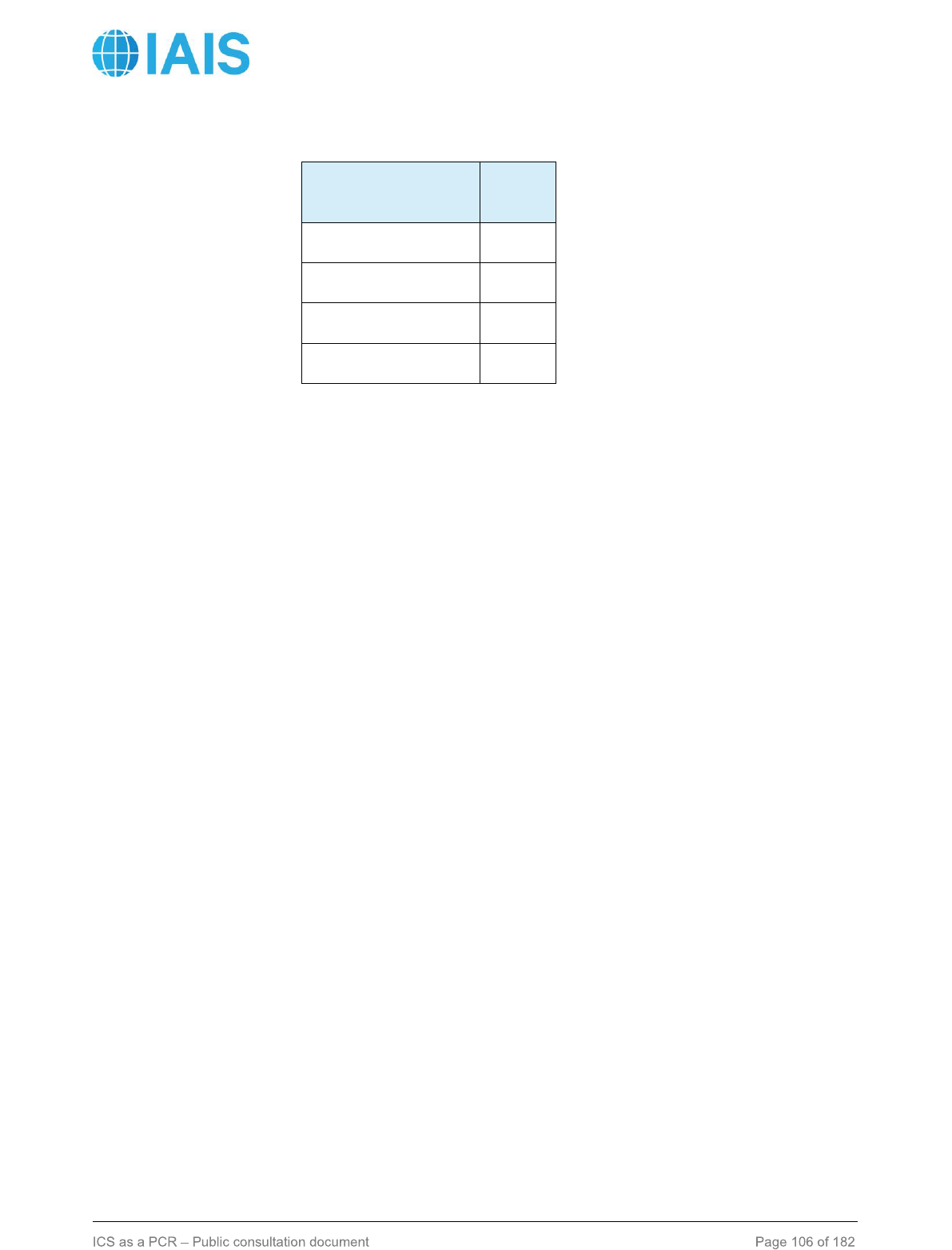
Public
L2-294. For non-performing mortgage loans, the factor applied is 35%.
7.4.2 Recognition of collateral, guarantees and credit derivatives
L1-133. In determining the net exposure value, collateral and guarantees may be taken into
consideration. The Level 2 text specifies the criteria for the recognition of collateral, guarantees and
credit derivatives.
7.4.2.1 Recognition of collateral
L2-295. A collateralised transaction is one in which:
a. An IAIG has a credit exposure or potential credit exposure; and
b. That credit exposure or potential credit exposure is hedged in whole or in part by collateral
posted by a counterparty or by a third party on behalf of the counterparty.
L2-296. Only the following collateral categories are eligible to be recognised:
a. Securities that are either issued by a sovereign entity or have ICS RC 4 or better;
b. Gold;
c. Mutual funds where:
• a price is publicly quoted daily; and
• the mutual fund is limited to investing in the eligible collateral listed above.
d. Letters of credit.
L2-297. The Credit risk charge calculation takes into account collateral provided all of the following
requirements are met:
a. The effects of collateral are not double counted. In particular, collateral on claims for which
an issue-specific rating is used that already reflects that collateral is not recognised. All
criteria around the use of ratings remain applicable to collateral.
b. All documentation used in collateralised transactions are binding on all parties and legally
enforceable in all relevant jurisdictions. The IAIG has conducted sufficient legal review to
verify this and have a well-founded legal basis to reach this conclusion, and undertaken such
further review as necessary to ensure continuing enforceability.
c. The legal mechanism by which collateral is pledged or transferred ensures that the IAIG has
the right to liquidate or take legal possession of the collateral in a timely manner in the event
LTV
Stress
factors
60% < LTV ≤ 80%
2.1%
80% < LTV ≤ 90%
2.7%
90% < LTV ≤ 100%
3.3%
LTV > 100%
4.5%
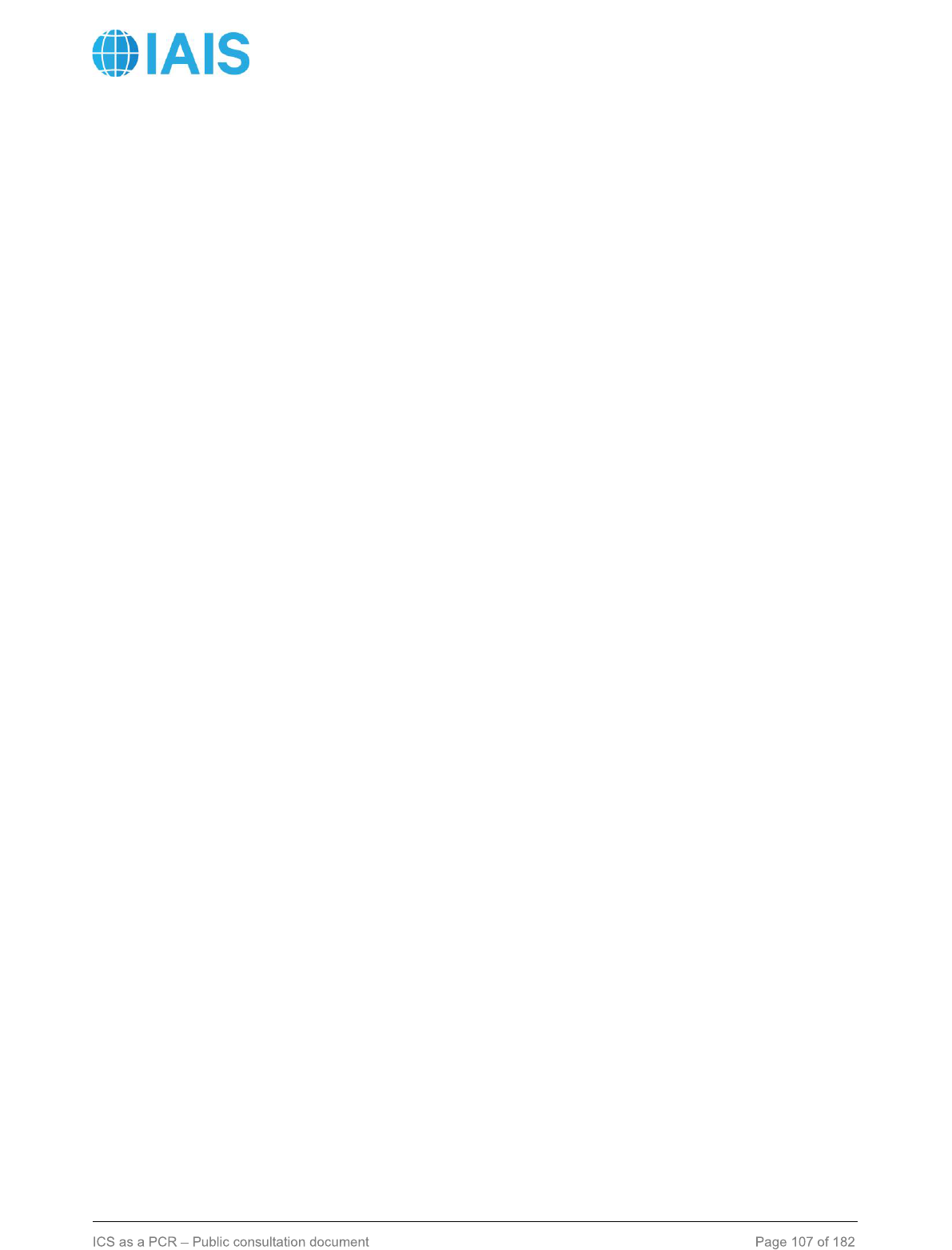
Public
of the default, insolvency or bankruptcy (or one or more otherwise-defined credit events set
out in the transaction documentation) of the counterparty (and, where applicable, of the
custodian holding the collateral). Furthermore, the IAIG has taken all necessary steps to fulfil
those requirements under the law applicable to the IAIG’s interest in the collateral for
obtaining and maintaining an enforceable security interest, eg by registering it with a registrar,
or for exercising a right to net or set off in relation to title transfer collateral.
d. The credit quality of the counterparty and the value of the collateral do not have a material
positive correlation. For example, securities issued by the counterparty – or by any related
group entity – are not eligible.
e. The IAIG has clear and robust procedures for the timely liquidation of collateral to ensure that
any legal conditions required for declaring the default of the counterparty and liquidating the
collateral are observed, and that collateral can be liquidated promptly.
f. Where collateral is held by a custodian, the IAIG takes reasonable steps to ensure that the
custodian segregates the collateral from its own assets.
g. The collateral is pledged for at least the life of the exposure.
L2-298. Where the collateral is denominated in a currency different from that in which the exposure
is denominated, the amount of the exposure deemed to be protected is 80% of the amount of
collateral, converted at current exchange rates.
7.4.2.1.1 Default approach to the recognition of collateral: the substitution approach
L2-299. The portion of an exposure that is collateralised by eligible financial collateral valued at
market is redistributed into the rating category applicable to the collateral instrument, while the
remainder of the exposure is assigned the rating category appropriate to the counterparty.
7.4.2.1.2 Alternative approach for collateralised non-life reinsurance exposures: the haircut
approach
L2-300. Under the haircut approach, collateral may be recognised if it satisfies requirements a) to f)
of paragraph L2-297 and is pledged for at least one year.
L2-301. The haircut approach reduces the exposure amount to account for collateral held by the
ceding insurer. The adjusted reinsurance exposure is defined by:
where Capital Requirements consist of the risk charges for Non-life risk, Catastrophe risk, Market
risks and Credit risk on the reinsured business and/or its supporting collateral, aggregated using the
correlations specified in section 7.6.
L2-302. The risk charges for Non-life and Catastrophe risks are equal to the reduction in the ICS
risk charges attributable to the reinsurance arrangement. This amount is aggregated with the Market
risk charge and the Credit risk charges using 25% correlations.
L2-303. The Credit and Market risk charges are specified as follows:
a. The Credit risk charge is calculated for all of the assets held as collateral.
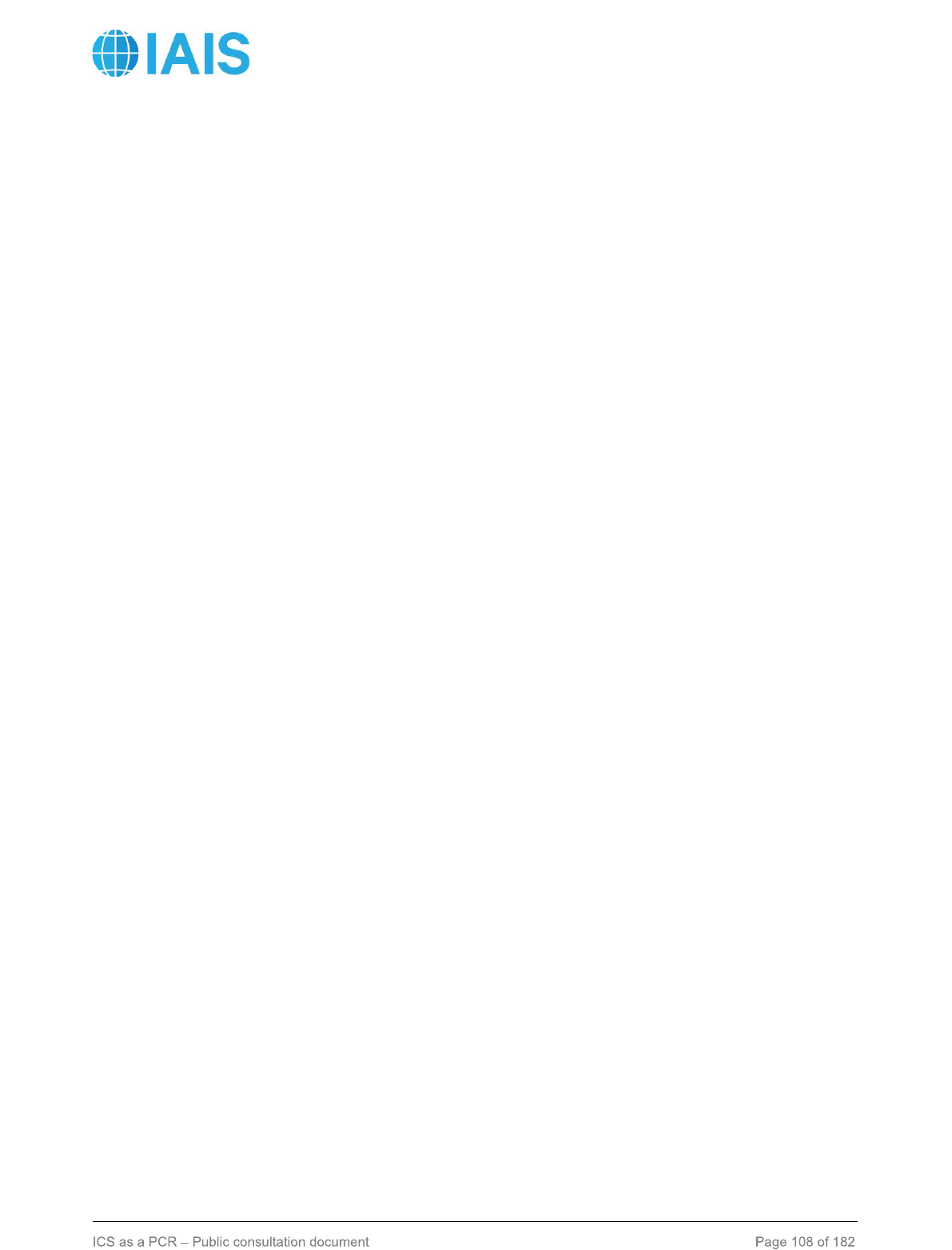
Public
b. The Asset Concentration risk charge is the granularity adjustment for all of the assets held
as collateral, calculated on a standalone basis (ie in isolation from the ceding insurer’s own
asset portfolio).
c. The Currency risk charge is calculated on a standalone basis for the reinsured liabilities in
combination with the assets held as collateral. For the purpose of this calculation, the base
currency is taken to be the currency in which the ceded liabilities are denominated, and the
deduction referred to in point g of paragraph L2-233 is not applied.
d. The Interest Rate and Non-Default Spread risk charges are calculated on a standalone basis
for the ceded liabilities in combination with the assets held as collateral.
e. The Equity and Real Estate risk charges are calculated for all of the assets held as collateral.
f. The Asset Concentration, Currency, Interest Rate, Non-Default Spread, Equity and Real
Estate risk charges are aggregated to obtain the Market risk charge using the correlations
specified in section 7.3.1.
L2-304. The resulting Credit risk charge for collateralised non-life reinsurance is equal to the
adjusted reinsurance exposure multiplied by the Credit risk factor applicable to the reinsurer.
7.4.2.2 Recognition of guarantees and credit derivatives
L2-305. In order to determine the ICS RC of its counterparties, the IAIG may take into account the
credit protection provided by guarantees and credit derivatives, provided that all of the following
conditions are met:
a. The guarantees or credit derivatives are direct, explicit, irrevocable and unconditional.
b. The guarantor or protection provider belongs to a higher rating category than the counterparty
covered by the guarantee or protection.
c. The IAIG fulfils certain minimum conditions relating to risk management described in section
7.4.2.2.1.
L2-306. The capital treatment is founded on the substitution approach, whereby the protected
portion of a counterparty exposure is assigned the rating category of the guarantor or protection
provider, while the uncovered portion retains the rating category of the underlying counterparty.
7.4.2.2.1 Risk management requirements
L2-307. The minimum conditions referred to in paragraph L2-305, applicable to both guarantees
and credit derivatives, are the following:
a. The effects of credit protection are not double counted. In particular, no recognition is given
to credit protection on claims for which an issue-specific rating is used that already reflects
that protection. All criteria around the use of ratings remain applicable to guarantees and
credit derivatives.
b. With the exception of credit protection provided by sovereigns as specified in paragraph L2-
321, a guarantee, counter-guarantee or credit derivative must represent a direct claim on the
protection provider and must explicitly refer to a specific exposure or pool of exposures, so
that the extent of the cover is clearly defined and incontrovertible.
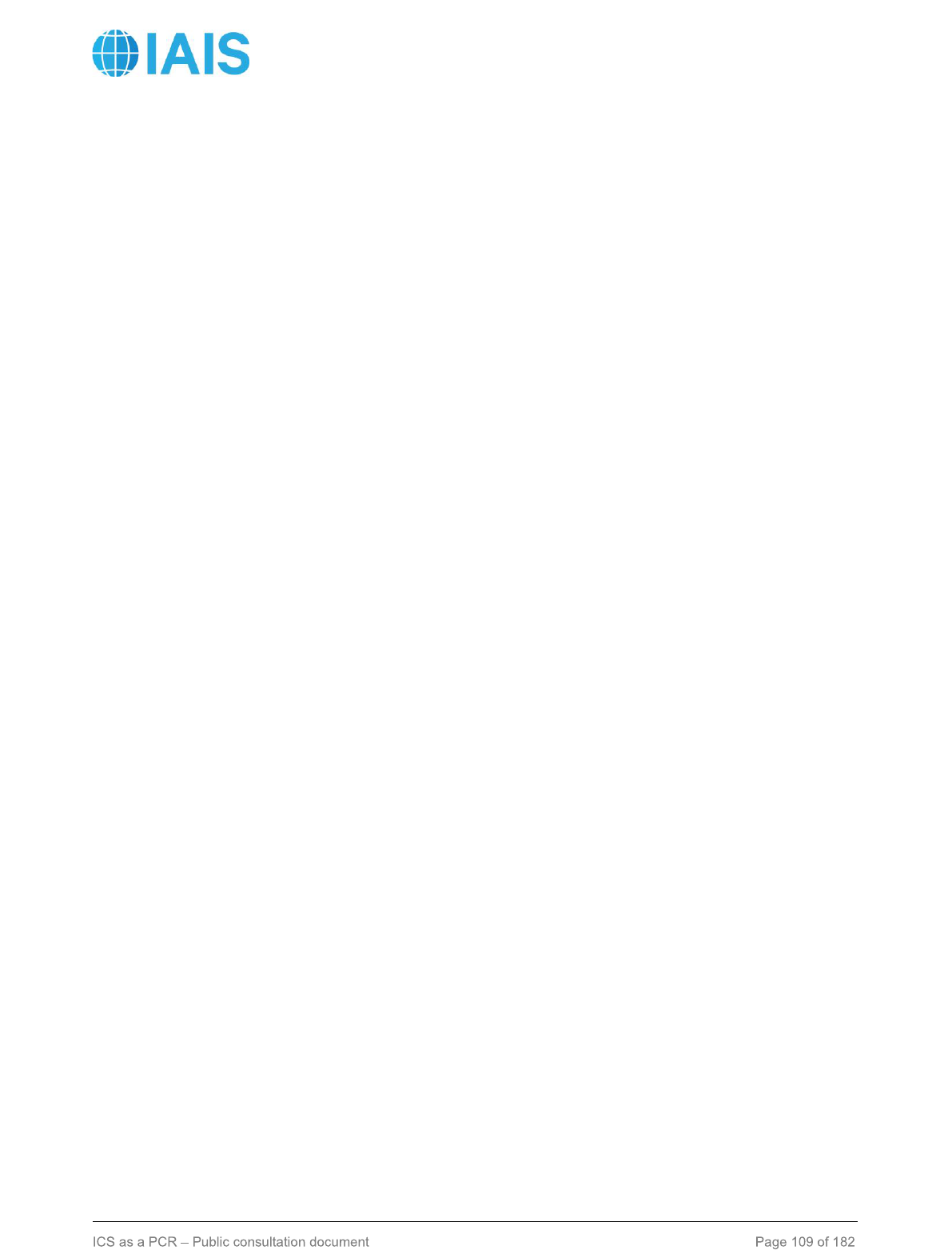
Public
c. The credit protection contract is irrevocable, except in case of non-payment by the protection
purchaser of money due in respect of the credit protection contract.
d. There is no clause in the contract that allows the protection provider to unilaterally cancel the
credit cover or to increase the effective cost of cover as a result of deteriorating credit quality
in the hedged exposure.
e. The contract is unconditional, ie there is no clause in the protection contract outside the direct
control of the IAIG that could prevent the protection provider from being obliged to pay out in
a timely manner in the event that the original counterparty fails to make the payment(s) due.
f. All documentation used for documenting guarantees and credit derivatives are binding on all
parties and legally enforceable in all relevant jurisdictions. The IAIG has conducted sufficient
legal review to verify this and have a well-founded legal basis to reach this conclusion, and
undertake such further review as necessary to ensure continuing enforceability.
L2-308. In addition to the requirements set in paragraph L2-307, the recognition of a guarantee is
subject to all of the following conditions:
a. On the qualifying default/non-payment of the counterparty, the IAIG pursues the guarantor in
a timely manner for any monies outstanding under the documentation governing the
transaction. The guarantor makes one lump sum payment of all monies under such
documentation to the IAIG, or the guarantor assumes the future payment obligations of the
counterparty covered by the guarantee. The IAIG has the right to receive any such payments
from the guarantor without first having to take legal action in order to pursue the counterparty
for payment.
b. The guarantee is an explicitly documented obligation assumed by the guarantor.
c. Except as noted in the following sentence, the guarantee covers all types of payments the
underlying obligor is expected to make under the documentation governing the transaction,
for example notional amount, margin payments etc. Where a guarantee excludes certain
types of payment, the corresponding amounts are treated as unsecured amounts.
L2-309. In addition to the requirements set in paragraph L2-307, the recognition of a credit derivative
contract is subject to all of the following conditions:
a. The credit events specified by the contracting parties cover at a minimum:
i. The failure to pay the amounts due under the terms of the underlying obligation that are
in effect at the time of such failure (with a grace period that is in line with the grace period
in the underlying obligation);
ii. The bankruptcy, insolvency or inability of the obligor to pay its debts, or its failure or
admission in writing of its inability generally to pay its debts as they become due, and
analogous events; and
iii. The restructuring of the underlying obligation involving forgiveness or postponement of
principal, interest or fees that results in a credit loss event (ie charge-off, specific provision
or other similar debit to the profit and loss account).
b. If the credit derivative covers obligations that do not include the underlying obligation, point
g) below governs whether the asset mismatch is permissible.
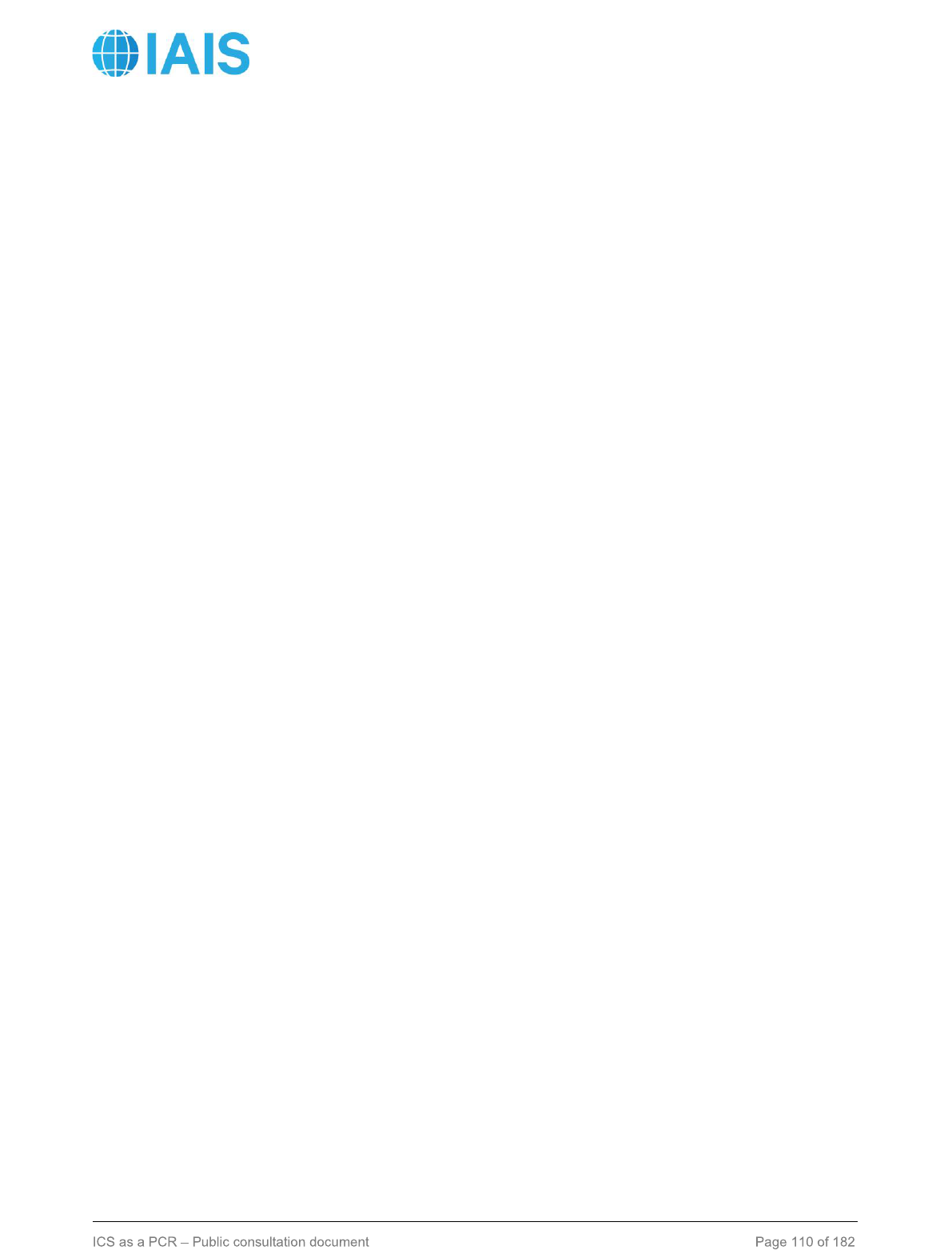
Public
c. The credit derivative does not terminate prior to the expiration of any grace period required
for a default on the underlying obligation to occur as a result of a failure to pay.
d. Credit derivatives allowing for cash settlement are recognised for capital purposes insofar as
a robust valuation process is in place in order to estimate loss reliably. There is a clearly
specified period for obtaining post-credit event valuations of the underlying obligation. If the
reference obligation specified in the credit derivative for purposes of cash settlement is
different than the underlying obligation, point g) below governs whether the asset mismatch
is permissible.
e. If the protection purchaser’s right/ability to transfer the underlying obligation to the protection
provider is required for settlement, the terms of the underlying obligation provide that any
required consent to such transfer be not unreasonably withheld.
f. The identity of the parties responsible for determining whether a credit event has occurred is
clearly defined. This determination is not the sole responsibility of the protection seller. The
protection buyer has the right/ability to inform the protection provider of the occurrence of a
credit event.
g. A mismatch between the underlying obligation and the reference obligation under the credit
derivative (ie the obligation used for purposes of determining cash settlement value or the
deliverable obligation) is permissible if:
i. The reference obligation ranks pari passu with or is junior to the underlying obligation;
and
ii. The underlying obligation and reference obligation share the same obligor (ie the same
legal entity) and legally enforceable cross-default or cross-acceleration clauses are in
place.
h. A mismatch between the underlying obligation and the obligation used for purposes of
determining whether a credit event has occurred is permissible if:
i. The latter obligation ranks pari passu with or is junior to the underlying obligation; and
ii. The underlying obligation and reference obligation share the same obligor (ie the same
legal entity) and legally enforceable cross-default or cross-acceleration clauses are in
place.
i. Only credit default swaps and total return swaps that provide credit protection equivalent to
guarantees are eligible for recognition. Where an IAIG buys credit protection through a total
return swap and records the net payments received on the swap as net income, but does not
record offsetting deterioration in the value of the asset that is protected (either through
reductions in fair value or by increasing provisions), the credit protection is not recognised.
L2-310. When the restructuring of the underlying obligation is not covered by the credit derivative,
but the other requirements above are met, partial recognition of the credit derivative is allowed, up
to a maximum of 60% of the lower of:
a. The amount of the credit derivative; and
b. The amount of the underlying obligation.

Public
7.4.2.2.2 Eligible guarantors
L2-311. Only the credit protection provided by the following counterparties are eligible for
recognition:
a. Sovereigns;
b. Externally rated public sector entities, banks and securities firms with a higher rating category
than that of the counterparty; and
c. Other entities, including parent, subsidiaries and affiliate companies of an obligor, provided
they have a higher rating category than that of the obligor.
In addition, a guarantee or credit protection provided by a related party (parent, subsidiary or affiliate)
of the IAIG is not eligible for recognition.
7.4.2.2.3 Capital treatment
L2-312. The protected portion of a counterparty exposure is assigned the rating category of the
protection provider. The uncovered portion of the exposure is assigned the rating category of the
underlying counterparty.
L2-313. Where the amount guaranteed or covered with credit protection is less than the amount of
the exposure, and the secured and unsecured portions are of equal seniority (ie the IAIG and the
guarantor share losses on a pro-rata basis), the protected portion of the exposure receives the
treatment applicable to eligible guarantees and credit derivatives, and the remainder is treated as
unsecured.
L2-314. Where an IAIG transfers a portion of the risk of an exposure in one or more tranches to
protection sellers and retains some level of risk, and the risk transferred and the risk retained are of
different seniority, all tranches are considered as securitisation exposures based on the ratings of
the guarantors. If a tranche does not carry a rating, it is considered as an unrated securitisation
exposure even if the underlying exposure is rated. Where such treatment leads to a Credit risk
charge higher that the risk charge calculated without taking the guarantee into account, the IAIG
may ignore the guarantee.
L2-315. Materiality thresholds on amounts due below which no payment is made in the event of loss
are considered unrated securitisation exposures.
7.4.2.2.4 Currency mismatches
L2-316. Where the credit protection is denominated in a currency different from that in which the
exposure is denominated, the amount of the exposure deemed to be protected is 80% of the nominal
amount of the credit protection, converted at current exchange rates.
7.4.2.2.5 Maturity mismatches
L2-317. When the residual maturity of the credit protection is less than that of the underlying
exposure (maturity mismatch) and the credit protection has either an original maturity of less than
one year or a residual maturity of less than three months, the protection is not recognised.
L2-318. In other cases of maturity mismatch, the following adjustment is applied:
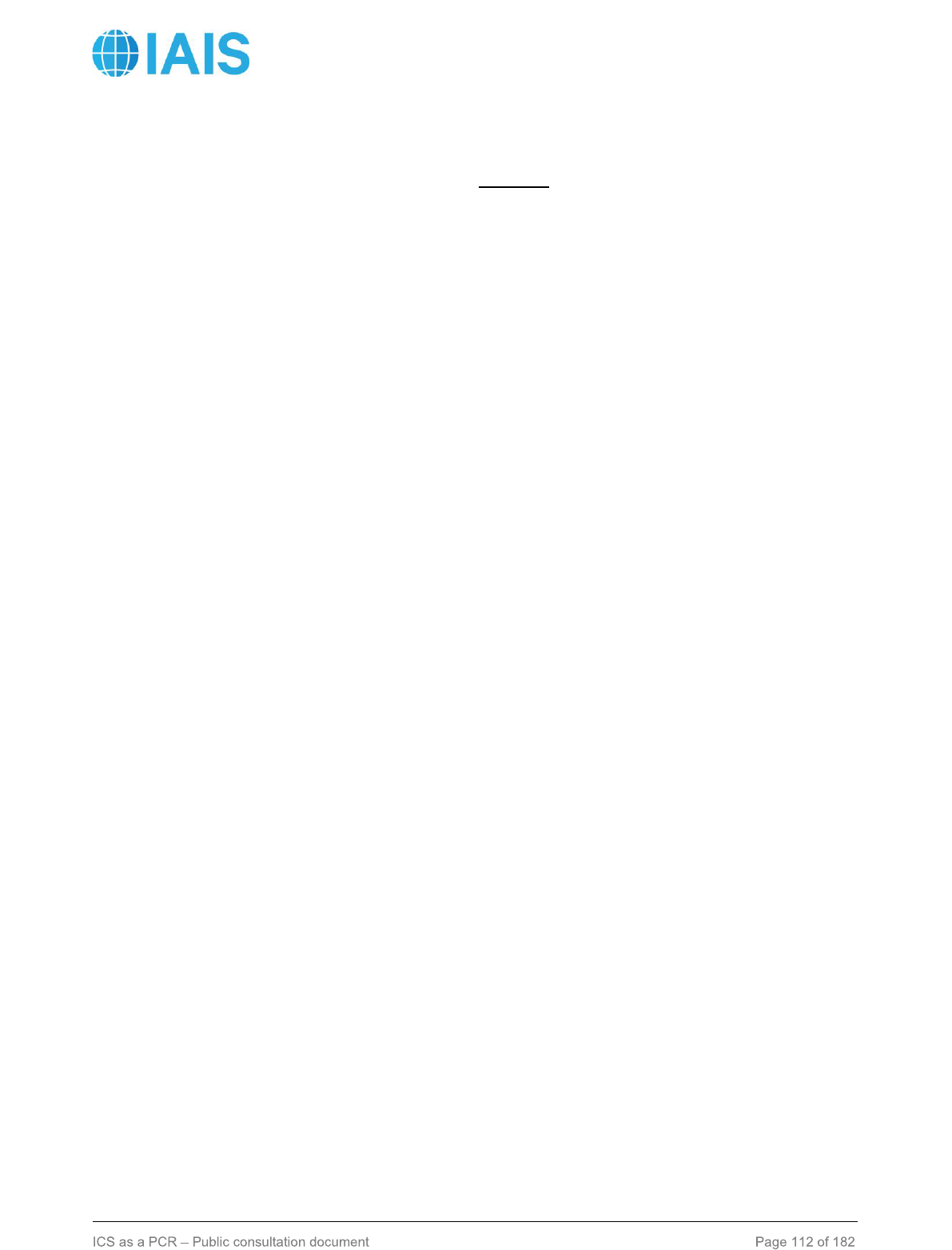
Public
where:
•
is the value of the credit protection adjusted for maturity mismatch;
• is the nominal amount of the credit protection, adjusted for currency mismatch if applicable;
• is the lower of 5 and the residual maturity of the exposure expressed in years; and
• is the lower of and the residual maturity of the credit protection arrangement expressed
in years.
L2-319. The residual maturity of the underlying exposure is taken as the longest possible remaining
time before the counterparty is scheduled to fulfil its obligation, taking into account any applicable
grace period.
L2-320. For the credit protection, embedded options that may reduce the term of the protection are
taken into account so that the shortest possible effective maturity is used. In particular:
a. Where a call is at the discretion of the protection seller, the residual maturity corresponds to
the remaining time to the first call date.
b. Where a call is at the discretion of the IAIG buying protection but the terms of the arrangement
at origination contain a positive incentive for the IAIG to call the transaction before contractual
maturity, the residual maturity corresponds to the remaining time to the first call date.
7.4.2.2.6 Sovereign counter-guarantees
L2-321. Claims covered by a guarantee that is indirectly counter-guaranteed by a sovereign may be
treated as covered by a sovereign guarantee provided that:
a. The sovereign counter-guarantee covers all credit risk elements of the claim;
b. Both the original guarantee and the counter-guarantee meet all the operational requirements
for guarantees, except that the counter-guarantee need not be direct and explicit to the
original claim; and
c. The cover is robust, and there is no historical evidence suggesting that the coverage of the
counter-guarantee is less than effectively equivalent to that of a direct sovereign guarantee.
7.4.2.2.7 Other items
L2-322. Where an IAIG has multiple types of risk mitigation arrangements covering a single
exposure, this exposure is subdivided into portions covered by each type of risk mitigation
arrangement and the rating category for each portion is determined separately.
L2-323. When a credit protection provided by a single protection provider has different maturities, it
is subdivided into separate protections.
7.4.3 Use of external credit ratings
L1-134. External credit ratings may be used for the calculation of the Credit risk charge, provided
that the rating agency has published default and transition statistics extending back over a sufficiently
long period of time, and satisfying six criteria related to: objectivity, independence, international
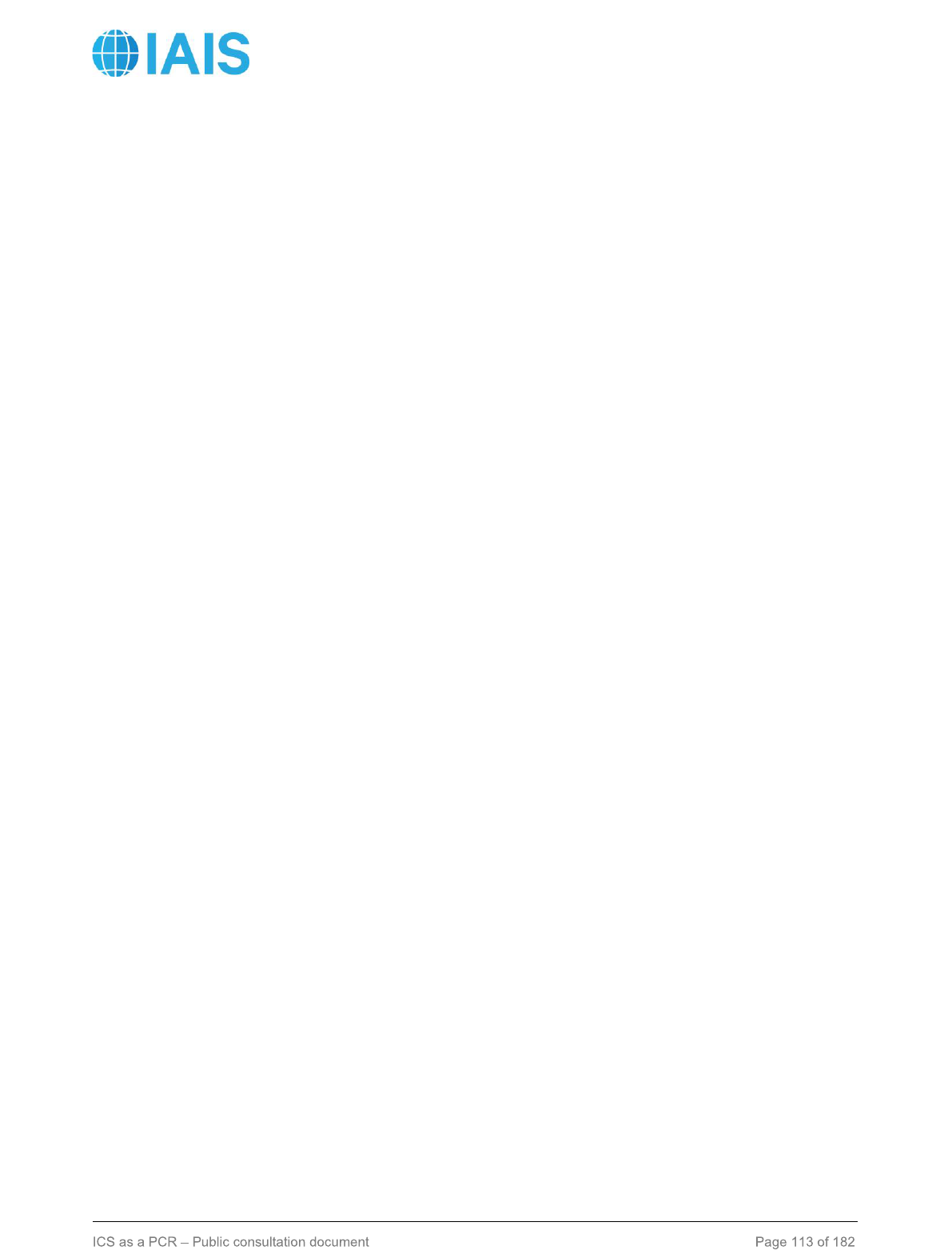
Public
access/transparency, disclosure, resources and credibility. Those criteria, as well as the required
time period for which statistics need to have been published, are specified in the Level 2 text.
L1-135. When external credit ratings are used in accordance with paragraph L1-134, they are
mapped to ICS Rating Categories as described in section 3.4 and further specified in the Level 2
text.
L1-136. The IAIG may use any ratings by a rating agency currently recognised by its home insurance
regulator for local capital determination purposes, subject to clear instructions provided by the home
insurance regulator on how to map those credit agency ratings to the ICS Rating Categories and
explicit acceptance of the use of those ratings by the IAIS.
7.4.3.1 Eligible external credit ratings
L2-324. The IAIG may use ratings produced by rating agencies other than those referred to in
paragraph L1-136, provided that both of the following requirements are met:
a. The rating agency is regulated or recognised by a suitable government authority in all of the
jurisdictions in which the agency issues ratings that the IAIG chooses to use.
b. The rating agency publishes at least annually publicly available default and transition
statistics extending back at least seven years, and satisfies all of the following six criteria:
i. Objectivity: The rating agency’s methodology for assigning credit assessments is
rigorous, systematic, and subject to some form of validation based on historical
experience. Moreover, assessments are subject to ongoing review and are responsive to
changes in financial conditions. The agency has an assessment methodology for each
market segment, including rigorous back testing that has been applied for at least one
year and, preferably, three years.
ii. Independence: The rating agency is independent and is not subject to political or
economic pressures that may influence the rating. The assessment process is free from
any constraints that could arise in situations where the composition of the board of
directors or the shareholder structure of the assessment institution may be seen as
creating a conflict of interest.
iii. International access/Transparency: The individual assessments, the key elements
underlining the assessments, and whether the issuer participated in the assessment
process are made publicly available on a non-selective basis. In addition, the general
procedures, methodologies and assumptions for arriving at assessments used by the
rating agency are publicly available.
iv. Disclosure: A rating agency discloses the following information: its code of conduct; the
general nature of its compensation arrangements with assessed entities; its assessment
methodologies, including the definition of default, the time horizon, and the meaning of
each rating; the actual default rates experienced in each assessment category; and the
transitions of the assessments, eg the likelihood of AA ratings becoming A over time.
v. Resources: A rating agency has sufficient resources to carry out high quality credit
assessments. These resources allow for substantial ongoing contact with senior and
operational levels within the entities assessed in order to add value to the credit

Public
assessments. Such assessments are based on methodologies that combine qualitative
and quantitative approaches.
vi. Credibility: The rating agency’s external credit assessments are widely used by
independent parties (investors, insurers, trading partners). In addition, the rating agency
has internal procedures to prevent the misuse of confidential information.
7.4.3.2 Definition of rating categories
L2-325. The mapping of the agency’s ratings to ICS RCs is based on the average of the three-year
Cumulative Default Rates (CDRs) associated with the agency’s ratings, as follows:
Table 33: Mapping of ratings by other rating agencies
ICS RC
Average 3-year CDR
based on over 20
years of published
data
Average 3-year CDR
based on between 7
and 20 years of
published data
1
2
0 ≤ CDR ≤ 0.15%
3
0.15% < CDR ≤ 0.35%
0 ≤ CDR ≤ 0.15%
4
0.35% < CDR ≤ 1.20%
0.15% < CDR ≤ 0.35%
5
1.20% < CDR ≤
10.00%
0.35% < CDR ≤ 1.20%
6
10.00% < CDR ≤
25.00%
1.20% < CDR ≤
10.00%
7
CDR > 25%
CDR > 10%
7.4.3.3 Use of ratings
L2-326. The IAIG chooses the rating agencies it intends to rely on and use their ratings consistently
for each type of credit exposure.
L2-327. Any rating used to determine an ICS RC is publicly available, ie the rating is published in
an accessible form and included in the rating agency’s transition matrix.
L2-328. If an IAIG is relying on multiple rating agencies and there is only one rating for a particular
security, that assessment is used to determine the ICS RC. If there are two ratings from the rating
agencies used by an IAIG, and those two ratings are mapped to different ICS RC, the IAIG uses the
ICS RC corresponding to the lower of the two ratings. If there are three or more ratings for a security
from an IAIG’s chosen rating agencies, one of the ratings that corresponds to the highest ICS RC is
excluded, and the rating that corresponds to the highest rating category of those that remain is used
to determine the ICS RC of the security.

Public
L2-329. Where a particular security has one or more issue-specific rating, the ICS RC for that
security is based on these ratings. Otherwise, the following principles apply:
a. Where the borrower has a specific rating for an issued debt security other than the one in
which the IAIG is invested, an ICS RC of 4 or better on the rated security may only be applied
to the IAIG’s unrated investment if it ranks pari passu or senior to the rated security in all
respects. If not, the credit rating cannot be used and the IAIG’s investment is treated as an
unrated obligation.
b. Where the borrower has an issuer rating, only senior securities issued by that issuer will
benefit from an investment-grade (ICS RC 4 or better) issuer assessment; other unassessed
securities issued by that issuer are treated as unrated. If either the issuer or one of its issues
has an ICS RC of 5 or weaker, this rating is used to determine the ICS RC for an unrated
claim on the issuer.
c. Short-term assessments for a given security or facility can be used only for that security or
securities issued by that rated facility. They can neither be generalised to other short-term
securities nor used to support a rating category assignment for an unrated long-term security.
d. Where the rating category for an unrated exposure is based on the rating of an equivalent
exposure to the borrower, a foreign currency rating may be used only for exposures
denominated in that foreign currency. Domestic currency ratings, if separate, are used to
determine the rating category for securities denominated in the domestic currency only.
L2-330. The following additional conditions apply to the use of ratings:
a. External assessments for one entity within a corporate group are not used to determine the
rating category for other entities within the same group.
b. No rating based on assets that the entity possesses is inferred for an unrated entity. The use
of internal ratings is not allowed.
c. The IAIG does not recognise collateral or guarantees in the Credit risk charge calculation if
these credit enhancements have already been reflected in the issue-specific rating.
d. The IAIG does not use a rating that is at least partly based on unfunded support (eg
guarantees, credit enhancement or liquidity facilities) provided by the IAIG itself or one of its
affiliates.
e. Any assessment used takes into account the entire amount of Credit risk exposure the IAIG
has with regard to all payments owed to it. In particular, if the IAIG is owed both principal and
interest, the assessment fully takes into account the Credit risk associated with repayment of
both principal and interest.
7.4.3.4 Exposures in default
L2-331. Assets for which there is reasonable doubt about the timely collection of the full amount of
principal or interest, including those assets that are contractually more than 90 days in arrears, are
considered as defaulted exposures for the calculation of the Credit risk charge.
L2-332. The exposure amount for a defaulted asset is taken net of all balance sheet write-downs
and specific provisions that have been recorded for the asset.
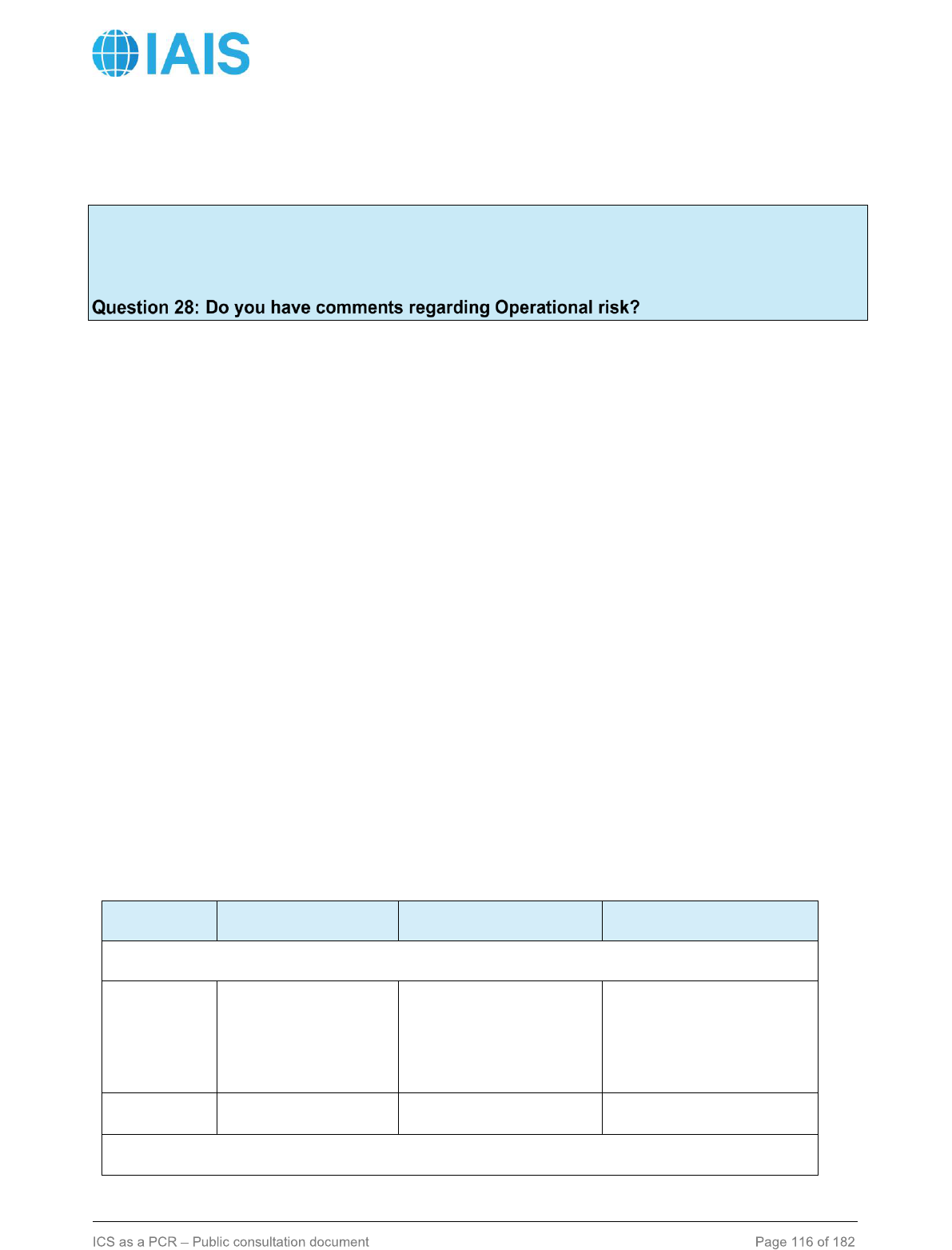
Public
7.5 Operational risk
Changes compared to ICS Version 2.0:
This section has not incurred any change compared to ICS Version 2.0 for the monitoring period.
L1-137. The Operational risk charge is determined by applying prescribed stress factors to specified
risk exposures.
L1-138. The calculation of the Operational risk charge is based on data items split into geographical
segments and the following line of business segments:
• Non-Life – insurance products that do not relate to life or similar to life health insurance, often
referred to as property and casualty or general insurance;
• Life (risk) – insurance products that relate to life or similar to life health insurance where the
insurer bears investment risk; and
• Life (non-risk) – products where the policyholder bears the investment risk.
L1-139. The exposures and stress factors for Operational risk are specified in the Level 2 text.
L2-333. The Operational risk charge is calculated as follows:
L2-334. The Operational risk components are computed as factors multiplied by risk exposures. The
same factors are applied across geographical segments as defined in section 7.1.2.
L2-335. The exposures and stress factors for Operational risk are specified in the following table.
Table 34: Operational risk exposures and stress factors
Premium
Growth
Liabilities
Risk from Non-Life Operations
Exposure
Gross written premium
(GWP) in
most recent financial
year
GWP in
most recent financial year in
excess of the growth
threshold (20%) compared
to the previous year’s GWP
Gross current estimate
Factor
2.75%
2.75%
2.75%
Risk from Life Operations
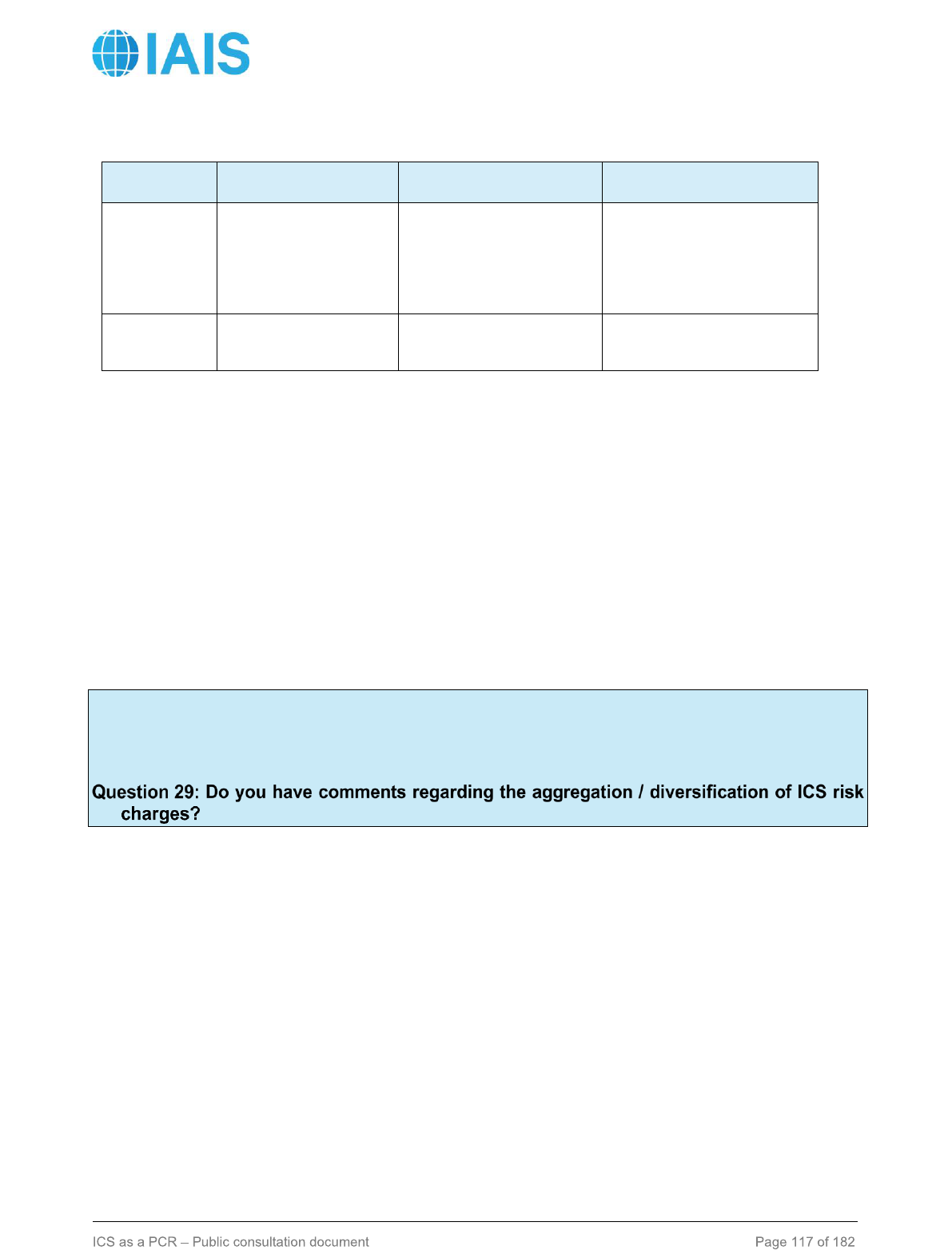
Public
Premium
Growth
Liabilities
Exposure
Life (risk): GWP in
most recent financial
year
Life (risk): GWP in
most recent financial year in
excess of the growth
threshold (20%) compared
to the previous year’s GWP
Life (risk): Gross current
estimate
Life (non-risk): Gross
current estimate
Factor
Life (risk): 4%
Life (risk): 4%
Life (risk): 0.45%
Life (non-risk): 0.40%
L2-336. GWP includes all business (new and renewal) written during the specified financial year
before any allowance for reinsurance or other related recoverables. For single premium policies,
premiums are included in full as written during the year. For other insurance policies, GWP includes
premiums due to the IAIG during the specified time period (financial year) on all business in-force.
L2-337. Gross current estimates are considered before any allowance for reinsurance or other
related recoverables.
L2-338. To calculate the growth risk component of Operational risk, the GWP for the two most recent
financial years for non-life and life (risk) are used. The figures are considered before the effect of
ceded reinsurance and on a consolidated basis.
7.6 Aggregation / diversification of ICS risk charges
Changes compared to ICS Version 2.0:
This section has not incurred any change compared to ICS Version 2.0 for the monitoring period.
L1-140. ICS Risk charges are aggregated together using multiple levels:
• A top-level aggregation between major risk categories (Life risk, Non-life risk, Catastrophe
risk, Market risk, Credit risk and Operational risk) using a correlation matrix;
• A medium-level aggregation between the sub-risks of Life risk, Catastrophe risk and Market
risk, using correlation matrices; and
• An aggregation within individual risk charges (eg interest rate risk, non-life risk).
L1-141. The aggregation of risk charges incorporates a degree of diversification between the
individual risks, based on a specified dependency between the risks.
L1-142. Correlation matrices are specified for the aggregation of the individual Life Risk charges
and the aggregation of individual Market risks charges. A top-level correlation matrix is specified for
the aggregation of Life, Non-Life, Catastrophe, Market and Credit risk charges. The Operational risk
charge is then added to that aggregate to determine the overall ICS insurance risk charge.
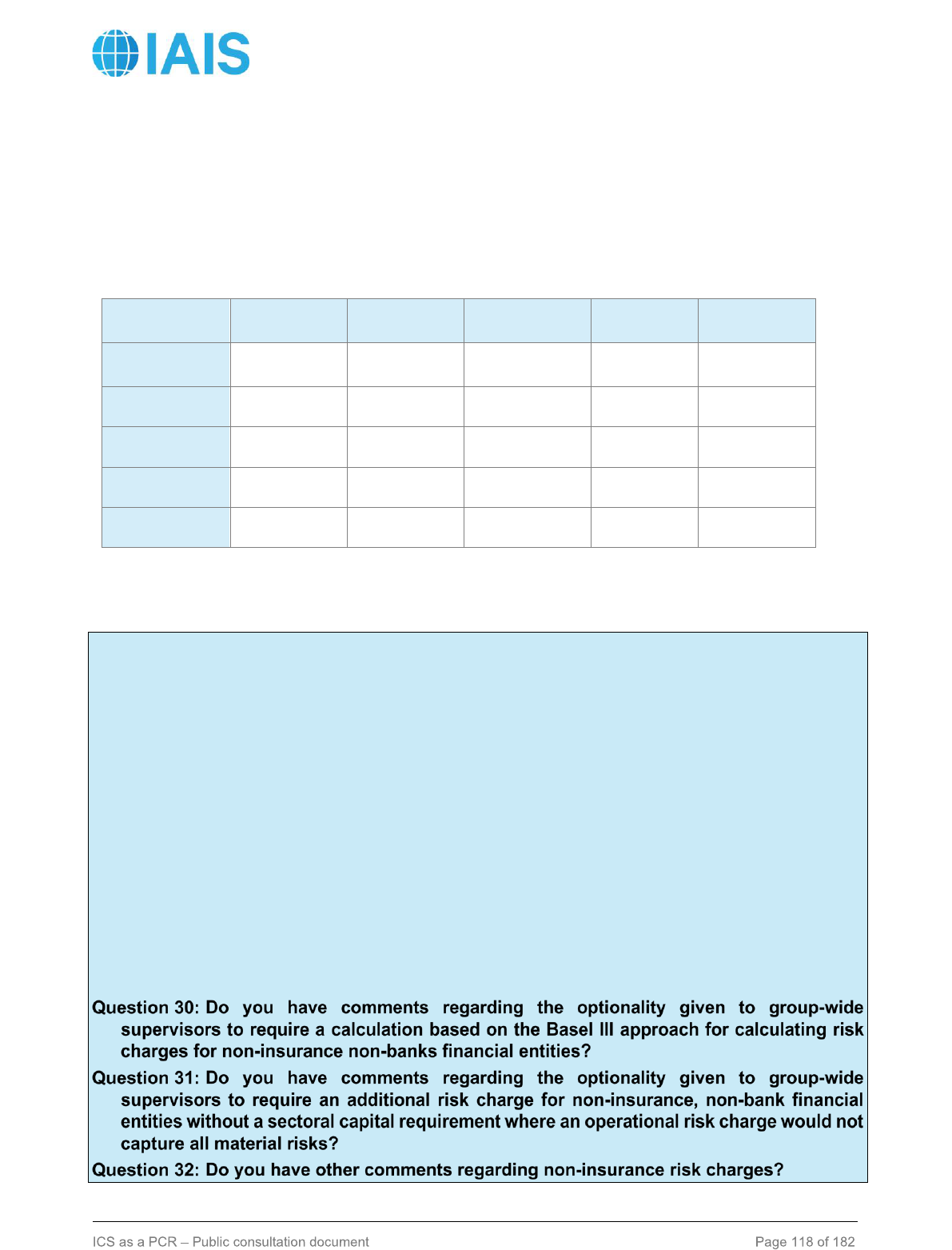
Public
L1-143. The correlation matrices used to aggregate the ICS risk charges are specified in the Level
2 text. The aggregation approach used within individual risk charges is described in the specific risk
section in the Level 1 and 2 texts.
L2-339. The top-level aggregation matrix between major risk categories is:
Table 35: Aggregation matrix between risks
Life
Non-life
Catastrophe
Market
Credit
Life
100%
0%
25%
25%
25%
Non-life
0%
100%
25%
25%
25%
Catastrophe
25%
25%
100%
25%
25%
Market
25%
25%
25%
100%
25%
Credit
25%
25%
25%
25%
100%
7.7 Non-insurance risk charges
Changes compared to ICS Version 2.0:
Non-insurance entities are categorised as financial and non-financial for purposes of determining a
capital requirement. Within the financial category there is a further subdivision between entities with
a sectoral capital requirement and those without. There is a further breakdown between banks and
non-banks. The capital requirement for banks is based on Basel risk weighted assets or leverage
ratio. For financial entities that are non-banks, the capital requirement is based on a charge derived
from the Basel operational risk charge under the assumption that these entities would primarily be
asset managers with the predominant risk being operational risk.
For the candidate ICS as a PCR, two changes were made. As the Basel rule for operational risk was
refined to better capture risk particularly for larger entities, an option was added such that a group-
wide supervisor may require the more advanced calculation based on the new approach developed
for Operational risk in Basel III. It was also noted that there may be circumstances where a capital
requirement based solely on operational risk may not capture all material risks of a financial entity
(for instance an entity that is exposed to market risks). In such a case, the group-wide supervisor
has the option to require additional risk charges on top of the operational risk charge.

Public
L1-144. The ICS capital requirement includes a risk charge for non-insurance entities, to be added
to the capital requirement calculated as described in sections 7.1 to 7.6. The calculation of the non-
insurance risk charges is specified in the Level 2 text.
L2-340. For financial non-insurance entities with a sectoral capital requirement, the capital
requirement is as follows:
a. For consolidated banking entities it is the maximum of Basel III risk-weighted assets or
leverage ratio.
b. For consolidated non-banking entities it is equal to the maximum of the sectoral capital
requirement and 15% of three year average gross income.
34
At the group wide supervisor’s
request, the requirement is equal to the maximum of the sectoral capital requirement and the
Operational Risk Capital Requirement as calculated under the Basel III calculation for
operational risk.
35
If additional, material risks of the entity are not appropriately captured by
either operational risk-type charge, the group wide supervisor may require an additional risk
charge to cover these risks.
c. For banking and non-banking entities reported as an equity method investment it is equal to
the proportional sectoral charge.
d. For both banking and non-banking entities reported as a market value investment it is equal
to the equity charge on the investment as described in section 7.3.4.
L2-341. For financial non-insurance entities without a sectoral capital requirement, the capital
requirement is as follows:
a. For consolidated banking entities it is equal to 4% of the exposure as determined by the
leverage ratio.
b. For consolidated non-banking entities it is equal to 15% of three year average gross income
or, at the group wide supervisor’s request, to the Operational Risk Capital Requirement as
calculated under the Basel III calculation for operational risk.
35
c. For banking entities reported as an equity method investment it is equal to the proportional
sectoral leverage ratio.
d. For non-banking entities reported as an equity method investment it is equal to the
proportional 15% of three year average gross income or, at the group wide supervisor’s
request, to the proportional Operational Risk Capital Requirement as calculated under the
Basel III calculation for operational risk.
35
If additional, material risks of the entity are not
appropriately captured by either operational risk-type charge, the group wide supervisor may
require an additional risk charge to cover these risks.
e. For both banking and non-banking entities reported as a market value investment it is equal
to the equity charge on the investment as described in section 7.3.4.
34
For asset managers, gross income relates only to third-party asset management, not the management of the IAIG’s own assets
where the risk is captured elsewhere. Gross income is defined in paragraph 650 of Basel II Comprehensive version
(https://www.bis.org/publ/bcbs128.pdf).
35
The Basel III calculation for operational risk capital requirement is specified in the following document:
https://www.bis.org/basel_framework/chapter/OPE/25.htm?inforce=20230101&published=20221208&export=pdf
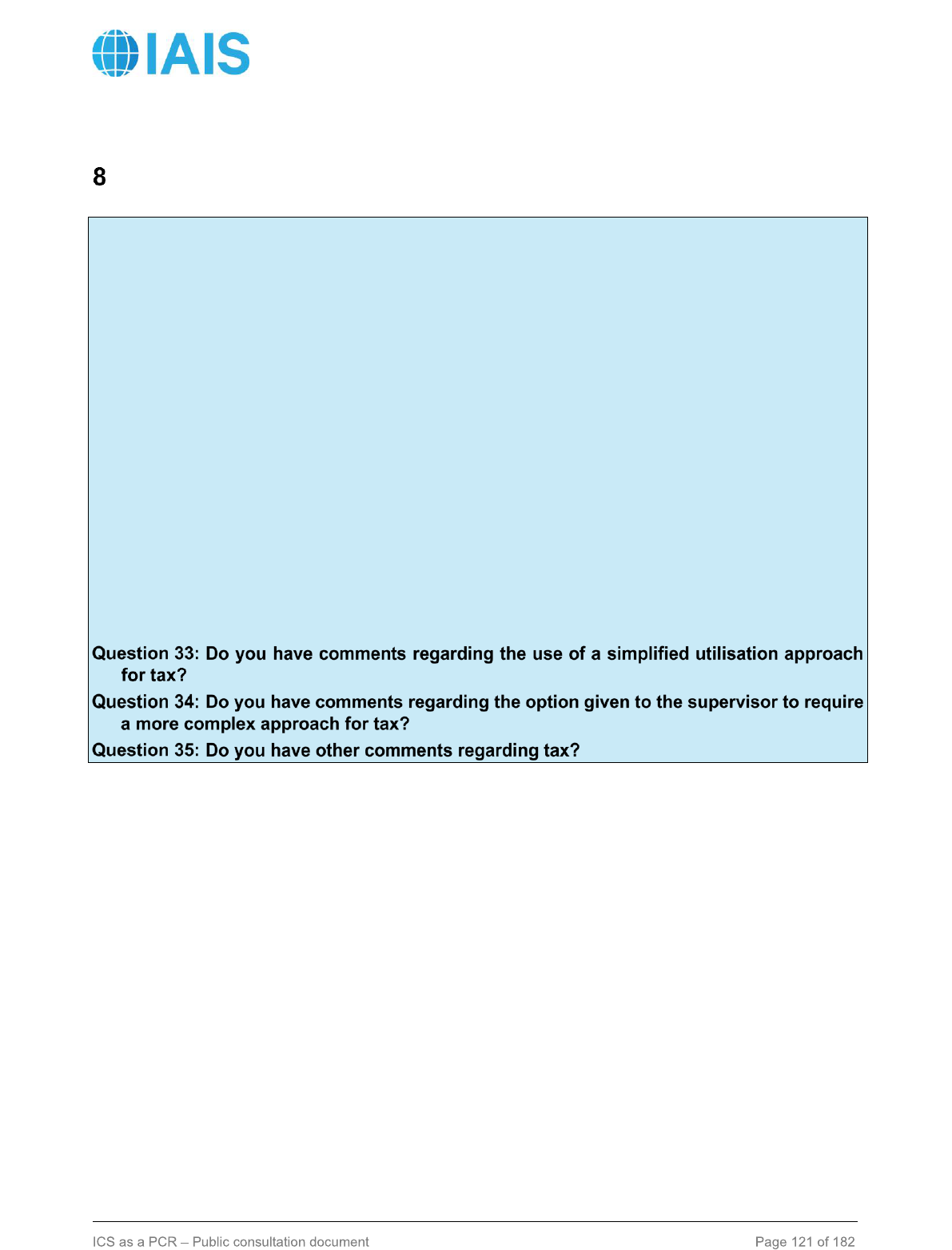
Public
Tax
Changes compared to ICS Version 2.0:
The tax effect on the ICS insurance capital requirement applies a group level calculation, a top-down
approach, as the capital requirement is calculated on a consolidated basis. Considering the ICS uses
a consolidated approach, there is not detail on a sub-group/entity level basis to calculate the
utilisability of the tax effect on the ICS insurance capital requirement. The ICS 2.0 approach
attempted to assess utilisability using group level elements that roughly approximated the tax
utilisation capacity. Based on feedback and analysis it was determined that these elements added
complexity without the benefit of accuracy for most jurisdictions. In addition, the ICS 2.0 approach
penalised jurisdictions with higher tax rates by limiting the effect to 20% of the insurance capital
requirement.
As a result, the IAIS agreed to simplify the calculation of the tax effect on the capital requirement to
80% of the notional tax effect on the insurance capital requirement (calculated as the ICS insurance
capital requirement multiplied by the group effective tax rate). The 80% simplified utilisation rate
being proposed is based on analysis of prior ICS data submissions. Additionally, when appropriate,
supervisors may use a more complex utilisation approach for the tax effect on the insurance capital
requirement by considering tax loss carry backs, future taxable income as well as deferred tax assets
and liabilities. As part of this change, the overall tax effect limit of 20% of the insurance capital
requirement was eliminated.
8.1 General principles
L1-145. Deferred taxes, as recognised on the consolidated GAAP or SAP balance sheet
(“consolidated GAAP”), are also recognised on the ICS balance sheet. DTA and DTL on the
consolidated GAAP are reported the same way on the ICS balance sheet, whether that be two
numbers or a single number.
L1-146. There are two areas of the ICS that are tax affected:
• Differences in valuation between the consolidated GAAP and the ICS balance sheet (ICS
Adjustment), made in accordance with section 5.1; and
• The ICS insurance capital requirement.
L1-147. The ICS applies a group level calculation using a group effective tax rate (G-ETR) to
calculate the change in deferred tax resulting from the ICS Adjustment and the tax effect on the ICS
insurance capital requirement.
L1-148. The method to calculate the G-ETR is specified in the Level 2 text.
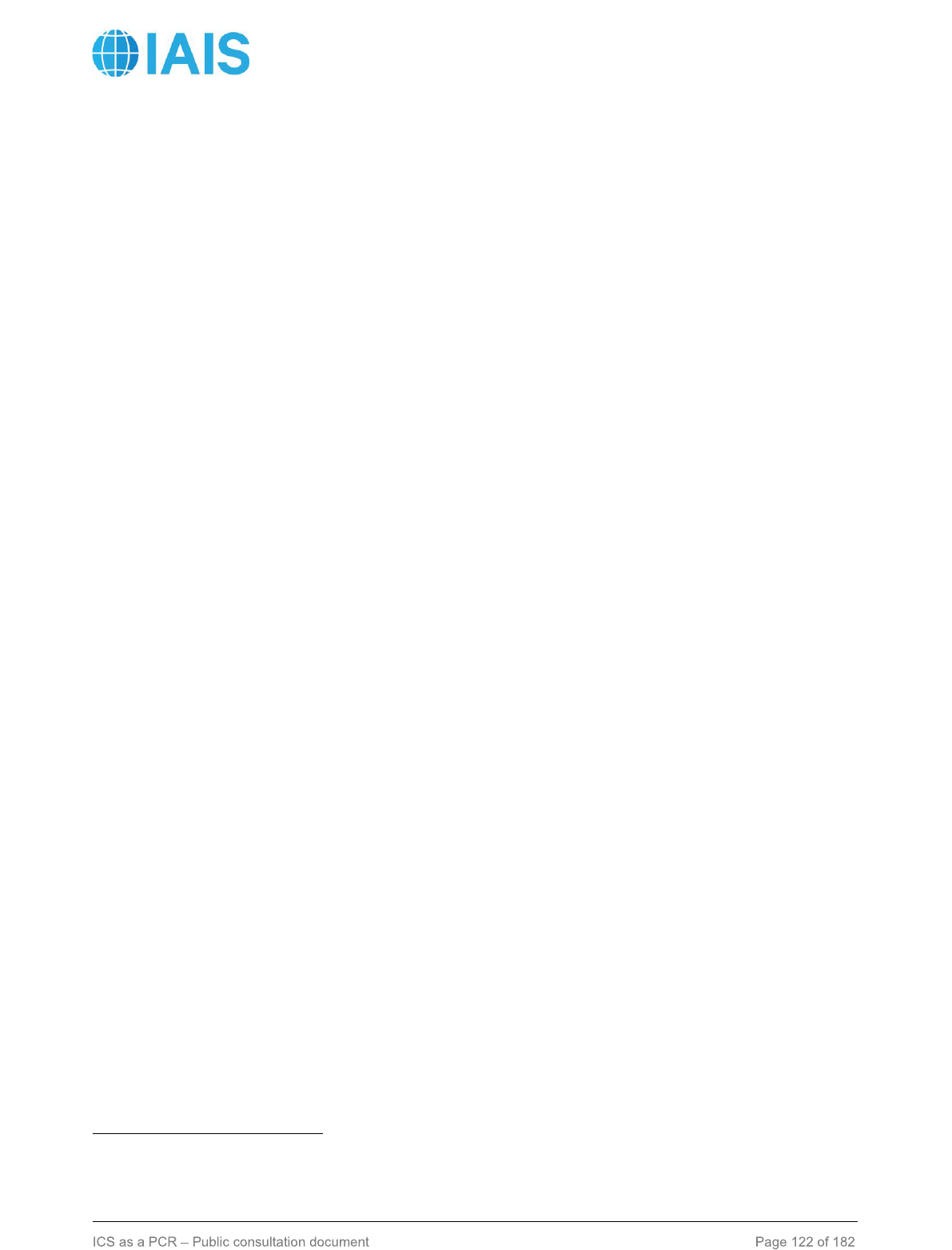
Public
L2-344. The G-ETR is calculated as a weighted average effective tax rate, weighted using the
previous three-year average of GAAP earnings before tax on a sub-group/entity level basis. The
scope of the weighted average calculation is limited to insurance-related activities, and GAAP
earnings before tax is floored at zero.
L2-345. Statutory tax rates that have been enacted or substantially enacted as of the reporting date
are used for the G-ETR calculation.
36
8.2 Deferred tax resulting from the ICS Adjustment
L1-149. The valuation adjustments made to the consolidated GAAP in order to derive the ICS
balance sheet give rise to corresponding adjustments to deferred tax assets and liabilities. Any
additional DTAs, created as a consequence of the ICS Adjustment, are subject to an utilisation
assessment. The conditions of calculation and recognition of those deferred tax adjustments,
including the utilisation assessment, are specified in the Level 2 text.
L2-346. The adjustment to deferred tax is determined for each balance sheet line item that has been
adjusted in order to arrive at the ICS balance sheet. Line items may yield an adjustment to deferred
tax asset, deferred tax liability or no adjustment to deferred tax depending on the tax treatment of
the line item. No adjustment for tax is made where the change in a line item, or component of a line
item, does not result in a temporary tax difference (eg equity line items, line items representing
permanent tax differences such as items that may not be expensed or generate revenue that is
exempt for tax purposes). These line items or components of line items are excluded from the
deferred tax adjustment calculation.
L2-347. The deferred tax adjustment is calculated on a line by line basis. For all lines or components
of lines, other than MOCE, where the adjustment creates a tax impact, the deferred tax is then
calculated by multiplying the tax effected difference between consolidated GAAP and ICS balances
by the G-ETR (as specified in paragraphs L2-344 and L2-345). The sum of DTA and the sum of DTL
resulting from this line by line calculation are reported separately. The consolidated GAAP deferred
tax is adjusted by the net outcome of the deferred tax resulting from the ICS Adjustment.
L2-348. The MOCE is included as an ICS Adjustment and creates a DTA on the ICS balance sheet.
8.2.1 Utilisation assessment of DTAs recognised from the ICS Adjustment
L2-349. Before the utilisation assessment, the DTA recognised from the ICS Adjustment is the sum
of DTAs resulting from the line by line calculation specified in paragraph L2-347 and the DTA on
MOCE specified in paragraph L2-348.
L2-350. The DTA recognised from the ICS Adjustment after the utilisation assessment is limited to
, where:
a. The sum of DTLs resulting from the line by line calculation specified in paragraph L2-347;
b. Consolidated GAAP DTL;
36
For example, a tax authority announces tax rate changes that would have a material impact for future periods. In such a case,
the newly announced statutory tax rate is used in the G-ETR calculation.

Public
c. GAAP DTL netted from assets deducted from Tier 1 capital resources, as specified in
paragraph L1-64; and
d. Consolidated GAAP DTA.
L2-351. The consolidated GAAP DTL and DTA referred to in paragraph L2-350 are limited to DTL
and DTA reported from insurance-related activities.
8.3 Tax effect on the ICS insurance capital requirement
L1-150. The mitigating effect of tax is taken into account when determining the ICS capital
requirement. That tax effect on the ICS capital requirement is based on the increase in net DTA that
would result from an instantaneous operational loss equal to the ICS capital requirement before tax,
post diversification and post management actions. Any increase in net DTA is subject to a utilisation
assessment as specified below.
L2-352. The ICS insurance capital requirement is reduced by the amount of utilisable tax effect.
L2-353. By default, the utilisable tax effect on the ICS insurance capital requirement is calculated
as:
where:
•
;
L2-354. When deemed appropriate by the group-wide supervisor, a limit to the utilisation of the tax
effect on the ICS insurance capital requirement may be set. The utilisable tax effect on the ICS
insurance capital requirement is then calculated using the following formula:
where:
•
;
•
37
• ;
•
c
= max (0,
DTL for insurance-related activities on ICS balance sheet post-deduction in
paragraph
L2-358
DTA for insurance-related activities on ICS balance sheet
); and
•
d
= max [0, min(15% ×
ICS insurance capital requirement, DTA for insurance-related activities
on ICS balance sheet
DTL for insurance-related activities on ICS balance sheet post-deduction
in paragraph
L2-358)].
37
Allocated notional tax effect on insurance capital requirement – refer to paragraph L2-356.
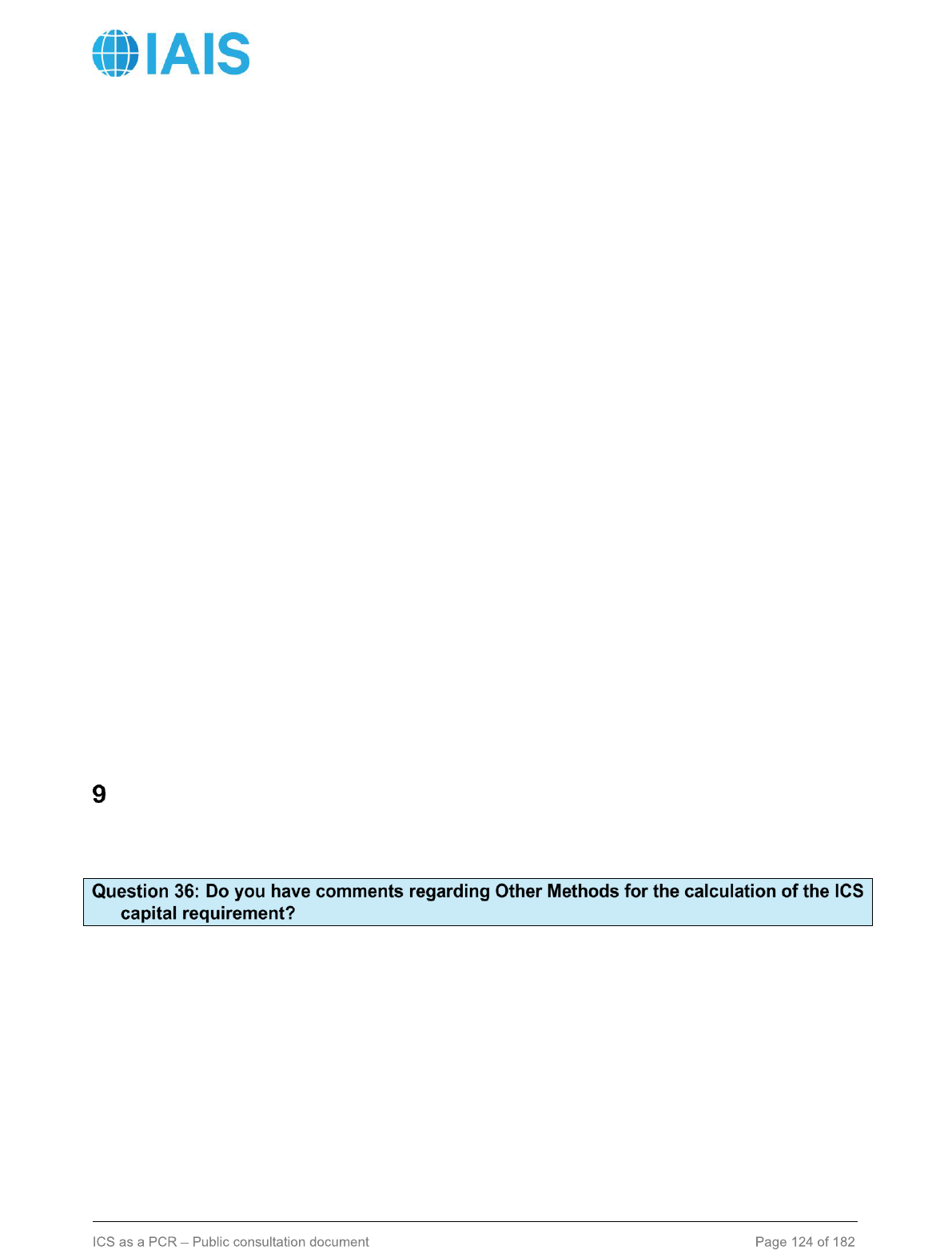
Public
8.3.1 Component a: tax loss carry backs
L2-355. A tax loss carry back is defined as a mechanism allowing a sub-group/entity to offset current
net operating losses against tax obligations from previous years (whether tax loss carry backs are
allowed and the number of years allowed differs by tax jurisdiction).
L2-356. In order to perform the calculation of component a in the utilisable tax effect:
• The tax loss carry back capacity for insurance-related activities is evaluated at the legal entity
or sub-group level where taxes are assessed, including any fiscal unity for corporate tax as
of the ICS reporting date.
• The notional tax effect on the ICS insurance capital requirement is allocated between tax
sub-groups/entities using a weighted average based on consolidated GAAP insurance
liabilities.
8.3.2 Component b: post-stress future taxable income projections
L2-357. In order to perform the calculation of component b in the utilisable tax effect:
• When the IAIG projects consolidated GAAP net losses for the cumulative five-year period,
component b is set to zero.
• Otherwise, component b is approximated by 50% of the total historical five years’
consolidated GAAP earnings before tax, adjusted for mergers, acquisitions and dispositions.
8.3.3 Components c and d: Deferred taxes
L2-358. DTL used in components c and d represent the amount after the application of deferred tax
from the ICS Adjustment, as described in section 8.2 and after deduction of the DTL for insurance-
related activities associated with assets subject to deduction from Tier 1 capital resources (see
section 6.4.1).
Capital Requirement – Other Methods
9.1 General principles
L1-151. The scope of Other Methods is limited to the capital requirement. When Other Methods are
used, the valuation and capital resources elements of the ICS remain subject to the provisions set
in sections 5 and 6 respectively. Other Methods provide the same level of protection as the standard
method, with target criteria of 99.5% VaR over a one-year time horizon.
L1-152. Other Methods permitted are:
• Supervisor-owned and controlled credit assessment processes; and
• Internal models.
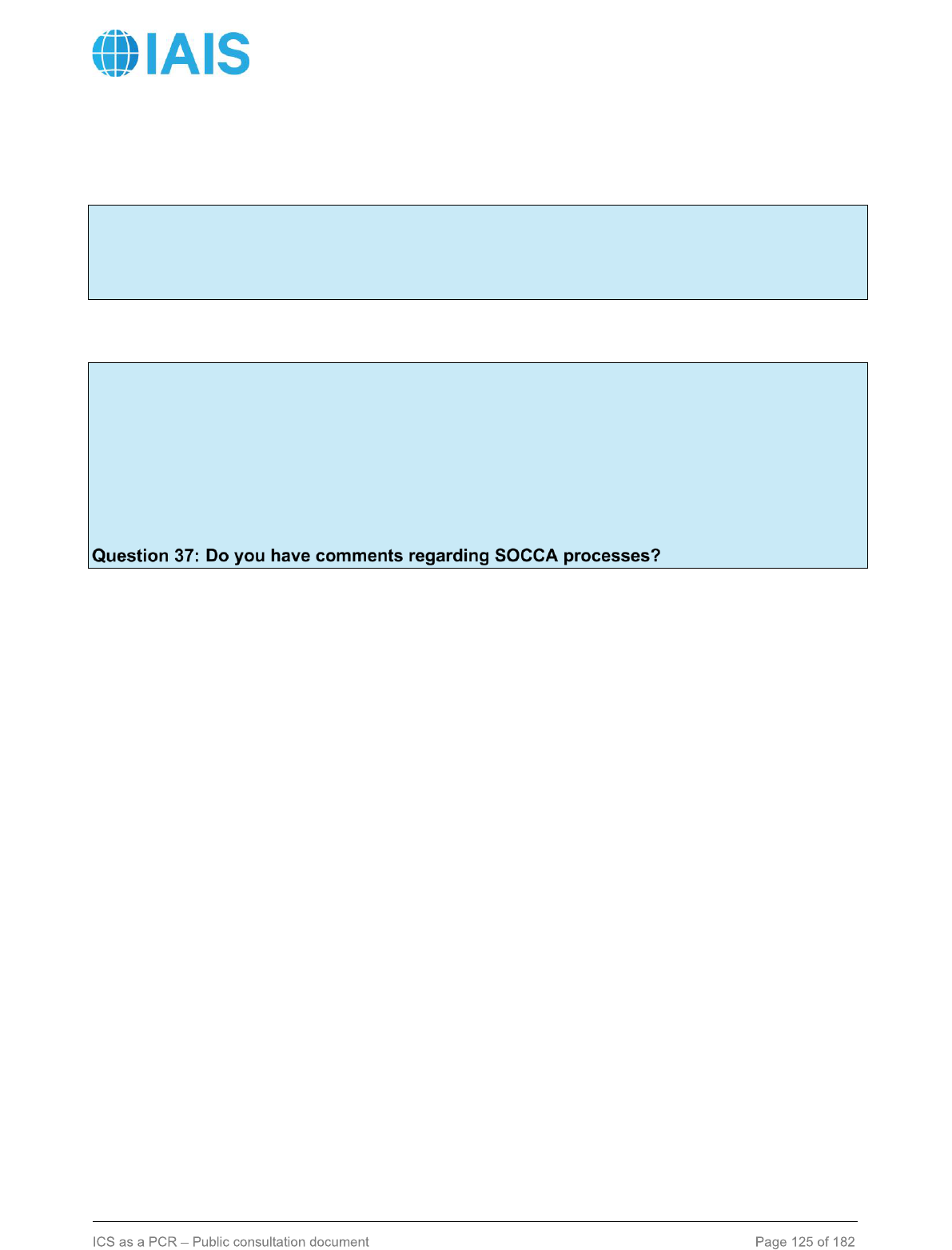
Public
9.2 Dynamic Hedging
Changes compared to ICS Version 2.0:
During the monitoring period, the IAIS collected data relating to dynamic hedging. However, the data
collected proved insufficient both in scope and quality, and therefore dynamic hedging has not been
included as an Other Method for the calculation of the capital requirement.
9.3 Supervisory Owned and Controlled Credit Assessments (SOCCA)
Changes compared to ICS Version 2.0:
The IAIS has been collecting data on SOCCA processes during the monitoring period. SOCCA
processes have now been included as part of Other Methods, applying to unrated exposures only,
for calculating the capital requirement in the candidate ICS as a PCR.
The criteria for using SOCCA processes as an Other Method remain unchanged from ICS Version
2.0.
L1-153. A SOCCA process is an independent and objective process for assessing Credit risk,
owned and controlled by a financial supervisory authority, and that relies upon credit assessment
methodologies deemed suitable by the supervisory authority in determining the regulatory capital
requirement for Credit risk of supervised entities. An example of a SOCCA is NAIC Designations.
The criteria for a SOCCA process to be recognised in the ICS are specified in the Level 2 text.
L2-359. A SOCCA process may be used for the calculation of the Credit risk charge for unrated
exposures if all the following criteria are met:
a. Objectivity: The SOCCA’s methodology for assigning credit assessments is rigorous,
systematic, and subject to some form of validation. Moreover, assessments are subject to
ongoing review and responsive to changes in financial condition.
b. Independence: The SOCCA process is aligned with the regulatory objectives of the
supervisor, evidenced by the supervisor’s approval of the credit assessment process. Any
outsourcing arrangement of the credit assessment is held to the same standards of
competency and independence as the in-house credit assessment processes.
c. International access/transparency: an IAIG with operations outside the jurisdiction of the
SOCCA process can request designations/ratings be assigned to securities they own. Public
access to the credit assessment is available through third-party platforms.
d. Disclosure: Default statistics over time are developed for each designation/rating so that
three-year cumulative default rates (CDRs) can be derived from published statistics.
e. Resources: Staff has appropriate qualifications and experience to undertake the credit
assessment process. The SOCCA process relies on adequate resources to carry out the
credit assessments required by the supervisor.
f. Credibility: The SOCCA process relies on internal procedures to prevent the misuse of
confidential information. The SOCCA process has at least 10 years of demonstrable business
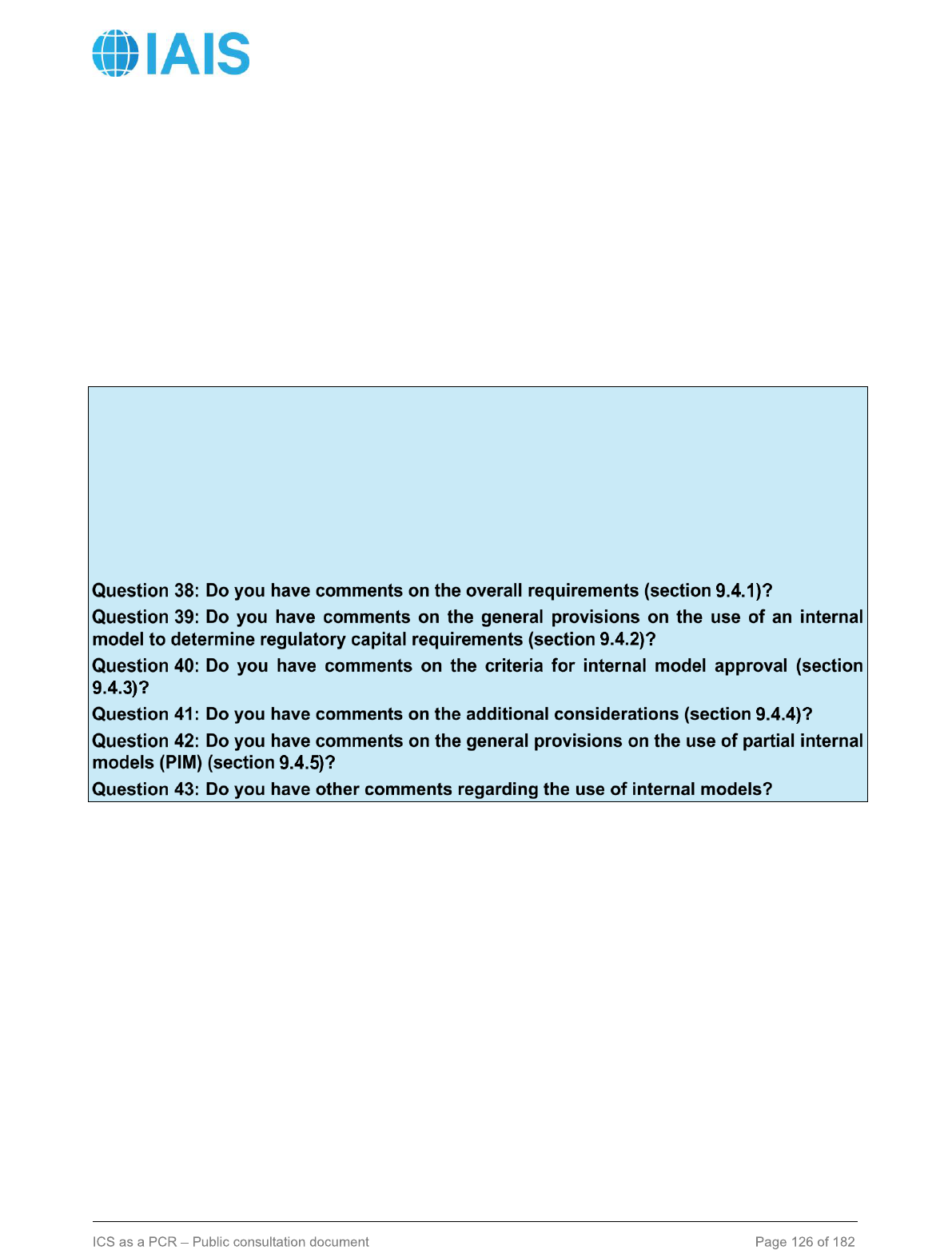
Public
history in assessing the Credit risk of a large number of securities such that statistical
performance data can be derived. All designations/ratings are updated at least on a yearly
basis; in addition, the designations/ratings are reviewed as soon as a significant event occurs
that may affect them.
g. Alignment of interests with the purposes of prudential supervision: The entity performing the
credit assessment is fully owned and controlled by a supervisory authority. There are policies
approved by the supervisory authority as to how the credit assessment process is applied.
9.4 Internal models
The IAIS has been collecting data on internal models during the monitoring period as internal models
were considered a viable option for inclusion in the ICS. Internal models have been included as part
of Other Methods for calculating the capital requirement in the candidate ICS as a PCR.
The IAIS has developed a governance framework for the inclusion of internal models in the ICS.
Specific requirements must be met before the GWS can allow the use of an internal model for
calculating the ICS capital requirement, including an established approval process; ongoing
monitoring and controls; criteria for eligibility and continued use; and documentation standards.
9.4.1 Overall Requirements
L1-154. The group-wide supervisor (GWS) considers how the Balance Sheet, used within the
internal model, complies with the requirements for the calculation of the balance sheet in the
standard method, currently set out within section 5 on Market-Adjusted Valuation.
L1-155. Whenever internal models are allowed as an Other Method for calculating the ICS capital
requirement, their use is subject to the requirements specified in sections 9.4.2 to 9.4.5.
9.4.2 General Provisions on the use of an internal model to determine regulatory capital
requirements
9.4.2.1 Internal model approval process
9.4.2.1.1 Framework for application and review process
L1-156. The GWS sets up an internal model application process (IMAP). The IMAP enables the
GWS to decide whether the IAIG may use a specified internal model to calculate its group-wide PCR
under the ICS.
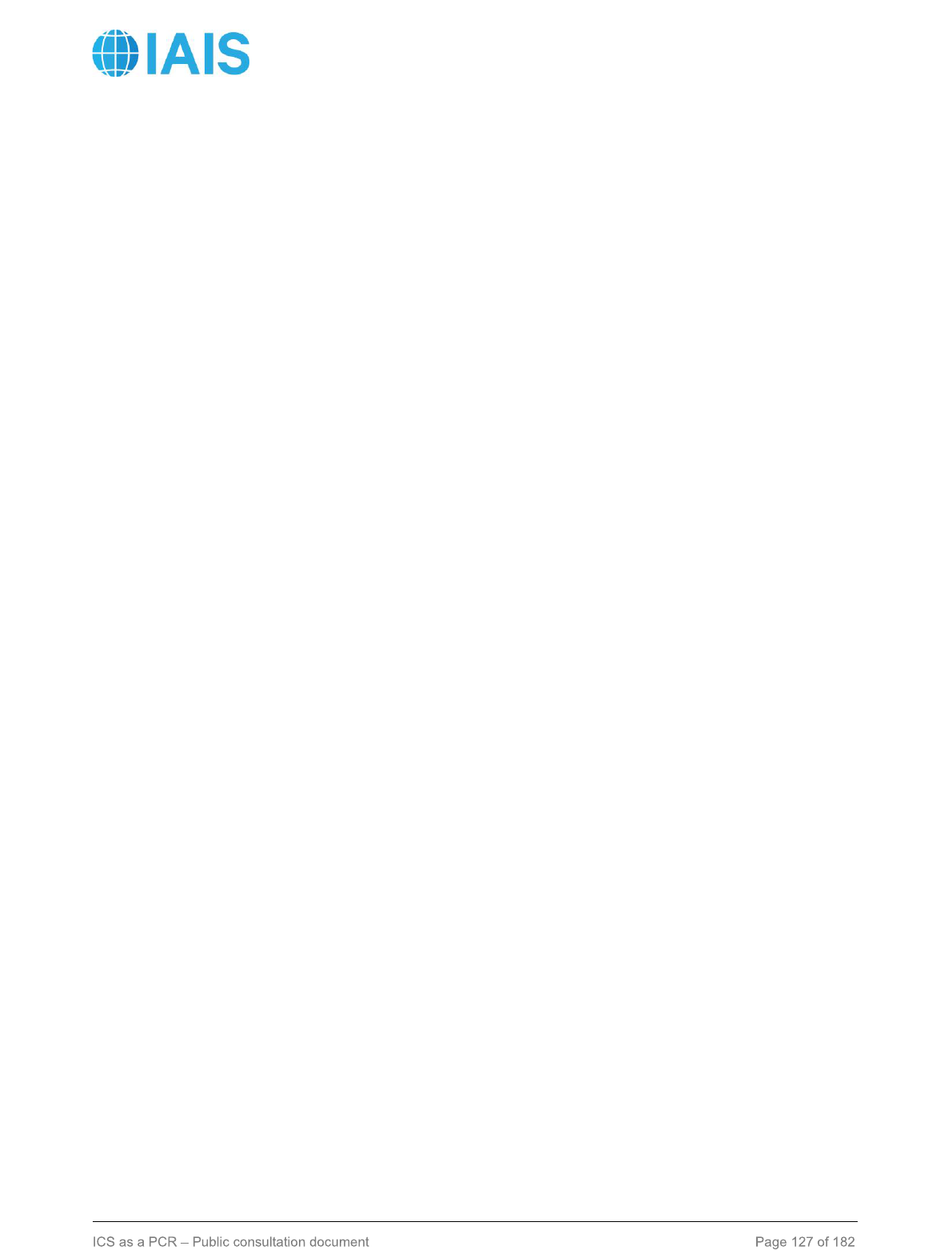
Public
L2-360. The GWS ensures that the IMAP is open by allowing any IAIG under its supervision to apply
for the use of an internal model to calculate its PCR and by stating, as the case may be, the basis
for its decision to reject the application.
L2-361. The GWS is responsible for the decision to approve or reject the IM application of an IAIG
under its supervision.
L2-362. The GWS may wish to consult with other members of the supervisory college on the review
process, the outcome of the application process and the on-going supervision.
L2-363. Finally, a model is not considered for approval unless the IAIG can demonstrate a
comprehensive and effective approach to risk management which includes establishing and
successfully achieving an internal capital target greater than the regulatory capital requirement as
indicated by the internal model.
9.4.2.1.1.1 Pre-application process
L2-364. The GWS may choose to develop a pre-application process to indicate the IAIG's
preparedness to undergo an internal model review and outline criteria that should be satisfied before
an internal model application. The process may consist of the IAIG's submission and the GWS's
review of the following four items:
a) Self-Assessment - consists of a number of qualitative and quantitative affirmations, with a
brief narrative explaining how the statistical quality test, calibration test, validation
standards, use test, governance and documentation standards are met;
b) Overview of internal model - provides the GWS with an introduction to the model and its
role within the IAIG's risk management framework;
c) Model Demonstration – provides a high-level overview of the internal model’s functionality;
and
d) Documentation Gap Analysis – initial assessment of an IAIG’s ability to satisfy the GWS’s
information request.
L2-365. The pre-application process aims to indicate the IAIG’s preparedness to undergo an internal
model review and is not necessarily an indication of internal model approval. The GWS may provide
feedback regarding any significant internal model deficiencies as soon as possible during the pre-
application and review processes so that the IAIG may have the opportunity to resolve these issues
before the start of the application process.
9.4.2.1.1.2 Application process
L2-366. The internal model application and review process can comprise several stages, including
at least the following:
a) Application for internal model approval – an application for the approval from the GWS to
use a specified internal model for the determination of the group-wide PCR of the IAIG;
b) Provision of information – quantitative and qualitative information as specified by the GWS;
c) Internal model review process – thorough model review by the GWS on an on-site and off-
site basis, with extensive dialogue and requests for supplemental information;
d) Decision on the outcome of the process; and
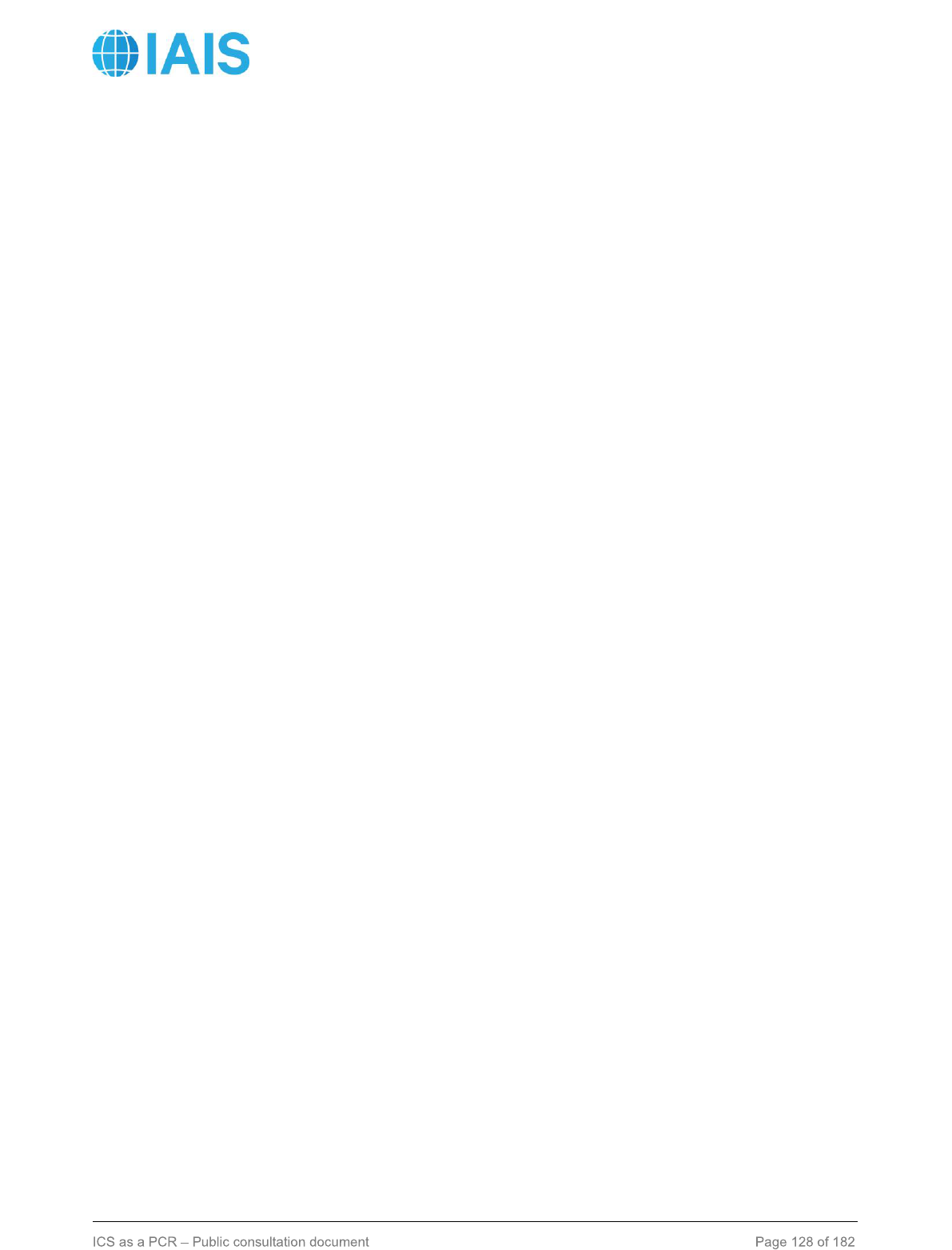
Public
e) Communication of results – communication relating to the GWS assessment of IAIG’s
internal model and response to the application to use the internal model for the calculation
of the group-wide PCR.
9.4.2.1.1.2.1 Application for internal model approval
L2-367. Upon completion of the pre-application process, if any, and confirmation of the GWS, the
IAIG may proceed with a formal application for the approval of its internal model. The application
may include:
a) A cover letter requesting the approval to use internal model to calculate the group-wide
PCR starting from a specified target date signed by the Board of Directors or its
representative; with a statement confirming that the information is accurate and complete
and that no relevant facts were omitted; a general explanation of the model, including its
structure, scope, and how it should be integrated into the standard method to calculate the
group-wide PCR in case of a partial internal model; and the contact details for relevant
personnel to whom additional information requests can be submitted;
b) An explanation of how the IAIG meets the criteria of the statistical quality test, calibration
test, validation standards, use test, governance and documentation standards;
c) An explanation of the model and how all material and quantifiable risks of the IAIG are
covered;
d) For partial internal model:
a. an explanation of the model;
b. demonstration that all material and quantifiable risks of the scope are covered;
c. the reason for the limited scope; and
d. plan for the expansion of the scope, if any
e) A justification of risks not covered by the model but considered in the standard method
covering materiality;
f) The allocation of the risks in the internal model according to the risks categories of the ICS
standard method;
g) An assessment of the proposed approach’s material strengths, weaknesses, and limitations
to determine the group-wide PCR. The identified weaknesses and limitations should be
accompanied by a plan on how to mitigate them;
h) An inventory of all the documents and sets of evidence included in the application
organised in a clear manner to a knowledgeable third party;
i) The technical documentation of the internal model;
j) The results of the proposed approach to calculating the group-wide PCR and the results of
the ICS standard method of the last three years;
k) A proposal for information disclosure to stakeholders;
l) The results of the profit and loss attribution of the last three years;
m) A log file with the model changes
n) Planned future changes;
o) A log file with the validation findings and the planned future changes; and
p) A proposal for model change policy.
The documents for the application should be complete and allow a knowledgeable third party to
understand the multiple dimensions of the model and collect evidence for the assessment, seeking
to minimise additional document requests by the GWS. They should include, but are not limited to:
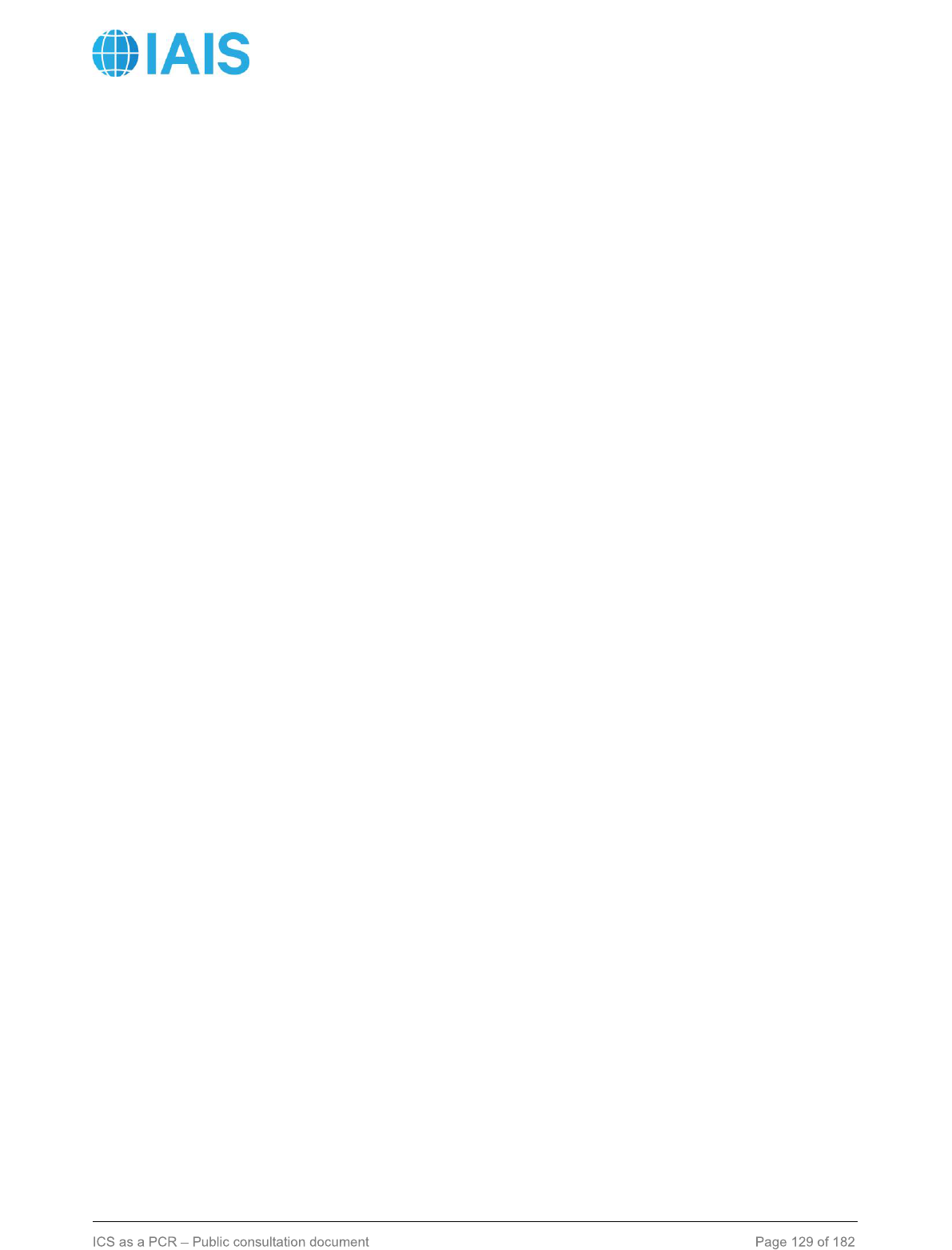
Public
a) the technical specifications of the model, and justification of the modelling choices;
b) all relevant policies and guidelines related to different aspects of the model, including
governance, calibration and validation;
c) evidence of compliance with the governance and guidelines, model use and validation; and
d) Integration in the ICS standard method in the case of partial internal model.
9.4.2.1.1.2.2 Provision of information
L2-368. For the GWS to properly consider an internal model application, the IAIG should provide
complete and timely responses to all quantitative and qualitative information requests.
The information submission process can comprise several stages and include:
a) a standardised information request to be completed at the time of application
b) a more specific request of information, which will take into account the IAIG’s unique
attributes, to be completed soon after the application is submitted; and
c) supplemental requests are to be completed at various stages during the review process to
further assist in evaluating the IAIG’s internal model.
9.4.2.1.1.2.3 Internal model review process
L2-369. The review process should involve on-site inspections and off-site monitoring and
discussions with the IAIG’s staff or representatives.
L2-370. The internal model review process is expected to include the following elements:
a) review of any documentation related to the internal model;
b) review of responses to information requests;
c) detailed model demonstrations by the IAIG; and
d) discussions with the IAIG’s management and staff.
L2-371. As part of the internal model review, the IAIG is required to provide a comparison of the
group-wide PCR calculated using the internal model with the one resulting from the ICS standard
method at the time of the internal model review.
L2-372. Also, the GWS approves the allocation of the risks in the internal model according to the
risks categories of the ICS standard method. The IAIG is able to identify the risks not covered by the
model but considered in the standard method and provide justification for not including these risks
in the internal model.
9.4.2.1.1.2.4 Interaction with supervisory college
L2-373. During the internal model approval process, the GWS keeps the supervisory college
informed of the status of the process and collect relevant views from other involved supervisors, e.g.,
local specificities such as tax rules and product features. Whilst the GWS may consider any
information received from other involved supervisors, the GWS retains the responsibility to decide
on the internal model application concerning the IAIG.
9.4.2.1.1.2.5 Decision on the outcome of the process
L2-374. Below are listed the possible outcomes of the process:
a) Approved;
b) Not approved; and
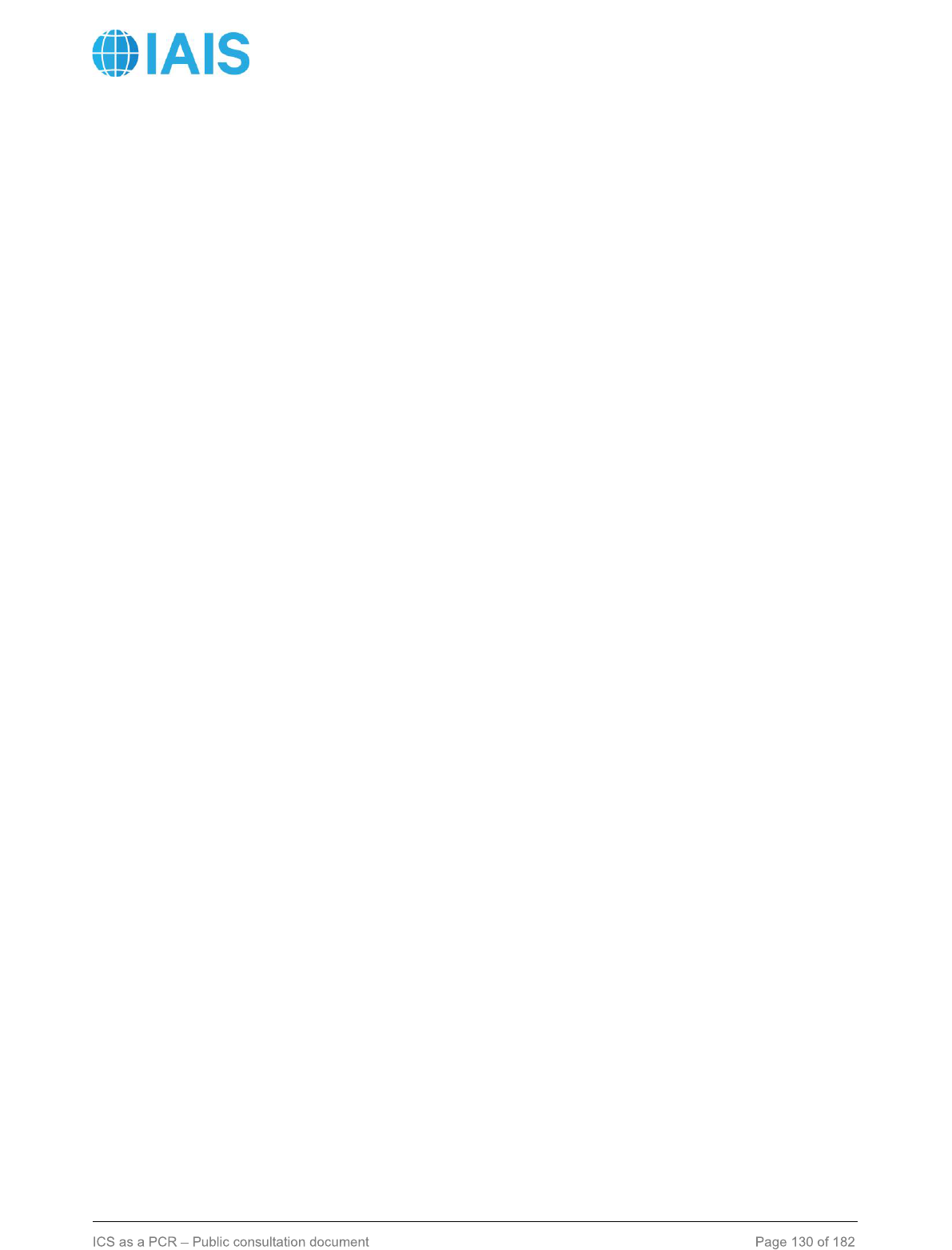
Public
c) Approved conditionally
L2-375. Should the application be approved, the GWS states the effective date and any applicable
conditions. The GWS may approve conditionally and allow the IAIG to commence using its internal
model to calculate the PCR if the areas that require further improvement or review do not prevent
the approval of the IAIG’s internal model application. Conditions may include capital floors based on
the ICS, more conservative model parameters or design features or further reviews by the GWS, the
IAIG or a third party.
L2-376. If the application is unlikely to be approved, GWS communicates this to the IAIG so the
latter can resolve the issues in a reasonable timeframe. If the identified issues cannot be resolved
within a reasonable time, the GWS does not approve the internal model application.
9.4.2.1.1.2.6 Communication of the outcome of the decision
L2-377. Before communicating the results to the IAIG, the GWS shares the results of its findings
with the supervisory college to see if any issues need to be addressed. Moreover, the GWS discloses
to the supervisory college the justification of risks not covered by the model but considered in the
standard method.
L2-378. After the review process is complete, the GWS sends a formal response to the IAIG
regarding the application to use the proposed internal model to calculate its group-wide PCR.
L2-379. If the internal model is approved, the GWS works with the IAIG to communicate the decision
to the public. Particular attention should be given to the clarity of the approved internal model’s scope
and the differences with the ICS standard method.
9.4.2.2 Post-approval monitoring and control process
L1-157. Following approval of an internal model for calculating the group-wide PCR, the GWS
requires some additional reporting regarding the internal model. The GWS conducts periodic reviews
to ensure that the internal model continues to meet the criteria of statistical quality test, calibration
test, validation standards, use test, governance and documentation standards.
L2-380. Post-approval reporting will enable the GWS to monitor internal model developments and
conduct relevant analysis and benchmarking exercises. The GWS should include the elements
necessary for benchmarking exercise in the information request.
L2-381. Specific reporting requirements relating to the internal model will be established during the
model review process. The GWS works with the IAIG in developing data submission templates for
post-approval reporting purposes. While most reporting will be required annually, some
circumstances may require more frequent filings. Reporting requirements may include:
a) standard periodic internal model output;
b) ICS standard method output;
c) narrative discussing previous and future planned changes and developments to the internal
model;
d) updated model documentation; and
e) new or updated validation reports.
L2-382. The IAIG cooperates with the GWS to establish an appropriate policy relating to post-
approval monitoring and reporting major and minor changes, including the materiality threshold in
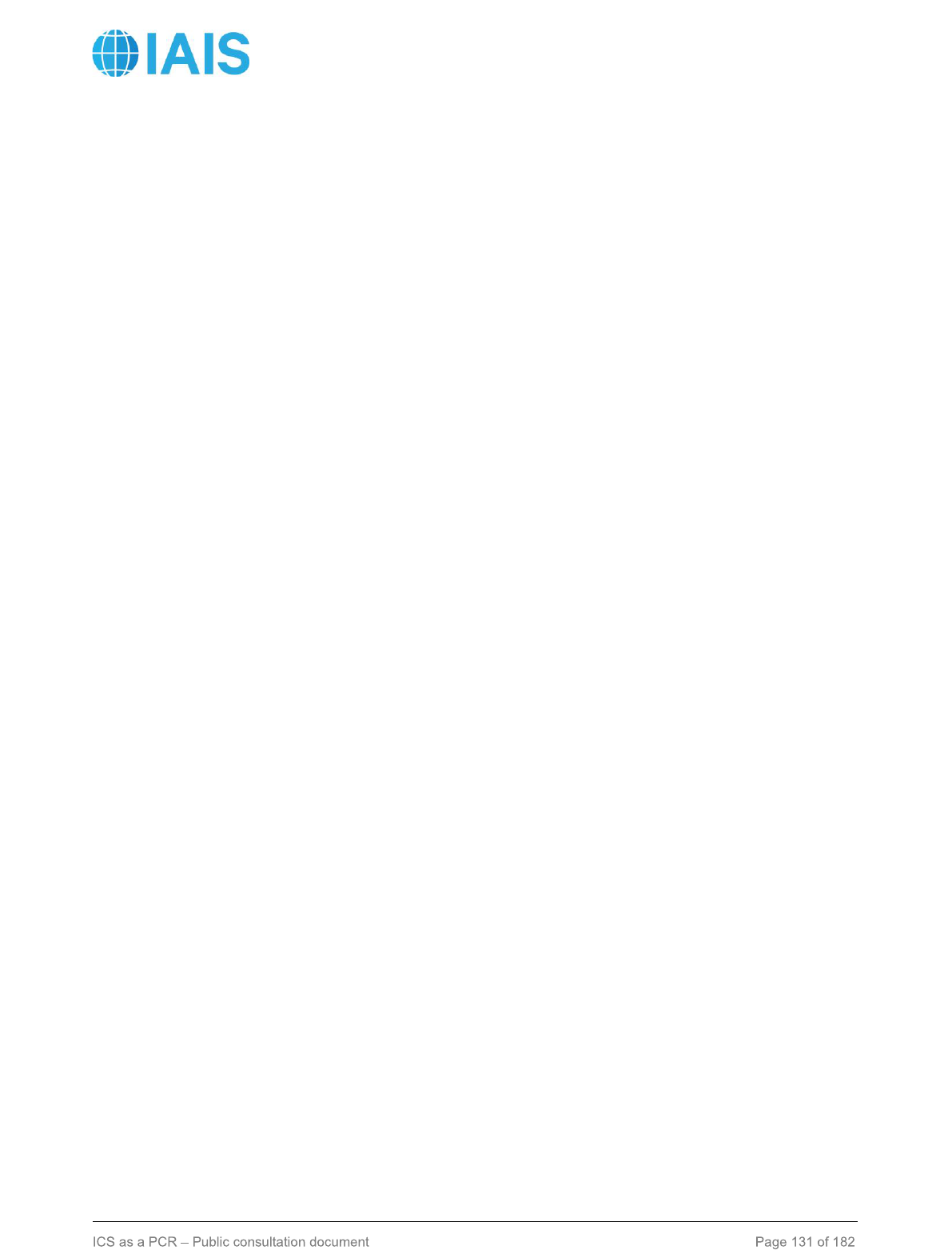
Public
relation to major and minor model modifications as described in section 9.4.4.1 on the model change
policy
L2-383. Moreover, the GWS ensures that the IAIG establishes an appropriate policy relating to
communication and public disclosure on model results and changes post-approval.
L1-158. As part of the supervisory process the GWS reviews the model post approval regularly to
assess whether the internal model deviates from the assumptions, portfolio characteristics, structure
or parameterisation used in previously approved versions, and ad-hoc reviews in case such
deviations have been identified.
L2-384. Where relevant, the post-approval internal model reviews by the GWS will focus on the
portions of the internal model that have changed. However, the GWS reserves the right to conduct
a comprehensive review on an already approved internal model at its discretion and may resort to a
capital add-on in case the deviation is material.
L2-385. Should any conditions of an internal model approval be breached, the GWS may allow the
IAIG a reasonable time to correct such breach and work with the IAIG to resolve any issues. If these
outstanding issues cannot be corrected within the allotted time, the GWS may revoke its approval of
the internal model.
L2-386. In the event that the GWS revokes approval of an internal model, the affected IAIG may
reapply once all internal model deficiencies have been resolved.
L2-387. The GWS should cooperate with other involved supervisors as part of its internal model
supervisory review. The GWS should engage in collaborative model review efforts with other
members of the supervisory college to maximise the effectiveness and consistency of outcomes of
the ICS.
9.4.3 Criteria for internal model approval
L1-159. The IAIG is responsible to ensure and provide evidence that the model complies with all the
requirements in this section and the GWS should be satisfied that these requirements are met.
9.4.3.1 Statistical quality test
9.4.3.1.1 Scope, theory and structure of the internal model
L1-160. The scope of the internal model is complete by including all material quantifiable risks in
assets, liabilities, legal entities and lines of business within its intended scope. The methods used in
the internal model are based upon current and credible information and realistic assumptions.
L1-161. The data used is accurate, complete and appropriate. The parameterisation approach is
well justified, consistently implemented, tested and documented. The documentation of the scope of
the internal model covers how materiality has been assessed.
L2-388. The base quantitative methodology of the internal model is in line with generally accepted
market practice and robust actuarial and statistical theory. More specifically, the methodology and
technology implementation used for this should be perceived as an industry standard or better.
L2-389. The structure of the model is clear, logical and consistent with how business is managed.
L2-390. The IAIG explains the appropriateness of the chosen methodology taking into consideration
the nature, scale and complexity of the risks.
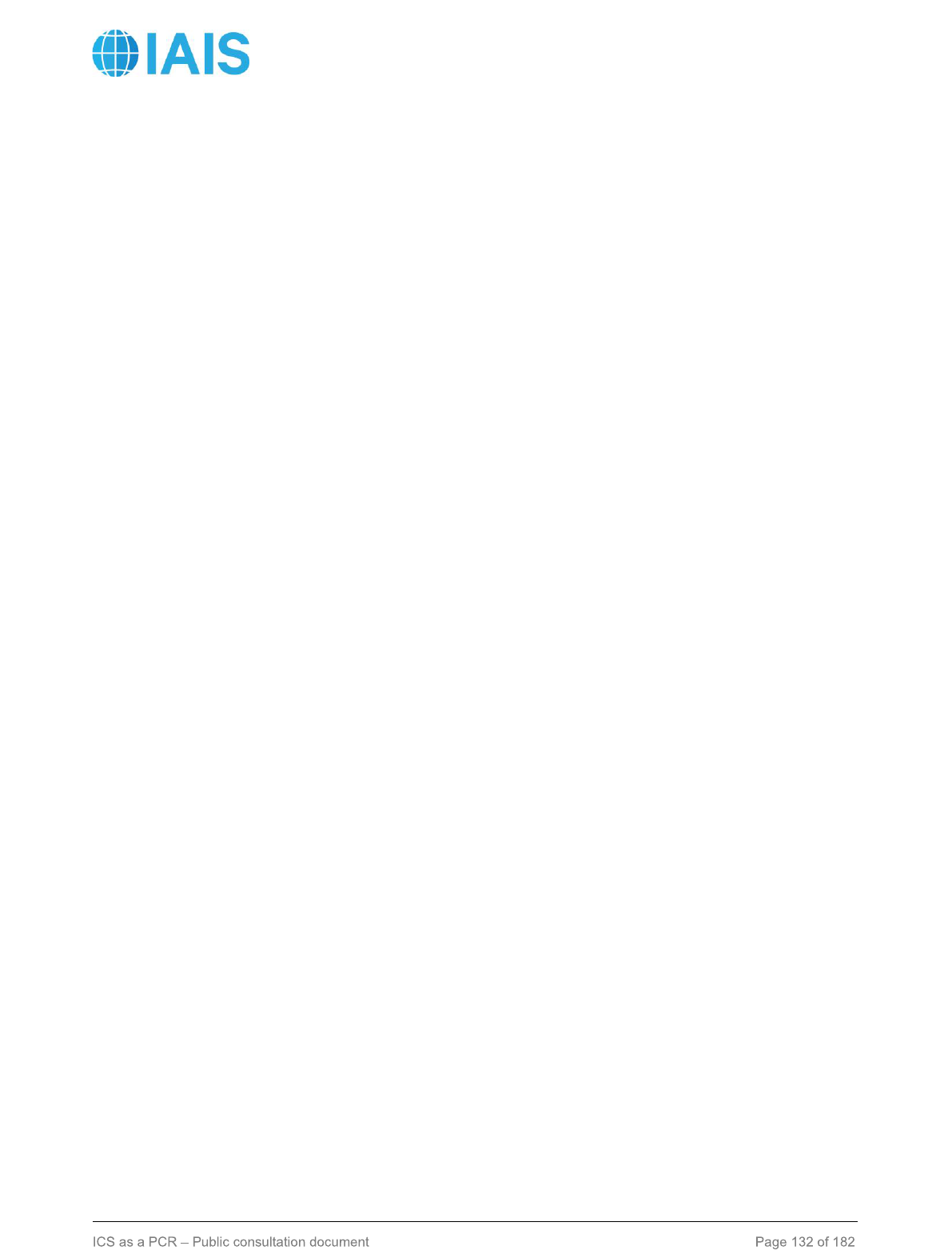
Public
L2-391. In addition, for everything within the scope of the internal model, it has demonstrated an
approach to differentiate between the materiality of the risks being taken by the IAIG. The internal
model allows for changes in the risk profile over time adapt to foreseeable risks, which can be
achieved by parameterisation or model changes. If future management actions are considered, they
follow the principles below:
a) Be objective, realistic and verifiable;
b) They cannot be contrary to the IAIG’s obligations to policyholders or legal provisions
applicable to the IAIG;
c) Are consistent with the IAIG’s current business practice and business strategy unless the
GWS is satisfied that there is sufficient evidence that the IAIG will change its practices or
strategy;
d) Can reasonably be expected to be carried out under the specific circumstances to which
they apply; and
e) The assumptions about future management actions take into account the time needed to
implement them, as well as any resulting incremental expenses.
L1-162. Risk mitigation techniques may be recognised in the ICS risk charges provided they meet
the requirements specified in the Level 2 text.
L2-392. In order to be recognised, a risk-mitigation technique should meet the following criteria:
a) The risk mitigation technique is effective and legally enforceable in all relevant jurisdictions
and results in an effective transfer of risk to a third party;
b) The contractual arrangement has been reviewed to ensure that the risk transfer is clearly
defined;
c) The calculation of the ICS risk charges allows for the effects of risk mitigation techniques
through a reduction of the risk charge commensurate with the extent of risk mitigation. That
reduction makes a reasonable allowance for any basis risk effects due to changes in risk
mitigation assumptions and relationships including during tail events, and there is an
appropriate treatment for any corresponding risk embedded in the use of risk mitigation
techniques (eg counterparty default). These two effects are treated separately;
d) There is no double-counting of mitigation effects;
e) The documentation for the arrangement sets out a direct claim on the IAIG’s counterparty
in the event of its default, insolvency, bankruptcy or other credit events; and
f) Consideration of the credit quality of the providers of the risk mitigation is made within the
internal model.
L2-393. The methodology to calculate the ICS capital requirement are consistent with the methods
to calculate the ICS Current Estimate.
L2-394. The IAIG decides the best way to consolidate and account for the risks to the whole of its
business.
L2-395. The determination of overall regulatory capital requirements with the internal model
considers dependencies within and across risk categories. Key variables leading to dependencies
must be identified and modelled, tail dependencies and non-linear effects must be adequately
captured. Where the internal model allows for diversification effects, the IAIG justifies its allowance
for diversification effects and demonstrate that it has considered whether dependencies may
increase under stressed circumstances.
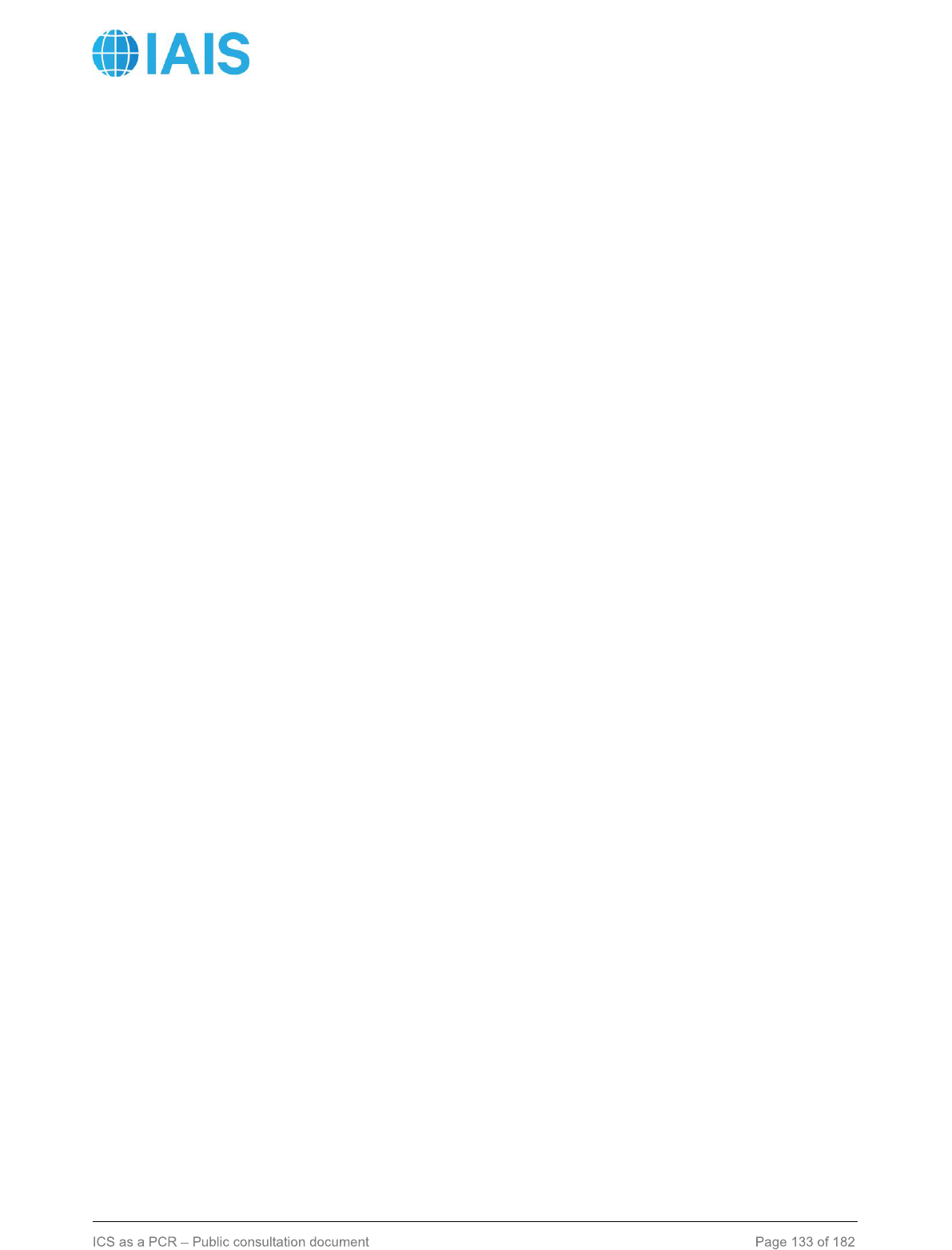
Public
9.4.3.1.2 Assumptions
L2-396. The main assumptions of the model has a sound theoretical and empirical justification,
including the circumstances under which the assumptions would be considered false and provide a
rationale for not using alternatives.
L2-397. Where simplifying assumptions are used, this is clearly defined and documented.
9.4.3.1.3 Data
L2-398. The length of data has sufficient historical information to assess the characteristics of the
underlying risks, and no relevant data is excluded from the use in the model without justification.
Where historical data is deemed insufficient, this may be complemented with expert judgment.
L2-399. The data is accurate and consistent, free of material errors and recorded consistently over
time, and is part of the validation process.
L2-400. The data is appropriate, fit for its purposes and reflect the relevant risks to which the IAIG
is exposed.
L2-401. Nonetheless, the model still allows for outcomes not directly observed in past data but to
which the IAIG may be exposed in the future, eg new business classes or tail risks.
L2-402. In addition, data extensions, capping or modification is documented and justified. The
process for dealing with outliers and data-smoothing is performed in a way that does not materially
underestimate the actual volatility of the risk.
L2-403. The data used for estimations is up-to-date, recorded on time and updated at least annually,
and the IAIG minimises the gap between the end-of sample data and the calibration date.
L2-404. The IAIG has a data policy that is consistent with the provisions above and demonstrate
that they comply with it.
9.4.3.1.4 Parametrisation
L2-405. The parameterisation methods are in line with appropriate actuarial and statistical practices.
The latter includes an explanation for the input and the reasoning for the selection among several
candidates.
L2-406. When parameterisation is made using expert judgment, this is in compliance with the IAIG's
policy on expert judgment.
L2-407. Parameterisation results are reasonable, up-to-date and validated. The IAIG defines
minimum fitting requirements, such as R
2
, chi-square statistics, q-q plots, residual analysis,
whenever possible. Whenever appropriate, the IAIG perform stress testing and sensitivity analysis
when choosing model parameters. Parameter risk are taken into consideration whenever material.
L2-408. The parameterisation is revised at least once a year. In the event of material differences in
the parameters between exercises, this is explained and justified.
9.4.3.2 Calibration test
L1-163. The IAIG may use a different confidence level, risk measure or time horizon than Value-at-
Risk (VaR) at 99.5% confidence level over the one-year time horizon for internal modelling purposes
as long as the outputs of the internal model can be used by the IAIG to calculate the ICS Requirement
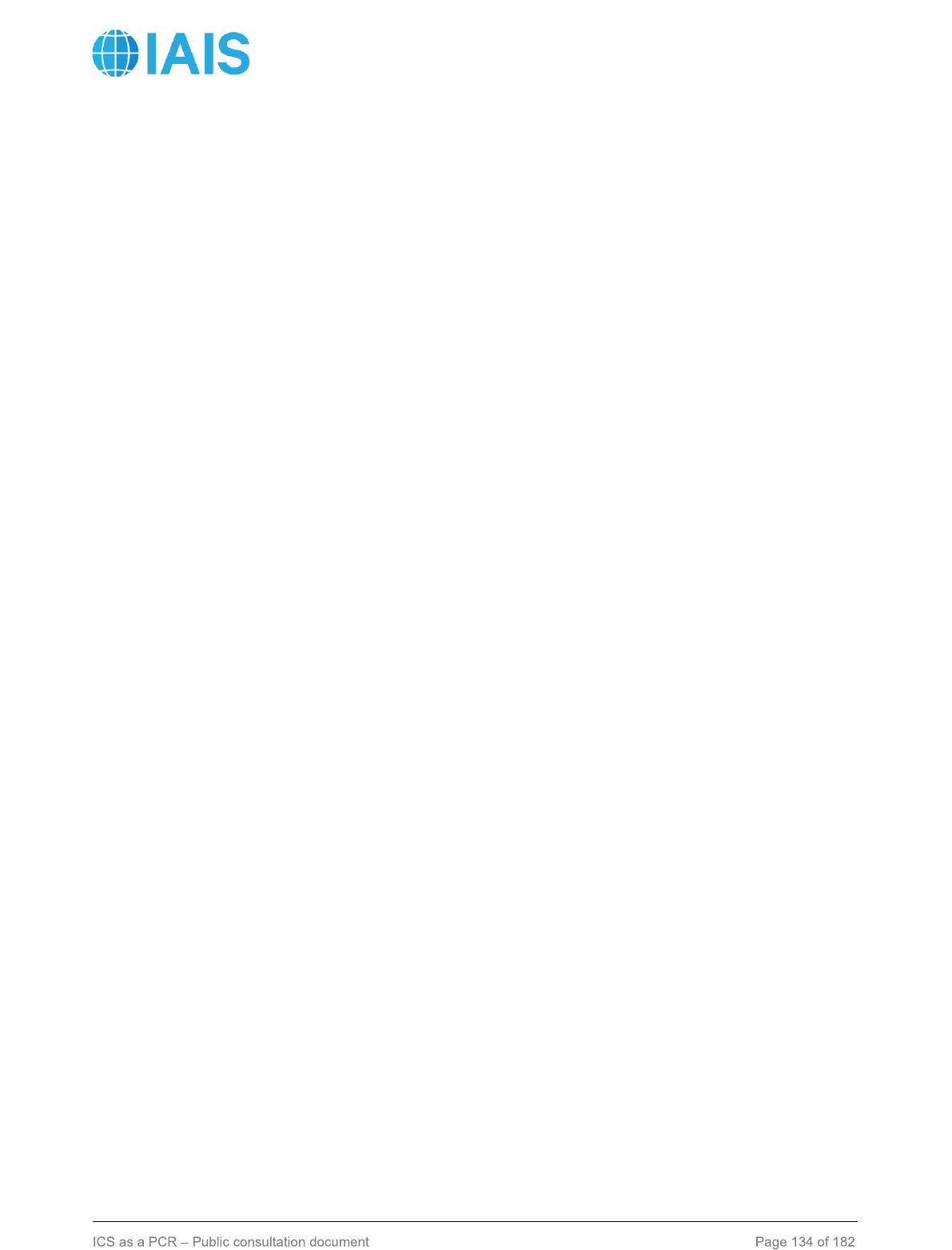
Public
in a manner that provides policyholders and beneficiaries with an equivalent or higher level of
protection.
L2-409. Where an IAIG uses a different confidence, risk measure or time horizon than the one set
out for the ICS standard method, capital requirement calculations provides evidence on how the
model outcomes compare to the ICS target criterion (ie VaR 99.5% over a one-year time horizon).
L2-410. Where the IAIG cannot derive the ICS capital requirement directly from the probability
distribution forecast generated by the internal model, the GWS may allow approximations to be used
in the process to calculate the ICS capital requirement, as long the IAIG can demonstrate to the
GWS that policyholders are provided with a level of protection at least equivalent to VaR at 99.5%
confidence level over the one-year time horizon.
9.4.3.3 Use test and governance
L1-164. The IAIG explains the different uses of their internal model and how they ensure consistency
between the different outputs where the internal model is used for different purposes.
L1-165. The internal model is adequately fit how business and risks are managed:
a) The modelling approaches reflect the nature, scale and complexity of the risks inherent in
the activities of the IAIG, which are within the scope of the internal model;
b) The outputs of the internal model and the content of the internal and external reporting of
the IAIG are consistent; and
c) The internal model is capable of producing outputs that are sufficiently granular to play an
important role in the relevant management decisions of the IAIG. Furthermore, IAIG are
able to run the model in a promptly and timely manner, in case model outputs are need to
decision-making outside form the usual reporting timeline.
The model is widely used and play an important role in the system of governance of the IAIG and
how business and risk are managed.
L2-411. The model is used for, but not limited to, for example in:
a) Strategic and business planning and business management;
b) Risk management, economic capital calculation, and own risk and solvency assessment;
c) Risk appetite setting;
d) Measurement of risk-adjusted performance and performance management;
e) Reporting, decision making, communication and feedback loop development; and
f) The internal model is sufficiently used in Profit and Loss (P&L) Attribution.
L2-412. Profit and Loss (P&L) Attribution compares the internal model’s predicted profit and loss
with the actual profit and loss incurred.
L2-413. The IAIG should demonstrate that the model is fully embedded in its operational and
organisational structure and confirm that it remains valid and is applied consistently over time.
L2-414. The Board and Executive Management of the IAIG are able to demonstrate an overall
understanding of the internal model including their major assumptions, strengths and limitations.
L2-415. The persons who effectively run (Executive and Senior Management) the IAIG and staff
who run the internal model is able to demonstrate a sufficiently detailed understanding of the parts
of the internal model used in the area for which they are responsible.
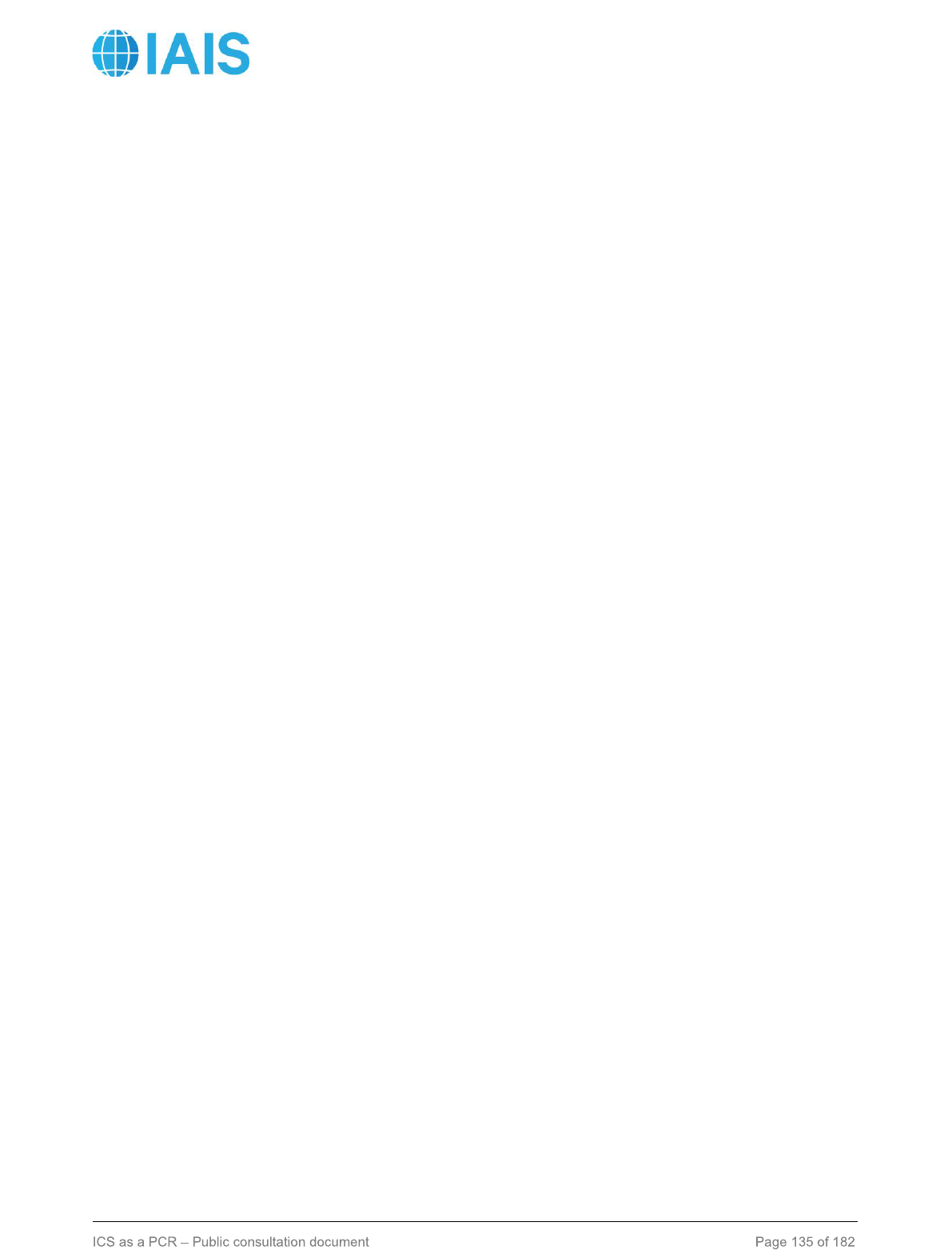
Public
L2-416. The Board, executive and senior management receives appropriate training on the internal
model.
9.4.3.3.1 Model governance
L1-166. Model governance structure, roles, and responsibilities are clearly defined by the IAIG and
considered appropriate by the GWS.
L2-417. The IAIG Board is responsible for ensuring the ongoing appropriateness of the design and
operations of the internal model and that the internal model continues to appropriately reflect the risk
profile of the IAIG.
L2-418. The risk management function has Board delegated responsibility for the ongoing
maintenance, use, application and validation of the internal model.
L1-167. The model's governance structure is clearly defined and documented, and this includes
reporting lines, allocation of responsibilities and escalation paths.
L2-419. The IAIG has documented procedures for appropriate segregation of duties between those
responsible for building, operating and maintaining the model and those responsible for making
decisions based on the model's output.
L1-168. Mechanisms to prevent conflicts of interest are in place and addressed in the model's
governance framework.
L2-420. The resources that operate the model are adequate with respect to the nature, scale and
complexity of the risks modelled.
L2-421. There are adequate and effective controls in place in relation to the operation and
maintenance of the internal model.
9.4.3.4 Validation standards
L1-169. The regular validation process aims to ensure the ongoing appropriateness of the design
and operations of the internal model and that the internal model continues to appropriately reflect
the risk profile of the IAIG.
L2-422. The internal model validation process specifies the following:
a) Scope of validation;
b) Processes, methods, and tools to be used;
c) Frequency of validation; and
d) Persons involved, roles, reporting lines and escalation paths.
L1-170. The model validation process applies to all internal model parts and cover all requirements.
L2-423. The IAIG demonstrates that the model has been validated independently (externally or
internally) from those who develop, change, update, run, and use the model.
L2-424. Internal model validation requires the IAIG to have model validation reports covering model
components and the entire model. The reports document the validation process and conclude on
the adequacy of the model component or model being validated and the appropriateness of the
resulting capital charge for the regulatory capital.
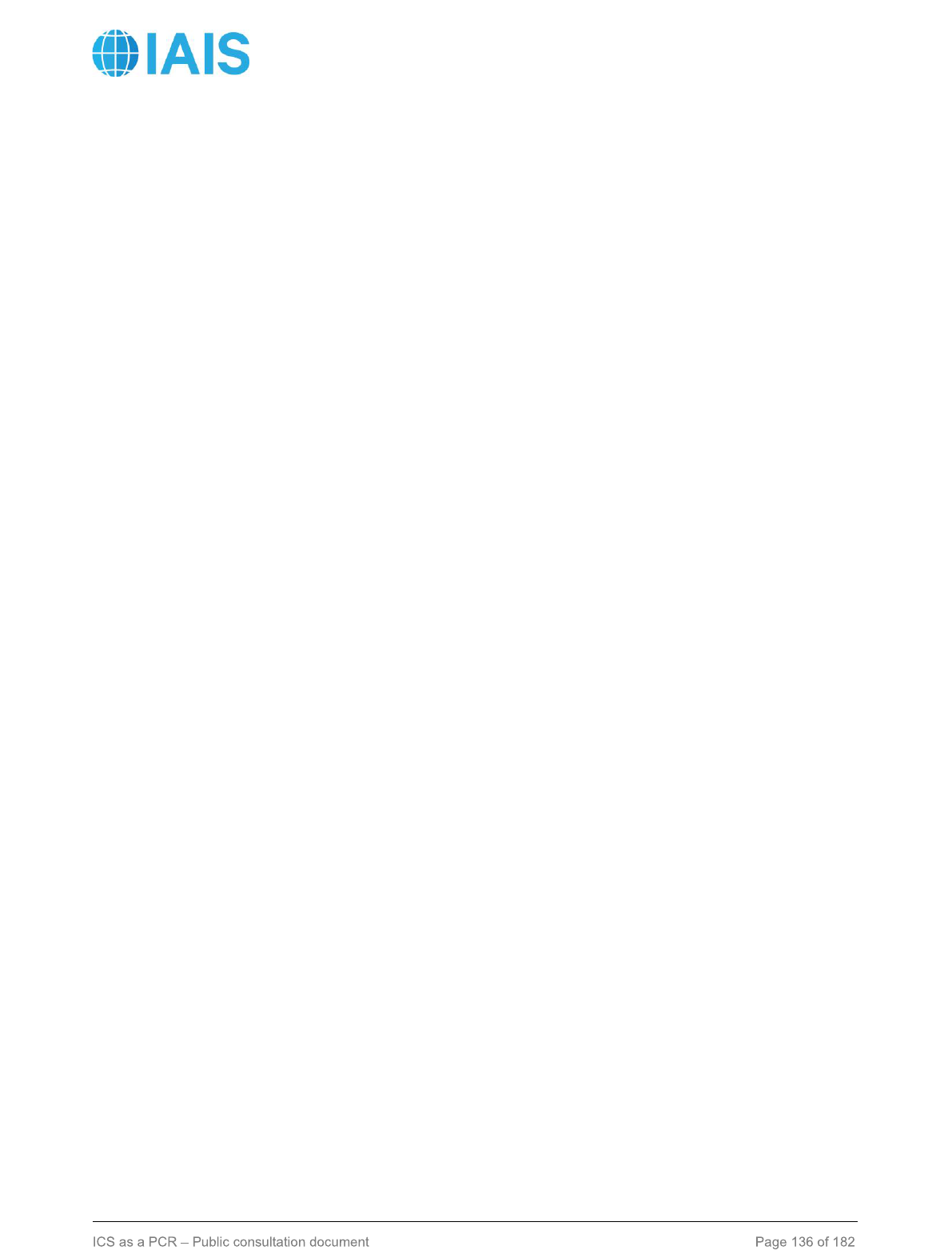
Public
L2-425. There is a clearly defined remediation and follow-up process for model validation findings,
an action plan, and implementation monitoring.
L2-426. As part of the validation process, the IAIG performs at a minimum and obtain reasonable
results and insights from inter alia:
a) Sensitivity testing, stress testing and scenario analysis, including reverse stress testing;
b) Back-testing;
c) Stability testing;
d) Profit and loss attribution; and
e) Other validation tools, such as benchmarking or alternative methods/models.
9.4.3.5 Documentation standard
L1-171. Model documentation allows a knowledgeable third party to understand the design and
details of the internal model and form a sound judgment as to its compliance with regulatory
requirements.
L2-427. The documentation provides a detailed description of the structure, scope, theory, data,
assumptions, expert judgment, parameterisation, results, validation, model changes, model
governance and model policies. Furthermore, the documentation details all key software, external
models (including their customisation) and data and the reasons for their use.
L2-428. The model documentation, processes including roles and responsibilities are covered by
the model governance. The documentation is appropriately structured and may include an inventory
of all the documents forming the internal model documentation.
L2-429. Finally, the documentation identifies the main limitations and weaknesses of the internal
model and conditions under which the model may not adequately determine the IAIG's capital
requirement.
9.4.4 Additional considerations
9.4.4.1 Model change policy
L1-172. Internal models may need to change over time, particularly when it no longer captures the
underlying risk in its entirety.
L1-173. There is a model change policy that sets out the governance requirements in relation to
changes to the internal model, including internal approval, internal communication, documentation
and validation of changes and implementation.
L1-174. The policy addresses the following:
a) the definition of major and minor changes;
b) how these are assessed; and
c) the governance and decision-making process for such changes.
L2-430. The model change policy defines how minor model changes may be aggregated over time
and when a combination of minor changes is considered a major change.
L2-431. Major changes to the internal model, as well as changes to that policy, are always subject
to prior supervisory approval.

Public
L2-432. Minor changes to the internal model are not subject to prior supervisory approval insofar as
they are developed in accordance with that policy.
L2-433. There are formal criteria and processes to assess model changes and ensure these are
appropriate, these include:
a) impact on the ICS capital requirement and on the relevant risk charges and diversification
benefits, changes in model scope;
b) structure and theory/methodology;
c) data sources and external model changes and changes in the system of governance;
d) validation framework;
e) model policies; and
f) model use.
L2-434. Model changes are appropriately documented, implemented and communicated to the
GWS.
9.4.4.2 Expert Judgement
L1-175. The IAIG has a thorough governance process concerning all inputs that are subjected to
expert judgment.
L2-435. The IAIG grades all inputs that are subjected to expert judgement by the level of uncertainty
and impact in the model, and demonstrate that they comply with it.
L2-436. Where expert judgment is employed, this is documented. The supporting documentation
describes the assumptions used, their materiality, the rationale for the opinion, the experts involved,
the qualification of the experts, the appropriateness of the judgment being made, the intended use
and the period of validity.
L2-437. Expert judgments is approved at levels of sufficient seniority according to their materiality.
To assess the materiality of expert judgments, quantitative and qualitative indicators may be
considered.
L2-438. The process and the tools for validating the assumptions and using expert judgment are
documented and in compliance with the expert judgment governance.
9.4.4.3 External models and data
L1-176. External models used in parts of the internal model adhere to the same standards as the
internally developed parts of the internal model.
L1-177. The GWS ensures there is an appropriate understanding of the validation process for and
results of external models within the IAIG.
L2-439. Where external data is used, the IAIG demonstrates an appropriate understanding of its
limitation and adherence to the risk profile, and it is in compliance with the data and expert judgment
governance.
L2-440. External data and expert judgement are in the scope of model validation.
9.4.4.4 Ongoing appropriateness of the model
L1-178. The IAIG ensures the ongoing appropriateness of the design and operations of the internal
model and that the internal model continues to appropriately reflect the risk profile of the IAIG.

Public
L2-441. The IAIG develops benchmarking studies that allow them to monitor the evolution of the
model overtime, defining indicators that allow understanding of how the model evolved in comparison
to its risks and the cumulative effect of model changes. Approximations for the cumulative effect can
lead to appropriate results such that it may not be necessary for the IAIG to calculate the capital
charges using different development stages of the internal model. The indicators are not limited to
ICS standard method.
L2-442. The persons who effectively run (Executive and Senior Management) the IAIG and staff
who run the internal model receive appropriate training on the IM periodically. They are able to
demonstrate a sufficiently detailed understanding of the parts of the internal model used in the area
for which they are responsible.
L2-443. The IAIG ensures that the teams involved with the IM are adequately staffed and that the
model knowledge is maintained over time.
L2-444. The rigour of the validation process is maintained over time and ensures that the standards
under which the IM was approved are maintained. The validation process includes regular internal
model reviews post-approval to assess whether the internal model deviates from the assumptions,
portfolio characteristics, structure or parameterisation used in previously approved versions, and ad-
hoc reviews in case such deviations have been identified. In addition, the validation process ensures
that the IM continues to be perceived as an industry standard or perceived best practice. The IAIG
informs the GWS in due time if it becomes aware that the internal model may not be longer compliant
with the requirements imposed by the GWS.
9.4.4.5 Non-insurance entities
L2-445. For financial non-insurance entities with a sectoral capital requirement, the capital
requirement should be consistent with the equivalent requirements under the ICS standard method
(L2-340). For non-financial entities, the IAIG can use an internal model if it can demonstrate that the
risks being run are covered and validated within it or, failing that, the IAIG can use a partial internal
model with the approach specified under the standard method for non-financial entities.
9.4.5 General provisions on the use of partial internal models (PIM)
9.4.5.1 Framework for partial internal models
L1-179. An IAIG may use an internal model if the requirements specified in earlier sections are met.
The internal model is considered as partial if at least one of the conditions below are met:
• The scope of the PIM does not cover all quantifiable risks identified; and
• The scope of the PIM does not cover the entire insurance business within the group. For
instance, a specific portfolio, or an entity is not covered.
9.4.5.2 Justification of the scope of partial internal models
L1-180. An application for approval of a PIM includes the evidence of such compliance, as well as
a proper justification for the limited scope of the model.
L2-446. The IAIG explains how the capital requirement resulting from the PIM reflects more
appropriately the risk profile of the IAIG.
L2-447. In case the model is partial in terms of business coverage, the explanation provided
specifies the reasons for excluding certain business from the internal model and demonstrate that
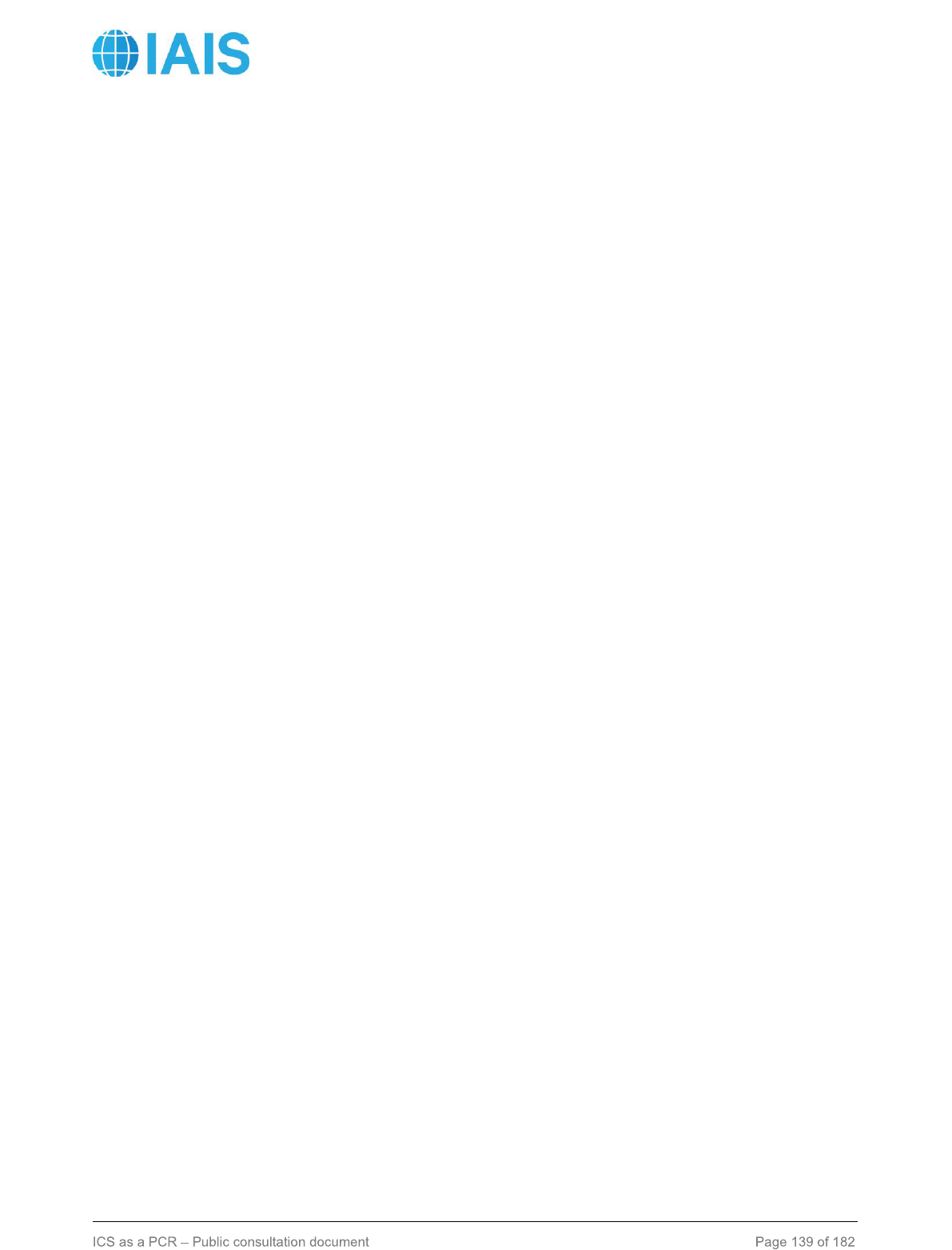
Public
the overall risks to which the group is exposed are not underestimated by using a partial internal
model (e.g. cherry-picking).
L2-448. When assessing an application for the use of a PIM, the GWS considers at least the
following:
• the materiality and risk profile of the business excluded with respect to the risk profile of the
IAIG; and
• the appropriateness of the standard approach for the calculation of the capital requirement
of both the business included in the scope of the internal model and for the business excluded
from the scope of the internal model. In particular, the GWS should assess whether the
exclusion of a business could lead to:
o an inadequate capital requirement in relation to the risk profile of the group;
o an improper allocation of own funds based on the capital requirements of the
excluded business rather than on its contribution to the risk profile of the IAIG; and
o weaknesses in risk management of the IAIG and its business resulting from the
limited scope of the internal model.
L2-449. When assessing an application for the use of a PIM that only covers certain risks, or part of
the business of an IAIG, the GWS may require the IAIG to develop a realistic transitional plan to
extend the scope of the model. The transitional plan should set out the manner in which the IAIG
plans to extend the scope of the model to other risks, portfolios or entities, in order to ensure that
the model covers a predominant part of their insurance operations with respect to that specific risk
module. In such case, the GWS should consider whether mitigation measures are necessary until
the transitional plan is completed, such as terms and conditions or a capital add-on.
9.4.5.3 Integration of partial internal models
L1-181. The capital requirement resulting from a PIM is fully integrated into the capital requirement
obtained from the standard approach and vice versa.
L2-450. In the case of a PIM, it might be more appropriate to calculate the capital requirement for
different risk components separately and integrate them directly into the standard approach without
further aggregation in the internal model use. For instance, the PIM could cover the market risk
module and the non-life underwriting risk module, which are not integrated under the same
probability distribution but directly integrated to the standard approach.
L2-451. The integration technique used is considered part of the PIM and should be approved by
the GWS.
L2-452. As a default integration technique, IAIG should consider the correlation matrices and
formulas of the standard approach set out in the ICS Technical Specifications
L2-453. If the IAIG demonstrates to the GWS that it would not be appropriate to use the standard
approach correlations, an alternative technique can be submitted for approval to the GWS. The IAIG
should demonstrate the appropriateness of the integration technique proposed. The integration
technique used should ensure a level of protection for policyholders in line with the ICS risk measure
and time horizon. It should also reflect the IAIG’s risk profile.
L2-454. The assessment of the integration of PIM results should be regularly validated by the IAIG,
in particular when there is a material change to the PIM or to the IAIG’s risk profile.
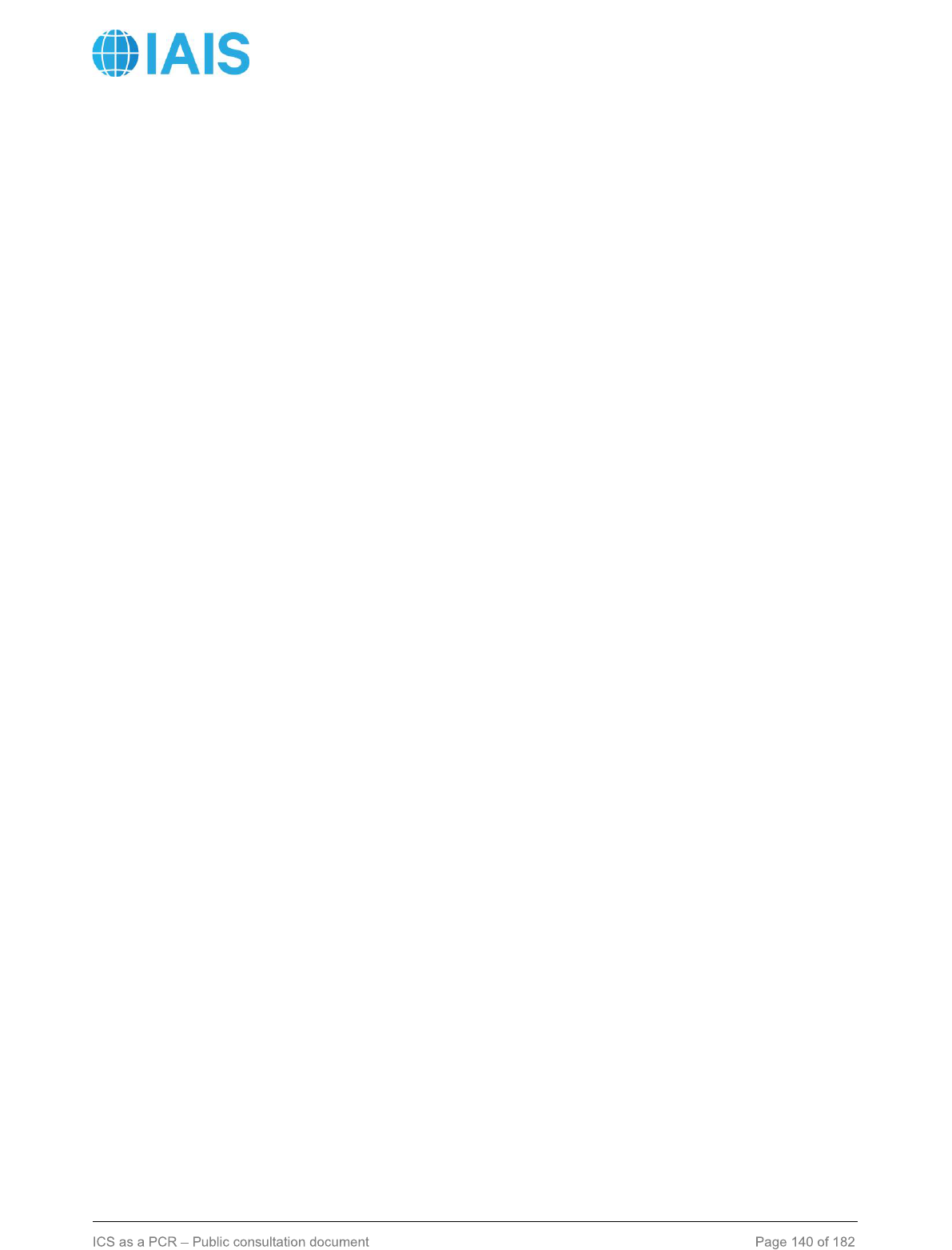
Public
L2-455. The annual reporting to the GWS should allow identifying the capital requirements
stemming both from the PIM and from the standard approach in a way that allows the estimation of
the diversification benefit obtained from the integration of both parts.
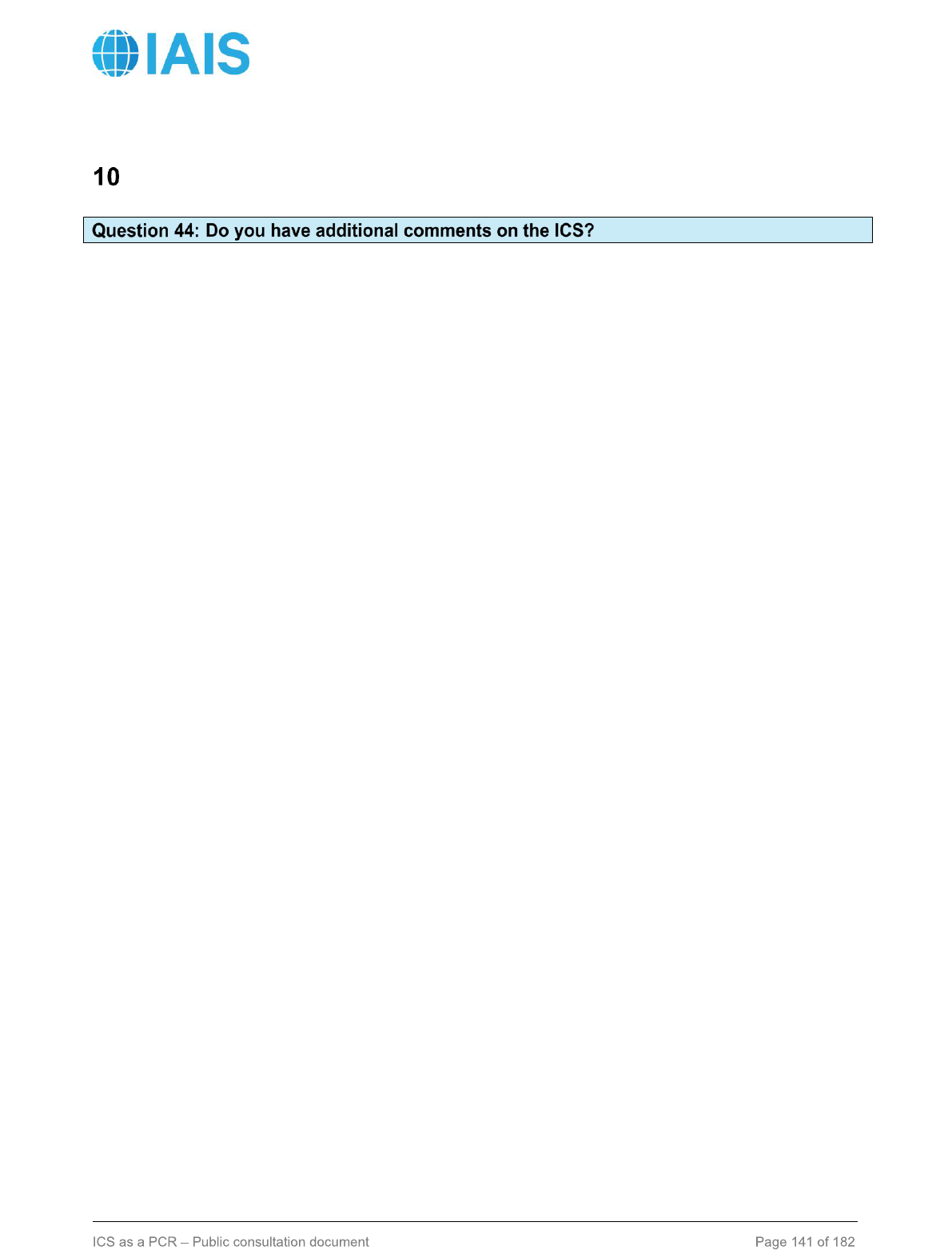
Public
General feedback
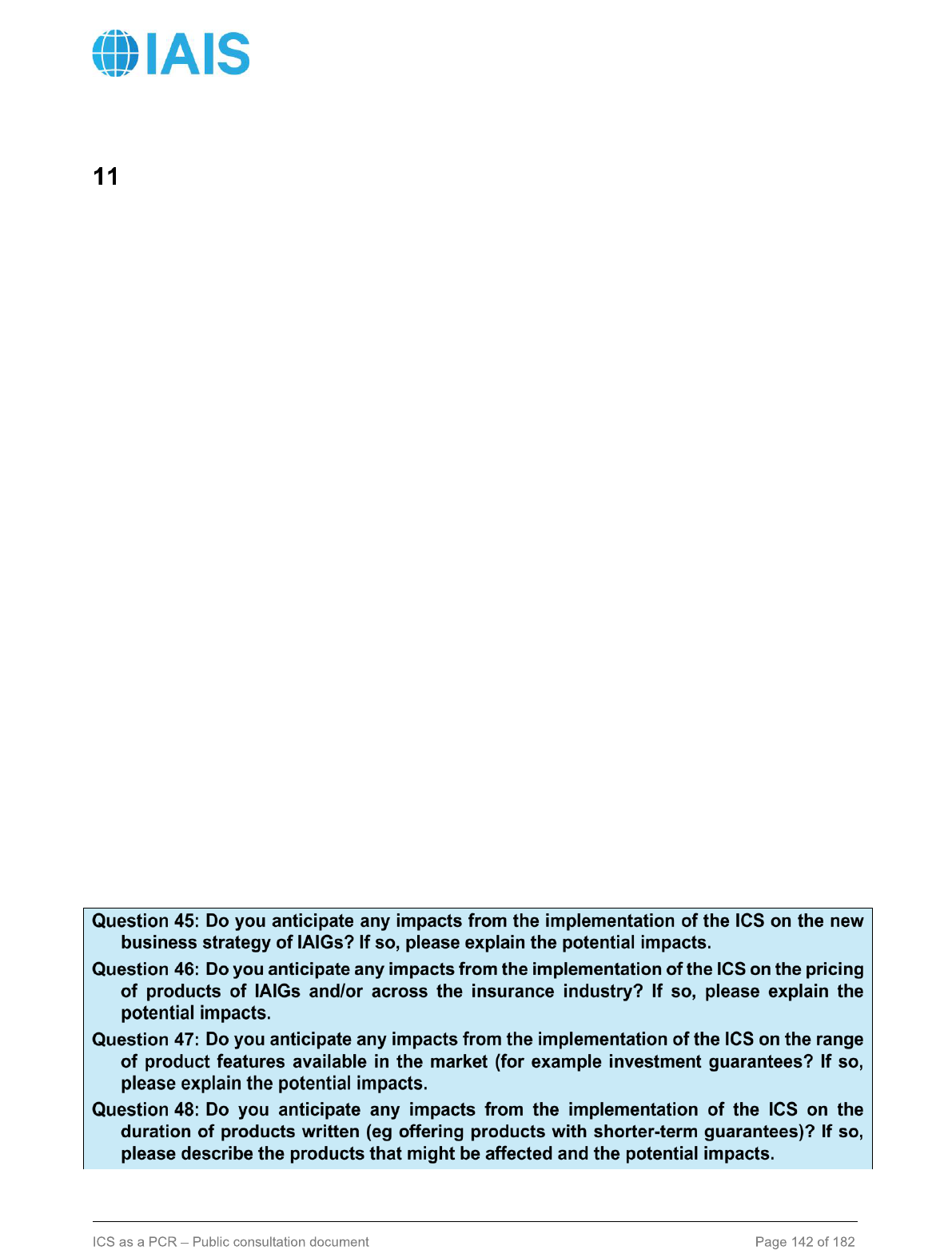
Public
Economic Impact Assessment
The IAIS will be conducting an Economic Impact Assessment of the ICS during 2023 and 2024 as
part of the process for the ICS monitoring period. This assessment will focus on evaluating the
impacts that the implementation of the ICS may have on:
• Insurance products offered by IAIGs, particularly with regards to long-term products, their
guarantees, duration and features, and potential risks of protection gaps;
• Investment policies of IAIGs, particularly with regard to significant changes in asset
allocations, notably in response to shocks in financial markets to estimate the risk of
procyclical behaviour or fire sales or with the broader consideration of the economic role of
insurers as institutional investors;
• The ability of IAIGs to raise capital or debt; and
• More generally, the business models of IAIGs and their profitability.
Importantly, these impacts will be considered together with the objectives of the ICS and the
anticipated benefits in terms of facilitating cross-border supervision of IAIGs, reducing regulatory
fragmentation or arbitrage, developing a comparable risk-based measure of risk and capital
adequacy, fostering policyholder protection and contributing to financial stability.
The assessment provides an opportunity for the IAIS to explain the objectives of the ICS and the key
principles followed by the IAIS in developing the ICS and how those objectives have been met and
to formulate an understanding of the potential impact of its implementation as a prescribed capital
requirement.
In responding to the following questions, please use the candidate ICS as a PCR as the basis for
your considerations. The candidate ICS as a PCR allows for the use of the prescribed Other Methods
for calculating capital requirements (ie SOCCAs and Internal Models).
As a reminder, the ICS is applicable solely to IAIGs; it is not a prescribed capital requirement for
individual insurance legal entities or insurance groups that are not identified as IAIGs.
11.1 Impact on product availability
One of the main concerns expressed during discussions with IAIS members and stakeholders is the
potential for the ICS to have a negative impact on the functioning of insurance markets and restrict
the availability of certain types of long-term insurance products in certain regions or markets.

Public
11.2 Impact on IAIGs’ business models and capital position
The ICS is not intended to result in an increase in overall capital requirements; however, the
implementation of the ICS might result in changes to the capital position and risk sensitivity for some
IAIGs. This could result in changes to an IAIG’s business model and impact the profitability of some
of its products, business units, or legal entities.
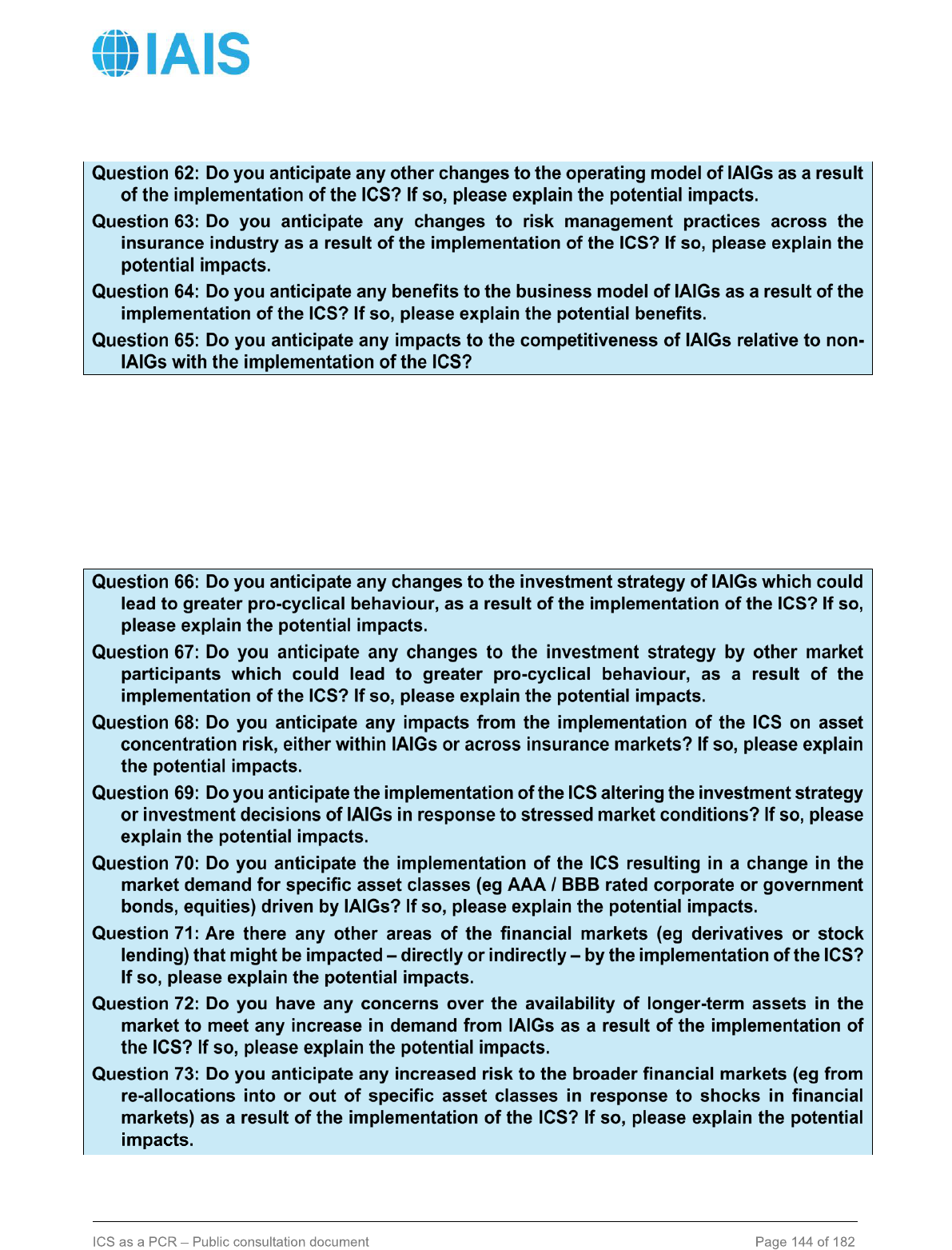
Public
11.3 Impact on financial markets
An area of concern raised by both member and stakeholders is the potential impact of the ICS on
investment markets and the ICS being a driver of pro-cyclicality in broader financial markets. The
risk to be assessed is whether the ICS might lead to convergence of investment strategies of IAIGs
to a limited pool of assets whose price movements might then be magnified under specific
investment conditions. The concern is that this concentration of exposure has the potential to lead
to pro-cyclicality in the broader financial markets.
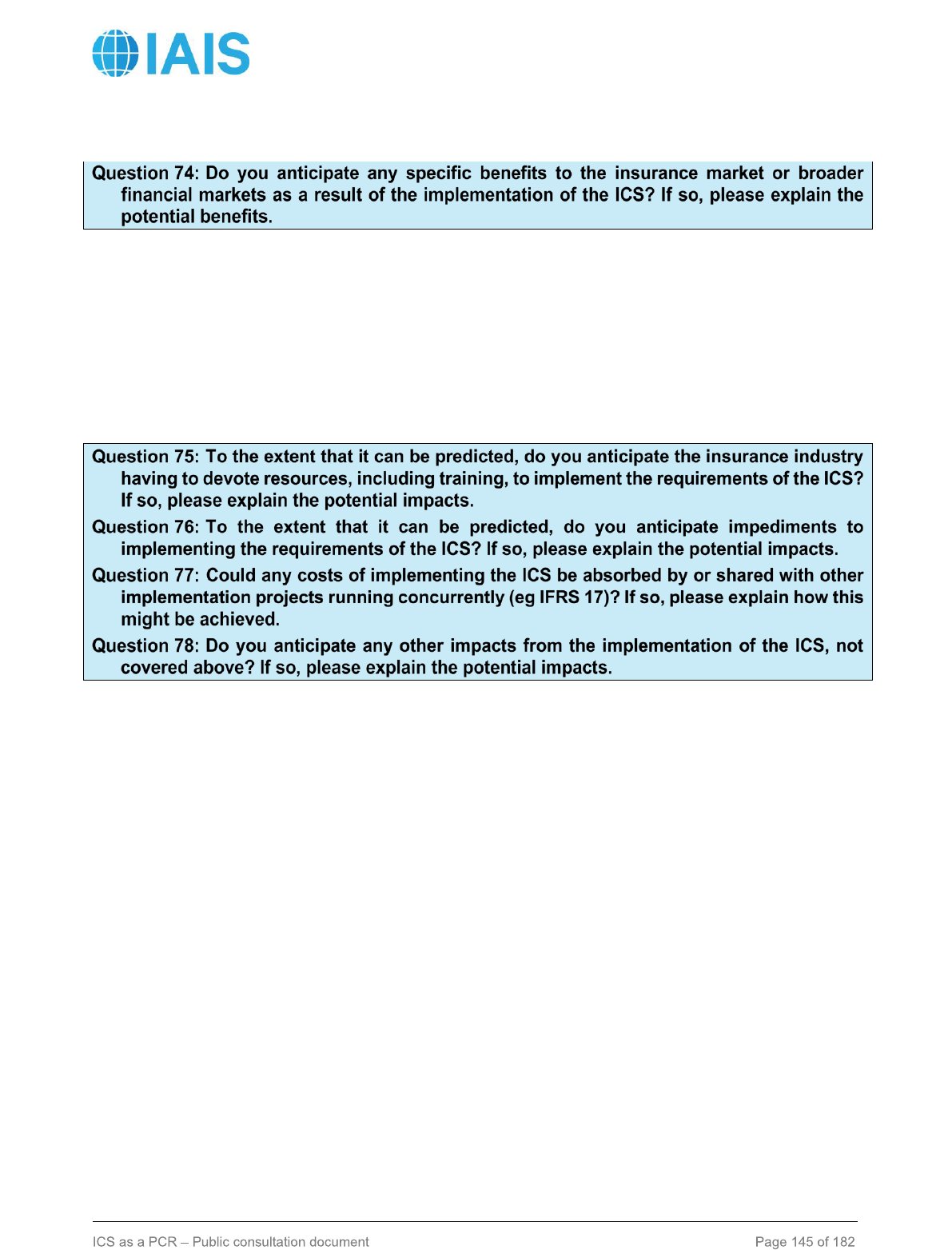
Public
11.4 Implementing the ICS
The process to implement the ICS will vary significantly between IAIGs and supervisors and across
regions due to different local circumstances. The nature of the implementation, including the timing
and use of transitional measures will impact the direct and indirect costs of implementation. At this
stage of development of the ICS, it will be difficult to estimate the specific costs of implementation of
the ICS. However, we would like to understand what aspects of an IAIG or other insurance market
participant’s business might be involved in the implementation process and any issues you anticipate
with this process.
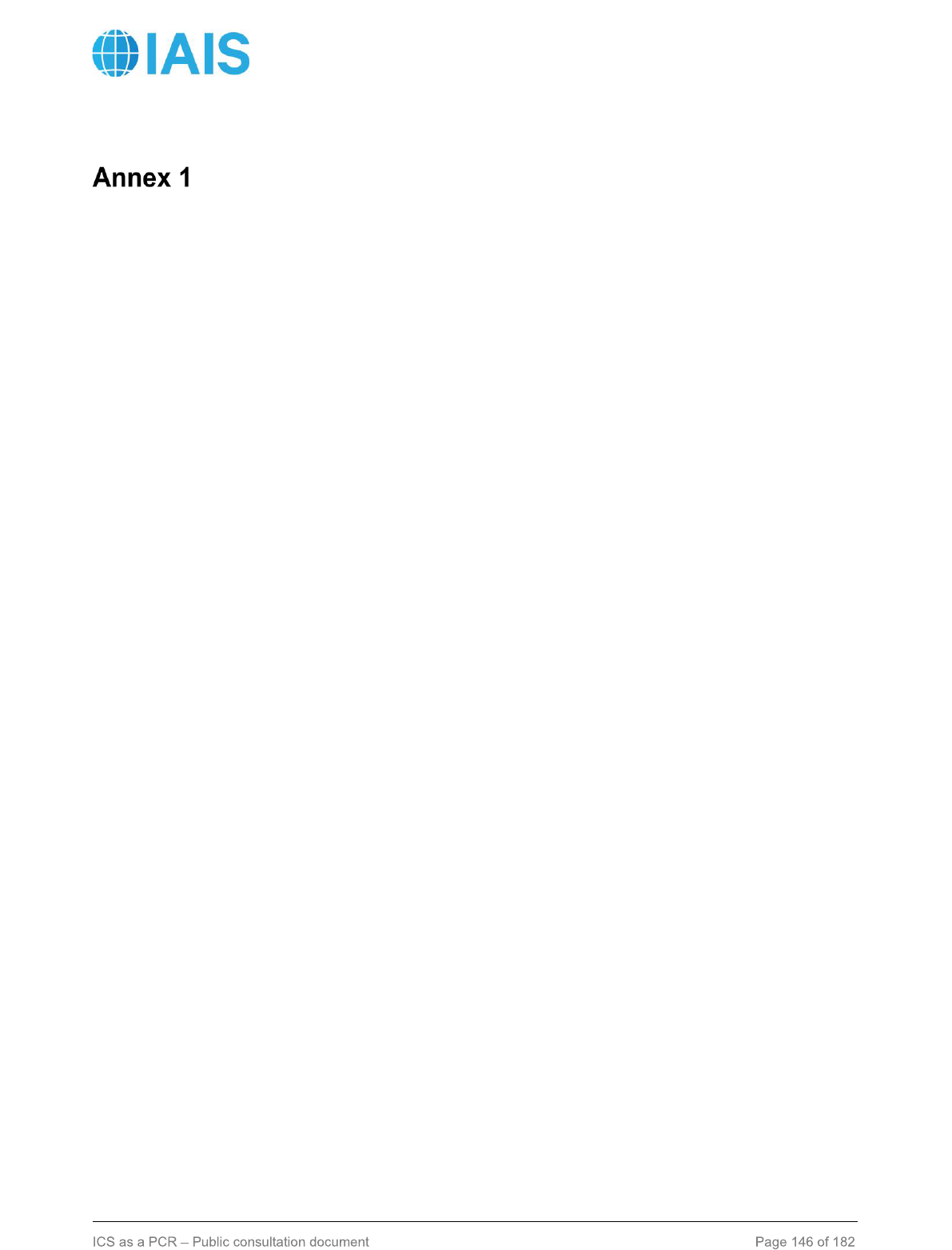
Public
Treatment of Non-Voting Interest Entities (Asset and
Insurance Securitisations)
Asset Securitisations
L2-456. Insurers must meet all of the following conditions in order to not consolidate a securitisation
originated by the group (excerpted from Basel III):
a. Significant credit risk associated with the underlying exposures has been transferred to third
parties.
b. The transferor does not maintain effective or indirect control over the transferred exposures.
The exposures are legally isolated from the transferor in such a way (eg through the sale of
assets or through sub-participation) that the exposures are put beyond the reach of the
transferor and its creditors, even in bankruptcy or receivership. Banks should obtain legal
opinion that confirms true sale.
c. The transferor is deemed to have maintained effective control over the transferred credit risk
exposures if it: (i) is able to repurchase from the transferee the previously transferred
exposures in order to realise their benefits; or (ii) is obligated to retain the risk of the
transferred exposures. The transferor’s retention of servicing rights to the exposures will not
necessarily constitute indirect control of the exposures.
d. The securities issued are not obligations of the transferor. Thus, investors who purchase the
securities only have claim to the underlying exposures.
e. The transferee is an SPE and the holders of the beneficial interests in that entity have the
right to pledge or exchange them without restriction.
f. Clean-up calls must satisfy the following conditions: (i) the exercise of the clean-up call must
not be mandatory, in form or in substance, but rather must be at the discretion of the
originating bank; (ii) the clean-up call must not be structured to avoid allocating losses to
credit enhancements or positions held by investors or otherwise structured to provide credit
enhancement; and (iii) the clean-up call must only be exercisable when 10% or less of the
original underlying portfolio or securities issued remains, or, for synthetic securitisations,
when 10% or less of the original reference portfolio value remains.
g. The securitisation does not contain clauses that (i) require the originating bank to alter the
underlying exposures such that the pool’s credit quality is improved unless this is achieved
by selling exposures to independent and unaffiliated third parties at market prices; (ii) allow
for increases in a retained first-loss position or credit enhancement provided by the
originating bank after the transaction’s inception; or (iii) increase the yield payable to parties
other than the originating bank, such as investors and third-party providers of credit
enhancements, in response to a deterioration in the credit quality of the underlying pool.
h. There must be no termination options/triggers except eligible clean-up calls, termination for
specific changes in tax and regulation or early amortisation provisions.

Public
Asset Securitisations
L2-457. Insurers must meet all of the following conditions in order to not consolidate a securitisation
originated by the group (excerpted from Solvency II):
a. the SPE is any entity other than an insurer or reinsurer, which assumes risks from (re)insurers
through reinsurance contracts or similar arrangements, and which funds in full its risk
exposures by issuing debt or any other financing arrangement the repayment rights of which
are subordinated to the reinsurance obligations of the (re)insurer.
b. where the SPE assumes risks from more than one (re)insurer, the solvency of that SPE is
not adversely affected by winding-up proceedings of any one of those (re)insurers.
c. The SPE meets at all time the following conditions:
i. the SPE has at all times assets the market value of which is equal to or exceeds the
maximum payments – including expenses – of the SPE, and the SPE is able to pay
the amounts it is liable for as they fall due;
ii. the proceeds of the debt issuance or other financing mechanism are fully paid-in.
d. The contractual arrangements relating to the transfer of risk from a (re)insurer to a SPE and
from the SPE to the providers of debt or financing meet the following conditions:
i. The transfer of risk is effective in all circumstances;
ii. The extent of risk transfer is clearly defined and incontrovertible;
iii. the claims of the providers of debt or financing mechanisms are at all times
subordinated to the reinsurance obligations of the SPE to the (re)insurers of the IAIG;
iv. no payments are made to the providers of debt or financing, if following those
payments the SPE would no longer be fully funded;
v. the providers of debt or finance to the SPEs have no rights of recourse to the assets
of the (re)insurers;
vi. the providers of debt or finance to the SPEs have no rights to apply for the winding-
up of the SPE.
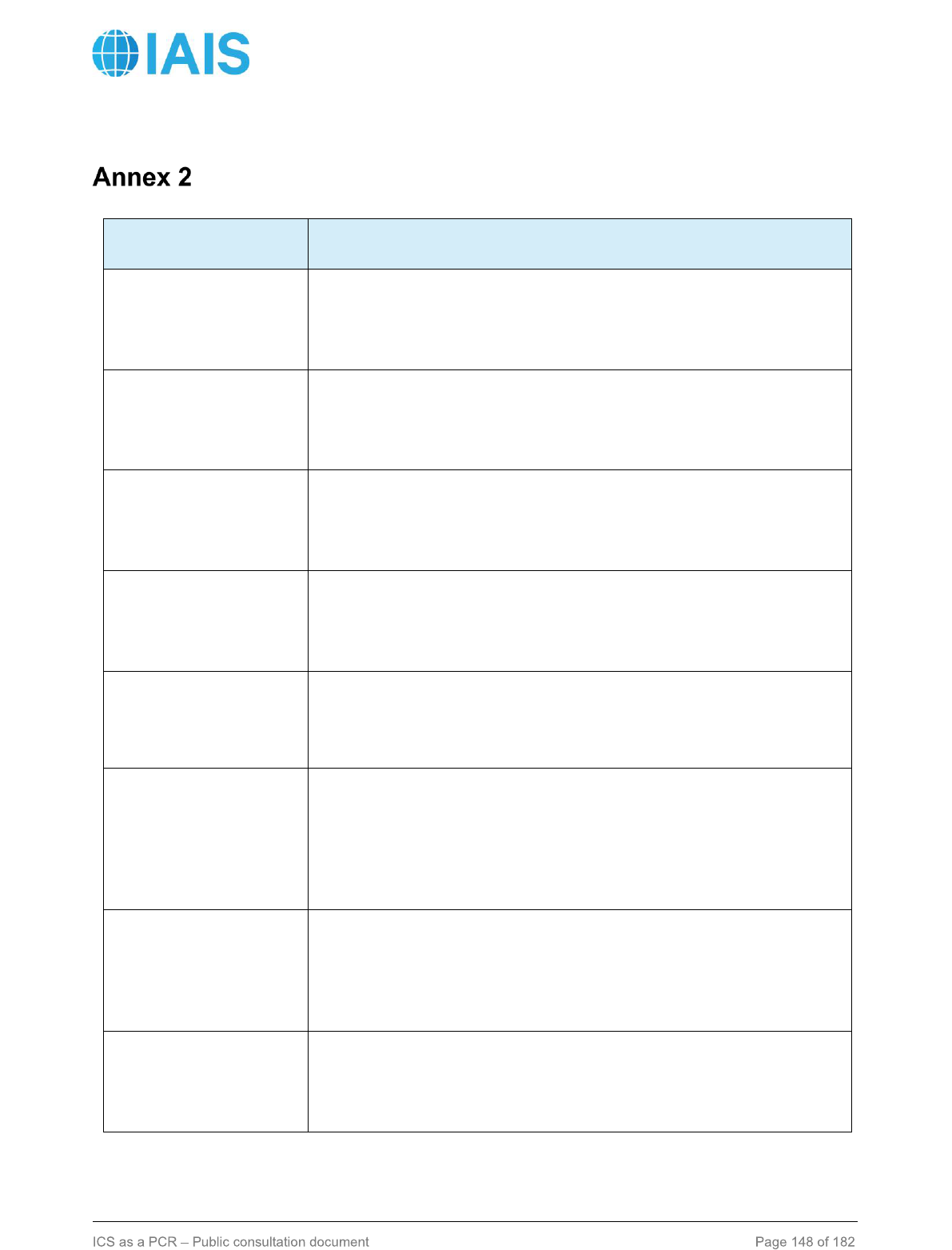
Public
Definition of ICS Non-Life Segments
ICS Segment
Definition
EEA and
Switzerland/Medical
expense insurance
Insurance obligation that covers the provision or financial
compensation for medical treatment or care including preventive or
curative medical treatment or care due to illness, accident, disability
or infirmity.
EEA and
Switzerland/Income
Protection
Insurance obligation that covers the financial compensation arising
from illness, accident, disability or infirmity (excluding medical
expense insurance).
EEA and
Switzerland/Workers'
Compensation
Health insurance obligations which relate to accidents at work,
industrial injury and occupational diseases and where the
underlying business is not pursued on a similar technical basis to
that of life insurance.
EEA and
Switzerland/Motor
vehicle liability - Motor
third party liability
Insurance obligations which cover all liabilities arising out of the use
of motor vehicles operating on land (including carrier's liability).
EEA and
Switzerland/Motor,
other classes
Insurance obligations which cover all damage to or loss of land
vehicles (including railway rolling stock).
EEA and
Switzerland/Marine,
aviation and transport
Insurance obligations which cover all damage or loss to sea, lake,
river and canal vessels, aircraft, and damage to or loss of goods in
transit or baggage irrespective of the form of transport. Insurance
obligations which cover liabilities arising out of the use of aircraft,
ships, vessels or boats on the sea, lakes, rivers or canals (including
carrier's liability).
EEA and
Switzerland/Fire and
other damage
Insurance obligations which cover all damage to or loss of property
(other than those included in motor (other) and
marine/aviation/transport) due to fire, explosion, natural forces
including storm, hail or frost, nuclear energy, land subsidence and
any event such as theft.
EEA and
Switzerland/General
liability - third party
liability
Insurance obligations which cover all liabilities other than those in
motor vehicle liability and marine, aviation and transport.
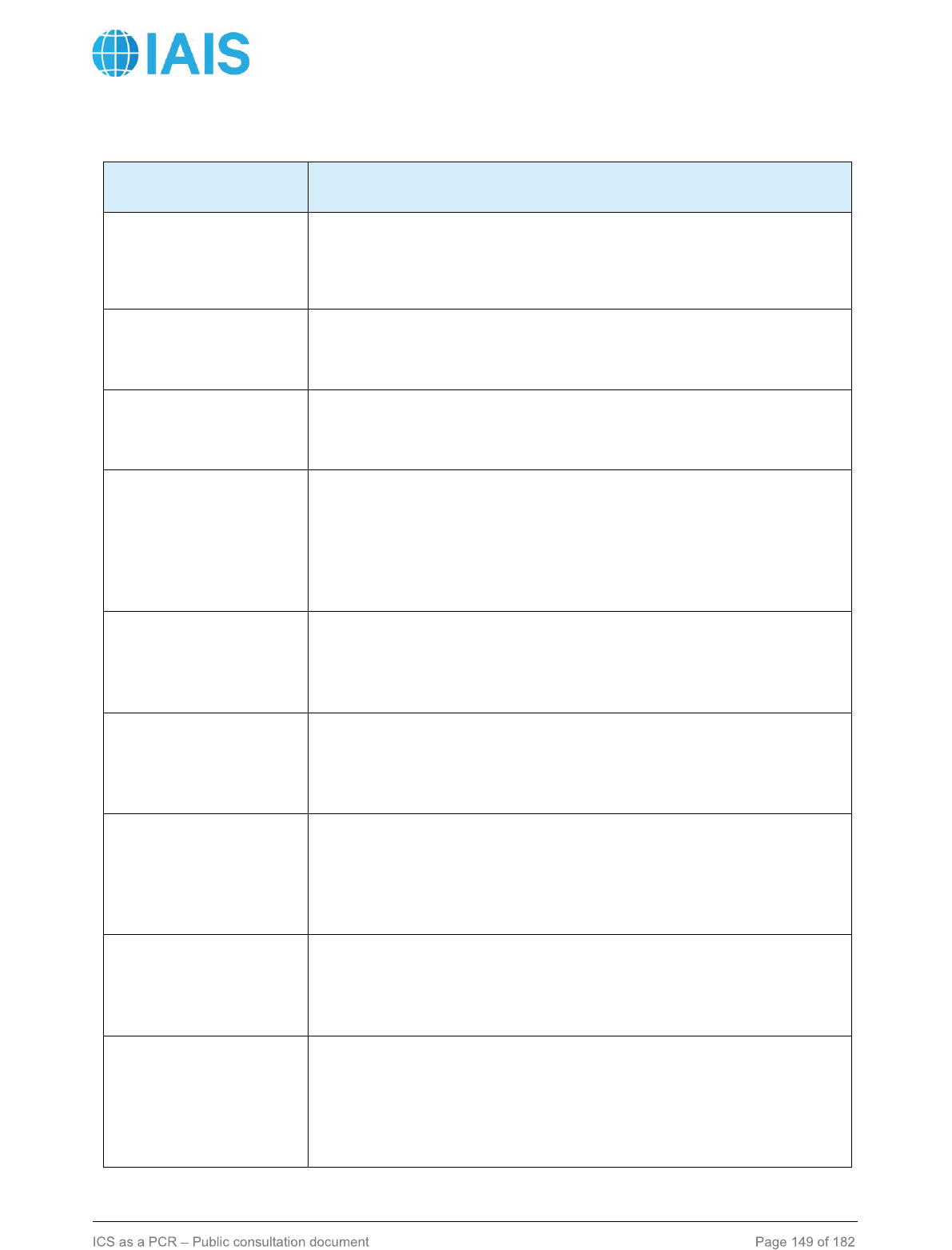
Public
ICS Segment
Definition
EEA and
Switzerland/Credit and
suretyship
Insurance obligations which cover insolvency, export credit,
instalment credit, mortgages, agricultural credit and direct and
indirect suretyship.
EEA and
Switzerland/Legal
expenses
Insurance obligations which cover legal expenses and cost of
litigation.
EEA and
Switzerland/Assistance
Insurance obligations which cover assistance for persons who get
into difficulties while travelling, while away from home or while
away from their habitual residence.
EEA and
Switzerland/Miscellane
ous financial loss
Insurance obligations which cover employment risk, insufficiency of
income, bad weather, loss of benefit, continuing general expenses,
unforeseen trading expenses, loss of market value, loss of rent or
revenue, indirect trading losses other than those mentioned above,
other financial loss (non-trading) as well as any other risk of non-life
insurance not covered by the lines of business above.
EEA and
Switzerland/Non-
proportional health
reinsurance
Reinsurance on a non-proportional basis of health insurance
classes.
EEA and
Switzerland/Non-
Proportional Casualty
reinsurance
Reinsurance on a non-proportional basis of casualty classes (motor
vehicle liability and general liability).
EEA and
Switzerland/Non-
proportional marine,
aviation and transport
reinsurance
Reinsurance on a non-proportional basis of marine, aviation and
transport.
EEA and
Switzerland/Non-
Proportional property
reinsurance
Reinsurance on a non-proportional basis of property classes (other
motor, fire, credit/suretyship, legal expenses and assistance)
Canada/Property -
personal
Insurance against the loss of, or damage to, property, and includes
insurance against loss caused by forgery. It includes such
classifications as habitational property and multi-peril policies,
including residential contents of buildings such as apartments,
rooming houses, motels, manufacturing and mercantile buildings
and the liability exposure of personal package policies issued with

Public
ICS Segment
Definition
indivisible premiums. This line would include fire policies,
householder contents and homeowner personal risks, residential
burglary and theft and special residential glass coverage. Casualty
coverage such as personal liability for bodily injury would not be
included in this category.
Canada/Home
Warranty
Refers to a contract of insurance issued by a warranty provider
covering defects in the construction of a new home and
consequential losses or costs incurred by the owner.
Canada/Product
Warranty
Insurance not incidental to any other class of insurance against
loss of, or damage to, personal property, other than a motor
vehicle, under which an insurer undertakes to pay the costs of
repairing or replacing the personal property.
Canada/Property –
commercial
Insurance against the loss of, or damage to, property, and includes
insurance against loss caused by forgery and all commercial
property and multi-peril policies, but excludes all separate classes
of insurance as defined by regulators
Canada/Aircraft
Insurance against:
1. liability arising from bodily injury to, or the death of, a person, or
the loss of, or damage to, property, in each case caused by an
aircraft or the use of an aircraft; or
2. the loss of, the loss of use of, or damage to, an aircraft.
Canada/Automobile -
liability/personal
accident
Insurance:
1. against liability arising from bodily injury to, or the death of, a
person, or the loss of, or damage to, property, in each case caused
by an automobile or the use or operation of an automobile; or
2. that falls within clause (i) or (ii) of the definition of accident and
sickness insurance, if the accident is caused by an automobile or
the use or operation of an automobile, whether or not liability exists
in respect of the accident, and the policy includes insurance against
liability arising from bodily injury to, or the death of, a person
caused by an automobile or the use or operation of an automobile.
Canada/Automobile –
other
Insurance against the loss of, the loss of use of, or damage to, an
automobile.
Canada/Boiler and
Machinery
Insurance against:
1. liability arising from bodily injury to, or the death of, a person, or
the loss of, or damage to, property, or against the loss of, or
damage to, property, in each case caused by the explosion or

Public
ICS Segment
Definition
rupture of, or accident to, pressure vessels of any kind or pipes,
engines and machinery connected to or operated by those
pressure vessels; or
2. liability arising from bodily injury to, or the death of, a person, or
the loss of, or damage to, property, or against the loss of, or
damage to, property, in each case caused by a breakdown of
machinery.
Canada/Equipment
Warranty
The sub-class of boiler and machinery insurance that covers loss of
or damage to a motor vehicle or to equipment arising from its
mechanical failure, but does not include automobile insurance or
insurance incidental to automobile insurance.
Canada/Credit
Insurance
Insurance against loss to a person who has granted credit if the
loss is the result of the insolvency or default of the person to whom
the credit was granted.
Canada/Credit
Protection
Insurance under which an insurer undertakes to pay off credit
balances or debts of an individual, in whole or in part, in the event
of an impairment or potential impairment in the individual’s income
or ability to earn an income.
Canada/Fidelity
Insurance against loss caused by the theft, the abuse of trust or the
unfaithful performance of duties by a person in a position of trust;
and insurance under which an insurer undertakes to guarantee the
proper fulfilment of the duties of an office.
Canada/Hail
Insurance against the loss of, or damage to, crops in the field
caused by hail.
Canada/Legal
Expenses
Insurance against the costs incurred by a person or persons for
legal services specified in the policy, including any retainer and
fees incurred for the services, and other costs incurred in respect of
the provision of the services.
Canada/Liability
Insurance, other than insurance that falls within another class of
insurance:
1. against liability arising from bodily injury to a person or the
disability or death of a person, including an employee;
2. against liability arising from the loss of, or damage to, property;
or
3. if the policy includes the insurance described in sub-clause (i),
against expenses arising from bodily injury to a person other than
the insured or a member of the insured’s family, whether or not
liability exists. Includes general liability, cyber liability, directors &

Public
ICS Segment
Definition
liability, excess liability, professional liability, umbrella liability and
pollution liability.
Canada/Mortgage
Insurance against loss caused by default on the part of a borrower
under a loan secured by a mortgage or charge on, or other security
interest in, real property.
Canada/Surety
Insurance under which an insurer undertakes to guarantee the due
performance of a contract or undertaking or the payment of a
penalty or indemnity for any default.
Canada/Title
Insurance against loss or damage caused by:
1. the existence of a mortgage, charge, lien, encumbrance,
servitude or any other restriction on real property;
2. the existence of a mortgage, charge, lien, pledge, encumbrance
or any other restriction on personal property;
3. a defect in any document that evidences the creation of any
restriction referred to in sub-clause (i) or (ii);
4. a defect in the title to property; or
5. any other matter affecting the title to property or the right to the
use and enjoyment of property.
Canada/Marine
Insurance against liability arising from:
1. bodily injury to, or the death of, a person; or
2. the loss of, or damage to, property; or
3. the loss of, or damage to, property, occurred during a voyage or
marine adventure at sea or on an inland waterway, or during a
delay or a transit other than by water that is incidental to a voyage
or marine adventure at sea or on an inland waterway.
Canada/ Accident and
Sickness
Canada/Other
Approved Products
Insurance against risks that do not fall within another class of
insurance.
US/ Auto physical
damage
Any motor vehicle insurance coverage (including collision,
vandalism, fire and theft) that insures against material damage to
an insured’s vehicle.
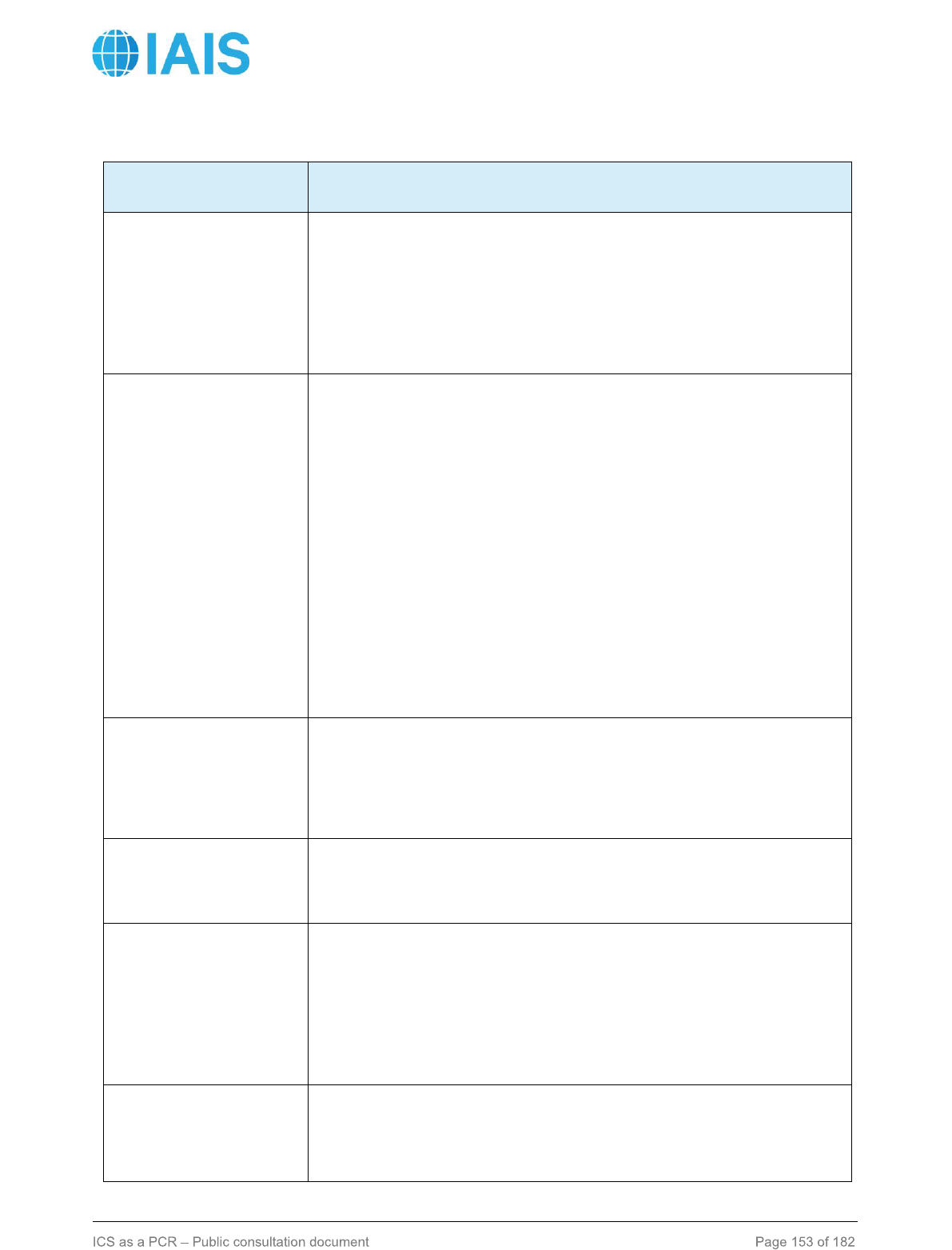
Public
ICS Segment
Definition
US/ Homeowners/
Farm owners
Homeowners: coverage for personal property and/or structure with
broad personal liability coverage, for dwelling, appurtenant
structures, unscheduled personal property and additional living
expenses. Farm owners: similar, for farming and ranching risks;
property + liability coverages for personal and business losses, on
farm dwellings and contents (eg mobile equipment and livestock),
barns, stables, other farm structures and farm inland marine.
US/ Special property
Various, including: fire; allied lines; inland marine; earthquake;
burglary and theft. Fire insurance includes the loss to real or
personal property from damage caused by the peril of fire or
lightning, including business interruption, loss of rents, etc. Allied
lines are coverages generally written with property insurance, eg,
glass; tornado; windstorm and hail; sprinkler and water damage;
explosion, riot, and civil commotion; growing crops; flood; rain; and
damage from aircraft and vehicle, etc. Inland marine is coverage for
property that may be in transit, held by a bailee, at a fixed location,
a movable good that is often at different locations (eg, off road
construction equipment), or scheduled property (eg, Homeowners
Personal Floater) including items such as live animals and property
with antique or collector’s value. This line also includes
instrumentalities of transportation and communication, such as
bridges, tunnels piers, wharves, docks, pipelines, power and phone
lines, and radio and television towers.
US/ Private passenger
auto liability/ medical
Coverage for financial loss resulting from legal liability for motor
vehicle related injuries (bodily injury and medical payments) or
damage to the property of others caused by accidents arising out of
the ownership, maintenance or use of a motor vehicle. Does not
include coverage for vehicles used in a commercial business.
US/ Commercial auto/
truck liability/ medical
Similar to private passenger auto liability/medical, except for
commercial vehicles.
US/ Workers'
compensation
Insurance that covers an employer’s liability for injuries, disability or
death to persons in their employment, without regard to fault, as
prescribed by state or Federal workers’ compensation laws and
other statutes. Includes employer’s liability coverage against the
common law liability for injuries to employees (as distinguished
from the liability imposed by Workers’ Compensation Laws).
Excludes excess workers’ compensation.
US/ Commercial multi-
peril
Two or more insurance coverages for a commercial enterprise,
including various property and liability risks, that are included in the
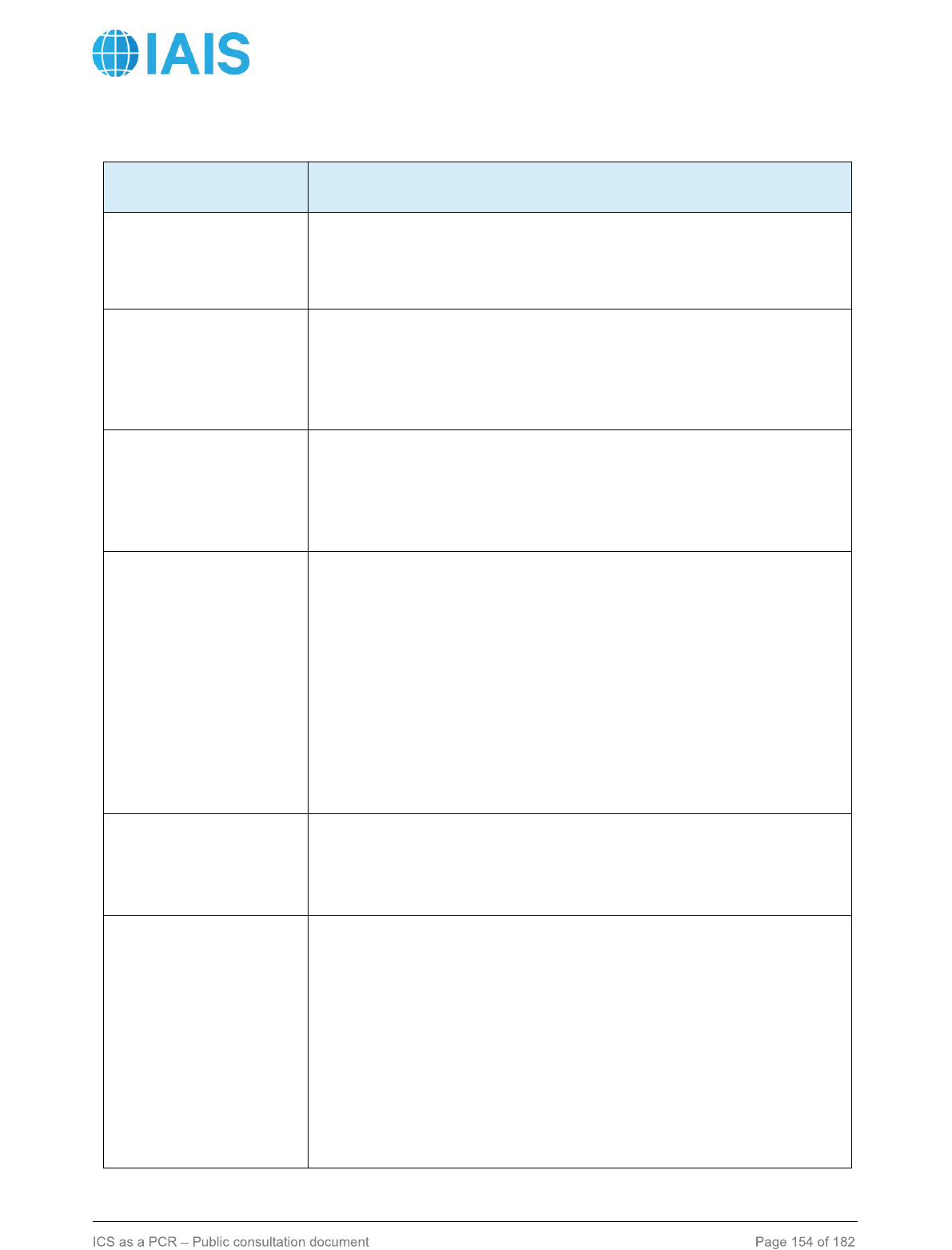
Public
ICS Segment
Definition
same policy. Includes multi-peril policies other than farmowners,
homeowners and automobile policies.
US/ Medical
professional liability –
Occurrence
For a licensed health care provider or health care facility against
legal liability resulting from the death or injury of any person due to
the insured’s misconduct, negligence, or incompetence in rendering
professional services. The insurance covers events occurring
during the policy coverage period.
US/ Medical
professional liability –
Claims-Made
For a licensed health care provider or health care facility against
legal liability resulting from the death or injury of any person due to
the insured’s misconduct, negligence, or incompetence in rendering
professional services. The insurance covers claims presented
during the period of coverage.
US/Other Liability–
Occurrence
Insurance against legal liability resulting from negligence,
carelessness, or a failure to act causing property damage or
personal injury to others. Typically, coverage includes liability for
the following: construction and alteration; contingent; contractual;
elevators and escalators; errors and omissions; environmental
pollution; excess stop loss, excess over insured or self-insured
amounts and umbrella; liquor; personal injury; premises and
operations; completed operations; nonmedical professional, etc.
Also includes indemnification coverage provided to self-insured
employers on an excess of loss basis (excess workers’
compensation). The insurance covers events occurring during the
policy coverage period.
US/Other Liability –
Claims-Made
Same types of coverages as other liability – occurrence above
except that the insurance covers claims presented during the
period of coverage. The insurable event does not need to occur
during the policy period.
US/Products liability
Products liability - occurrence: covers events occurring during
coverage period. Products liability - claims made. - covers claims
made during the coverage period. Coverage for the manufacturer,
distributor, seller, or lessor of a product against legal liability
resulting from a defective condition causing personal injury, or
damage, to any individual or entity, associated with the use of the
product. Products liability - occurrence: covers events occurring
during coverage period. Products liability - claims made. - covers
claims made during the coverage period. Coverage for the
manufacturer, distributor, seller, or lessor of a product against legal
liability resulting from a defective condition causing personal injury,
or damage, to any individual or entity, associated with the use of
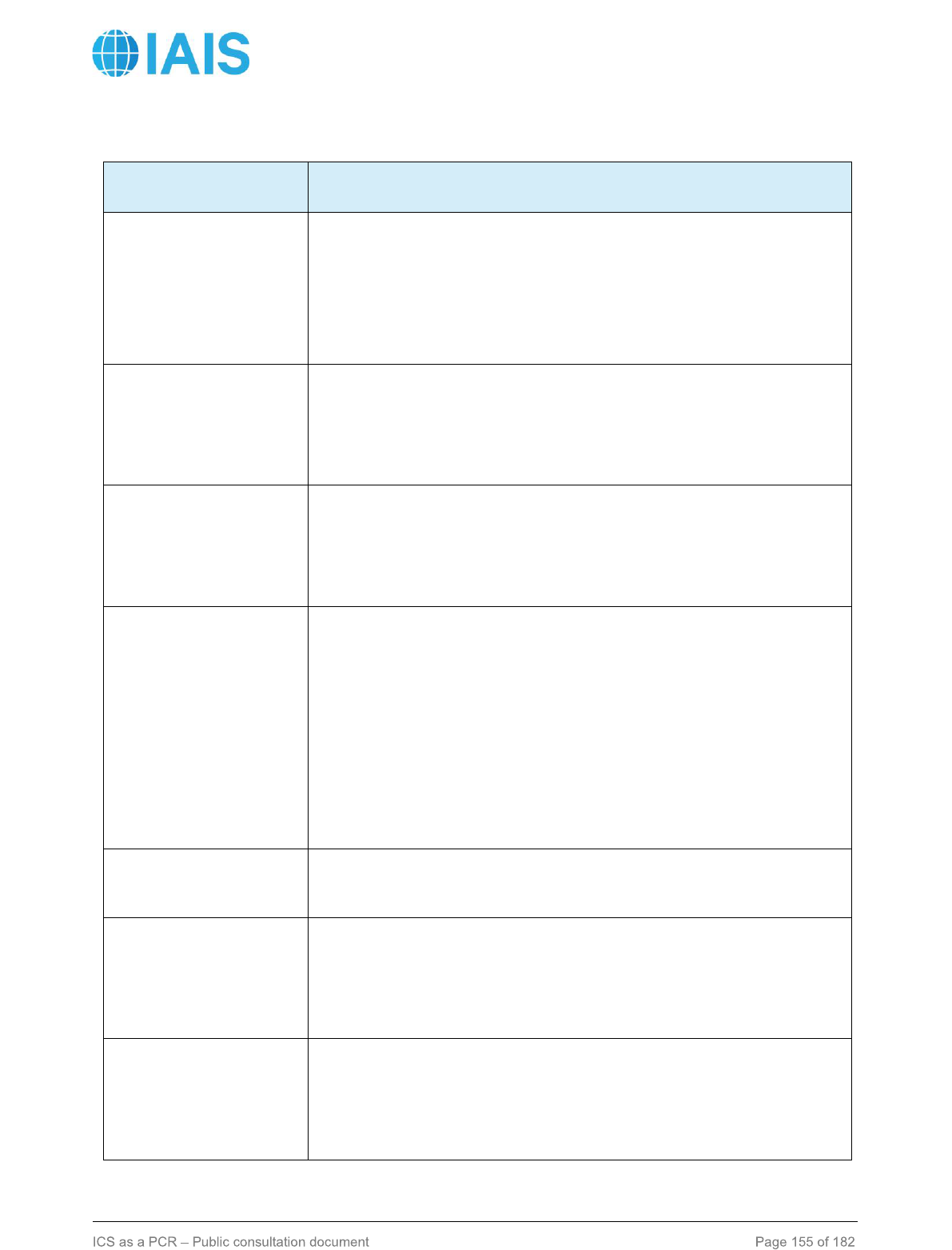
Public
ICS Segment
Definition
the product. Products liability - occurrence: covers events occurring
during coverage period. Products liability - claims made. - covers
claims made during the coverage period. Coverage for the
manufacturer, distributor, seller, or lessor of a product against legal
liability resulting from a defective condition causing personal injury,
or damage, to any individual or entity, associated with the use of
the product.
US/Reinsurance – non-
proportional assumed
property
Non-proportional assumed liability reinsurance in fire allied lines,
ocean marine, inland marine, earthquake, group accident and
health, credit accident and health, other accident and health, auto
physical damage, boiler and machinery, glass, burglary and theft
and international (of the foregoing).
US/Reinsurance – non-
proportional assumed
liability
Non-proportional assumed liability reinsurance in farm owners
multiple-peril, homeowners’ multiple-peril, commercial multiple-
peril, medical professional liability, workers’ compensation, other
liability, products liability, auto liability, aircraft (all perils) and
international (of the foregoing).
US/Special liability
Various insurance coverages including ocean marine, aircraft (all
perils), and boiler and machinery. Ocean marine is coverage for
ocean and inland water transportation exposures; such as goods or
cargoes; ships or hulls; earnings; and liability. Aircraft is coverage
for aircraft (hull) and their contents; aircraft owner’s and aircraft
manufacturer’s liability to passengers, airports and other third
parties. Boiler and machinery is coverage for the failure of boilers,
machinery and electrical equipment. Coverage includes the
property of the insured, which has been directly damaged by an
accident, costs of temporary repairs and expediting expenses and
liability for damage to the property of others.
US/Mortgage insurance
Mortgage guaranty is indemnification of a lender from loss if a
borrower fails to meet required mortgage payments.
US/Fidelity/surety
Fidelity is a bond covering an employer’s loss resulting from an
employee’s dishonest act (eg, loss of cash, securities, or
valuables). Surety is a three-party agreement where the insurer
agrees to pay a second party or make complete an obligation in
response to the default, acts, or omissions of a third party.
US/Financial Guaranty
Financial guaranty is a surety bond, insurance policy, or when
issued by an insurer, an indemnity contract and any guaranty
similar to the foregoing types, under which loss is payable upon
proof of occurrence of financial loss to an insured claimant, oblige
or indemnitee as a result of failure to perform a financial obligation.
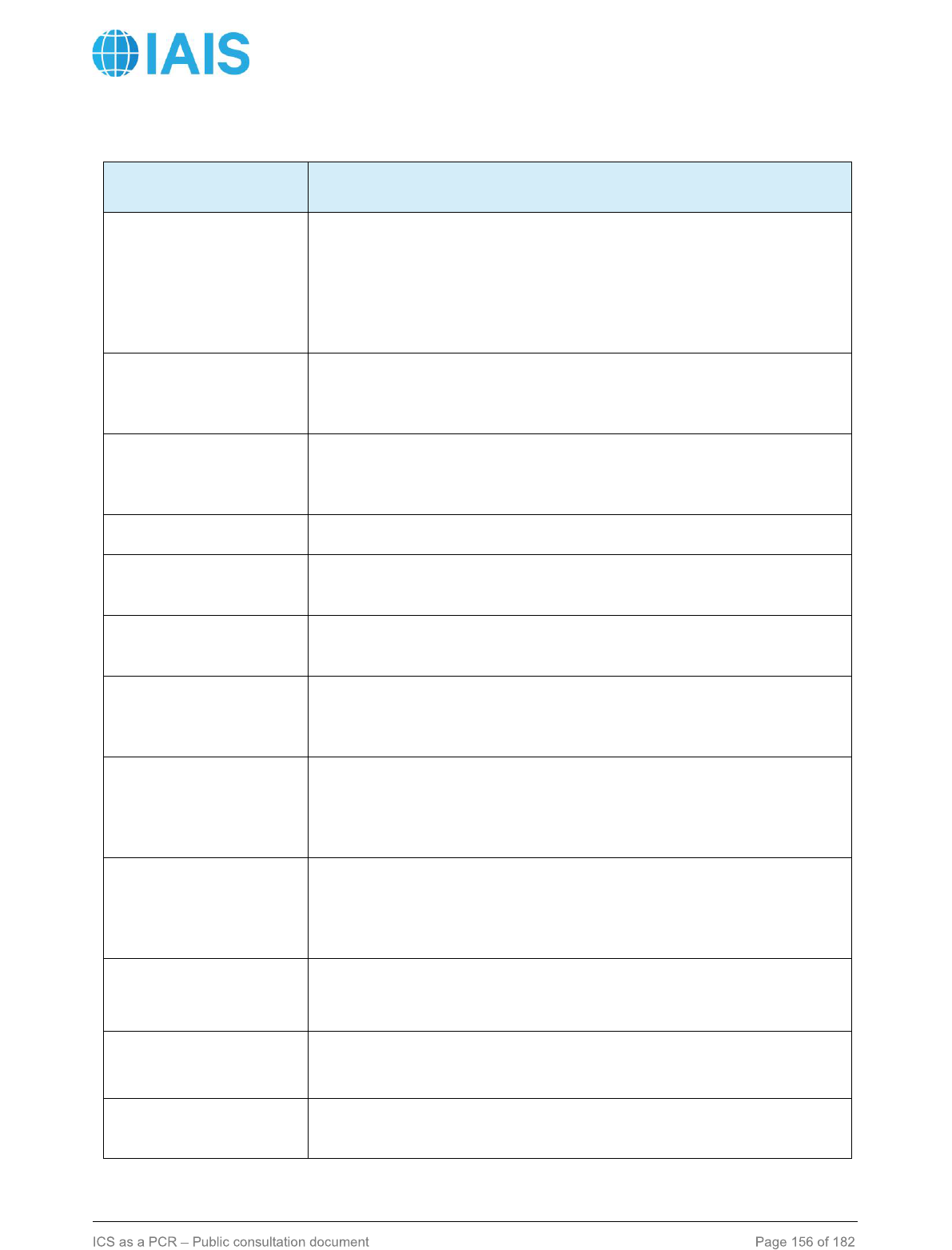
Public
ICS Segment
Definition
US/Other
Coverages not included elsewhere which includes credit
coverages, warranty, and, where considered part of
property/casualty, accident/health coverages. The Schedule P
“International” LOB should be allocated to the region(s) where risk
is located, but if this is not possible could be included in this
segment.
US/Reinsurance – non-
proportional assumed
financial lines
Non-proportional assumed reinsurance in the following lines:
mortgage guaranty, financial guaranty, fidelity, surety, credit, and
international (in the foregoing).
Japan/Fire
This insurance covers property damage for either commercial or
household caused by fire, windstorm, hail, water damage and
earthquake
Japan/Hull
This insurance covers damage of vessel.
Japan/Cargo
This insurance covers damage on good and property in transit by
vessel.
Japan/Transit
This insurance is called as Inland marine, which covers property
being transported by other than vessel or aircraft.
Japan/Personal
Accident
This insurance covers loss by accidental bodily injury. Under this
insurance, policyholder is reimbursed based on actual losses
occurred or receives a fixed benefit due to a certain accident event.
Japan/Automobile
This insurance covers personal injury or automobile damage
sustained by the insured and liability to third parties for losses
caused by the insured. Please note fleet automobile insurance
should be included here.
Japan/Aviation
This insurance covers aircraft, goods or property in transit by
aircraft and launch to the space, and liability arising from the loss of
or damage to the goods or property in transit or bodily injury or
property loss or damage to third parties
Japan/Guarantee Ins.
This insurance covers financial loss caused by the insolvency or
payment default of customers to whom credit has been granted
Japan/Machinery
This insurance protects the insured against loss incurred as a result
of machinery breakdown.
Japan/General Liability
This insurance covers any legal obligations to pay compensation
and costs for bodily injury, property loss or damage to third parties.

Public
ICS Segment
Definition
Japan/Contractor's All
Risks
This insurance is purchased by contractors to cover damage to
property under construction.
Japan/Movables All
Risks
This insurance covers loss or damage to property other than motor,
aircraft and vessel.
Japan/Workers'
Compensation
This insurance covers no-fault basis compensation payments to
employees who sustained bodily injury or occupational disease
during or which arises out of the course of their employment, and
provides employers with protections against claims which their
employees make for bodily injury or occupational disease caused
by tort.
Japan/Misc. Pecuniary
Loss
This insurance provides the insured with tailor-made covers for
consequential losses that are not covered by any other classes of
business.
Japan/Nursing Care
Ins.
This Insurance provides benefit to meet specified conditions
requiring the insured to be nursed. Under this insurance,
policyholder is reimbursed based on actual cost incurred or
receives a fixed benefit for nursing care.
Japan/Others
Includes any other non-life insurance not listed above.
China/Motor
A vehicle insurance that the object of insurance is vehicle itself and
related liability to pay compensation.
China/Property,
including commercial,
personal and
engineering
Insurance that the object of insurance is property and related
interests.
China/Marine and
Special
Insurance that the object of insurance is watercraft and related
liability to pay compensation.
China/Liability
Insurance that the object of insurance is assumed liability of the
insurant to pay compensation to the third party.
China/Agriculture
Insurance that the object of insurance is the property loss of
agriculture caused by disasters.
China/Credit
Insurance that the object of insurance is the economical loss of
loaner because of the debtor’s incapacity or refusing to pay for the
debt.
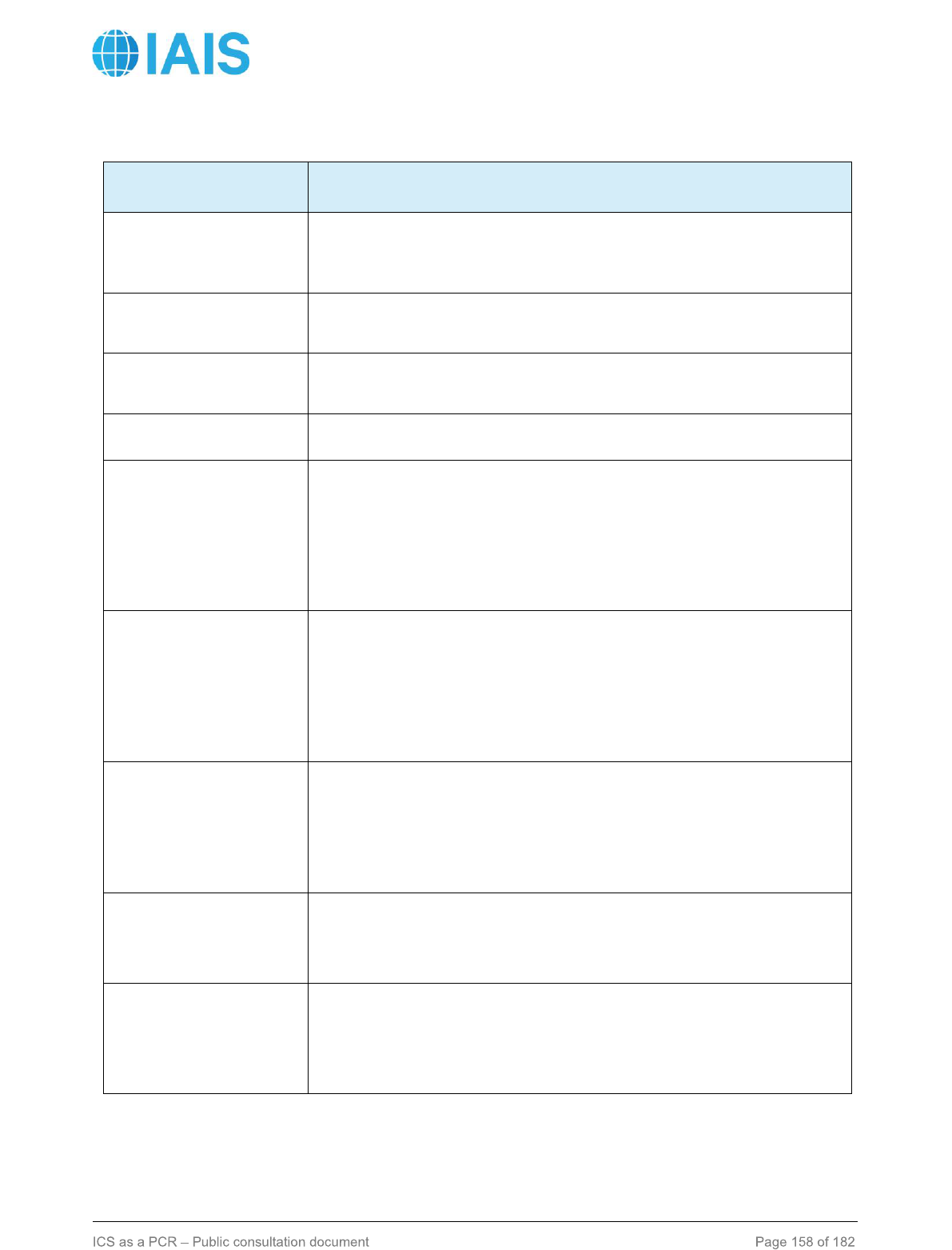
Public
ICS Segment
Definition
China/Short-term
Accident
A short-term accident insurance, the object of insurance is the
death or disability of insurant because of accident. The period of
insurance is usually no more than one year.
China/Short-term
Health
Health insurance that the period of insurance is no more than one
year and without guaranteed renewable terms.
China/Short-term Life
A short-term life insurance, the object of insurance is the lift of
insured. The period of insurance is usually no more than one year.
China/Others
Other insurances.
Australia&NZ/
Householders
This class covers the common Householders policies, including the
following classes/risks: contents, personal property, arson and
burglary. Public liability normally attaching to these products is to
be separated.
This class also covers proportional reinsurance of householders
business.
Australia&NZ/
Commercial Motor
Motor vehicle insurance (including third party property damage)
other than insurance covering vehicles defined below under
Domestic Motor. It includes long and medium haul trucks, cranes
and special vehicles, and policies covering fleets.
This class also covers proportional reinsurance of commercial
motor.
Australia&NZ/ Domestic
Motor
Motor vehicle insurance (including third party property damage)
covering private use motor vehicles including utilities and lorries,
motor cycles, private caravans, box and boat trailers, and other
vehicles not normally covered by business or commercial policies.
This class also covers proportional reinsurance of domestic motor.
Australia&NZ/ Other
type A
Other classes of business with similar characteristics to
householders and motor
This class also covers proportional reinsurance of other type A.
Australia&NZ/ Travel
Insurance against losses associated with travel including loss of
baggage and personal effects, losses on flight cancellations and
overseas medical costs.
This class also covers proportional reinsurance of travel insurance.

Public
ICS Segment
Definition
Australia&NZ/ Fire and
ISR
Includes all policies normally classified as fire (includes sprinkler
leakage, subsidence, windstorm, hailstone, crop, arson and loss of
profits) and Industrial Special Risk
This class also covers proportional reinsurance of fire and industrial
special risk.
Australia&NZ/Marine
and Aviation
Includes Marine Hull and Marine Liability (including pleasure craft),
and Marine Cargo (including sea and inland transit insurance). Also
includes Aviation (including aircraft hull and aircraft liability).
This class also covers proportional reinsurance of marine and
aviation.
Australia&NZ/
Consumer Credit
Insurance to protect a consumer's ability to meet the loan
repayments on personal loans and credit card finance in the event
of death or loss of income due to injury, illness or unemployment.
This class also covers proportional reinsurance of consumer credit.
Australia&NZ/ Other
Accident
Includes miscellaneous accident, all risks (baggage, sporting
equipment, guns), engineering when not part of Fire & ISR, plate
glass when not package, livestock, pluvius and sickness and
accident.
This class also covers proportional reinsurance of other accident.
Australia&NZ/ Other
type B
Other classes of business with similar characteristics to Fire & ISR,
marine, aviation, consumer credit and other accident.
This class also covers proportional reinsurance of other type B.
Australia&NZ/
Mortgage
Insurance against losses to a lender in the event of borrower
default on a loan secured by a mortgage over residential or other
property.
This class also covers proportional reinsurance of mortgage.
Australia&NZ/ CTP
Compulsory Third Party business.
This class also covers proportional reinsurance of CTP.
Australia&NZ/ Public
and Product Liability
Public Liability covers legal liability to the public in respect of bodily
injury or property damage arising out of the operation of the
insured's business. Product Liability includes policies that provide
for compensation for loss and/or injury caused by, or as a result of,
the use of goods and environmental clean-up caused by pollution
spills where not covered by Fire and ISR policies. Includes builders
warranty and public liability attaching to householders policies.

Public
ICS Segment
Definition
This class also covers proportional reinsurance of public and
product liability.
Australia&NZ/
Professional Indemnity
PI covers professionals against liability incurred as a result of errors
and omissions made in performing professional services that has
resulted in economic losses suffered by third parties. Includes
Directors' and Officers' Liability insurance plus legal expense
insurance. Cover for legal expenses is generally included in this
type of policy.
This class also covers proportional reinsurance of professional
indemnity.
Australia&NZ/
Employers’ Liability
Includes workers' compensation, seaman's compensation and
domestic workers' compensation.
This class also covers proportional reinsurance of employer’s
liability.
Australia&NZ/ Short tail
medical expenses
Insurance obligation that covers the provision or financial
compensation for medical treatment or care including preventive or
curative medical treatment or care due to illness, accident, disability
or infirmity usually made during the term of the policy or shortly
(typically, up to 1 year) after the coverage period of the insurance
has expired.
Australia&NZ/ Other
type C
Other classes of business with similar characteristics to mortgage,
CTP, and other liability.
This class also covers proportional reinsurance of other type C.
Australia&NZ/
Householders - non-
prop reins
Non-Proportional reinsurance of householders business (refer
definition).
Australia&NZ/
Commercial Motor -
non-prop reins
Non-Proportional reinsurance of commercial motor (refer
definition).
Australia&NZ/ Domestic
Motor - non-prop reins
Non-Proportional reinsurance of domestic motor business (refer
definition).
Australia&NZ/ Other
non-prop reins type A
Non-Proportional reinsurance of other type A business (refer
definition).
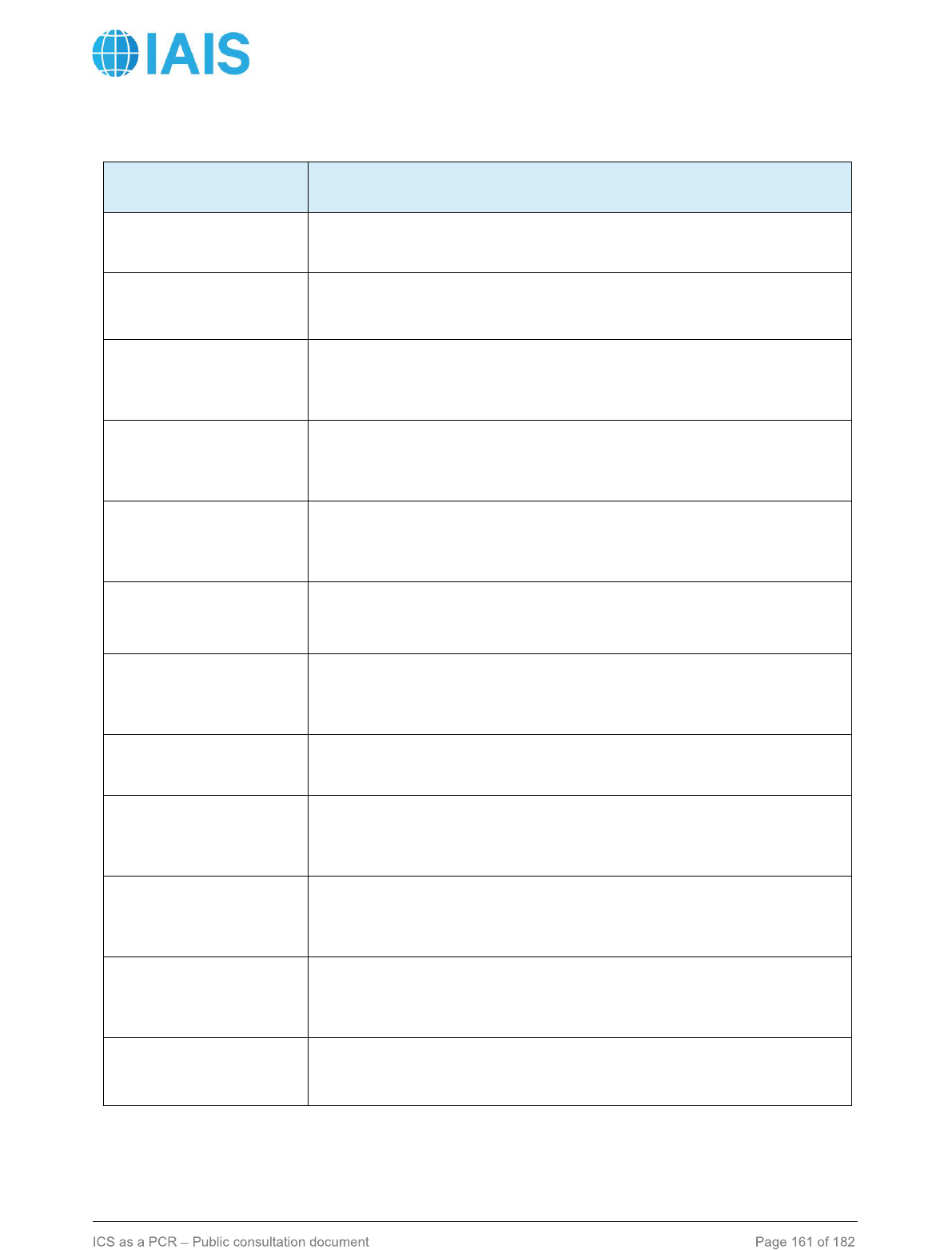
Public
ICS Segment
Definition
Australia&NZ/ Travel -
non-prop reins
Non-Proportional reinsurance of travel business (refer definition).
Australia&NZ/ Fire and
ISR - non-prop reins
Non-Proportional reinsurance of Fire & ISR business (refer
definition).
Australia&NZ/ Marine
and Aviation - non-prop
reins
Non-Proportional reinsurance of marine and aviation business
(refer definition).
Australia&NZ/
Consumer Credit - non-
prop reins
Non-Proportional reinsurance of consumer credit business (refer
definition).
Australia&NZ/ Other
Accident - non-prop
reins
Non-Proportional reinsurance of other accident business (refer
definition).
Australia&NZ/ Other
non-prop reins type B
Non-Proportional reinsurance of other type B business (refer
definition).
Australia&NZ/
Mortgage - non-prop
reins
Non-Proportional reinsurance of mortgage business (refer
definition).
Australia&NZ/ CTP -
non-prop reins
Non-Proportional reinsurance of CTP business (refer definition).
Australia&NZ/ Public
and Product Liability -
non-prop reins
Non-Proportional reinsurance of public and product liability
business (refer definition).
Australia&NZ/
Professional Indemnity
- non-prop reins
Non-Proportional reinsurance of professional indemnity business
(refer definition).
Australia&NZ/
Employer’s Liability -
non-prop reins
Non-Proportional reinsurance of employer’s liability business (refer
definition).
Australia&NZ/ Other
non-prop reins type C
Non-Proportional reinsurance of other type C business (refer
definition).
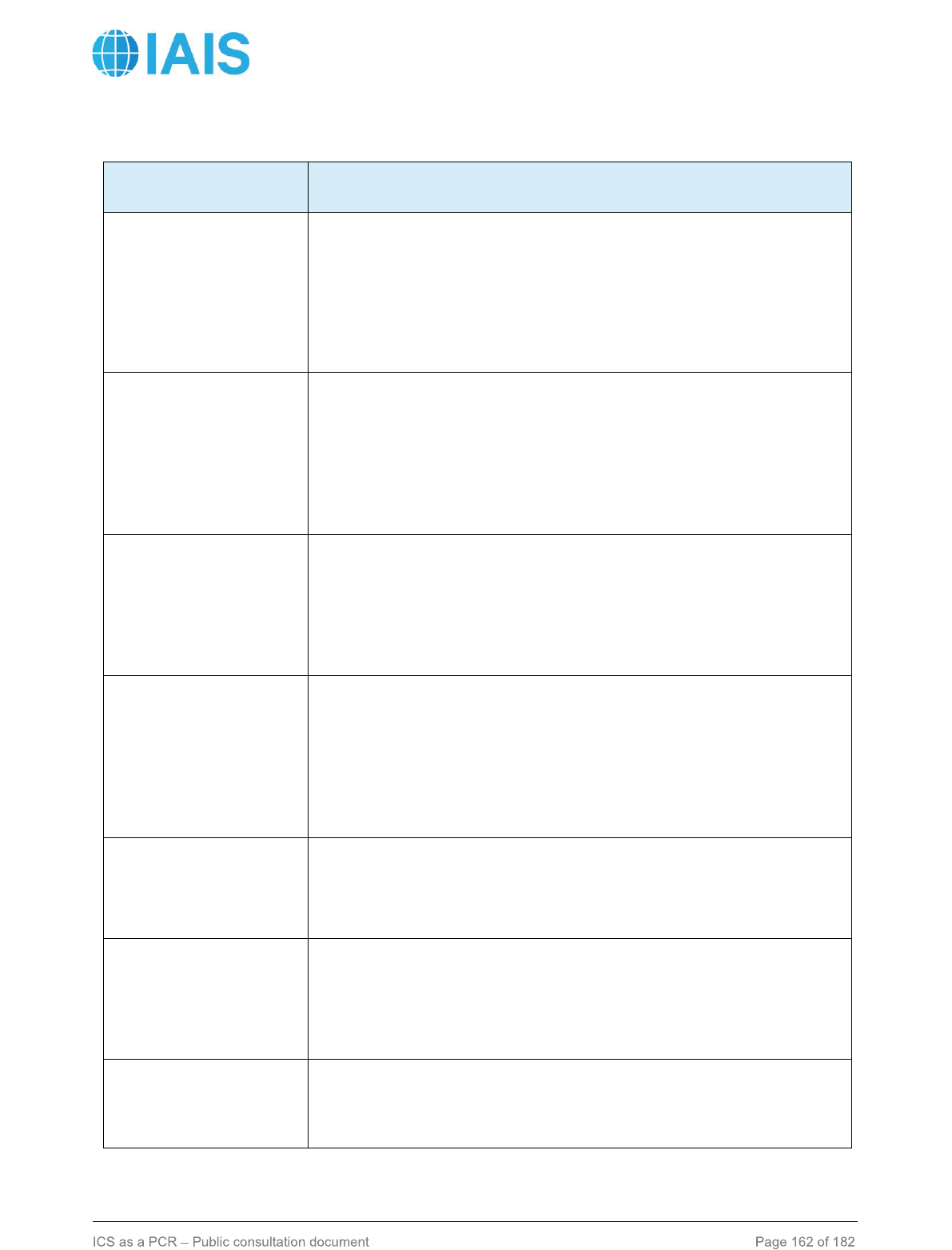
Public
ICS Segment
Definition
Hong Kong/ Accident
and health
Providing fixed pecuniary benefits or benefits in the nature of
indemnity (or a combination of both) against risks of the persons
insured
1. Sustaining injury or dying as a result of accident; or 2.Becoming
incapacitated in consequence of disease; or
3. Sickness.
Hong Kong/Motor
vehicle, damage and
liability
This includes 1. Insurance against the risk of the person sustaining
injury or dying as a result of travelling as passenger on motor
vehicle; 2. Insurance upon loss of or damage to vehicles used on
land, including motor vehicles but excluding railway rolling stock; or
3. Insurance against damage arising out of or in connection with
the use of motor vehicles on land, including third-party risks and
carrier's liability.
Hong Kong/Aircraft,
damage and liability
This includes 1. Insurance against the risk of the person sustaining
injury or dying as a result of travelling as passenger on aircraft; 2.
Insurance upon aircraft or upon the machinery, tackle, furniture or
equipment of aircraft; or 3. Insurance against damage arising out of
or in connection with the use of aircraft, including third-party risks
and carrier's liability.
Hong Kong/Ships,
damage and liability
This includes 1. Insurance against the risk of the person sustaining
injury or dying as a result of travelling as passenger on marine
transport; 2. Insurance upon vessels used on the sea or on inland
water, or upon the machinery, tackle, furniture or equipment of
such vessels; or 3. Insurance against damage arising out of or in
connection with the use of vessels on the sea or on inland water,
including third-party risks and carrier's liability.
Hong Kong/Goods in
transit
Insurance upon loss of or damage to merchandise, baggage and all
other goods in transit, irrespective of the form of transport (ie
include goods in transit via motor, aircraft, ships and other
transport).
Hong Kong/Fire and
Property damage
This includes insurance against loss of or damage to property
(other than property to which motor, aircraft, ships or goods in
transit relates) due to 1. Fire, explosion, storm, natural forces other
than storm, nuclear energy or land subsidence; or 2. hail or frost or
to any event (such as theft) other than those mentioned in 1.
Hong Kong/General
liability
Insurance against risks of the persons insured incurring liabilities to
third parties, the risks in question not being risks to which motor,
aircraft or ships relates.
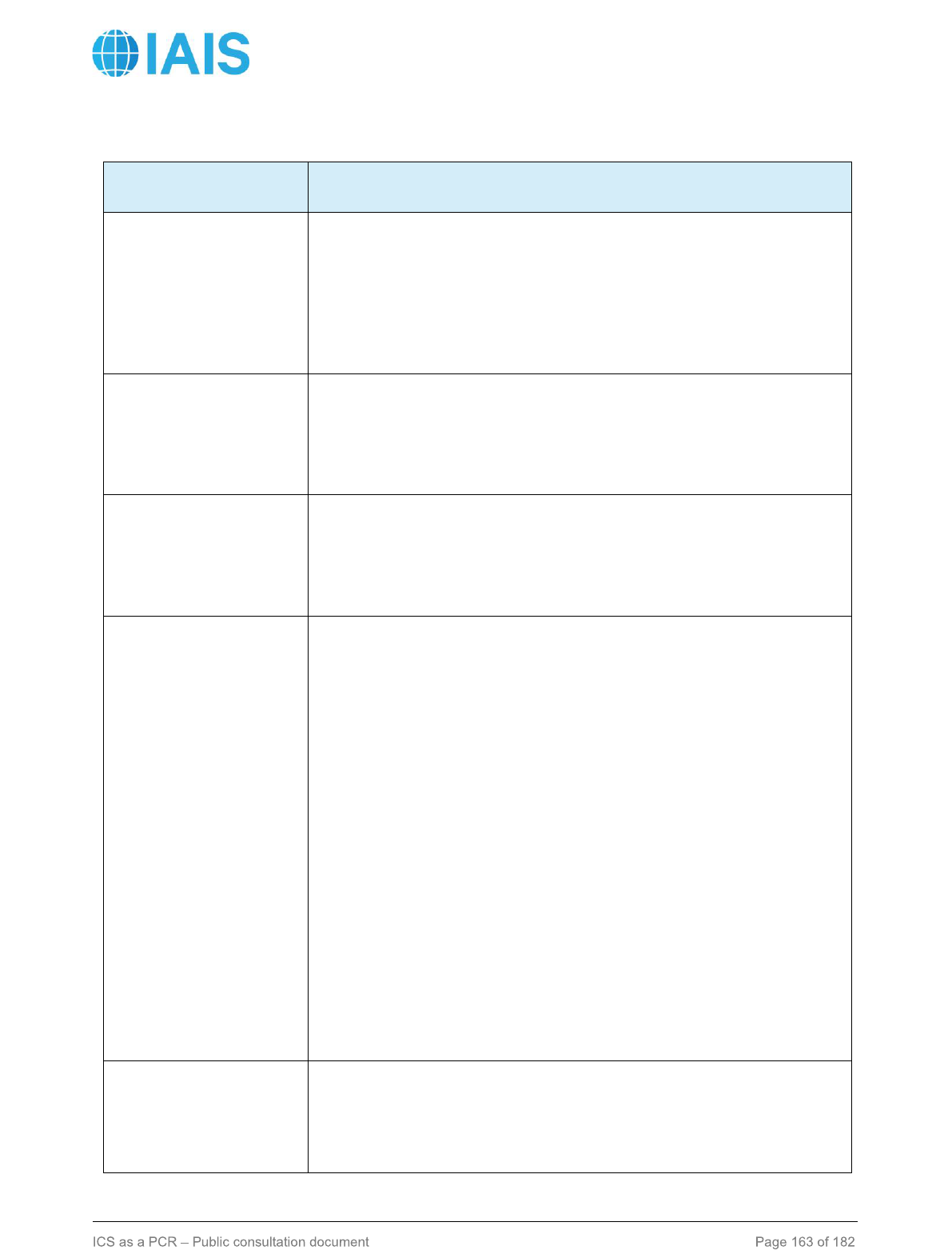
Public
ICS Segment
Definition
Hong Kong/Pecuniary
loss
This includes: 1. Insurance against risks of loss to the persons
insured arising from the insolvency or failure of debtors of theirs; 2.
Suretyship; 3. Insurance against risks attributable to interruptions of
the carrying on of business carried on by them or to reduction of
the scope of business so carried on; or 4. Insurance against risks of
loss to the persons insured attributable to their incurring legal
expenses (including costs of litigation).
Hong Kong/Non-
proportional treaty
reinsurance
In the event that it is impracticable to allocate the treaty reinsurance
business to the respective eight accounting classes of general
business above, such business may be shown under 2 broad
classes, namely, Non-proportional Treaty Reinsurance and
Proportional Treaty Reinsurance
Hong
Kong/Proportional
treaty reinsurance
In the event that it is impracticable to allocate the treaty reinsurance
business to the respective eight accounting classes of general
business above, such business may be shown under 2 broad
classes, namely, Non-proportional Treaty Reinsurance and
Proportional Treaty Reinsurance
Korea/ Fire, technology,
overseas
This includes fire insurance, technology insurance, original
overseas insurance, reinsurance assumed from overseas.
- fire insurance: insurance for residential fire, factory fire, general
fire (insurance for fire in any ordinary building and movable
property therein, excluding residential houses and factories) and
other fire.
- technology insurance: insurance for construction, assembling,
machinery, electronic devices and others. The definitions for each
are set out below.
1) construction: protection against damage and liability for damage
to a building under construction.
2) assembly: protection against damage and liability for damage to
a structure in assembling progress.
3) machinery: insurance for damage to machinery.
4) electronic devices: insurance for damage to electronic devices
and costs and expenses for restoration of data.
- original overseas insurance: insurance for property damage,
bodily injury, or liability for damages in connection with any goods
located in a foreign country.
- reinsurance assumed from overseas: assuming other insurer's
risk as a reinsurer from overseas.
Korea/Package
This includes package insurance for household and for business.
- for household: insurance for two or more types of damage among
insurance for an individual person's property damage, bodily injury,
and liability for damages.
- for business: insurance for two or more types of damage among
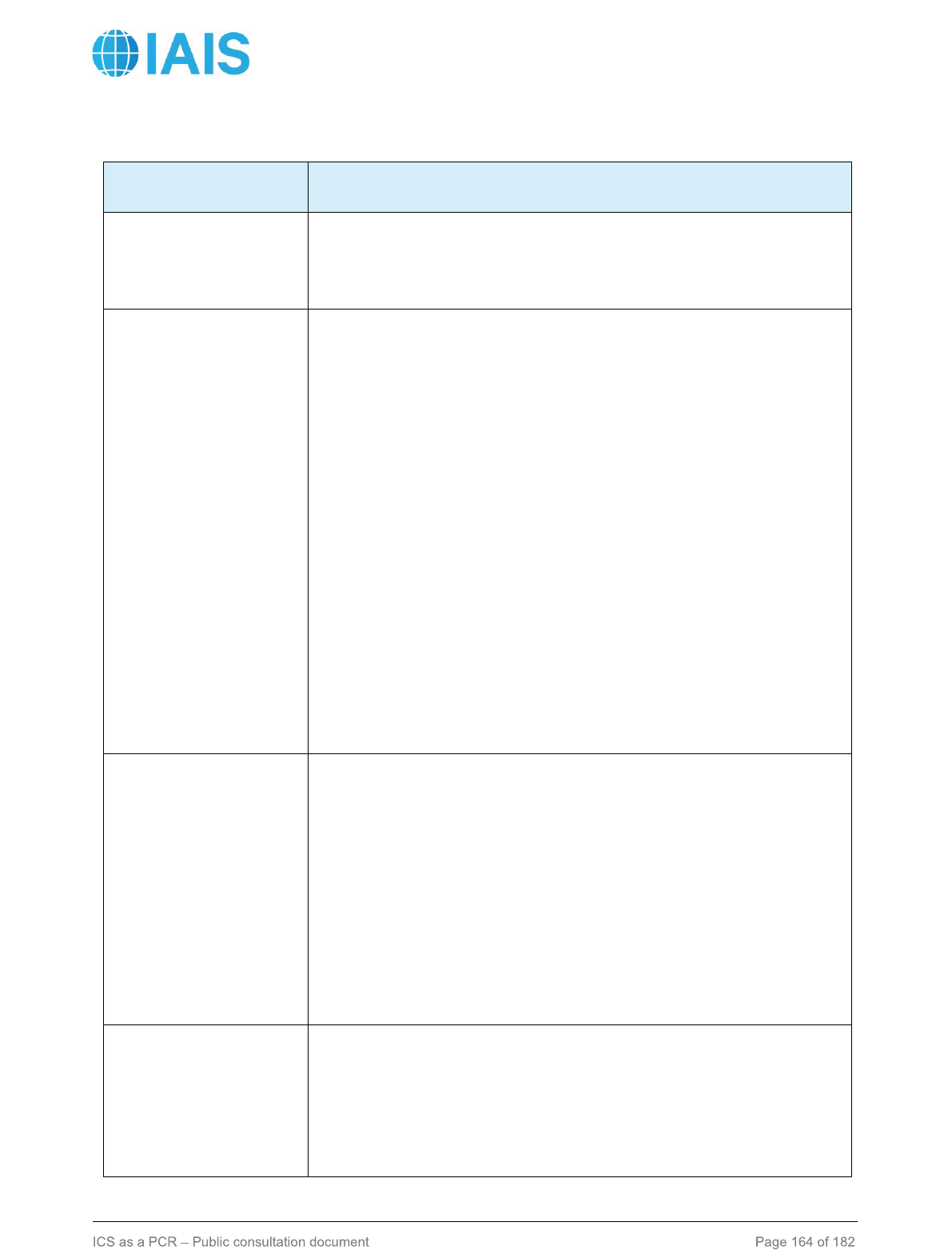
Public
ICS Segment
Definition
an enterprise's property damage, liability for damages, and
insurance for bodily injury of its members.
Korea/Maritime
This includes Marine, Transportation and aviation. More specifically
this includes cargo, ship, general maritime, marine liability,
transportation, aviation, space, and other maritime.
1) cargo: insurance for risks in marine transportation of cargoes.
2) ship: insurance for damage to a ship.
3) general maritime: insurance for risks in marine activities, such
as risks in marine construction.
4) marine liability: protection against liability for damage on the
seas, such as insurance of liability for marine contamination
(excluding ship and general marine).
5) transportation: insurance for risks in cargoes in inland
transportation.
6) aviation: insurance for damage to aircraft, such as operation
and navigation of aircraft (property) and protection against liability
for damages related to accidents of aircraft (liability for damages).
7) space: insurance for risks in successful launching and
performance of missions of artificial satellites (property) and
protection against liability for damages related to accidents of
artificial satellites (liability for damages).
8) other maritime: marine insurance products other than those
classified above.
Korea/Personal injury
This includes injury, travel and others (excluding those for
foreigners).
1) injury: insurance for an insured person's bodily injury caused by
a sudden and unexpected accident.
2) travel: insurance for injuries inflicted while travelling within the
Republic of Korea (domestic travel), insurance for injuries inflicted
while travelling abroad (overseas travel) and insurance for injuries
inflicted on persons staying abroad for a long time, such as
students studying abroad and personnel stationed abroad (long
stay abroad).
3) others: injury insurance products not listed above.
Korea/Workers
accident, liability
This includes insurance for workers' compensation for accidents
and insurance for liability.
- Workers’ compensation for accidents includes:
1) domestic: indemnity for accidents and employer's liability.
2) overseas: indemnity for accidents and employer's liability.
3) seafarers: indemnity for accidents and employer's liability.
4) occupational trainee: indemnity for accidents and employer's
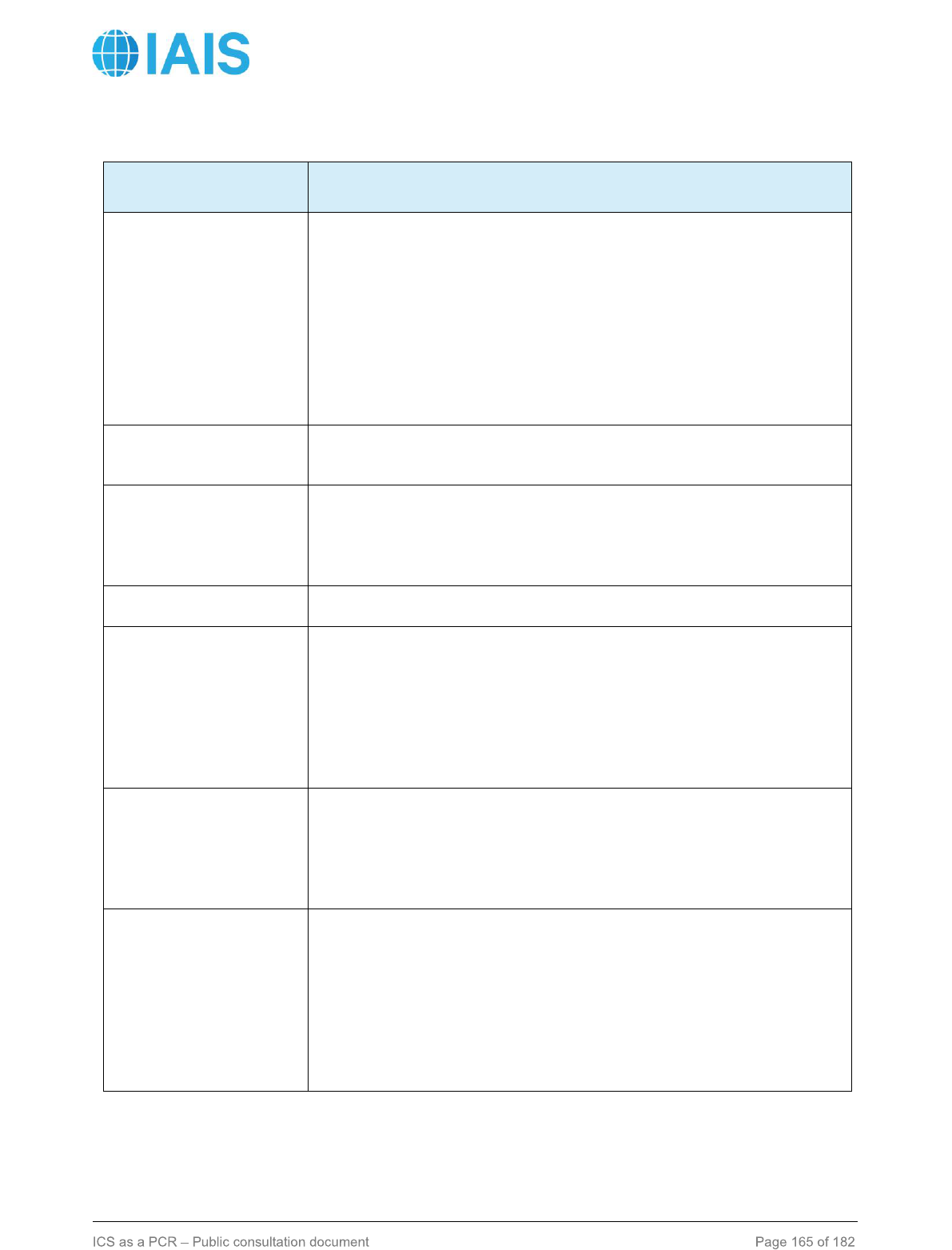
Public
ICS Segment
Definition
liability.
- Insurance for liability includes:
1) general liability: personal liability, business liability, ship owner’s
liability, excursion and ferry ship business, road
transportation business, gas accident, sports facilities, local
government and others.
2) product liability: product liability, product recall and product
guarantee.
3) professional liability: malpractice and errors and omissions
(E&O).
Korea/Foreigners
This includes insurance for injury, travel and others provided for
foreigners.
Korea/Advance
payment refund
guarantee
Insurance purchased by a builder for damage that a buyer may
sustain due to non-performance of repayment of
advance payment in connection of building of a ship or construction
of marine facilities.
Korea/Other Non-life
General insurance products other than those specified above.
Korea/Private
vehicle(personal injury)
Insurance that indemnifies the policyholder from the liability for
damages incurred to a victim by killing or injuring another person as
a consequence of an accident incurred while the insured owns or
manages a vehicle, among covers provided under an automobile
insurance policy for a private motor vehicle, which shall include the
liability insurance under Article 5 (1) of the Guarantee of
Automobile Accident Compensation Act.
Korea/Private
vehicle(property,
vehicles damage)
Insurance that indemnifies the policyholder from the liability for
damages incurred to another vehicle or the policyholder's own
vehicle as a consequence of an accident incurred while the
policyholder owns or manages a vehicle, among covers provided
under an automobile insurance policy for a private motor vehicle.
Korea/Vehicle for
commercial or business
purpose(personal
injury)
Insurance that indemnifies the policyholder from the liability for
damages incurred to a victim by killing or injuring another person as
a consequence of an accident incurred while the policyholder owns
or manages a motor vehicle, among covers provided under an
automobile insurance policy for a motor vehicle for commercial or
business purpose, which shall include the liability insurance under
Article 5 (1) of the Guarantee of Automobile Accident
Compensation Act.
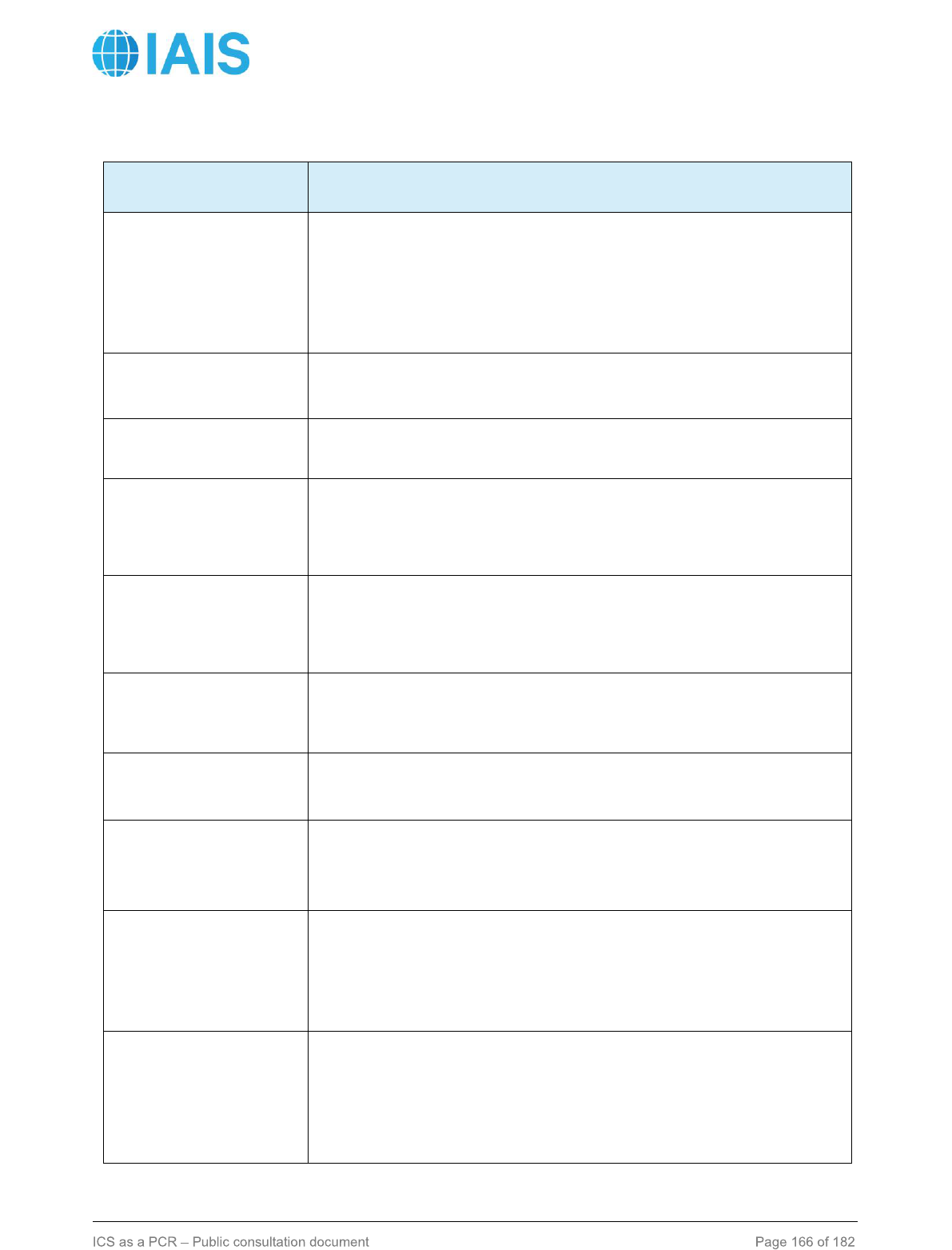
Public
ICS Segment
Definition
Korea/Vehicle for
commercial or business
purpose(property,
vehicles)
Insurance that indemnifies the policyholder from the liability for
damages incurred to another vehicle or the policyholder's own
vehicle as a consequence of an accident incurred while the
policyholder owns or manages a vehicle, among covers provided
under an automobile insurance policy for a motor vehicle for
commercial or business purpose.
Korea/Other motor
Automobile insurance other than insurance products specified
above.
Singapore/Personal
Accident
Refers to the insurance business of writing personal accident
policy.
Singapore/Health
Refers to the insurance business of writing health policy.
Singapore/Fire
This insurance covers property damage for either commercial or
household caused by fire, windstorm, hail, water damage and
earthquake
Singapore/Marine and
Aviation – Cargo
Includes insurance against risk of loss or damage of any cargo in
transit, and any liability arising from such cargo in transit arising
from the use of a vessel or ship or aircraft.
Singapore/Motor
Includes insurance against risk of loss, damage or liability arising
out of or in connection with the use of motor vehicles.
Singapore/Work Injury
Compensation
This insurance covers compensation payments to employees who
sustained bodily injury or occupational disease during or which
arises out of the course of their employment.
Singapore/Bonds
Includes maid insurance and insurance under which an insurer
undertakes to guarantee (other than guarantees to which “Credit/
Credit related” relates to) the due performance of a contract or
undertaking, or the payment of a penalty or indemnity for any
default.
Singapore/Engineering
Construction
Includes insurance against construction, erection, or engineering
risks such as the loss or damage involved in a construction project,
and installation and erection of ready built-engineering projects. It
also includes boiler and pressure vessel insurance, construction all
risk insurance, engineering all risk insurance, erection all risk
insurance, machinery all risk insurance and insurance on any other

Public
ICS Segment
Definition
specialised equipment or machinery that are excluded from the
standard property insurance.
Singapore/Credit
Insurance protecting against the risk of non-payment of goods and
services by buyers and importers.
Singapore/Mortgage
Insurance protecting against losses on mortgage loans arising from
default by borrowers.
Singapore/Others- non
liability class
Other non-liability classes not covered elsewhere.
Singapore/Marine and
Aviation – Hull
Includes insurance against risk of physical loss or damage of
vessel or ship used on sea or inland water or aircraft, any liability
arising from such vessel or ship or aircraft, and damage of vessel
or ship or aircraft while under construction. It also includes marine
terminal operator insurance and airport operator insurance and
insurance against aerospace risks.
Singapore/ Professional
indemnity
Includes insurance for professionals against risk of their liability to
their principals, clients, principal's clients, or any third parties
arising out of neglect, omission or error in the discharge of their
professional duties. It also includes directors and officers liability
insurance, and errors and omission insurance.
Singapore /Public
liability
Includes insurance against risk of the insured’s liability to third party
in respect of bodily injury, property damage or any monetary losses
arising out of negligence (other than liability to which business
classes “Cargo”, “Marine Hull”, “Aviation Hull” and “Motor” relate
to).
Singapore /Others-
liability class
Other liability classes not covered elsewhere.
Chinese Taipei / Fire –
residence
Fire insurance for personal residence.
Chinese Taipei / Fire –
commercial
Fire insurance for commercial building.
Chinese Taipei / Marine
- inland cargo
Marine insurance for inland cargo.
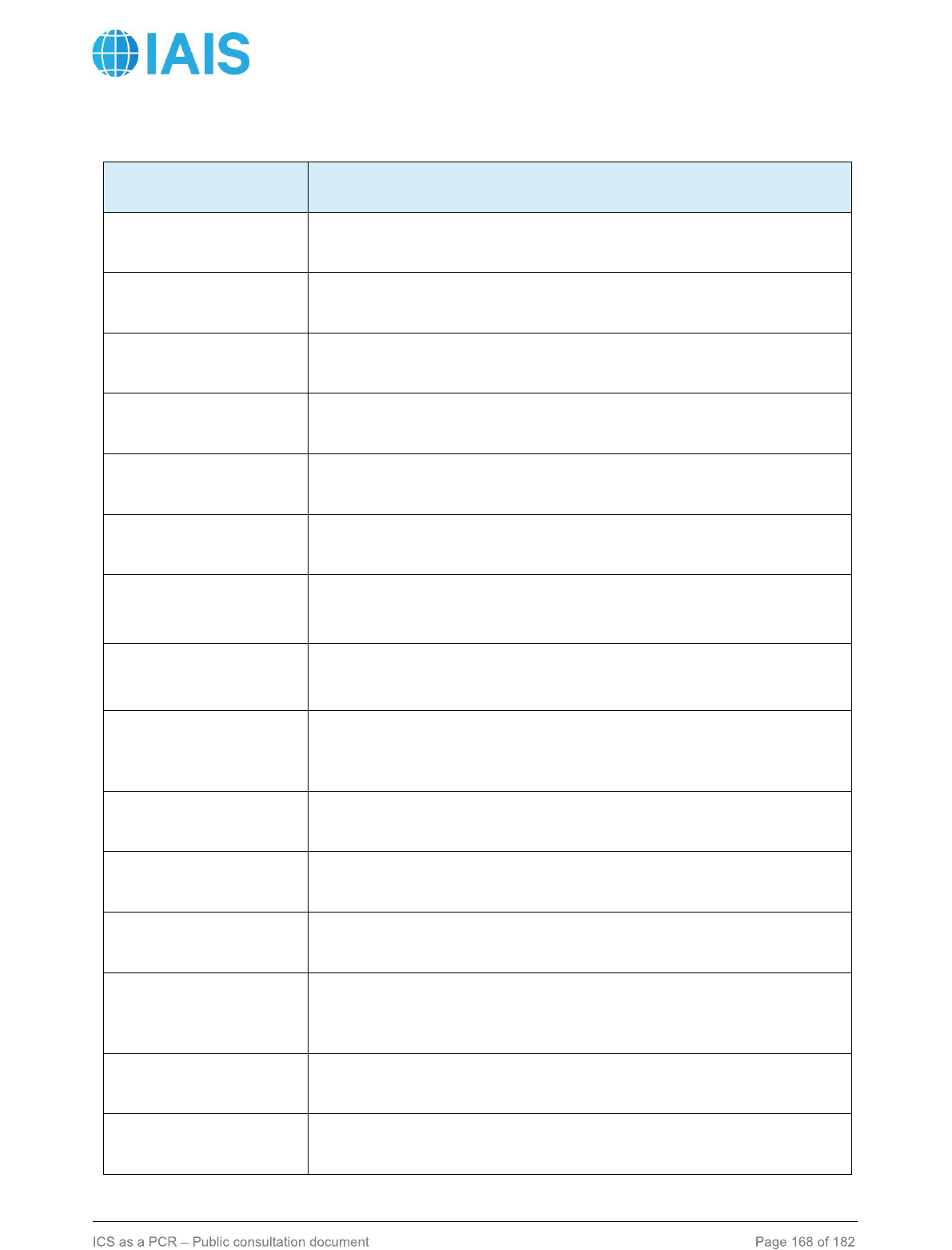
Public
ICS Segment
Definition
Chinese Taipei / Marine
- overseas cargo
Marine insurance for overseas cargo.
Chinese Taipei / Marine
– hull
Marine insurance for hull.
Chinese Taipei / Marine
- fish boat
Marine insurance for fish boat/vessel.
Chinese Taipei / Marine
– aircraft
Aviation insurance for aircraft.
Chinese Taipei / Motor
- personal vehicle
Motor insurance for personal vehicle.
Chinese Taipei / Motor
- commercial vehicle
Motor insurance for commercial vehicle.
Chinese Taipei / Motor
- personal liability
Motor insurance for personal liabilities.
Chinese Taipei / Motor
- commercial liability
Motor insurance for commercial liabilities.
Chinese Taipei /
Liability - public,
employer, product, etc.
Public liability insurance, employer liability insurance, product
liability insurance, etc.
Chinese Taipei /
Liability - professional
Professional liability insurance.
Chinese Taipei/
Engineering
Engineering insurance.
Chinese Taipei /
Nuclear power station
Insurance for nuclear power station.
Chinese Taipei /
Guarantee - surety,
fidelity
Surety insurance, fidelity insurance, mortgage insurance, etc.
Chinese Taipei / Credit
Trade credit insurance, credit card insurance, small-amount loan
credit insurance, etc.
Chinese Taipei /Other
property damage
Property damage insurances not included in other LOBs, eg cash
insurance, theft insurance, glass insurance, etc.
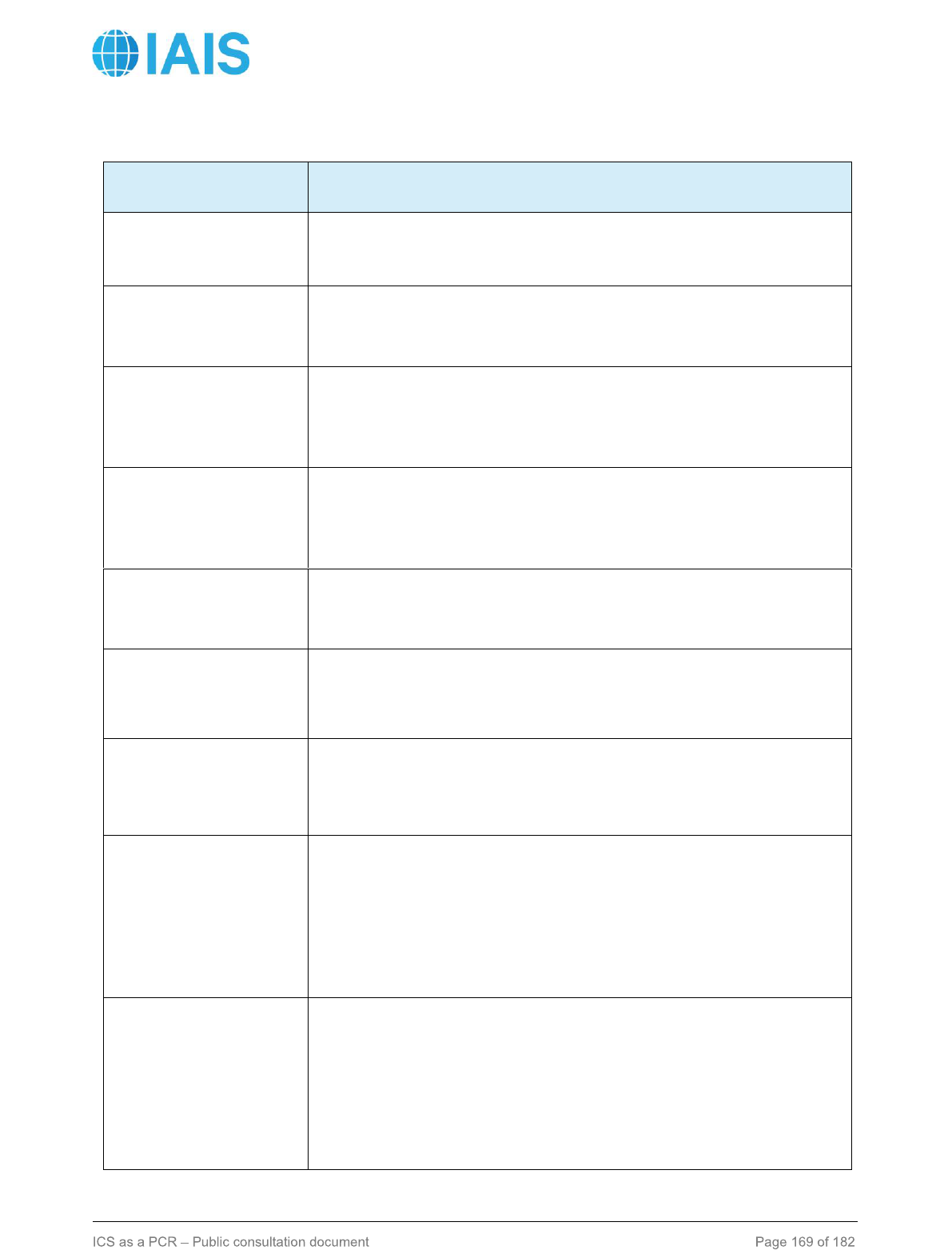
Public
ICS Segment
Definition
Chinese Taipei /
Accident
Accident insurance for personal injuries or death.
Chinese Taipei /
Property Damage -
commercial earthquake
Earthquake insurance (other than compulsory earthquake
insurance).
Chinese Taipei /
Comprehensive -
personal property and
liability
Comprehensive insurance for personal property and liabilities.
Chinese Taipei /
Comprehensive -
commercial property
and liability
Comprehensive insurance for commercial property and liabilities.
Chinese Taipei /
Property damage -
typhoon and flood
Typhoon and flood insurance.
Chinese Taipei /
Property damage -
compulsory earthquake
Compulsory earthquake insurance (compulsory for personal
residence).
Chinese Taipei / Health
Health insurance.
OTHER/Motor
This includes: Motor property damage: Damage to own and third-
party motor vehicles (and related property damage) through
accident, theft, fire and weather events, excluding liability for
personal injury; and Motor bodily insurances: Insurances relating to
the injury or death of third parties due to or related to motor
vehicles and accidents involving them. This may also extend to
include the driver involved.
OTHER/ Property
damage
This includes, but is not limited to: 1. Property: Insurance of house
or other property (including house contents) against loss through
fire, windstorm etc., insurance of contents against losses due to
theft, fire, windstorm, earthquake, impact, damages, water damage,
and other natural and man-made perils. Contents insurances may
extend to loss or damage to property outside the home or its usual
location. 2. Fire and industrial: Loss or damage and loss of
earnings due to damage to commercial buildings and other physical
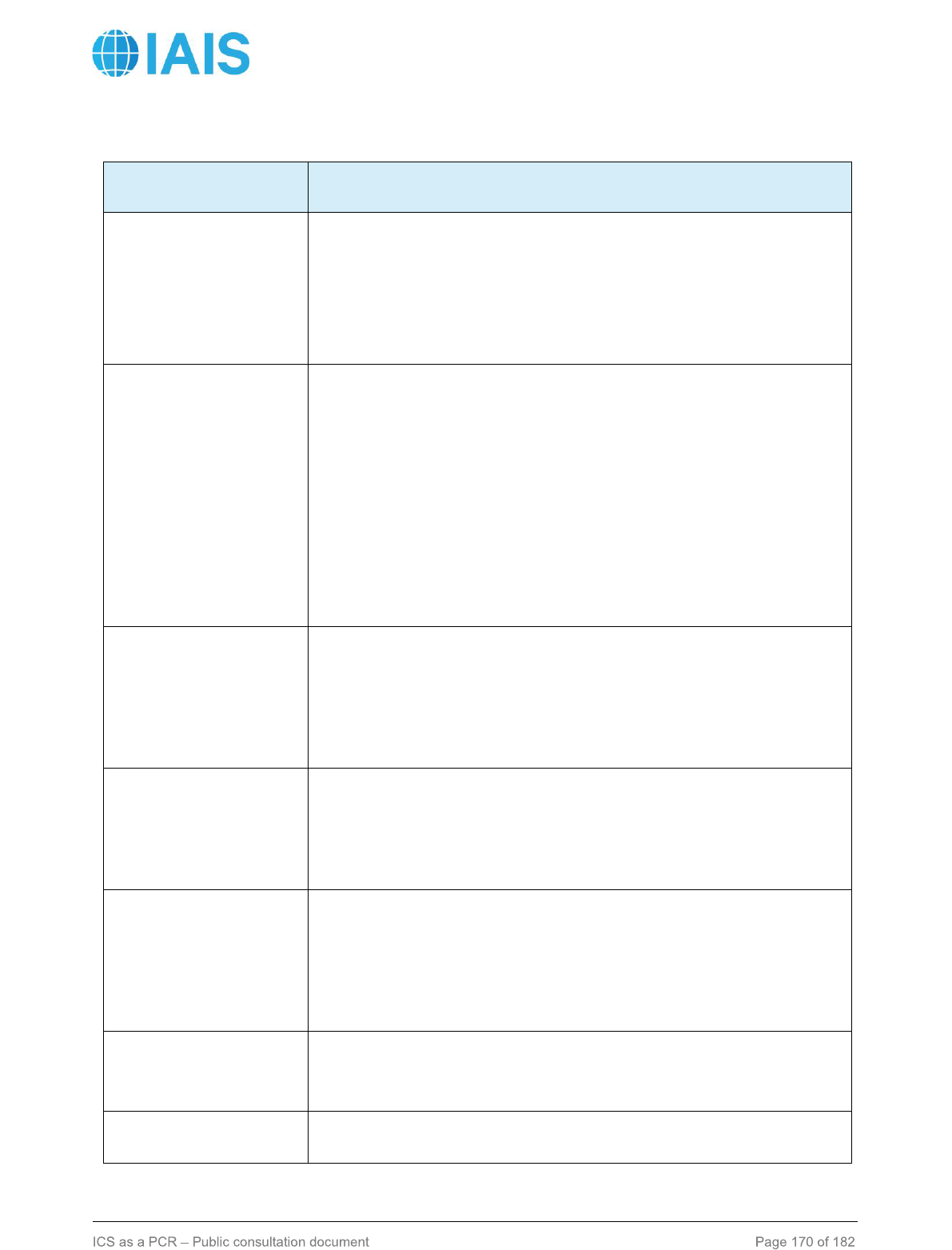
Public
ICS Segment
Definition
infrastructure due to fire, windstorm and other perils. 3.
Consequential losses: Products covering consequential losses
(such as ‘loss of profits’ or ‘business interruption’) is also included
in this segment; 4 Construction: This includes ‘construction all risks
and erection all risks’ (CAR/EAR) or similar written in connection
with construction projects. This includes the construction and
erection of infrastructure projects and buildings.
OTHER/ Accident,
protection and health
(APH)
This includes, but is not limited to: 1 Accident and sickness:
Accident cover provides benefits if an accident result in bodily injury
or death. Benefits are lump sum or periodic (typically for at most 2
years). Sickness cover is often an extension of accident insurance;
2 Other consumer accident: Property damage other than
householders or motor vehicle. For example, travel insurance. 3.
Other commercial accident: Commercial property insurance other
than Fire and Industrial risk and MAT, and other than commercial
long-term liability; 4 Consumer credit: Guarantee of repayments on
consumer credit contracts due to involuntary loss of employment; 5.
Consumer liability: Private individual's liability for personal injury
through personal actions or property
OTHER/ Short tail
medical expenses
Insurance obligation that covers the provision or financial
compensation for medical treatment or care including preventive or
curative medical treatment or care due to illness, accident, disability
or infirmity usually made during the term of the policy or shortly
(typically, up to 1 year) after the coverage period of the insurance
has expired.
OTHER/ Other short tail
Any non-Life products which do not fit into the segments above, do
not fit the definition of non-life medium-term business and where
claims are usually made during the term of the policy or shortly
(typically, up to 1 year) up to after the coverage period of the
insurance has expired.
OTHER/ Marine, Air,
Transport (MAT)
This includes: 1. All damage or loss of river, canal, lake and sea
vessels, aircraft, goods in transit, liabilities from use of aircraft,
ships and boats.; 2 Loss or damage to property, consequential third
party liability for damages to the property of others, and
consequential third party liability for personal injury to operators,
passengers and other.
OTHER/ Workers'
compensation
This insurance covers compensation payments to employees who
sustained bodily injury or occupational disease during or which
arises out of the course of their employment.
OTHER/ Public liability
Public liability insurance for bodily injury or damage to property.
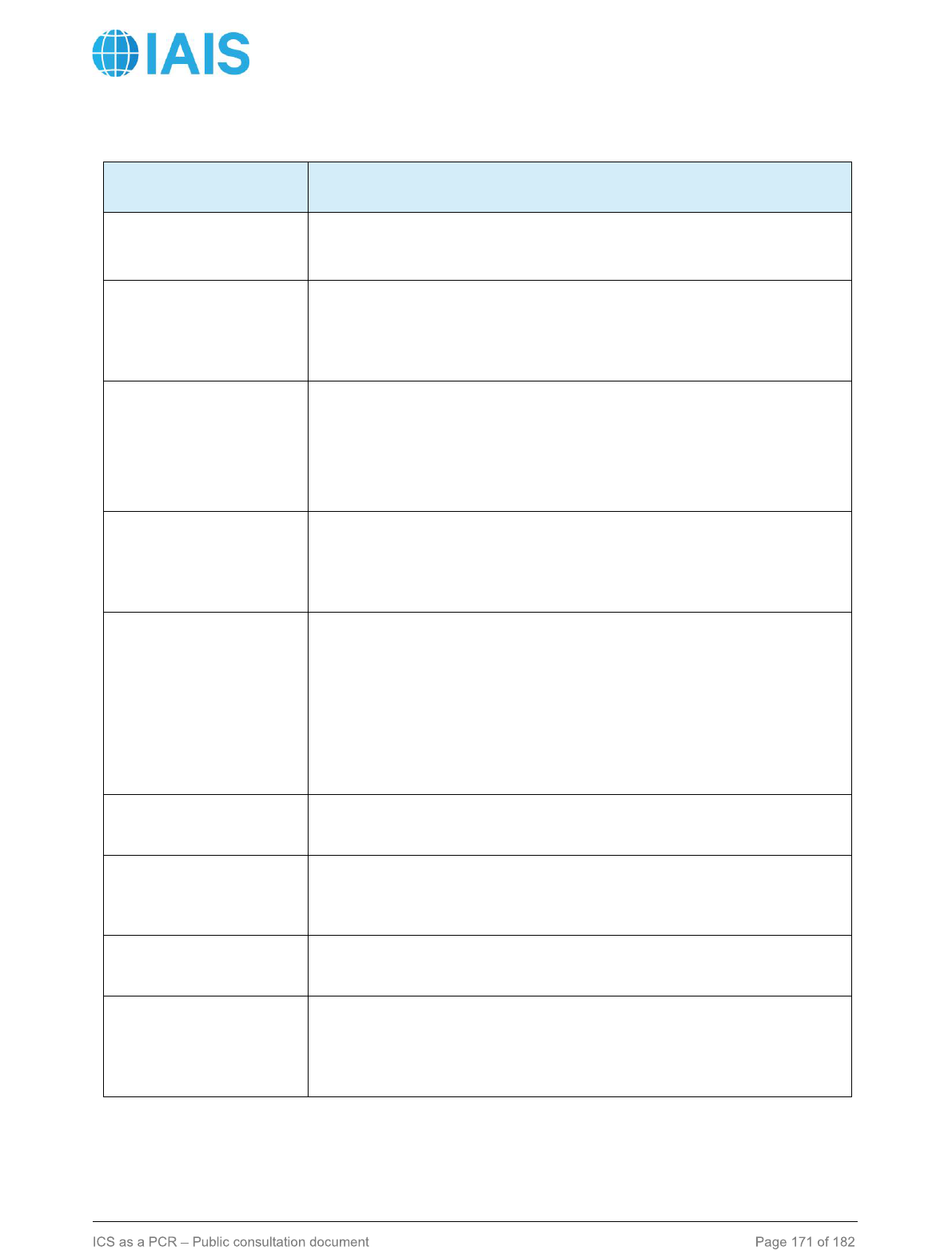
Public
ICS Segment
Definition
OTHER/ Product
liability
Product liability insurance for bodily injury or damage to property for
claims attributed to the use of products.
OTHER/ Professional
indemnity
Professional indemnity for a professional person or organisation for
claims for losses legal and other) attributed to professional
negligence (and related) in the services provided. For example,
medical malpractice and directors and officers insurance products.
OTHER/ Other liability
and other long tail
Any non-life products which do not fit into the defined segments
above, do not fit the definition of non-life medium-term business
and where claims may be made many years (typically 1 or more
years) after the coverage period of the insurance has expired.
All other liability classes not covered elsewhere.
OTHER/ Non-
proportional motor,
property damage, APH
and MAT
Non-Proportional reinsurance of motor, property damage and
accident/protection/health business, marine, aviation and transport
(refer definition).
OTHER/ Catastrophe
reinsurance
Catastrophe Reinsurance is an inwards reinsurance line of
business providing excess of loss protection or proportional
protection in respect of aggregate losses arising from a single
event or a combination of events. Typically, such business is
covering damages to property and is sold with an ‘hours’ clause
and provides protection against natural catastrophe perils such as
windstorms, earthquakes and man-made catastrophe such as acts
of terrorism.
OTHER/ Non
proportional liability
Non-Proportional reinsurance of public liability, product liability and
other liability (refer definition).
OTHER/ Non-
proportional
professional indemnity
Non-Proportional reinsurance of professional indemnity (refer
definition).
OTHER/ Mortgage
insurance
Indemnity to credit providers for losses due to the failure of a
borrower to repay a loan secured by a mortgage over property.
OTHER/ Commercial
credit insurance
Indemnity for financial losses due to the failure of a commercial
entity to repay outstanding credit contracts or failure to perform
contracted services or deliver contracted products other than short-
term trade credit and suretyship insurance.
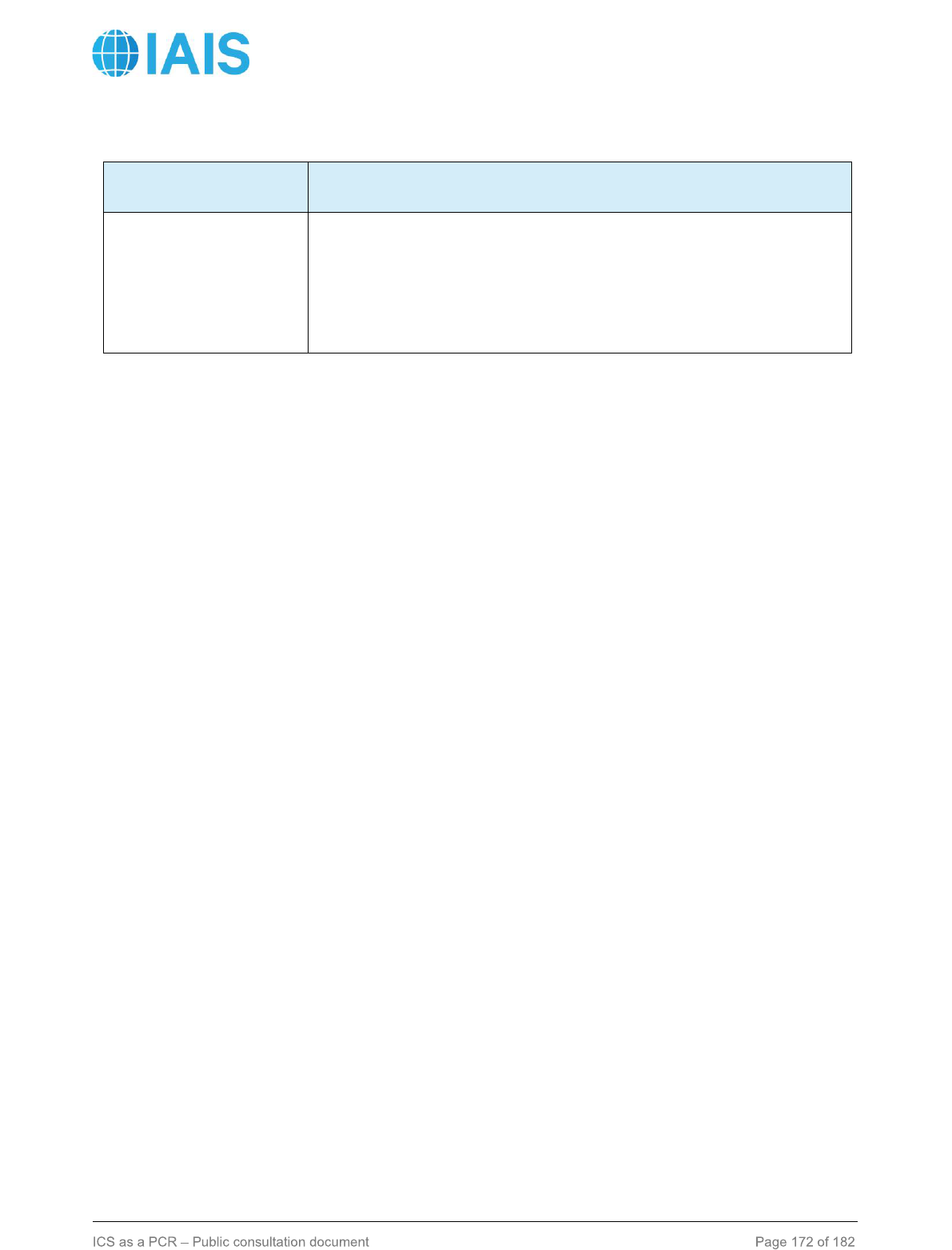
Public
ICS Segment
Definition
OTHER/ Other
medium-term
Any other non-life medium-term insurance products other than the
above and not included in non-life insurance segments above. This
includes, but is not limited to: Financing or monetising Insurance-
linked securities (ILS, for example catastrophe bonds). For
example, embedded Value/Present Value of Future Profit
securitisations, ILS with financial risk as material trigger condition.
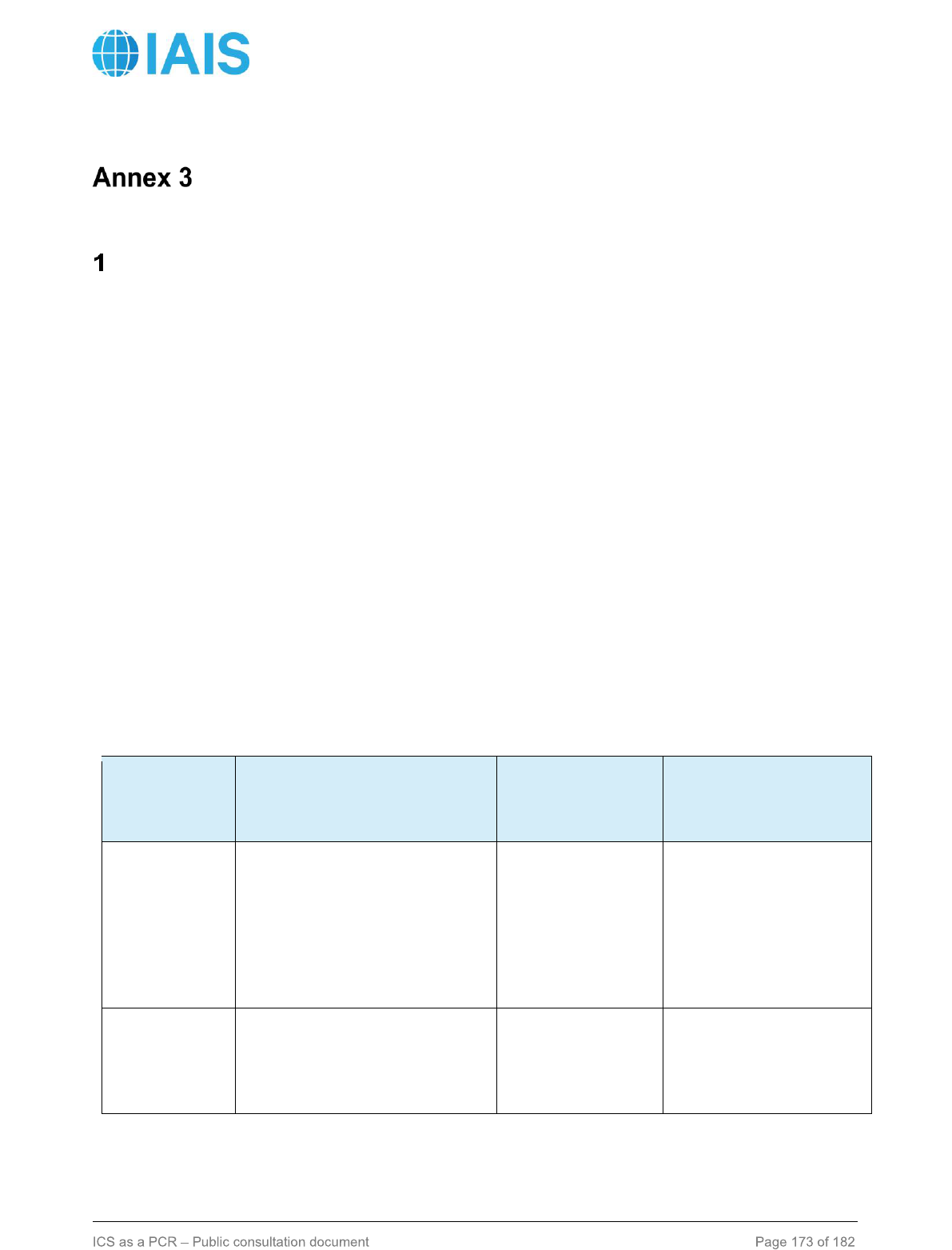
Public
Definitions and criteria applicable to infrastructure debt
and equity
Infrastructure investments
L2-458. Infrastructure (and by extension, infrastructure assets) means the physical structures,
facilities, systems and networks that provide or support essential public services, for example:
• Water and waste, including water supply and distribution systems, and wastewater collection
and treatment systems;
• Energy, including electricity generation, transmission, distribution and storage, oil and gas
pipelines, production, distribution and storage of gas (incl. hydrogen);
• Transportation assets, including roads, bridges, tunnels, railroads, rapid transit links,
seaports, airports, rolling stock (train or bus fleets or other means of transportation if they are
used to service public transportation), ground transportation equipment, and facilities for
alternative transportation (eg charging and refuelling stations);
• Digital assets, including telecommunication towers, cable systems, satellite networks, and
data centres; and
• Social infrastructure assets, including schools, hospitals, courthouses, other government
buildings, social housing, and privately run social infrastructure assets serving a public
purpose.
L2-459. Table 36 below provides an illustrative view of the different classes of infrastructure assets
Table 36: Infrastructure investments
General title
What is infrastructure
What is not
infrastructure
What typically makes
the infrastructure
investment safer
Water utilities
Water supply/distribution,
Waste water collection /
treatment
Fixing water pipe
leakages (unless
as part of
maintenance and
repair of water
supply/distribution
systems)
Regulation relating to
long-term concessions
or pricing or return-on-
assets or profit margin.
Waste
management
utilities
Facilities dedicated to waste
management, treatment and
recycling.
Using spare parts
from scrapped
vehicles for other
vehicles.
Long-term concessions
usually with the
involvement of a local
government or council.

Public
General title
What is infrastructure
What is not
infrastructure
What typically makes
the infrastructure
investment safer
Energy
(including
electricity and
gas utilities)
Generation / transmission /
distribution / storage / district
heating
Batteries used in
electric cars
Insulation of
houses.
Regulation relating to
long-term concessions,
or pricing, or return-on-
assets or profit margin.
Transportation
Airports/ports/roadways/railway
network, rolling stock used to
service public transportation,
ground transportation
equipment, facilities for
alternative transportation
(charging and refuelling
stations)
Car, aircraft, boat
manufacture
Spare parts for
aircrafts, repairs,
etc.
Long-term concessions
or agreements usually
with the involvement of a
local government or
council.
Demand for such
services.
Digital assets
(including
Telecom)
Core digital and telecom
infrastructure such as
broadband equipment, optical
fibres, telecommunication
towers, data centres.
Production and
selling of
telephones
Internet Service
Provider
Long-term contracts,
mostly business-to-
business.
Social
infrastructure
Infrastructure that provides a
service for the public that is
regulated or governed by a
government or a similar
authority (eg courts, prisons,
juvenile facilities, schools,
universities, libraries, refugee
camps, subsidised/social
housing, hospitals, etc.); or
privately run social welfare
institutions serving a public
purpose.
The infrastructure facility
is consistent with the
social policies of the
relevant government or
public needs of the
society.
L2-460. Infrastructure investments are debt or equity investments in entities that own, finance,
develop or operate infrastructure assets.
L2-461. Infrastructure investments can be segmented according to different criteria:
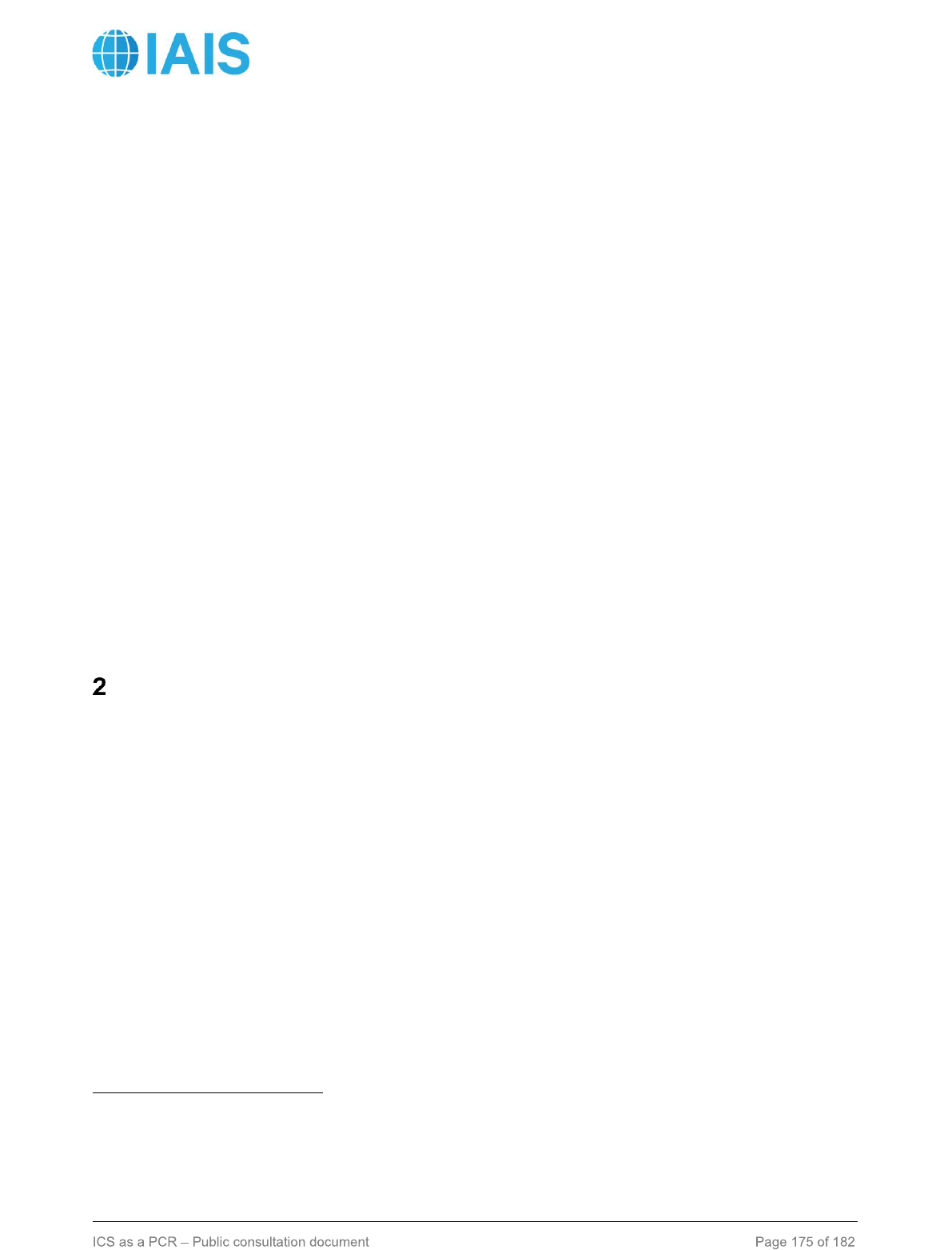
Public
• The type of investment
38
:
o Equity
o Debt
▪ Bonds (rated or unrated)
▪ Loans
• The type of issuer
o Corporate: an infrastructure corporate is an entity or a group that derives the
substantial majority of its revenue from owning, financing, developing or operating
infrastructure assets.
o Project: an infrastructure project entity is an entity which was created specifically to
support, own, finance, develop or operate one or several infrastructure assets.
N.B.: with regard to debt financing, loans to infrastructure corporates are usually
unsecured, while loans to infrastructure projects are generally collateralised.
• The involvement of the public sector (for instance through a PPP) or absence thereof
• The location of the infrastructure:
o Developed markets
o Emerging markets and developing economies (EMDEs
39
)
Criteria applicable to infrastructure equity
L2-462. The purpose of the criteria below is to identify subsets of infrastructure equity investments
that can be recognised as infrastructure equity under paragraphs L1-121 and L2-229.
2.1 Subset of infrastructure corporate investments
L2-463. Equity investments in infrastructure corporate are eligible to the specific risk charge for
infrastructure equity when the investor can demonstrate all of the following:
a. Revenues generated by the infrastructure assets are predictable, evidenced by:
i. Availability-based revenues;
ii. Arrangements that are subject to rate-of-return regulations;
iii. Arrangements that provide a high degree of contractual or regulatory certainty of
payments from future revenues by mitigating demand and/or price risk through
concessions;
38
Look-through should be applied to investment funds to identify underlying infrastructure investments that are eligible, unless it
can be shown that the fund as a whole meets all the definitions and criteria.
39
Identified based on the World Bank classification of countries: all countries not classified as high income should be considered
as EMDE.
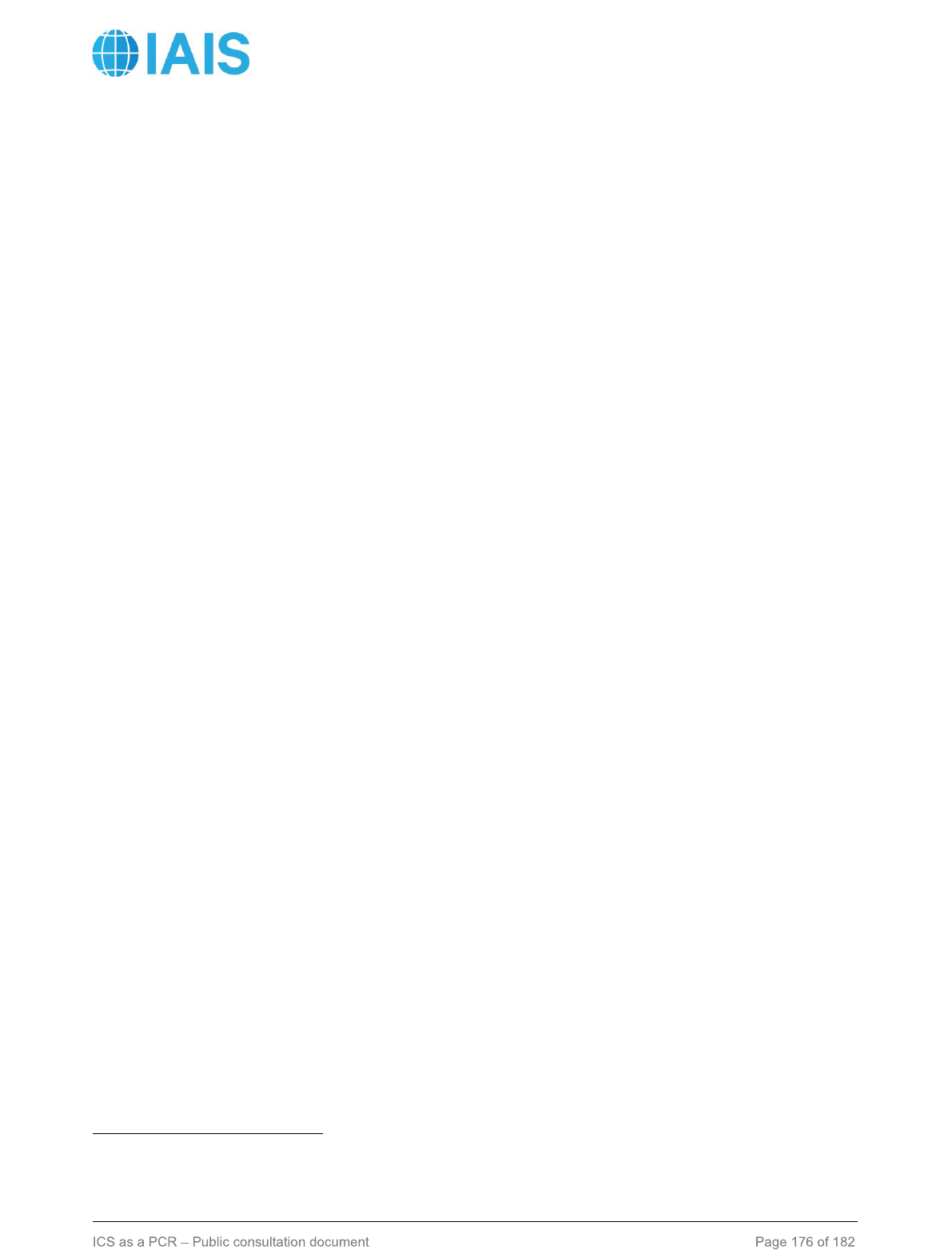
Public
iv. Offtake contracts, such as take-or-pay contracts, or similar; or
v. Resilient demand.
b. Revenues generated by the infrastructure assets are diversified in terms of activities,
location, or payers unless the revenues are subject to rate-of-return regulations or a take-or-
pay contract or the revenues are availability-based;
c. The equity issuer is either ICS RC 1-4, or:
i. The infrastructure corporate is of strong credit quality;
ii. The capital structure of the infrastructure corporate allows debt service under
conservative assumptions based on an analysis of the relevant financial ratios; and
iii. The infrastructure corporate has been active in its lines of business for at least five
years, or in the case of an acquired business it has been in operations for at least five
years.
d. The IAIG is committed to holding the investment for a long period; and
e. Where the revenues of the infrastructure corporate are not funded by payments from a large
number of users, the contractual or regulatory framework includes provisions that effectively
protect investors against losses resulting from the termination of the project by the contracted
purchaser of the goods or services, and require the contracted purchaser to be of good credit
standing
40
or replaceable without a significant loss to equity investors.
2.2 Subset of infrastructure project investments
L2-464. Equity investments in infrastructure projects are eligible to the specific risk charges for
infrastructure equity when the investor can demonstrate all of the following:
a. Revenues generated by the infrastructure assets are predictable, resulting from:
i. Availability-based revenues or arrangements that are subject to rate-of-return
regulations;
ii. Arrangements that provide a high degree of contractual or regulatory certainty of
payments from future revenues by mitigating demand and/or price risk through
concessions;
iii. Offtake contracts, such as take-or-pay contracts, or similar; or
iv. Resilient demand.
b. The infrastructure project can meet its financial obligations under sustained stressed
conditions that are relevant for the risk of the project;
c. The infrastructure project is governed by a regulatory or contractual framework that provides
equity investors with a high degree of protection, including the following:
40
The contracted purchaser is assumed to be of good credit standing if it belongs to the following list: national governments,
multilateral development banks, supranational organisations, or other entities with an ICS RC 1-4.
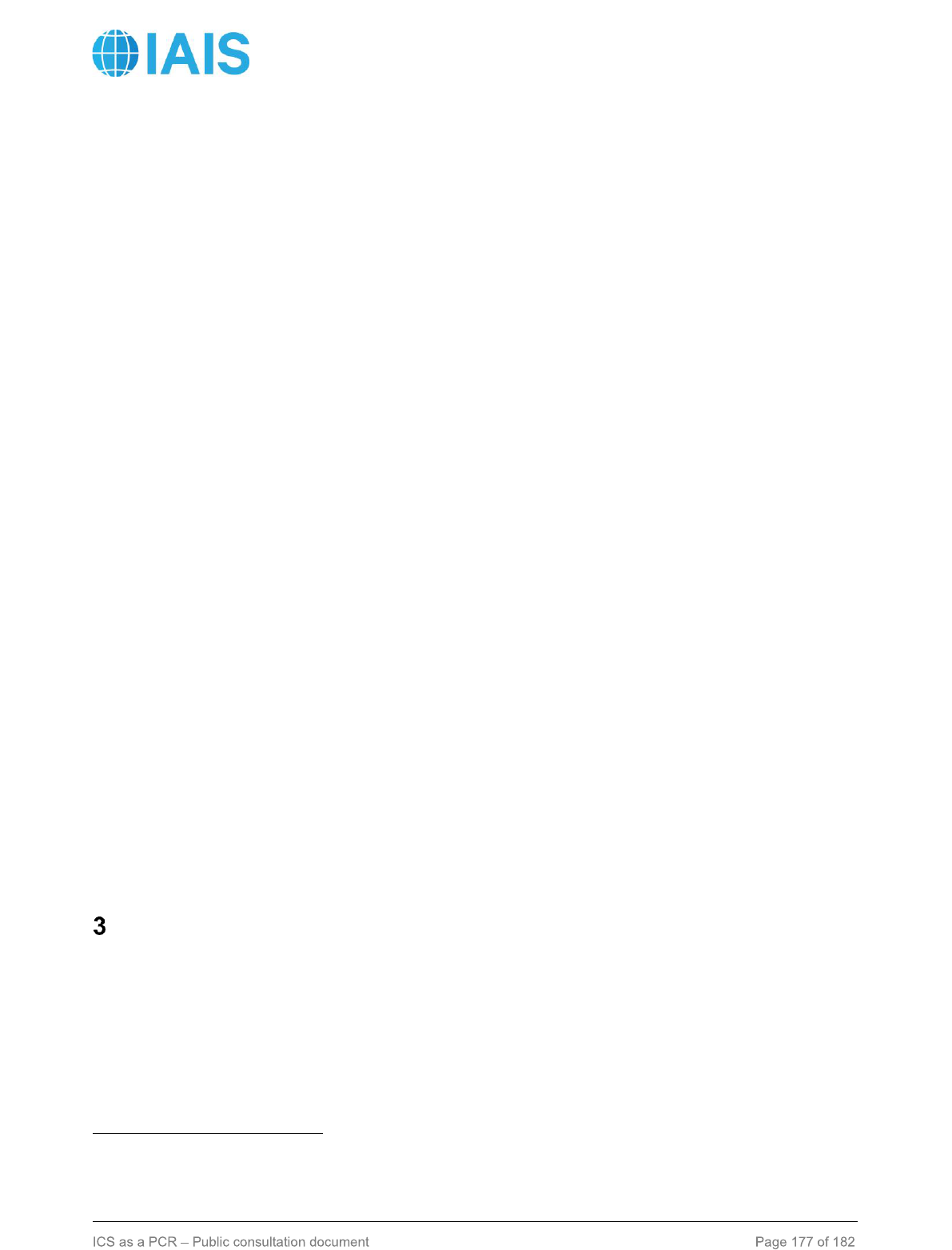
Public
i. Where the revenues of the infrastructure project are not funded by payments from a
large number of users, the contractual framework includes provisions that effectively
protect investors against losses resulting from the termination of the project by the
contracted purchaser of the goods or services, and require the contracted purchaser
to be of good credit standing
41
or replaceable without a significant loss to equity
investors; and
ii. The infrastructure project has sufficient reserve funds or other financial arrangements
to cover its contingency funding and working capital requirements;
d. The IAIG is committed to holding the investment for a long period.
e. Risks linked to the management of the project are significantly mitigated, resulting from:
i. A good expertise and a track record of the sponsor of successfully overseeing
infrastructure projects;
ii. Established incentives for the sponsor to protect the interests of other investors;
iii. A limited exposure of investors to the default of the sponsor;
iv. Established safeguards to ensure completion of the project according to the agreed
specifications, budget and completion date (including for example completion
guarantees or the involvement of an experienced constructor and adequate contract
provisions for liquidated damages); and
v. The use of tested technology and design.
f. The project has been in operational phase for at least 5 years;
g. The financial risks faced by the infrastructure project are significantly mitigated, resulting
from:
i. The capital structure of the infrastructure project allows it to service its debt under
conservative assumptions based on an analysis of the relevant financial ratios;
ii. The refinancing risk for the infrastructure project is low; and
iii. The infrastructure project uses derivatives only for risk mitigation purposes; and
h. Where operating risks are material, they are properly managed.
Criteria applicable to infrastructure debt
L2-465. The purpose of the criteria below is to identify subsets of infrastructure debt investments
that can be recognised as infrastructure debt under paragraph L2-251.
41
The contracted purchaser is assumed to be of good credit standing if it belongs to the following list: national governments,
multilateral development banks, supranational organisations, or other entities with an ICS RC 1-4.
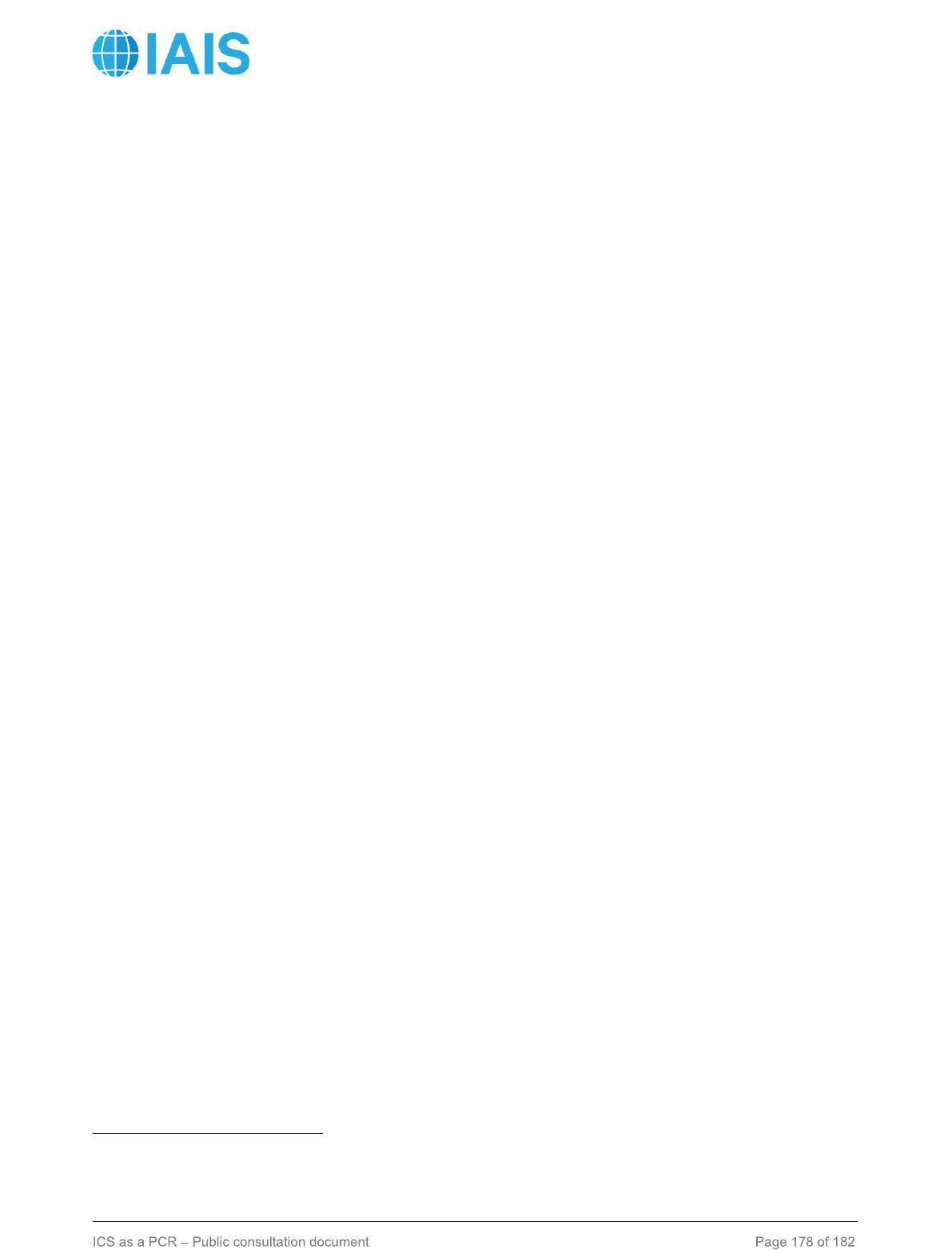
Public
3.1 Subset of infrastructure corporate investments
L2-466. Debt investments in infrastructure corporate are eligible to the specific risk charge for
infrastructure debt when the investor can demonstrate all of the following:
a. Revenues generated by the infrastructure assets are predictable, evidenced by:
i. Availability-based revenues;
ii. Arrangements that are subject to rate-of-return regulations;
iii. Arrangements that provide a high degree of contractual or regulatory certainty of
payments from future revenues by mitigating demand and/or price risk through
concessions;
iv. Offtake contracts, such as take-or-pay contracts, or similar; or
v. Resilient demand.
b. Revenues generated by the infrastructure assets are diversified in terms of activities,
location, or payers unless the revenues are subject to rate-of-return regulations or a take-or-
pay contract or the revenues are availability-based;
c. The infrastructure corporate is of strong credit quality, evidenced by:
i. The capital structure of the infrastructure corporate allows debt service under
conservative assumptions based on an analysis of the relevant financial ratios; and
ii. The infrastructure corporate has been active in its lines of business for at least three
years, or in the case of an acquired business it has been in operations for at least
three years.
d. The IAIG is committed to holding the investment to maturity; and
e. Where the revenues of the infrastructure corporate are not funded by payments from a large
number of users, the contractual or regulatory framework includes provisions that effectively
protect investors against losses resulting from the termination of the project by the contracted
purchaser of the goods or services, and require the contracted purchaser to be of good credit
standing
42
or replaceable without a significant loss to debt and equity investors.
3.2 Subset of infrastructure project investments
L2-467. Debt investments in infrastructure projects are eligible to the specific risk charge for
infrastructure debt when the investor can demonstrate all of the following:
a. Revenues generated by the infrastructure assets are predictable, resulting from:
i. Availability-based revenues or arrangements that are subject to rate-of-return
regulations;
42
The contracted purchaser is assumed to be of good credit standing if it belongs to the following list: national governments,
multilateral development banks, supranational organisations, or other entities with an ICS RC 1-4.
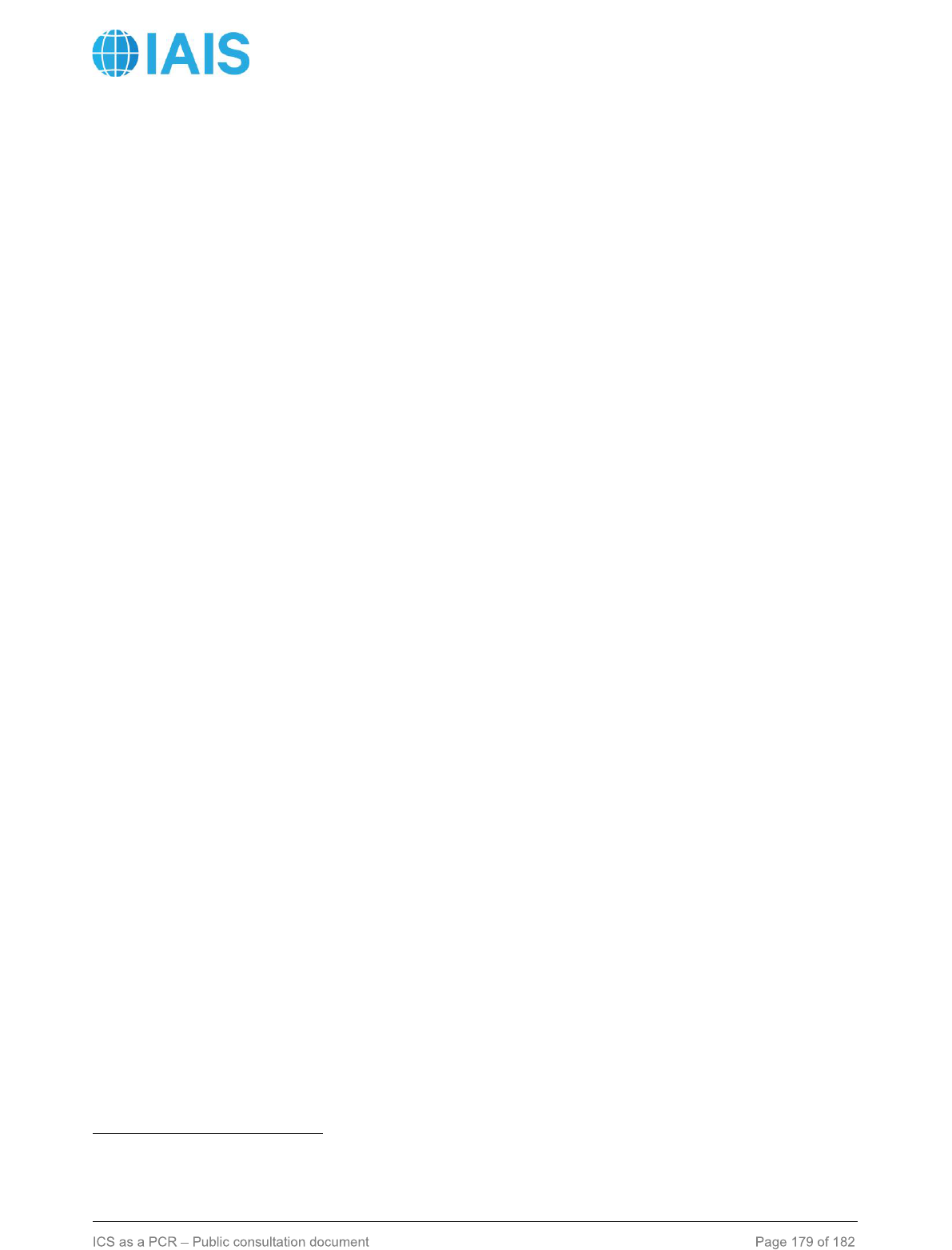
Public
ii. Arrangements that provide a high degree of contractual or regulatory certainty of
payments from future revenues by mitigating demand and/or price risk through
concessions;
iii. Offtake contracts, such as take-or-pay contracts, or similar; or
iv. Resilient demand.
b. The infrastructure project can meet its financial obligations under sustained stressed
conditions that are relevant for the risk of the project;
c. The infrastructure project is governed by a regulatory or contractual framework that provides
debt investors with a high degree of protection, including the following:
i. Where the revenues of the infrastructure project are not funded by payments from a
large number of users, the contractual framework includes provisions that effectively
protect investors against losses resulting from the termination of the project by the
contracted purchaser of the goods or services, and require the contracted purchaser
to be of good credit standing
43
or replaceable without a significant loss to debt
investors;
ii. The infrastructure project has sufficient reserve funds or other financial arrangements
to cover its contingency funding and working capital requirements; and
iii. The contractual framework provides a strong security package, which includes
security in project assets and contracts, restrictions on the use of net operating cash
flows, restrictions on permitted investments and activities, and on the issuance of new
debt. Where the IAIG can demonstrate that the security in project assets and
contracts is not essential for effective protection or recovery of the vast majority of its
investment, a different security package may be relied upon. In that case, the security
package includes at least one of the following: equity pledges, step in rights, lien over
bank accounts, control over cash flows, provisions for assignment of contracts.
d. The IAIG is committed to holding the investment to maturity.
e. The risks during the construction phase of the project are significantly mitigated, resulting
from:
i. A good expertise and a track record of the sponsor of successfully overseeing
infrastructure projects;
ii. Established incentives for the sponsor to protect the interests of other investors;
iii. A limited exposure of investors to the default of the sponsor;
iv. Established safeguards to ensure completion of the project according to the agreed
specifications, budget and completion date (including for example completion
guarantees or the involvement of an experienced constructor and adequate contract
provisions for liquidated damages); and
43
The contracted purchaser is assumed to be of good credit standing if it belongs to the following list: national governments,
multilateral development banks, supranational organisations, or other entities with an ICS RC 1-4.
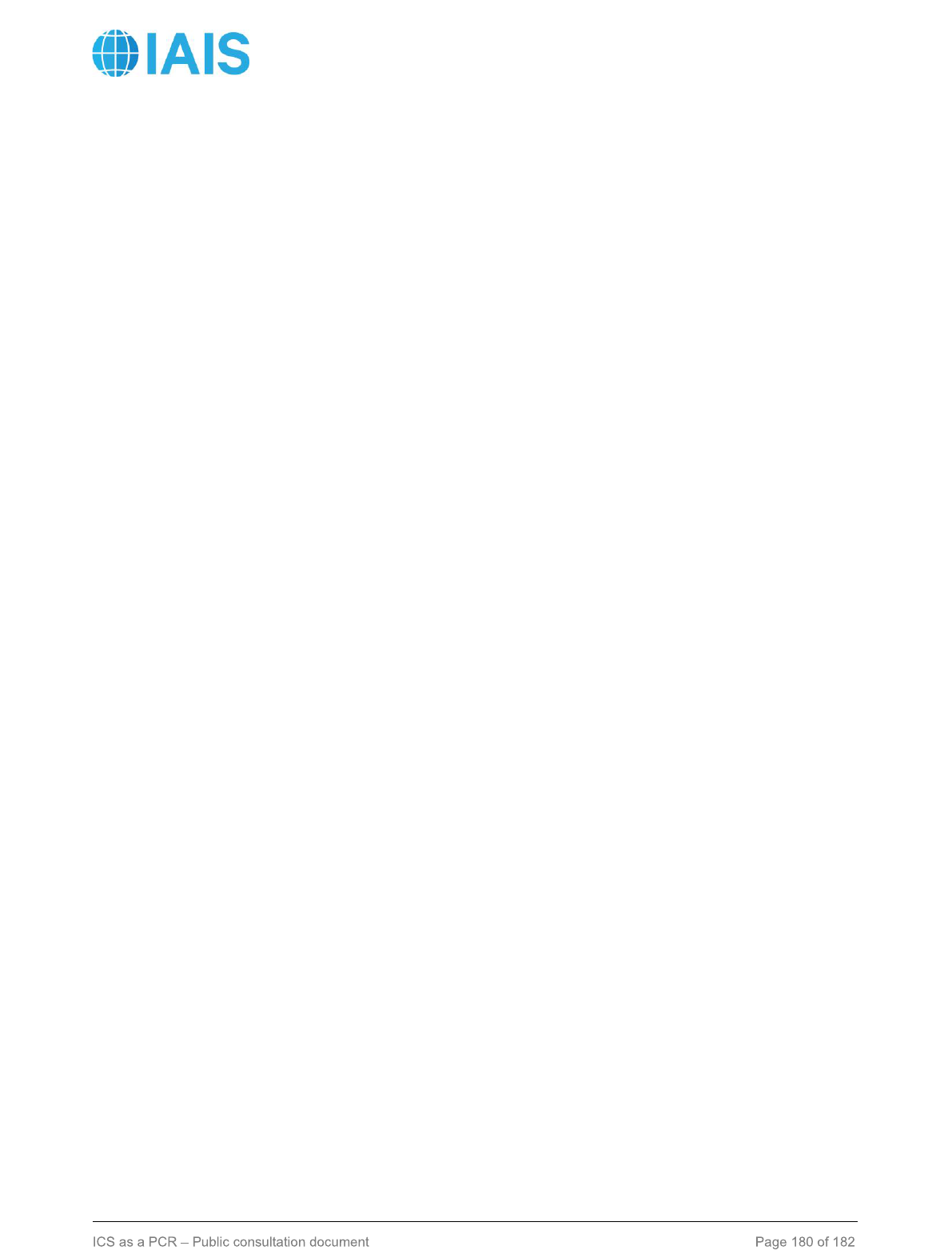
Public
v. The use of tested technology and design.
f. The financial risks faced by the infrastructure project are significantly mitigated, resulting
from:
i. The capital structure of the infrastructure project allows it to service its debt under
conservative assumptions based on an analysis of the relevant financial ratios;
ii. The refinancing risk for the infrastructure project is low;
iii. The infrastructure project uses derivatives only for risk mitigation purposes; and
iv. Debt ranks pari passu or senior to all claims other than statutory claims; and
g. Where operating risks are material, they are properly managed.
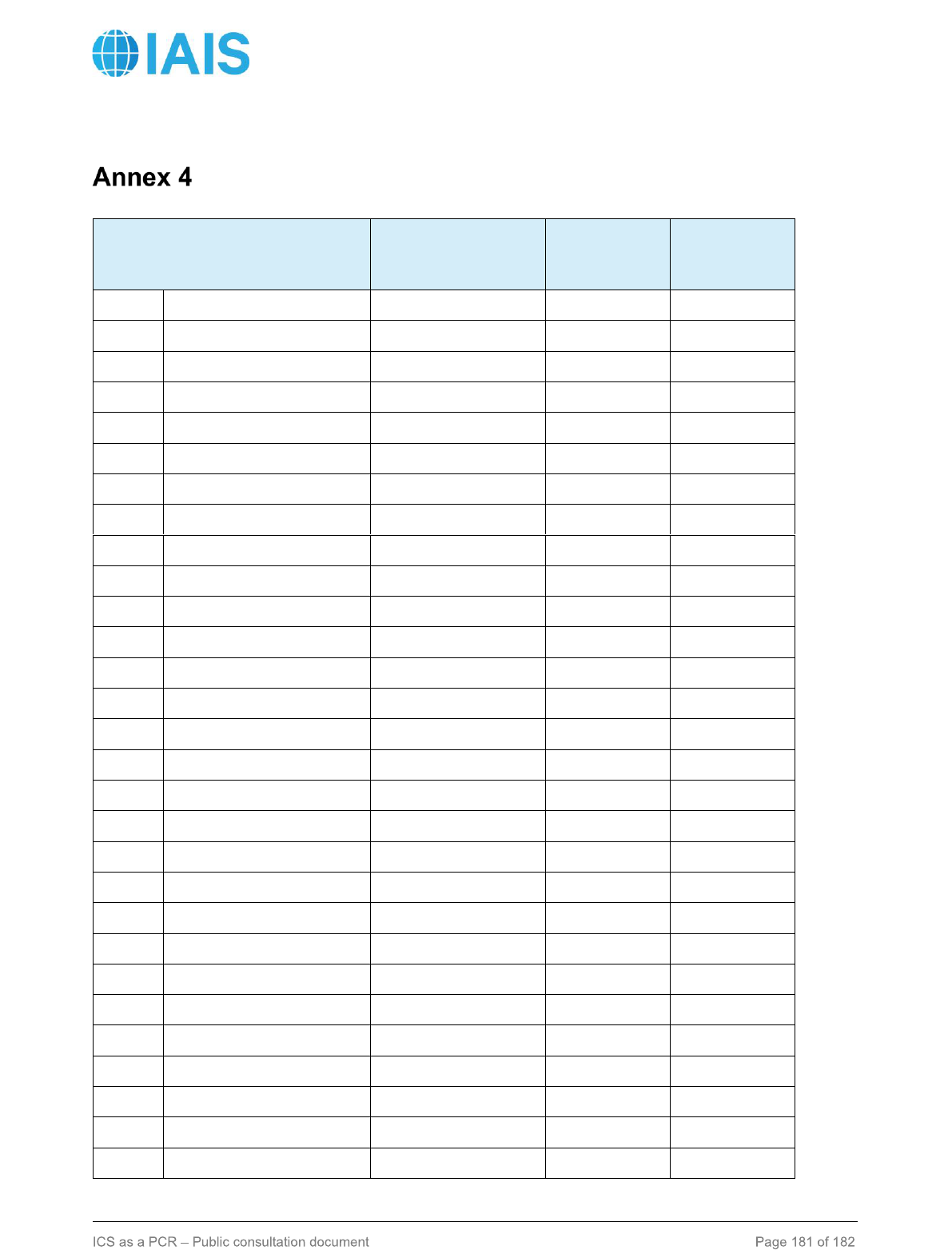
Public
Risk-free yield curve parameters
Currency
Observed
Instrument
LOT (years)
Long-term
Forward
Rate
AUD
Australian Dollar
Government Bonds
30
3.8%
BRL
Brazilian Real
Government Bonds
10
7.0%
CAD
Canadian Dollar
Government Bonds
30
3.8%
CHF
Swiss Franc
Government Bonds
20
2.8%
CLP
Chilean Peso
Swaps
10
5.0%
CNY
Yuan Renminbi
Government Bonds
10
6.0%
COP
Colombian Peso
Swaps
10
6.0%
CZK
Czech Koruna
Swaps
15
3.8%
DKK
Danish Krone
Swaps
20
3.8%
EUR
Euro
Swaps
20
3.8%
GBP
Pound Sterling
Swaps
50
3.8%
HKD
Hong Kong Dollar
Swaps
15
4.4%
HUF
Forint
Government Bonds
15
6.0%
IDR
Rupiah
Swaps
10
8.0%
ILS
New Israeli Shekel
Swaps
20
4.4%
INR
Indian Rupee
Swaps
10
7.0%
JPY
Yen
Government Bonds
30
3.8%
KRW
Won
Government Bonds
20
4.4%
MXN
Mexican Peso
Government Bonds
20
5.0%
MYR
Malaysian Ringgit
Government Bonds
15
5.0%
NOK
Norwegian Krone
Swaps
10
3.8%
NZD
New Zealand Dollar
Swaps
20
4.8%
PEN
Sol
Swaps
10
6.0%
PHP
Philippine Peso
Swaps
10
7.0%
PLN
Zloty
Government Bonds
10
5.0%
RON
Romanian Leu
Government Bonds
10
5.0%
RUB
Russian Ruble
Swaps
10
7.0%
SAR
Saudi Riyal
Swaps
15
6.0%
SEK
Swedish Krona
Swaps
10
3.8%
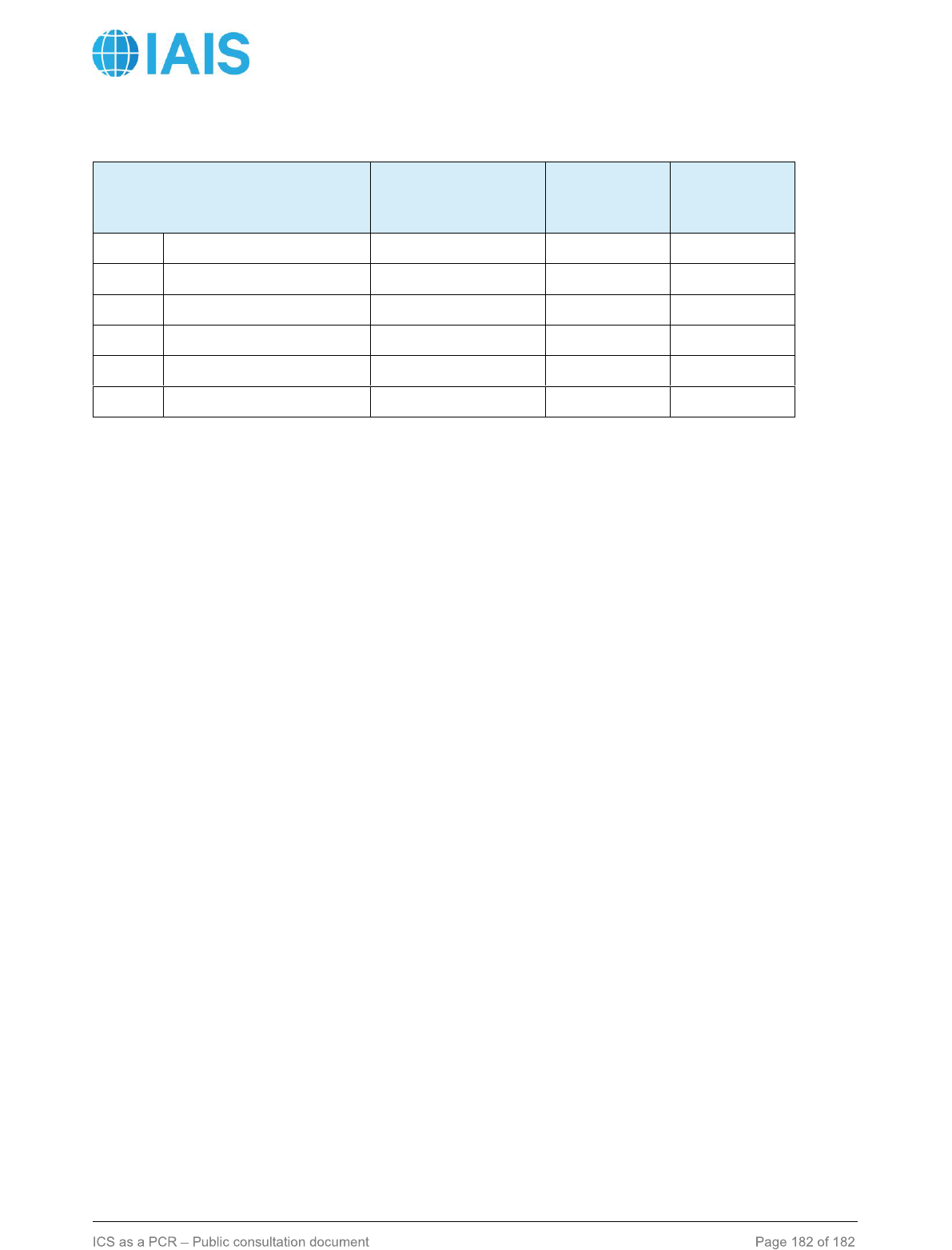
Public
Currency
Observed
Instrument
LOT (years)
Long-term
Forward
Rate
SGD
Singapore Dollar
Government Bonds
20
3.8%
THB
Baht
Government Bonds
10
5.0%
TRY
Turkish Lira
Government Bonds
10
7.0%
TWD
New Taiwan Dollar
Government Bonds
10
4.4%
USD
US Dollar
Government Bonds
30
3.8%
ZAR
Rand
Government Bonds
30
7.0%

